Fine Japanese Art AUCTION
Friday, 16 June 2023



AUCTION Fine Japanese Art Friday, 16 June 2023, 11 am CET Tel +43 1 532 04 52 Fax +20 E-mail office@zacke.at www.zacke.at CATALOG JAP0623 EXHIBITION 12 - 15 June 10 am - 6 pm as well as by appointment GALERIE ZACKE Sterngasse 13 1010 VIENNA AUSTRIA
IMPORTANT INFORMATION
According to the general terms and conditions of business of Galerie Zacke Vienna, Founded 1968, SZA Versteigerungen & Vertriebs GmbH, 1010 Wien, online at www.zacke.at
ABSENTEE BIDDING
Absentee bids are carried out under the regulations of the terms of business of Galerie Zacke, SZA Versteigerungen & Vertriebs GmbH, which requires written submission of your purchase limit. Orders without purchase limits cannot be processed. Only the submitted lot number of the auction lot is binding for the processing of the absentee bid. The place of jurisdiction is Vienna, Austrian Law and Austrian jurisdiction are exclusively applicable for all legal questions arising from the business relationship. Absentee bids for this auction will be accepted until the day of auction by 10:00 a.m. We regret that absentee bids received after the time stated above will not be processed until after the auction.
PLEASE SEND ABSENTEE BIDS FOR THIS AUCTION TO:
Fax: +43 1 532 04 52 20 or

Email: office@zacke.at or
Mail: Galerie Zacke, Sterngasse 13, 1010 Wien, Austria, Europe
WE ACCEPT THE FOLLOWING METHODS OF PAYMENTS:
• Cash
• Certified or personal check
• Bank transfer (please inquire to receive our bank account information)
• Credit card (Visa, MasterCard, Amex)
TELEPHONE BIDDING
It is generally possible to bid by telephone during the auction. Please fill out the absentee bidding form enclosed in this catalog and include your telephone number at which you can be reached during the auction. In the “bid in euro” column please write “TEL” and then send us the completed absentee bidding form. Galerie Zacke will call you on the day of the auction, on the telephone number provided, 5 lots before the lot you are bidding on and the bidding will commence at the starting price, as stated in the catalog. If Galerie Zacke cannot reach you during the auction, Galerie Zacke will bid up to the estimate on your behalf.
ESTIMATES AND STARTING PRICES
The auction will begin with the starting price and written bids will be accepted only with a minimum amount equivalent to the starting price.
SHIPPING AND TRANSPORT INSURANCE
For domestic shipping Galerie Zacke (hereinafter called “the company”) charges in average Eur 15,- to Eur 50,- per item, depending on size and weight. These fees cover the costs of packing and shipping. Fees for bulky or fragile items, or international shipping will be quoted upon request.
The purchased goods are transported at the risk of the customer following handover of the packaged item to the post office or another carrier which the customer agrees to through his/her submission of the purchase order. According to the specific wish of the customer, the auctioned goods may be insured for the value of the purchase price (highest bid and all surcharges). This insurance fee is 3% of the purchase price. For any lots with a purchase prices exceeding EUR 350,- the transport insurance will be automatically arranged by the company if it does not expressively receive the purchaser’s written denial of this service and signed waiver of claims. Payments due to the company under the insurance contract will be charged to the customer. The company is also entitled to assign claims under the insurance contract to the customer providing the terms of the insurance contract do not prevent this.
In any case, the company is only required to make payment to the customer specifically if payment has effectively been received from the insurance company.
COLOR AND CONDITION
Auction lots will be exhibited for viewing prior to the auction, thus offering all interested customers the opportunity to examine the quality and condition of the works exhibited. The catalog illustrations are intended to assist customers during such preview. In illustrations, printed colors do not correspond exactly to the originals. The printed catalog images are not representative for the condition of the illustrated pieces. Hidden flaws and damages are indicated in the condition report. The illustrations in our online catalogs can be strongly magnified, so that most damages and restorations are well recognizable.
ENDANGERED SPECIES / CITES INFORMATION
Some items in this catalog may for example consist of ivory, rhinoceros-horn, tortoise shell, or some types of tropical wood, and are subject to the Convention on International Trade in Endangered Species of Wild Fauna and Flora [CITES]. Such items are marked with the symbol Ɏ on www.zacke.at and may only be exported outside the European Union after an export permit in accordance with CITES has been granted by the Austrian authorities. We would like to inform you that such licenses are typically not granted.
COMPLAINTS
At its auctions, Galerie Zacke sells consigned lots on behalf of third-party consignors. For this reason, any complaints related to purchased lots must be in accordance with §32-48 of the general terms and conditions of business of Galerie Zacke, which can be found on www.zacke.at
IMPORTANT INFORMATION
Whenever making a bid, whether personally or via an agent, in writing, online, telephone, or in any other way, the bidder fully and unconditionally accepts the Terms of Auction, the ‘Important Information’ section in the auction catalog, the Terms and Conditions (AGB) of Galerie Zacke, §1-50, the Fee Tariff, and the Bidding Increments table, all as published on www.zacke.at on the day of the auction
THE ART LOSS REGISTER
All items starting above 2.000,- EUR have been checked by the Art Loss register.

ON DATE 16 June 2023, AT 11AM CET
PLEASE RAISE MY BID BY ONE BIDDING INCREMENT (ca. 10%) IF NECESSARY
IMPORTANT NOTICE:
Bids do not include buyer’s premium and VAT. Margin taxation applies. Items with added VAT are marked in the online catalog.
TELEPHONE BIDS:
MY
PLEASE CALL ME WHEN A HIGHER BID THAN MINE HAS BEEN RECEIVED
If you like to bid by telephone, please state ‘TEL’ in the ‘BID IN EURO’ column instead of a Euro amount. Galerie Zacke will call you on the day of the auction, on the telephone number provided, 5 lots before the lot you are bidding on and the bidding will commence at the starting price, as stated in the catalog. If Galerie Zacke cannot reach you during the auction, Galerie Zacke will bid up to the estimate on your behalf.
TERMS OF PAYMENT, SHIPPING AND COLLECTION:
NAME
ADRESS CITY, COUNTRY
POSTCODE
PHONE NUMBER
CREDIT CARD PAYMENT
PLEASE CHECK THE DESIRED CARD
COLLECTION BY CLIENT WITH PAYMENT ON THE PREMISES IN CASH, BY CERTIFIED CHEQUE OR CREDIT CARD
INVOICE PAYMENT
VIA BANK WIRE AFTER RECEIPT OF INVOICE SHIPPING AFTER RECEIPT OF PAYMENT
EXPRESS PARCEL SERVICE REQUIRED (ACCORDING TO TERMS AND CONDITIONS OF GALERIE ZACKE)
SHIPPING INSURANCE REQUIRED (ACCORDING TO TERMS AND CONDITIONS OF GALERIE ZACKE)
GALERIE ZACKE
Sterngasse 13, 1010 Vienna, Austria
Email: office@zacke.at
Tel: +43-1-532 04 52
Fax: +43-1-532 04 52 20
With the signature on this form, the client instructs the auctioneer to bid on his behalf. The Euro amount up to which the auctioneer shall bid on behalf of the client is either stated in this form or will be communicated to the auctioneer via telephone during the auction. All absentee bidding shall be governed by the terms and conditions [AGB] of Galerie Zacke. The client agrees with his signature that he has read, understood and fully accepted the AGB of Galerie Zacke. Galerie Zacke, founded 1968, is a registered brand of SZA Versteigerungen & Vertriebs GmbH, Vienna, Austria.
NAME
ADDRESS CARD NUMBER
EXPIRY DATE
IMPORTANT NOTICE:
Whenever making a bid, whether personally or via an agent, in writing, online, telephone, or in any other way, the bidder fully and unconditionally accepts the Terms of Auction, the ‘Important Information’ section in the auction catalog, the Terms and Conditions (AGB) of Galerie Zacke, §1-48, the Fee Tariff, and the Bidding Increments table, all as published on www.zacke.at on the day of the auction.
ABSENTEE BIDDING FORM
FOR THE AUCTION Fine Japanese Art JAP0623
EMAIL DATE & SIGNATURE MASTERCARD SECURITY CODE VISA AMEX LOT NR. LOT TITLE BID IN EURO
PHONE NUMBER
ABSENTEE BIDDING FORM FOR THE AUCTION Fine Japanese Art JAP0623
ON DATE 16 June 2023, AT 11AM CET
LOT NR. LOT TITLE BID IN EURO
§ 1) The auction shall be carried out in accordance with the provisions of the rules of procedure of GALERIE ZACKE©, SZA VERSTEIGERUNGEN UND VERTRIEBS GMBH, Sterngasse 13, 1010 WIEN (hereinafter referred to as the company) as well as in accordance with sections 244-246 of the GEWERBEORDNUNG [Industrial Code] of 1994. The auction shall be carried out on commission. The auctioneer shall be entitled to withdraw lots exceptionally, to conduct the auction deviating from the order of the catalog numbers and to offer lots jointly. In the event of any dispute concerning a double bid or if the auctioneer has missed a bid, the auctioneer shall be entitled to revoke acceptance of a bid and to continue auctioning the item. The figures stated in the catalog shall be the highest bid in Euro (€) expected by the respective expert. As a rule, the bid shall be increased by 10% of the last bid. (See table of the bidding increments).
§ 2) The acceptance of a bid shall be granted to the highest bidder unless a hidden reserve has been agreed upon with the consignor of the item in question. Such a hidden reserve (also called limit or just reserve) shall be the minimum price under which the item will not be sold during the auction. This reserve will be disclosed upon request and after the auction only and may exceed the estimate. The auctioneer will in this case bid on behalf of the seller against all other bidders until the reserve has been reached. If a reserve is not reached during the auction, the auctioneer will knock down the item to the highest bidder at the final bid, but the sale will be conditional of the acceptance of this final bid by the seller. In this case the highest bidder shall be bound to his/her last bid for a term of 8 days starting with the day of the knockdown. If the winning bidder does not receive a written cancellation notice within this term of 8 days, the knockdown becomes unconditional and the sale is final. Typically, only a minority of all items in an auction have a hidden reserve.
§ 3) Most items shall be subject to differential taxation. A uniform surcharge of 25% plus the value added tax applicable to the surcharge to the amount of 20% shall be added to the achieved highest bid (final and highest bid). Thus, the surcharge shall be 30% of the final and highest bid in total. Items with added VAT are marked † in the online catalog.
§ 4) In the event of sales abroad, the value added tax will be repaid if the item is sold to a country which is not a member country of the European Union (third country), the legal requirements are met, and the proof of exportation is provided. The value added tax shall not be shown separately on the invoice.
§ 5) The auction buyer must pay the purchase price immediately upon acceptance of the bid (final and highest bid plus 25% surcharge, plus the value added tax applicable to the surcharge to the amount of 20%, or the added VAT on top of the final price, when a lot is highlighted accordingly in the auction catalog). The company may grant an auction buyer a term of payment for the purchase price in whole or in part when this has been formally applied for in writing before the auction.
§ 6) In the event of a term of payment, or any payment delay, in whole or in part, the company shall be entitled to charge default interest (12% p.a.) as well as storage charges (2.4% pf the final and highest bid per month commenced) after 14 days upon acceptance of the bid. The item purchased at auction shall be handed over exclusively upon full payment of the purchase price including all costs and charges accrued since the acceptance of the bid.
§ 7) The buyer should take acquired items into possession, as far as possible, immediately or after the end of the auction. Items which have been fully paid for shall be handed over in our show rooms in GALERIE ZACKE, Sterngasse 13, 1010 VIENNA. If a deferred purchase price is not paid within the set period, the company shall be entitled to auction the item again in order to recoup its claim from the defaulting auction buyer. In this case, the defaulting auction buyer shall be liable to the company for the total loss of commission incurred by the company due to the re-auctioning as well as for any default interest and storage charges.
§ 8) The company shall be entitled to a lien on all items of the buyer irrespective of whether the buyer bought them within the scope of an auction or in free sale or the company secured ownership of these items otherwise. This lien shall serve to secure all current and future, qualified, limited and unmatured claims to which the company is entitled and which result from all legal transactions concluded with the buyer.
§ 9) The items received for auction will be exhibited and may be viewed prior to the auction. In doing so, the company shall give everyone the opportunity to check the nature and the condition of the exhibited items to the extent deemed possible within the scope of the exhibition. Every bidder shall be deemed to act on its own behalf unless it provides a written confirmation saying that it acts as a representative or agent of a well-known principal. The company may refuse bids; this shall particularly apply if a bidder who is unknown to the company or with whom the company has no business connections yet does not provide a security deposit before the auction. However, in principle there shall be no claim to accept a bid. If a bid has been refused, the previous bid shall remain effective.
§ 10) The company’s experts evaluate and describe the items received for auction and determine the starting prices unless otherwise stated in the catalog or expert opinion. The information concerning production technique or material, state of preservation, origin, design and age of an item is based on published or otherwise generally accessible (scientific) findings concluded by the company’s expert with the necessary care and accuracy. The company shall warrant to the buyer according to §34-38 of the AGB (Terms and Conditions) that properties are correct provided that any complaints referring to this are made within 45 days after the auction day. Subsequent complaints shall be excluded in principle. The company shall not be liable for any further information in the catalog and expert opinion as well. This shall also apply to illustrations in the catalog. The purpose of these illustrations is to guide the potential buyer during the preview. They shall not be authoritative for the condition or the characteristics of the pictured item. The published condition reports shall only mention defects and damage affecting the artistic or commercial value significantly. Complaints concerning the price shall be excluded upon acceptance of the bid. The company reserves the right to amend the catalog online prior to the auction. These amendments shall also be made public orally by the auctioneer during the auction. In this case, the company shall be liable for the amendment only. All items offered may be checked prior to the auction. These items are used. Any claims for damages exceeding the liability named above and resulting from other material defects or other defects of the item shall be excluded. When making the bid, the bidder confirms that he/she has inspected the item prior to the auction and has made sure that the item corresponds to the description.
§ 11) If a customer is not able to participate in an auction personally, the company shall accept purchase orders. These orders may be placed in writing via mail, e-mail, fax, www.zacke.at or a third party bidding platform. In the case of a purchase order placed by phone or orally, the company shall reserve the right to make the performance dependent on a confirmation from the principal communicated in writing. Furthermore, the company shall not be liable for the performance of purchase orders. Equal purchase orders or live bids will be considered in the order of their receipt. Bids which below the estimate shall be exhausted completely. Bids which do not correspond to the increments determined by the company (see bidding increment table) will be rounded up to the next higher increment. The table of these increments can be sent upon request. The written bid (purchase order) must include the item, the catalog number and the offered top bid limit which is quoted as the amount of the acceptance of the bid without buyer’s commission and without taxes.
Ambiguities shall be carried by the bidder. A purchase order which has already been placed may only be cancelled if the written withdrawal is received by the company at least 72 hours prior to the beginning of the auction.
§ 12) The company may refuse a purchase order without explanation or make its execution dependent on payment of a security deposit. In the event of an unsuccessful order, such a deposit will be reimbursed by the company within 5 working days. Processing of purchase orders is free of charge.
§ 13) Every seller shall in principle be entitled to withdraw the items offered for auction until the start of the auction. Therefore, it is impossible to assume liability or to give warranty for the actual offering.
§ 14) Paid items must be collected within 30 days after payment. Items which have not been collected may be re-offered without further communication at the starting price from the recent auction reduced by 50%. Items which have not been collected within 30 days after the auction or for which the company does not receive any proper shipping instructions stating the type of shipping and the address of dispatch (independent of a possibly placed purchase order) shall be stored at the owner’s risk.
Furthermore, the company shall be entitled to store items which have been purchased at auction and paid but not collected at the buyer ś risk and expense, including the costs for an insurance, with a forwarding agency. It shall be understood that the provision concerning the re-auctioning of unpaid and paid but not collected items must also apply to items not exhibited or stored on the premises of the company. The ownership shall be transferred to the buyer at the time of handing over the issuing note.
§ 15) In the case of mixed lots with a starting price of less than EUR 350.00, the company shall not warrant for the completeness or correctness of the individual items within a mixed lot.
§ 16) A registration for a bid by telephone for one or several items shall automatically represent a bid at the estimate price of these items. If the company cannot reach a bidder by telephone, it will bid on behalf of this bidder up to the estimate price when the respective lot is up for auction.
§ 17) Payments made to the company by mistake (through the payer ś fault) (e. g. due to miscalculation of the exchange rate by the payer) or payments made to the company for the same invoice several times shall be compensated in form of a credit note for goods for an indefinite period of time. The repayment of such payments in cash shall be excluded.
§ 18) Certain auction lots may exist several times (multiples). In such a case, the auctioneer may accept a second, third or even more bids from the underbidder(s). In this case, the text in the catalog and not the illustration shall be exclusively binding with regard to the warranty.
§ 19) The company reserves the right to assign to the buyer all rights and obligations resulting from the contractual relationship between the company and the seller by way of a respective declaration, as well as to assign to the seller all rights and obligations resulting from the contractual relationship between the company and the buyer by way of a respective declaration, in each case in terms of a complete assignment of contract with the result that the contractual relationship - following the submission of the aforementioned declarations by the company – shall exclusively be between the seller and the buyer, all of which is in accordance with the basic model of the commission agreement. Buyers and sellers shall already now give their explicit consent to this contract assignment.
§ 20) The place of performance of the contract brought about between the company on the one hand and the seller as well as the buyer on the other hand shall be the place of business of the company. The legal relationships and contracts existing between the company, the sellers and the buyers shall be subject to Austrian law. The company, the sellers and the buyers shall agree to settle all disputes resulting from, concerning and in connection with this contract before the territorially competent court of Vienna.
§ 21) The export of certain art objects from Austria shall require a permit from the Bundesdenkmalamt [Federal Monuments Office]. The company will orally provide information about art objects for which such export permit will probably not be granted at the beginning of the auction.
§ 22) Whenever making a bid, whether personally or via an agent, in writing, online, telephone, or in any other way, the bidder fully and unconditionally accepts the Terms of Auction, the ‘Important Information’ section in the auction catalog, the Terms and Conditions (AGB) of Galerie Zacke, §1-50, the Fee Tariff, and the Bidding Increments table, all as published on www.zacke.at on the day of the auction.
TERMS OF AUCTION

Lacquer & Inlaid Works of Art
Lots 1 to 39

A RARE SHELL-INLAID NANBAN LACQUER CABINET
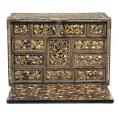
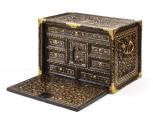
Japan, late 16th to early 17th century, Momoyama (1573-1615) to early Edo period (1615-1868)
Of wide rectangular form with two side-hung doors, one with a keyhole, which open to reveal the interior typically fitted with ten drawers of varying size, arranged symmetrically in rows. The doors and sides richly decorated in gold hiramaki-e and mother-of-pearl inlays on the black-lacquered wood, the front with a shaped panel enclosing a ho-o bird amid dense leafy floral blossoms, reserved against by a minutely inlaid dotted ground, surrounded by a shippo-tsunagi (linked-cash) border, the sides similarly decorated with circular panels enclosing a rabbit and bird, respectively, each surrounded by a diapered border. The backs of the doors and fronts of the drawers similarly lacquered and inlaid with scrolling foliage and swirling ponds.
SIZE 35.9 x 52.1 x 30.2 cm
Condition: Good condition, commensurate with age. Extensive wear, age cracks, losses to inlay and lacquer, old repairs, touchups, nicks, scratches, some fittings possibly renewed.
In the late sixteenth century, Japanese lacquer makers had a global clientele and vied to come up with innovative designs. They produced portable desks with drawers, such as this one, for the European, and especially the Portuguese, market. The style is known as nanban (literally, “southern barbarian”), meaning foreign.

Crafted in Kyoto’s lacquer workshops alongside quite different wares intended for elite Japanese clients, these kinds of Nanban coffers and cabinets decorated in gold hiramaki-e and shell were among the earliest Japanese artefacts to reach Asian and European markets, starting two or three decades after the first landfall by Portuguese adventurers in the mid-sixteenth century. Celebrated today for their lavish, innovative technique and dense ornamentation (inspired in part by wares from other parts of Asia), such pieces brought the Japanese genius for design to global attention and ensured that Japan would be synonymous with ‘lacquer’ until the present day.
AUCTION COMPARISON
Compare a related Nanban cabinet, also with two side-hung doors and depicting rabbits, of smaller size (24 cm x 29.2 cm x 22 cm), dated to the Momoyama period, at Bonhams, 6 November 2014, London, lot 279 (sold for 11,250 GBP). Compare also a related fall-front Nanban cabinet with similar decoration at Bonhams, 13 May 2021, London, lot 56 (sold for 25,250 GBP) and another at Sotheby’s, 17 April 2019, Paris, lot 80 (sold for 20,000 EUR).


Estimate EUR 12,000
Starting price EUR 6,000
8
1

A RARE LACQUER KENDAI (LECTERN)
Japan, dated 1906
The base of rectangular form with rounded corners and supported on a short foot, the exterior of rich, dense nashiji, the front with a storage drawer fitted with a lobed metal handle, opening to reveal a sparser nashiji ground to the interior, the sides and back finely lacquered in gold and colored takamaki-e with inlays of motherof-pearl to depict a majestic peacock amid blossoming prunus branches. The top of the base with two recesses to insert the separately modeled feet of the reading stand similarly lacquered with blossoming prunus and connected at the bottom by a panel further decorated in gold hiramaki-e with sumikiri kaku ni Omodaka mon, the reading stand with two foliate-incised metal fittings suspending silk tassels.
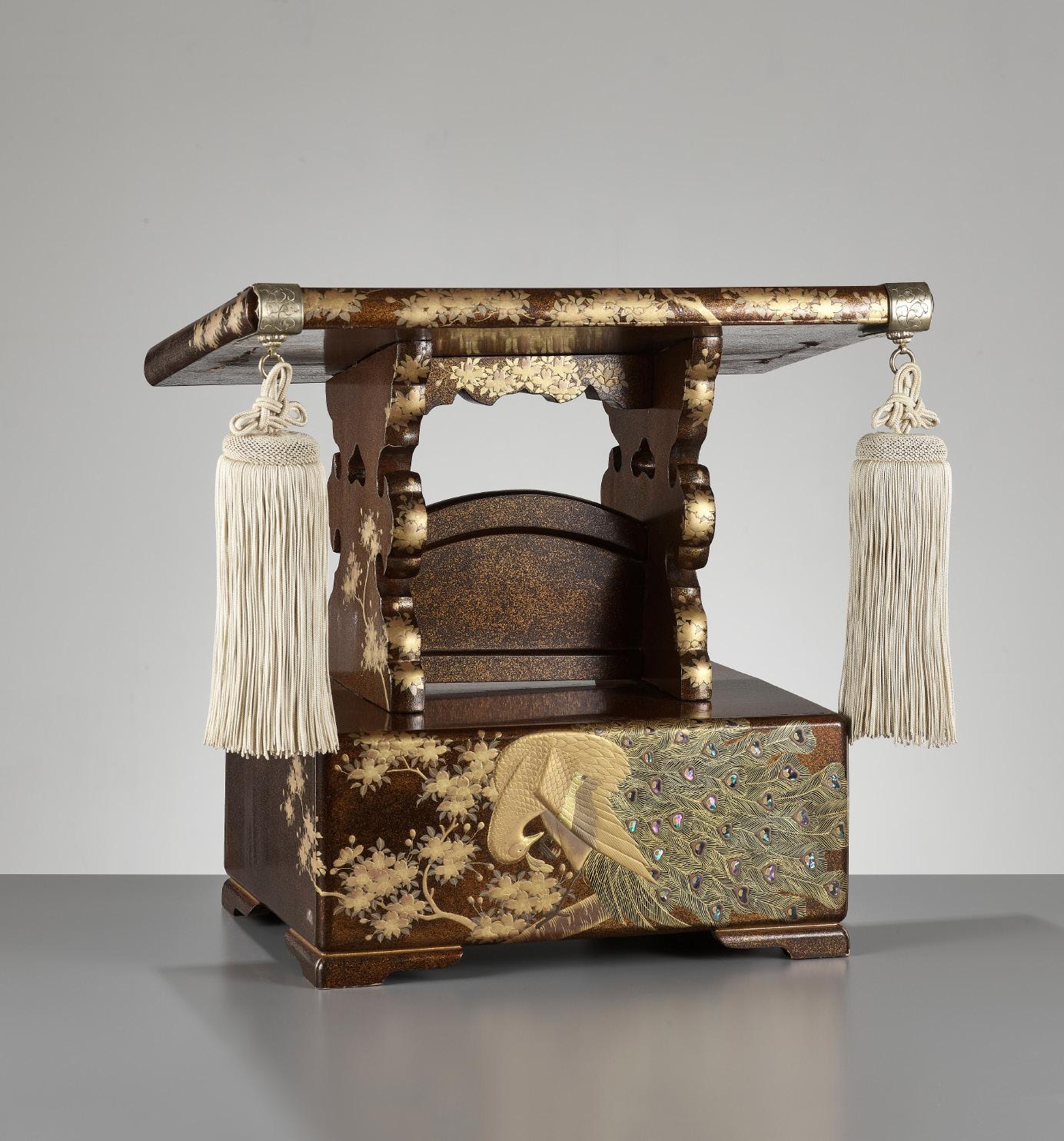
HEIGHT 49.5 cm (total), WIDTH 51.5 (the reading stand)
Condition: A large crack to the reading stand (this can easily be covered). Some general wear, age cracks, losses to lacquer and mother-of-pearl inlay.
The wood storage box with an inscription to the back of the cover:
兵庫縣西ノ宮町辰馬悦蔵殿ヨリ明治三拾九年十二月二十八日御見臺
“Hyogo-ken Nishinomiya-cho Tatsuuma Etsuzo dono yori, Meiji sanjukyunen junigatsu nijuhachi nichi, on Kendai zoyo sera ruru, Ootsuka Seishichi” [This lectern table was given to me (Ootsuka Seishichi) from Tatsuuma Etsuzo whose residence is Nishinomiyacho of Hyogo Prefecture on the 28th of December in Meiji 39 (1906)].
Estimate EUR 3,000
Starting price EUR 1,500
10 2
贈与セラルゝ、大塚清質
3 A LACQUER MINIATURE KAGO (PALANQUIN)
Japan, late 19th century, Meiji period (1868-1912)
The miniature palanquin with gilt-metal fittings, some of which are chased and incised with foliate designs on a ring-punched ground, and finely lacquered with imitation-rattan as well as gold hiramaki-e karakusa and scroll on roiro. Three sides with a sliding door, each with barred window, opening to reveal the interior with papered sides decorated with silver flakes, two of the windows with silk and bamboo blinds. The roof with two hinged upward-opening panels and fitted at the top with a similarly lacquered three-section carrying pole.
HEIGHT 21.5 cm, LENGTH 71 cm
4 A BLACK AND GOLD LACQUER HOKAI (FOOD CONTAINER)

Japan, 19th century
Of circular form with ribbed sides, supported on four tall spreading feet, of roiro lacquer decorated in gold hiramaki-e with two stylized butterflies, the gilt-metal fittings neatly chased and incised, of lobed form with foliate designs against a ring-punched ground, and lozenge form incised with stylized flowerheads. The interior of the cover with an old inscribed label.
HEIGHT 43 cm, DIAMETER 36.4 cm
Condition: Very good condition with minor wear, few small nicks, light surface scratches, few tiny flakes and chips to edges.
AUCTION COMPARISON
Compare a related pair of lacquer hokai, dated 19th century, 40.5 cm high, at Christie’s, The Collection of Pierre Durand, 27 January 2022, New York, lot 46 (sold for 5,000 USD).

Estimate EUR 1,200
Starting price EUR 600
Condition: Very good condition with minor wear, few minor age cracks, one of the hinged doors to the roof slightly warped, few minor losses.
AUCTION COMPARISON
Compare a related lacquer miniature palanquin, dated mid-late 19th century, Edo-Meiji period, at Bonhams, 19 March 2013, New York, lot 2317 (sold for 4,000 USD).


Estimate EUR 1,500
Starting price EUR 800
11
A SUPERB GOLD LACQUER INRO-DANSU (STORAGE CABINET FOR INROS)
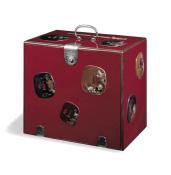
Japan, Meiji period (1868-1912)
Of rectangular form with recessed gold fundame edges, supported on a shaped foot lacquered in gold fundame, the exterior bearing a nashiji ground richly decorated in gold and colored takamaki-e and hiramaki-e with inlays of bone to depict various inro and netsuke as well as plain globular ojime.

The right door with an inro showing Jurojin reading a scroll beside a deer, with a paddle-shaped netsuke of an actor wearing an Okina mask and holding a fan. The left door with an inro depicting a noble lady seated on a terrace and looking out toward a mountain landscape under thick clouds and a full moon, with a figural netsuke of an actor wearing an Okame mask and holding a fan. The right side with an inro of a lady and boy in a garden by a meandering stream, with a netsuke of a sambaso dancer. The left side with an inro of a cockerel perched on a war drum, with a netsuke of Fukurokuju. The top with an inro of a demoness and a swordsmith, with a netsuke of Ebisu, as well as an inro depicting a large ship, with a netsuke of a duck.


The doors open to reveal four drawers with silver handles, each of nashiji with gold fundame edges and finely decorated in gold hiramaki-e with floral sprays including prunus, iris, and bellflower, the interiors of the doors with a roiro-mura-nashiji ground decorated in gold and silver hiramaki-e with autumnal flowers including aster, bellflower, and bush clover.
The silver fittings comprise shaped handles to the sides incised with foliate designs, door hinges chased and incised with foliate designs against a ring-punched ground, and similarly crafted door handles with a shaped hinge lock.
SIZE 24.3 x 29 x 23.3 cm
Condition: Very good condition with minor wear, few scattered minuscule losses to lacquer. Presents beautifully.
Provenance: Ex-collection Shep Brozman, New York.
AUCTION COMPARISON
Compare a related lacquer inro-dansu decorated with tsuba, dated second half of the 19th century, at Christie’s London, Netsuke & Lacquer from the Japanese Department of Eskenazi, 17 November 1999, London, lot 23 (sold for 25,300 GBP).
Estimate EUR 25,000
Starting price EUR 12,000
12 5
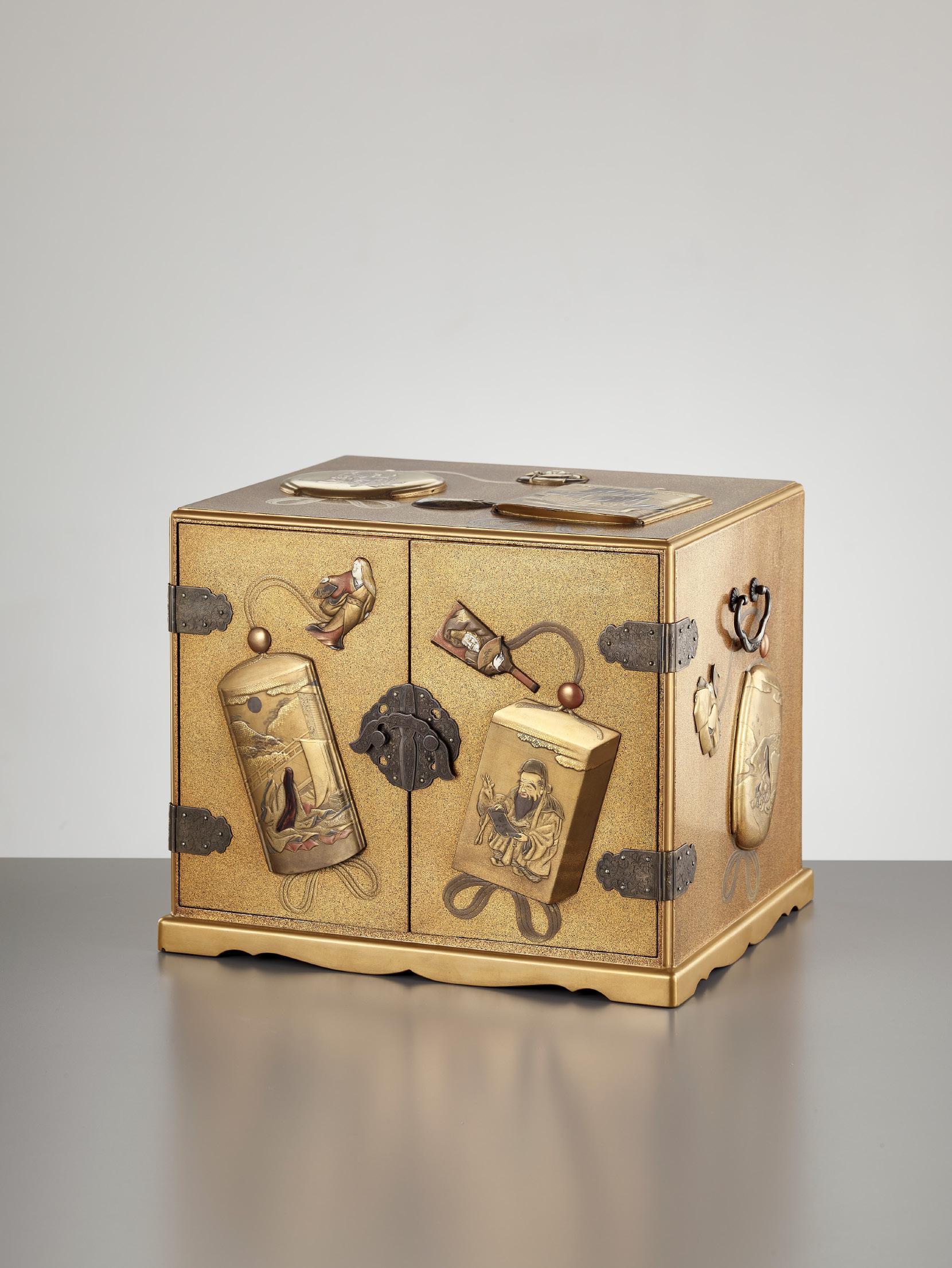
A LACQUER MINIATURE KODANSU (CABINET) WITH SCENES FROM SHITAKIRI SUZUME (THE TALE OF THE TONGUE-CUT SPARROW)

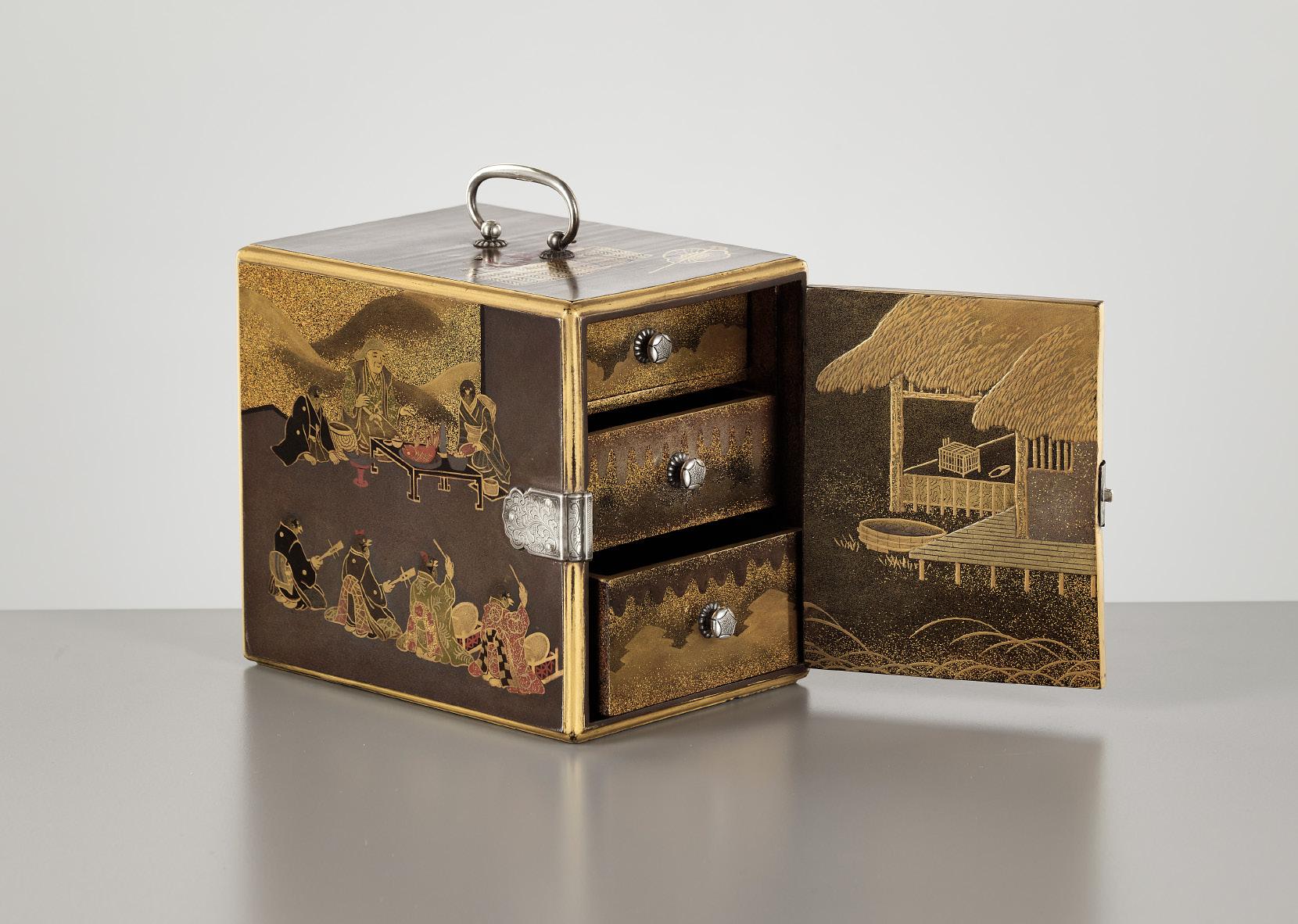
Japan, 19th century
Of rectangular form with recessed gold fundame edges, bearing a rogin-nuri ground finely decorated in iro-e togidashi-e and e-nashiji to depict scenes from Shitakiri Suzume, with elaborately dressed humanoid sparrows leading the elderly man into the bamboo grove to meet his sparrow friend, and others dancing and playing musical instruments to entertain the man while he enjoys a feast, the top of the box with a fan and a chest filled with treasure including jewels, coral, and shells. The top of the box with a silvered-metal handle and the hinged door with silvered-metal fittings chased and incised with foliate designs against a ring-punched ground. The door opening to three drawers decorated with clouds and mountain peaks designs on nashiji, the interior of the door decorated in gold and silver hiramaki-e and takamaki-e with mura-nashiji and hirame to depict the man’s farmhouse.
SIZE
10.6 x 8 x 11 cm
Condition: Very good condition with minor wear, light surface scratches, minor age cracks.
Provenance: Collection of Drs. Edmund and Julie Lewis, no. 98 (label to base). Bonhams, Property from the Collection of Drs. Edmund and Julie Lewis, Part I, 11 September 2019, lot 562. A private collection in New York, USA, acquired from the above. Drs. Edmund Jean and Julia Breyer Lewis are renowned experts
in nephrology who met professionally and later married in 1997, and have since continued to collect Japanese art together, actively seeking the best they could find from the finest dealers in the field. Known for their keen scholarship and high aesthetic standards, for the past three decades Ed and Julie have focused on collecting lacquer art, painting, and Buddhist sculpture from Japan. As they traveled widely their desire to collect Buddhist art grew, and they have expanded their collection to include important Pan-religious sculptures from Greater Asia.
Shitakiri Suzume, translated literally into ‘Tongue-Cut Sparrow’, is a traditional Japanese fable telling of a kind old man, his avaricious wife, and an injured sparrow. The story explores the effects of greed, friendship and jealousy on the characters.
Estimate EUR 4,000
Starting price EUR 2,000
14
6
7
A LACQUER MINIATURE KODANSU (CABINET) DEPICTING THE NUNOBIKI FALLS

Japan, 19th century
Of rectangular form with recessed edges, the variously toned mura-nashiji ground finely decorated in gold and silver hiramaki-e and takamaki-e with kirikane and e-nashiji to depict two waterfalls, one descending across the top and door and the other gushing between craggy rocks to the left side of the door. The kodansu with silver fittings chased and incised with foliate designs against a ringpunched ground, the handle with a sliding lock mechanism. The hinged door opening to reveal three drawers, each decorated in gold takamaki-e against a sparse gold and silver nashiji ground, the sides and interiors of dense nashiji with gold fundame edges, the interior of the door similarly decorated with bamboo.
SIZE 10.5 x 8.2 x 11 cm
Condition: Very good condition with minor wear, particularly to the underside.
Provenance: From a German private collection.
The scenery embellishing this box is a classic motif of Japanese literature and art. The word nunobiki means “stretched cloth,” here realized as a silken cascade descending across the top and door. Nunobiki Falls is a set of waterfalls near downtown Kobe, considered one of the greatest ‘divine falls’ together with Kegon Falls and Nachi Falls. The Nunobiki Falls comprises four separate falls: Ontaki, Mentaki, Tsutsumigadaki, and Meotodaki.
Estimate EUR 4,000
Starting price EUR 2,000

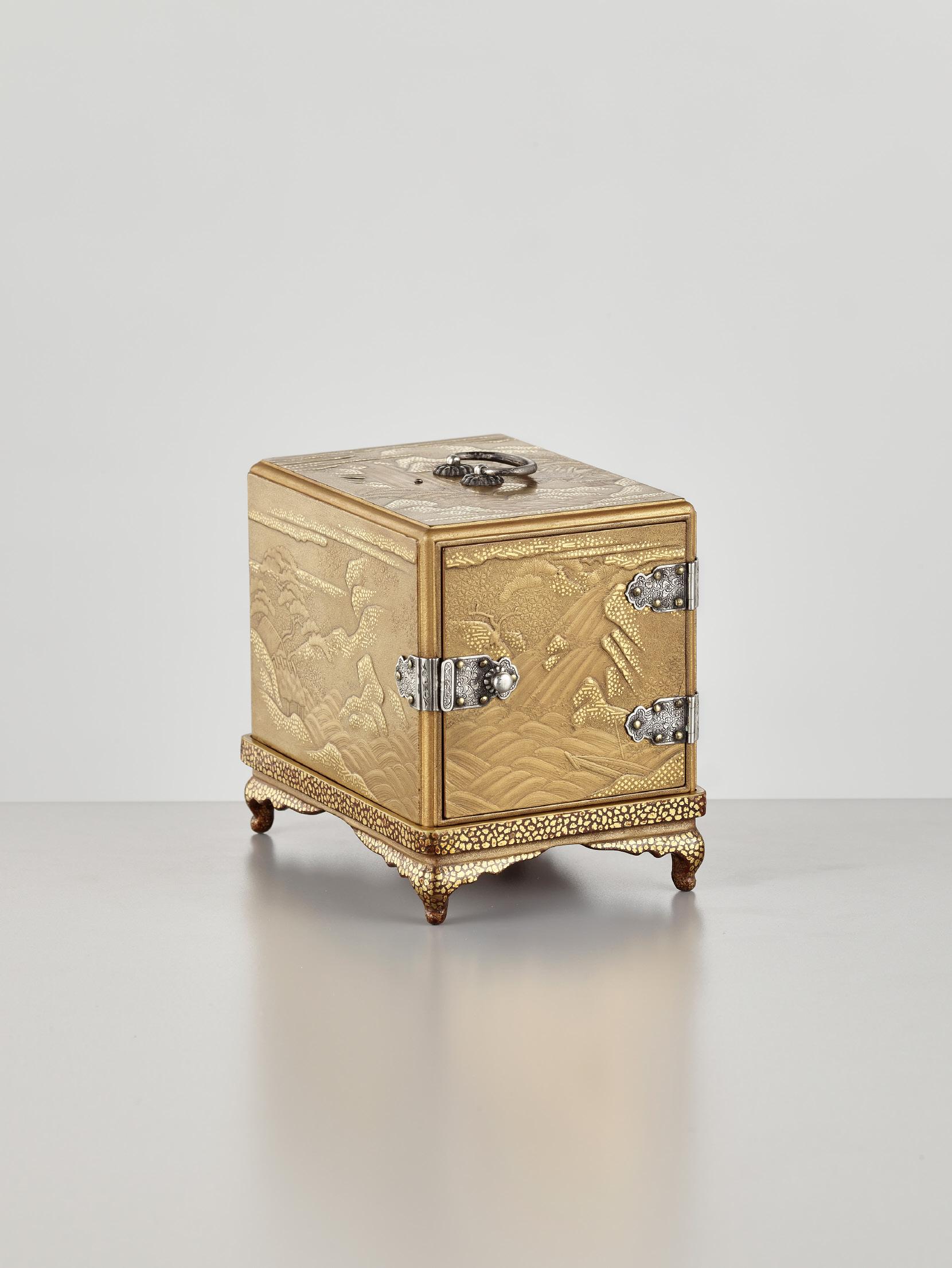
A SUPERB LACQUER MINIATURE KODANSU (CABINET) DEPICTING THE NUNOBIKI FALLS WITH EN-SUITE LACQUER STAND

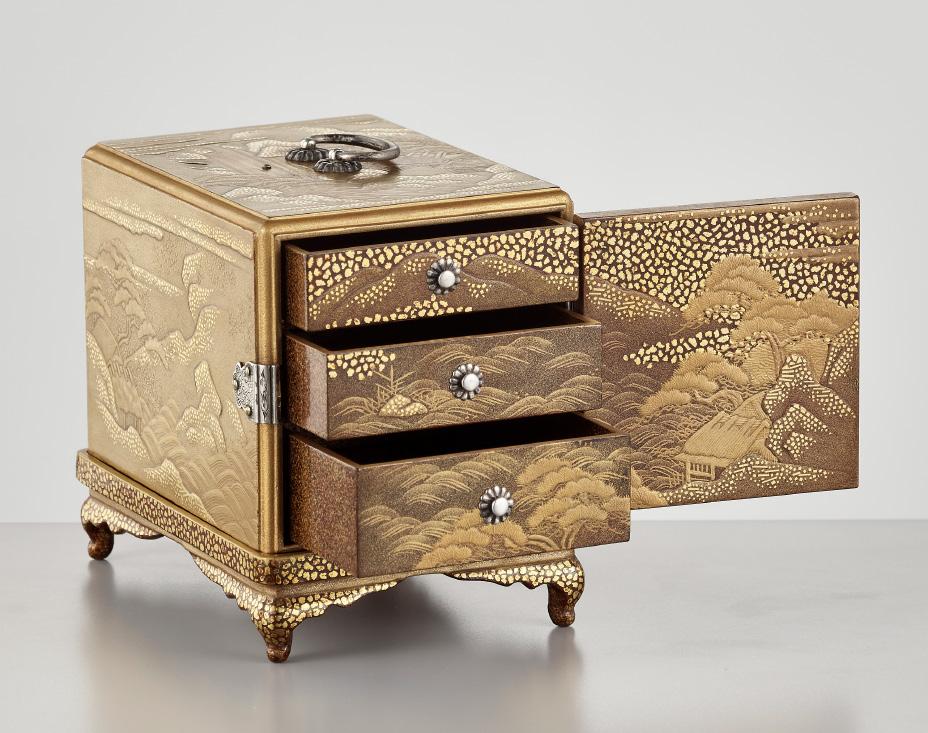

Japan, 19th century
Of rectangular form with recessed edges, bearing a gold-lacquered ground finely decorated in gold hiramaki-e and takamaki-e with kirikane to depict waterfalls gushing between craggy rocks below thick clouds, the door with a boat adrift in the water, the scenery further with thatched-roof houses and pine trees. The kodansu with silver fittings chased and incised with foliate designs against a ring-punched ground, the handle with a sliding lock mechanism. The hinged door opening to reveal three drawers with silver handles and decorated in gold hiramaki-e and takamaki-e with e-nashiji, gyobu nashiji, and kirikane against a reddish-brown ground to depict mountains, rocks, trees, and waves, the interiors of rich nashiji with gold fundame edges, the interior of the door similarly decorated. The kodansu is supported on a separately carved four-legged stand similarly decorated with gyobu nashiji to the sides, legs, and shaped apron.
SIZE 8.2 x 7.8 x 10.6 cm
Condition: Very good condition with only very minor wear.
With a red-lacquered wood storage box (tomobako)
The scenery embellishing this box is a classic motif of Japanese literature and art. The word nunobiki means “stretched cloth,” here realized as a silken cascade descending across the top and door. Nunobiki Falls is a set of waterfalls near downtown Kobe, considered one of the greatest ‘divine falls’ together with Kegon Falls and Nachi Falls. The Nunobiki Falls comprises four separate falls: Ontaki, Mentaki, Tsutsumigadaki, and Meotodaki.
AUCTION COMPARISON
Compare a lacquer kodansu depicting the Nunobiki Falls, dated 19th century, at Christie’s, 21 March 2012, New York, lot 919 (sold for 35,000 USD).
Estimate EUR 10,000
Starting price EUR 5,000
17 8
A SHIBAYAMA-STYLE INLAID MINIATURE KODANSU (SMALL CABINET) WITH MILLEFLEUR DESIGN
Signed Masa Japan, Meiji period (1868-1912)
Of rectangular form, supported on four short bracket feet decorated with gyobu nashiji, the exterior richly inlaid in motherof-pearl and stained bone with an elaborate cluster of assorted flowers and leaves, including peony, cherry, aster, and narcissus. The front with three drawers of different sizes, similarly inlaid around gyobu nashiji and fitted with coral knops, the interiors of rich nashiji with gold fundame edges. The base of rich nashiji with a central red-lacquered oval reserve with the signature MASA.



SIZE 7.1 x 6.5 x 9.4 cm
Condition: Good condition with minor surface wear, minor age cracks, the feet with minor old repairs, the drawers with shallow tiny chips to edges.
AUCTION COMPARISON Compare a related Shibayama-style inlaid box and cover with millefleur design by Masanaga, dated Meiji period, at Bonhams, 14 May 2015, London, lot 297 (sold for 5,250 GBP).
Estimate EUR 2,000
Starting price EUR 1,000
18 9
10
Japan, 18th century, Edo period (1615-1868)
Formed as conjoined triple-lozenge shapes, the top of the cover finely lacquered in gold and silver takamaki-e and hiramaki-e with kirikane and gold foil to depict the poetess Ono no Komachi looking out a window, surrounded by pine trees and saplings as well as a gnarled prunus branch, below thick clouds, further with bush clover and other autumnal flowers, the edges with scrolling vines and flowerheads, the sides with a gold-lacquered rinzu pattern
on a roiro ground. The interior of the cover with a nashiji ground finely lacquered in gold hiramaki-e with a lobed panel enclosing blossoming aster and bellflower, the interior of the box similarly decorated with a gnarled prunus branch over crashing waves. The base of rich nashiji.



LENGTH 22.3 cm
Condition: Very good condition with minor wear, few tiny age cracks, light surface scratches.
Estimate EUR 2,500
Starting price EUR 1,200
19
A FINE LACQUER BOX AND COVER WITH INTERIOR TRAY
11
ZOHIKO: A LACQUER KOBAKO (SMALL BOX) AND COVER DEPICTING A SEASHORE LANDSCAPE WITH PAGODA

By the Zohiko Company, Zohiko seal mark
Japan, 19th century
Of rectangular form, the reddish-brown mura-nashiji ground finely decorated on the cover in predominantly gold hiramaki-e and kirikane with a pagoda rising from a thick pine forest on the seashore with further buildings, all below mountains towering in the background, a lone boatman paddling in the water. The interior
of rich nashiji with gold fundame edges. The base of nashiji and lacquered with the elephant seal of the Zohiko Company.
SIZE 5.3 x 16.7 x 9.3 cm
Condition: Excellent condition with minor wear.
The Zohiko Company is a famous company of lacquerers established in the late 17th century and still active today.
Estimate EUR 1,500
Starting price EUR 800
12
A LACQUER KOBAKO (SMALL BOX) AND COVER WITH AUTUMN FLOWERS

Japan, 19th century
Of rounded rectangular form, bearing a kinji ground finely decorated in gold and silver takamaki-e and hiramaki-e with autumnal flowers, leaves, and grasses, the background with distant pine trees and undulating hills. The interior and underside of rich nashiji, the interior further with gold fundame edges.
SIZE 4.5 x 9.2 x 7.7 cm
Condition: Very good condition with minor wear, few minuscule losses.
Estimate EUR 1,500
Starting price EUR 800
13
A RARE LACQUER BOX AND COVER WITH INTERIOR TRAY AND TWO SMALLER BOXES, FOR THE INCENSE MATCHING GAME
Japan, 19th century, Edo period (1615-1868)
Of rectangular form, bearing a richly gold-sprinkled roiro ground finely decorated in gold hiramaki-e and takamaki-e with muranashiji and kirikane to depict a mountain landscape with willows and pines, a bridge over a meandering river with neatly painted waves, and a thick cloud. The interior of rich nashiji with gold fundame edges, the underside also of nashiji and pierced with a circular aperture. The box contains a similarly decorated tray and two small boxes with a similarly gold-sprinkled kinji ground decorated to the covers with circular panels enclosing aster and gardenia flowers, respectively, with nashiji interiors and undersides.
SIZE 3.6 x 8.3 x 5.9 cm
Condition: Excellent condition with minor wear.
Provenance: From an old private collection in the United Kingdom. The cover of the tomobako with an old label to the interior, ‘Curios, H. Sato & Co., 58 Motokago-Machi, Nagasaki, Japan’. An old card inscribed with a personal poem dedicated to the previous owner’s “dear teacher from Vita” accompanies this lot.
With a wood storage box (tomobako).
The present set was used for the incense matching game. Like the Way of Tea and flower arrangement, the enjoyment of incense had developed into a complex pastime by the Edo period and had a large following during the seventeenth century. The various games involve guessing a fragrance from among more than 2,000 varieties, matching fragrances, and blending incenses to suggest certain moods.
AUCTION COMPARISON
Compare a closely related lacquer incense box with tray and four lacquer boxes, sold at Woolley & Wallis, Japanese Works of Art, 7 December 2020, Salisbury, lot 376 (sold for hammer price 4,000 GBP).



Estimate EUR 4,000
Starting price EUR 2,000
A RARE LACQUER SMOKING SET (TABAKO BON) IN THE FORM OF A BOAT
Japan, late 19th century, Meiji period (1868-1912)
The boat of typical form, the two masts on either end forming the handle of the smoking set, which like the deck is lacquered in imitation of wood grain, further with gold-lacquered ‘fittings’ and scrolling foliage. The deck is fitted with a kobako and cover bearing a roiro ground finely decorated in gold and silver hiramaki-e and takamaki-e with mura-nashiji to depict on the cover two huts under a towering pine tree with bundles of sticks, rakes, and baskets, all above crashing waves also painted on the sides, the interior of nashiji with gold fundame edges. The deck is further fitted with a two-compartment box holding a silver ash jar (hiire) with pierced cover and a silver box with hinged bamboo-form handle surmounted by a lacquer ‘thatched roof’ decorated with prunus sprays and bundles of sticks. The hull bearing a reddishbrown lacquered ground decorated in gold and silver hiramaki-e and takamaki-e and silver inlays with imitation wood grain and waves crashing along the sides. The hull is further fitted with three drawers similarly decorated to the kobako with crashing waves and nashiji interiors. The underside of rich nashiji and fitted with four wheels.


LENGTH 37.6 cm, HEIGHT 23.8 cm
Condition: Good condition with minor wear, few small age cracks, few minor chips, minor old repairs, two drawers to the hull are rigid.
AUCTION COMPARISON
Compare a related lacquer smoking set modeled as a boat, also dated late 19th century, Meiji period, at Christie’s, 22 April 2015, New York, lot 76 (sold for 7,500 USD).

Estimate EUR 3,000
Starting price EUR 1,500
22 14
15
A LACQUER KOGO (INCENSE BOX) AND COVER IN THE FORM OF A PUPPY

Japan, late 19th century, Meiji period (1868-1912)
The plump puppy seated on its haunches, the animal well detailed with a short curled tail, neatly incised piebald fur, and long brows and whiskers, all finely lacquered in gold and colored hiramaki-e, its pleading eyes and slightly tilted head conveying a begging expression.
LENGTH 7.2 cm
Condition: Very good condition with minor wear, few microscopic age cracks, the interior with a tiny shallow chip, light surface scratches.
Estimate EUR 1,500
Starting price EUR 800
16
A FINE LACQUER KOGO (INCENSE BOX) AND COVER IN THE FORM OF HOTEI
Japan, late 19th century, Meiji period (1868-1912)
The Lucky God seated and leaning against his huge sack, wearing a loose-fitting roiro robe decorated in gold hiramaki-e with cloud designs, opening to reveal his chest and rotund belly, his skin lacquered gold, his face with a typically cheerful expression with the mouth wide open in a hearty laugh, further with narrowed eyes below thick brows and a broad nose, flanked by huge pendulous earlobes. The interior of nashiji with gold fundame edges.
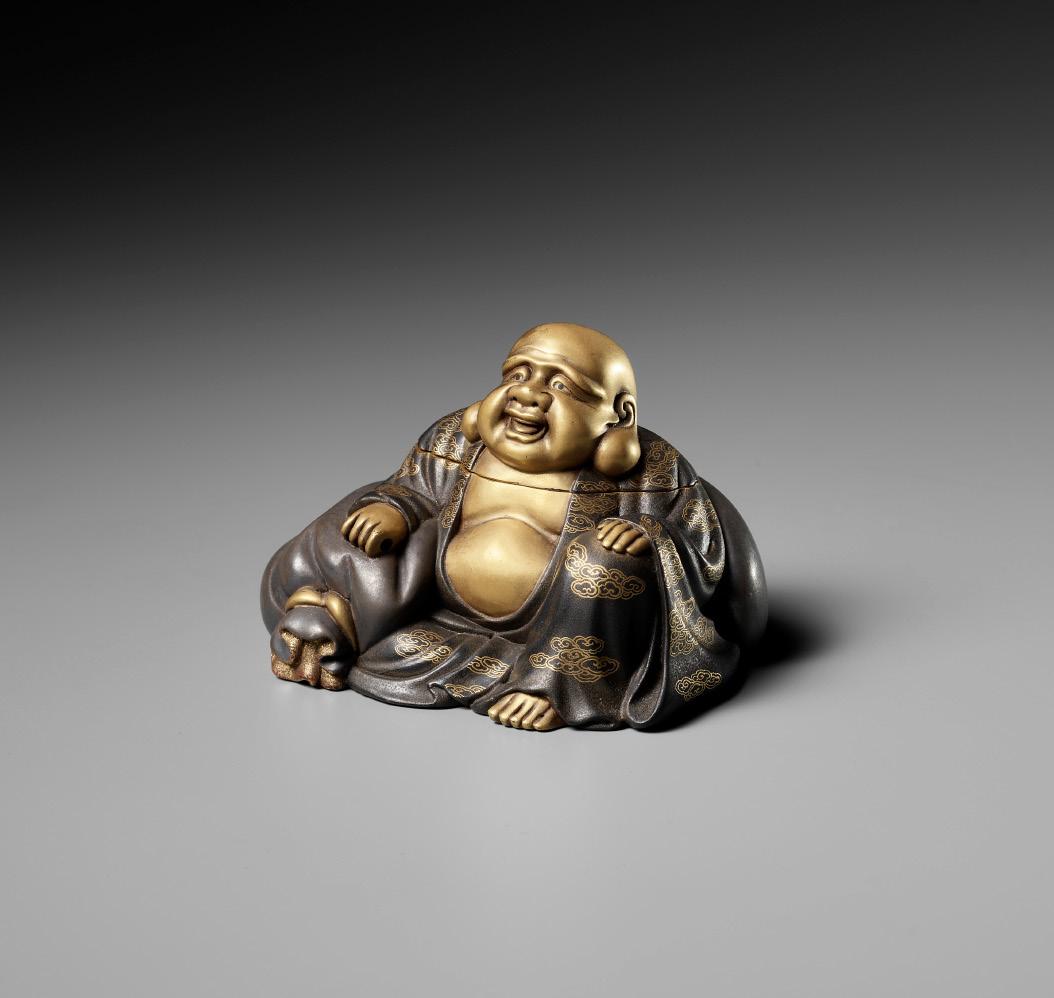
WIDTH 10.5 cm
Condition: Very good condition with minor wear, the interior cover with tiny chips.
Estimate EUR 2,500
Starting price EUR 1,200
23
A FINE RINPA-STYLE INLAID LACQUER KOGO (INCENSE BOX) WITH CAMELLIA BLOSSOMS
Style of Ogata Korin (1658-1716), unsigned Japan, 19th century, Edo period (1615-1868)
Of circular form with a lenticular top and base, bearing a kinji ground finely decorated in gold and black takamaki-e and hiramaki-e with inlays of mother-of-pearl and pewter to depict camellia blossoms borne on leafy stems, the interior similarly decorated with leaves and flowers of sarutori ibara (china root, Smilax china) floating in a stream.

DIAMETER 7.6 cm
Condition: Very good condition with some wear and few minor losses to lacquer.
Provenance: From an old French private collection. The interior with two old inventory labels, ‘31’ and ‘261’, as well as a cut-out of an old catalog description of the present lot.
Ogata Korin (1658-1716) was a famous and highly influential Japanese landscape illustrator, lacquerer, painter, and textile designer of the Rinpa School. Korin is best known for his byobu folding screens, such as Irises and Red and White Plum Blossoms (both registered National Treasures), and his paintings on ceramics and lacquerware produced by his brother Kenzan (1663-1743). Also a prolific designer, he worked with a variety of decorative and practical objects, such as round fans, makie writing boxes, or inro medicine cases. He is also credited with reviving and consolidating the Rinpa school of Japanese painting, fifty years after its foundation by Hon’ami Koetsu (1558-1637) and Tawaraya Sotatsu (c. 1570-c. 1640). In fact the term ‘Rinpa’, coined in the Meiji period, means ‘school of [Ko]rin’. In particular, he had a lasting influence on Sakai Hoitsu (1761-1828), who replicated many of his paintings and popularized his work, organizing the first exhibition of Korin’s paintings at the hundredth anniversary of his death.
Estimate EUR 1,500
Starting price EUR 800
18
SOSHO: A LACQUER KOGO (INCENSE BOX) AND COVER DEPICTING UJI BRIDGE

By Sosho, the tomobako signed Sosho Japan, early 20th century, Meiji period (1868-1912) to Taisho period (1912-1926)
Of circular form with a short broad foot and slightly domed cover, bearing a lustrous roiro ground finely decorated in gold and silver hiramaki-e with a bridge surrounded by gnarled pines and a willow, the interior of roiro left undecorated.
SIZE 2.3 x 10.7 x 11 cm
Condition: Excellent condition with minor wear.
With a wood storage box (tomobako) inscribed and signed Kogo Ujibashi SOSHO saku (‘An incense container with the design of Uji Bridge made by SOSHO’) with the seal SOSHO.
A bridge with willows immediately evokes the bridge over the Uji River in southeast Kyoto, a view long celebrated in literary works such as The Tale of Genji. Uji serves as the setting for the last ten chapters of The Tale of Genji, ending with ‘The Bridge of Dreams.’ Paintings of the Uji Bridge decorated palaces by the 900s and remained popular for the next thousand years.
Estimate EUR 1,200
Starting price EUR 600
24 17
19
A FINE LACQUER KOGO (INCENSE BOX) AND COVER WITH KABUTO AND BAMBOO HANAKAGO

Japan, 19th century
Of circular form, with a slightly domed cover and supported on a short foot, with silver rims. The exterior and interior of rich nashiji, top of the cover finely decorated in gold and colored takamaki-e as well as kirikane and inlays of mother-of-pearl with a kabuto with kuwagata maedate as well as a bamboo hanakago (flower vase) bearing leaves and reeds.
DIAMETER 7.9 cm
Condition: Excellent condition with minor wear.
Provenance: Collection of Gaston Lazard (18781956) and his wife Jane Levy (1886-1985), thence by descent within the same family.
Estimate EUR 1,500
Starting price EUR 800
20
NURUDEAN MITSUHIDE: A RARE LACQUER TSUBA WITH AUTUMN GRASSES AND MOON
By Nurudean Mitsuhide (Nurudean Koei, 1802-1871), signed Nurudean saku Japan, mid-19th
century,
Edo period (1615-1868)
Of nadekaku-gata shape, the nakago-ana with some carved ‘sekigane’, the ground finely lacquered to simulate shibuichi, the design lacquered in gold and silver takamaki-e depicting autumn grasses and the moon partially obscured by clouds, the verso with three gold-lacquered kamon including the sixteen-petaled imperial seal (kikumon), a mitsudomo-e crest, and the Minamoto clan mon. Signed in gold lacquer NURUDEAN saku [made by Nurudean]. With a wood storage box.
SIZE 9.5 x 9.2 cm
Condition: Very good condition, some minor wear and rubbing to lacquer.
Nurudean Mitsuhide (1802-1871) studied lacqer at the Kajikawa school workshop in Edo and returned to his home town and served as an official lacquer artist to Matsudaira Naritaka, the 9th daimyo lord of the Matsue Domain, in modern Shimane Prefecture. His son Shunko (1847-1906) also became a lacquer artist.
AUCTION COMPARISON
Compare a related lacquer tsuba with a design of geese and the moon, at Zacke, Fine Chinese Works of Art, Japanese and Buddhist Art, 29 September 2018, Vienna, lot 170 (sold for 3,400 EUR).



Estimate EUR 1,500
Starting price EUR 800
25
KAJIKAWA: A SUPERB SET OF THREE LACQUER SAKE SAUCERS DEPICTING BUDDHA AND THE BODHISATTVAS MONJU (MANJUSHRI) AND FUGEN (SAMANTABHADRA)


By a member of the Kajikawa family, each signed Kajikawa saku Japan, 19th century, Edo period (1615-1868)
Each of circular form with shallow rounded sides supported on a short spreading foot, bearing a silver ground to the interior finely decorated in gold and colored takamaki-e, hiramaki-e and togidashi-e. The largest depicting Buddha seated in dhyanasana, wearing loose-fitting robes decorated with stylized lotus and scrolling foliage, his serene face with heavy-lidded eyes and full lips forming a calm smile, the hair arranged in tight curls over the ushnisha; the second-largest depicting Monju Bosatsu (Manjushri) seated on a shishi and reading a scroll; the smallest depicting Fugen Bosatsu (Samantabhadra) seated on an elephant and holding a nyoi-scepter. All three deities are backed by circular halos. The exteriors each red-lacquered, the bases each with the goldlacquered signature KAJIKAWA saku [made by Kajikawa].
DIAMETER 13.8 cm, 12.6 cm, and 11.3 cm
Condition: Excellent condition with minor wear.
Provenance: From the estate of Soo Sui-ling and Dr. Cornelius Osgood, and thence by descent in the same family. The interior of the foot with remnants of an old label. Dr. Cornelius Osgood (1905-1983) was a professor of anthropology at Yale University
and a leading scholar of the cultures of the Arctic and East Asia. His association with the Peabody Museum of Natural History at Yale began in 1930 when he joined the university’s faculty, and over the years he was instrumental in building up and organizing the museum’s collection. He became curator of the museum’s anthropology department in 1934 and was appointed the Peabody’s associate director in 1966. He held both positions until his retirement in 1973. His publications include a multivolume study of the Athabascan tribes of northern Canada and Alaska as well as Winter, a memoir of the year he spent living among the Indians of Canada’s Northwest Territories in the 1920s. In later years, he specialized in Far Eastern societies, publishing “The Koreans and Their Culture” in 1951, and “Village Life in Old China” in 1963.
The Kajikawa family were Japanese lacquerware artists whose school in Edo flourished for more than 200 years. Kyujiro is generally acknowledged as the founder of the family and the inaugurator of its traditions. He excelled in designing particularly delicate lacquer inro. Kajikawa artists also designed lacquer netsuke. Other lacquer objects by this school are considerably rarer than inro and netsuke.
MUSEUM COMPARISON
Compare a related single sake cup, signed Kajikawa, in the Victoria & Albert Museum, London, accession no. W.141-1921.
Estimate EUR 2,500
Starting price EUR 1,200
26 21
MASAHARU: A LACQUER NATSUME (TEA CADDY) DEPICTING A LANDSCAPE

By the Arai Masaharu studio, signed on the tomoboka Masaharu with seal Masaharu Japan, Showa period (1926-1989)
Of cylindrical form, bearing a richly gold-sprinkled black-lacquered ground decorated in gold hiramaki-e and takamaki-e with kirikane to depict a continuous scene with a bridge over a river amid craggy rockwork and a willow, the top of the cover with a thatched cottage below hazy mountains in the background. The countersunk base and the interior of rich nashiji, the interior further with gold fundame edges.
HEIGHT 7 cm
Condition: Excellent condition with minor wear.
With a wood storage box (tomobako) signed MASAHARU with seal Masaharu.
Estimate EUR 1,200
Starting price EUR 600 23
TAKESHI: A LACQUER NATSUME (TEA CADDY) WITH CHRYSANTHEMUM

By Wakashima Takeshi, the tomobako signed Takeshi with seal Takeshi Japan, second half of 20th century, Showa period (1926-1989)
Of typical form with a flush-fitting cover, bearing a lustrous silvery purple-lacquered ground, finely decorated in gold takamaki-e with stylized chrysanthemum flowerheads. The countersunk base and interior of rich nashiji, the interior further with gold fundame edges.
HEIGHT 7.2 cm
Condition: Excellent condition with minor wear.
The wood storage box (tomobako) inscribed and signed Murasaki kin shiragiku, natsume, TAKESHI saku (‘Natsume tea caddy, in purple and gold colours, with the design of white chrysanthemums, made by Takeshi’) with the seal TAKESHI.
Wakashima Takeshi (b. 1940), art name Sosai (Munenari), is a Japanese lacquer artist and the Vice-President of the Shin Nihon Bijutsuin (New Japan Art Institute).
Estimate EUR 1,500
Starting price EUR 800
27 22
KASHIMA KEISAI: A SET OF 20 SUPERB ZESHIN-SCHOOL LACQUERED WOOD OSHIKI-ZEN TRAYS

The lacquerwork by Kashima Keisai, each tray signed Keisai, the woodwork by Maeda Nansai (1880-1958), the tomobako with a paper label signed Nansai saku Japan, Tokyo, Taisho period (1912-1926)
Each of rectangular form, bearing a wood ground of attractive grain and color, finely decorated in iro-e takamaki-e and hiramaki-e with various plants and vegetables, including eggplant, cucumber, bamboo shoots, lotus, chili peppers, daikon radish, edamame, chestnuts, and fungi. Each tray with a gold-lacquered signature KEISAI.
The set of twenty trays is stored inside the original wood tomobako storage box with inscription to the hakogaki: 野菜盡し慶哉蒔繪、 桑製、彫抜脇膳、貮拾人前 大正八年十二月、指物師、前田南斎作

Yasai zukushi, Keisai, makie, kuwa sei, horinuki wakizen, nijuunin mae [A set of twenty lacquer serving trays, with the designs of fruits and vegetables, made of mulberry wood, made by Keisai (Kashima Keisai)].

With a collector’s seal: 浅見蔵印 Asami zo in [The seal of the Asami Family].
With an applied label written in ink: 第智十号、桑彫貫、果物画蒔 絵、折敷膳、南斎作 廿人前 Dai chi ju go, kuwa horinuki, kudamono ga makie, oshikizen, Nansai saku, nujunin mae [A set of twenty lacquer serving trays, made of carved mulberry wood, with the designs of fruits and vegetables, the woodwork by Nansai].
SIZE 30.5 x 31.5 cm (each)
Condition: Excellent condition with minor wear.
Kashima Keisai was a pupil of Ikeda Keishin, who studied lacquer under Ikeda Taishin (1825-1903) and later became his adopted son. Ikeda Taishin was the chief pupil of the famous lacquer artist Shibata Zeshin (1807-1891).
Maeda Nansai (1880-1958) exhibited at the 1925 (Taisho 14) Paris Exposition. He also exhibited at the 1926 (Taisho 15) Philadelphia Exposition, USA, and won a gold prize. His family continues its woodwork crafting tradition and its 4th generation in practice.
Maeda Nansai’s works can be found in the collection at the National Museum of Modern Art, Tokyo.
AUCTION COMPARISON
Compare a single black lacquer tray by Shibata Zeshin at Bonhams, Japanese and Korean Art, 21 September 2022, New York, lot 571 (sold for 8,925 USD).
Estimate EUR 8,000
Starting price EUR 4,000
28 24


25 A RARE LACQUER BUNKO (DOCUMENT BOX) WITH INTEGRATED SUZURIBAKO (WRITING BOX)
Japan, 18th century, Edo period (1615-1868)
Of rectangular form, with silver rims and a flush-fitting cover. The exterior lacquered in nashiji and finely decorated in gold and silver hiramaki-e to the cover with two confronting ho-o (phoenixes) with wings and tail feathers continuing over to the sides which are similarly decorated with various floral and foliate mon, some of which are variations of the kiri (paulownia) mon. The interior lacquered in nashiji and fitted with a removable compartment holding two boards similarly decorated with flowers and grasses and fitted with a suzuri (ink stone) and moon-shaped silver waterdropper (suiteki).


SIZE 10.5 x 22.5 x 18.1 cm
Condition: Good condition with some wear, small dents and few minor tears to silver rims, few minor age cracks.
With a wood tomobako inscribed 梨子地鳳凰蒔絵、御硯箱 “Nashiji-ji hoo makie, on-suzuribako” [Suzuribako in the nashiji lacquer finish, with the design of Hoo birds].
The kiri mon is one of the five major family crests in Japan, and one of the two imperial crests, along with the kiku (chrysanthemum) mon. More than 140 designs of the kiri mon exist. Originally, the paulownia seal was the private symbol of the Japanese Imperial Family, from as early as the sixteenth century. The Toyotomi clan, led by Toyotomi Hideyoshi, later adopted the paulownia seal for use as the crest of his clan. After the Meiji Restoration, the seal was eventually adopted as the emblem of the Japanese government.
Both the ho-o bird and the paulownia (kiri) tree are imperial symbols of Japan. According to legend, the ho-o, a bird similar to the phoenix that represents the eternal rebirth of the soul, only settles on the Kiri tree. In the hope of attracting this auspicious bird that blesses people with wisdom, health and happiness, the trees are planted in courtyards and gardens.
Estimate EUR 2,500
Starting price EUR 1,200
A RARE LACQUERED WOOD SUZURIBAKO (WRITING BOX) DEPICTING A SHISHI AND BUTTERFLY
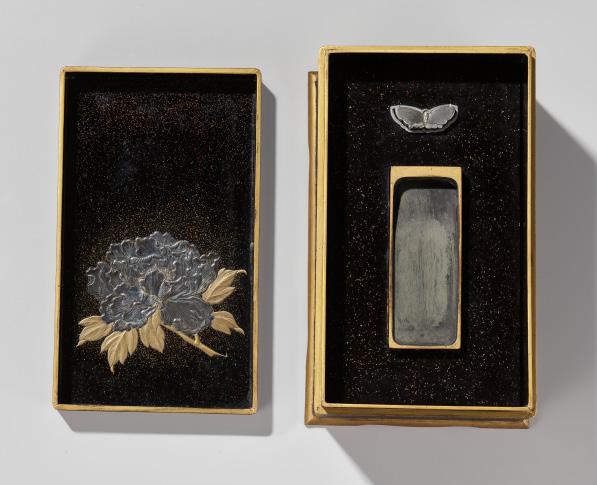

Japan, 19th century
Of rectangular form, supported on a short spreading foot, the box with recessed gold fundame edges, the exterior neatly incised with a floral lozenge diaper. One side of the box with a metal-handled drawer. The top of the cover with a shaped sunken panel bearing a wood ground finely decorated in gold and silver takamaki-e as well as gold foil with a prancing shishi rearing its head toward a fluttering butterfly, the lion well detailed with scrolling tail and mane as well as reverse-painted glass eyes.

The interior of the cover bearing a roiro-mura-nashiji ground decorated in gold and silver takamaki-e with a leafy peony spray with elegantly furled petals. The interior of the box bearing a richly gold and silver-sprinkled roiro ground, the baseboard fitted with a rectangular inkstone (suzuri) and silver waterdropper (suiteki) in the form of a butterfly.
SIZE 13.5 x 24.8 x 14.4 cm
Condition: Good condition with minor wear, flaking and losses to lacquer and gold foil, particularly to the shishi’s back, minor age cracks.
Estimate EUR 2,500
Starting price EUR 1,200
26
A SUPERB LACQUER SUZURIBAKO (WRITING BOX) DEPICTING A MOONLIT FOREST




Japan, 18th-19th century, Edo period (1615-1868)
Published & Exhibited: Cornell University, Herbert F. Johnson Museum of Art, Scattered Gold and Midnight Gloss: Japanese Lacquer from the Anbinder Collection, 31 March – 8 July 2007
Of rectangular form with sumikiri (chamfered) corners, a kabusebuta (overhanging) cover, and silver rims. The exterior bearing a roiro ground, finely decorated in colored hiramaki-e and togidashi-e with e-nashiji and kirikane as well as subtle inlays of aogai, depicting an autumnal forest of maple, cherry, and other trees with creepers, backed with a huge full moon rendered in ginpun.
The interior of the cover bearing a rich nashiji ground decorated in gold, black, and silver takamaki-e and togidashi-e with kirikane and inlays of gold foil and aogai depicting birds perched in pine trees by a swirling stream with insects amid rockwork, flowers, and grasses.
The interior of the box similarly decorated with pine and maple saplings and craggy rocks, and fitted with a board (ita) with raised sections above and below the inkstone suzuri, the upper section fitted with the copper waterdropper (suiteki) in the form of hollyhock (aoi) leaves and blossoms.
SIZE 4.7 x 23.8 x 25.5 cm
Condition: Very good condition with minor wear and few tiny nicks to edges, few light surface scratches, the cover with a minor nick.
Provenance: Christie’s, 24 March 2003, New York, lot 162. The Paul and Helen Anbinder Collection, acquired from the above. Paul Anbinder (b. 1940) is a retired editor who was a director at important publishers including Random House and Hudson Hills. Helen Anbinder (1942-2022) was an education administrator who ran the Inter-village Continuing Education Program for Ardsley, Dobbs Ferry, Hastings, and Irvington, New York. The couple were avid museumgoers and collectors of art. They donated many books and prints from their collection to their alma mater Cornell University and the Herbert F. Johnson Museum of Art.
With a wood storage box (tomobako).
The enormous moon lacquered on the cover of the present suzuribako is reminiscent of the work of Shiomi Masanari (16471722) and his followers, who specialized in togidashi-e (‘brought out by rubbing’) lacquer of extremely high quality, as is exhibited in the present piece.
AUCTION COMPARISON
Compare a lacquer suzuribako by Shiomi Masanari, dated late 19th century, Meiji period, at Christie’s, 1 October 2020, New York, lot 11 (sold for 16,250 USD). Compare a lacquer suzuribako by Shiomi Masanari, dated 19th century, at Bonhams, The Edward Wrangham Collection of Japanese Art Part I, 9 November 2010, London, lot 371 (sold for 21,600 GBP).
Estimate EUR 8,000
Starting price EUR 4,000
32 27

A SUPERB GOLD LACQUER SUZURIBAKO DEPICTING RAIKO’S DREAM
Japan, early 18th century, Edo period (1615-1868)
Published & Exhibited: Cornell University, Herbert F. Johnson Museum of Art, Scattered Gold and Midnight Gloss: Japanese Lacquer from the Anbinder Collection, 31 March – 8 July 2007.
Of rounded rectangular form with a flush-fitting (inrobuta) cover with rounded gold fundame chiri-i (edges) and silver rims. The exterior bearing a densely sprinkled hirame ground finely decorated in gold, silver, and black hiramaki-e and takamaki-e with a Japanese samurai’s bow (yumi), arrows (ya), quiver (ebira), and three-fingered gauntlet (mitsugake) under a large curtain.
The interior of the cover bearing a roiro ground similarly decorated and with iro-e kirikane to depict two birds in flight over densely painted waves above a seashore with pines, other trees, a small pavilion, and craggy rockwork, and below thick clouds.
The interior of the box fitted with a board (ita) with an oblong inkstone (suzuri) and rectangular waterdropper (suiteki) of shibuichi with gilt floral design, and a rectangular tray, each bearing a dense gold hirame ground similarly decorated with waves, grasses, and a pine tree.

Condition: Good condition with minor wear, the interior tray with a small age crack, the interior of the box with few small nicks, the interior of the cover with minor signs of warping, the sides of the box with minor touchups to lacquer.
Provenance: Heian Art, 18 December 2000, Kyoto. The Paul and Helen Anbinder Collection, acquired from the above. Paul Anbinder (b. 1940) is a retired editor who was a director at important publishers including Random House and Hudson Hills. Helen Anbinder (1942-2022) was an education administrator who ran the Inter-village Continuing Education Program for Ardsley, Dobbs Ferry, Hastings, and Irvington, New York. The couple were avid museumgoers and collectors of art. They donated many books and prints from their collection to their alma mater Cornell University and the Herbert F. Johnson Museum of Art.
With a wood storage box (tomobako).
The archery equipment and curtain depicted on the cover of the present suzuribako allude to Minamoto no Mitsunaka (912-997), a noble and skillful archer who held high office under the Emperor Reizei. The interior of the cover depicts Hamamatsu (on the Pacific coast) with pine trees and birds, where Mitsunaka’s son Minamoto no Yorimitsu (Raiko, 948-1021) was believed to have fallen asleep during a hunting expedition, when Jie Hua, the daughter of the great Chinese archer Yang Yaojing appeared to him in a dream. On awakening, Raiko found that Jie Hua had left her father’s bow and arrow beside him.
Estimate EUR 6,000
Starting price EUR 3,000
34 28
SIZE 4 x 19.2 x 21.4 cm


A SUPERB RITSUO-SCHOOL LACQUER AND CERAMICINLAID SUZURIBAKO DEPICTING AN ELEPHANT
School of Ogawa Haritsu (Ritsuo, 1663-1747), unsigned Japan, 18th-19th century, Edo period (1615-1868)
Of rounded rectangular form with an overhanging cover. The exterior bearing a lustrous roiro ground, the cover superbly decorated with inlays of shell and lacquer to depict an elephant standing foursquare above a hoe, the animal well detailed with wrinkly skin, narrowed eyes, gently curved tusks, and sinuous tail and trunk.

The interior of the cover similarly decorated and with further inlays of glazed ceramic to depict a circular fan behind a Chinese campaign curtain on a halberd. The interior of the box fitted with a nine-section ita (board) and removable tray cut with recesses for the rectangular inkstone (suzuri) and circular brass suiteki (waterdropper). The interior edges of gold fundame.

SIZE 4.5 x 23 x 25 cm
Condition: Very good condition with minor wear, few small nicks, light surface scratches, few tiny losses to inlays.
Provenance: The Paul and Helen Anbinder Collection. Paul Anbinder (b. 1940) is a retired editor who was a director at important publishers including Random House and Hudson Hills. Helen Anbinder (1942-2022) was an education administrator who ran the Inter-village Continuing Education Program for Ardsley, Dobbs Ferry, Hastings, and Irvington, New York. The couple were avid museumgoers and collectors of art. They donated many books and prints from their collection to their alma mater Cornell University and the Herbert F. Johnson Museum of Art.
With a wood storage box (tomobako).
The elephant and hoe depicted on the present suzuribako allude to the story of Shun the Great (Tai Shun), one of the Twenty-four Paragons of Filial Piety, and the last of the legendary Five Emperors of ancient China. Although terribly mistreated by his parents and half-brother, Shun’s filial piety was such that he never bore a grudge. In one legend, as he labored at farm work, his noble character attracted elephants and birds to come and help him. The Emperor Yao, hearing of his virtue, chose Shun to succeed him.
The elephant frequently appeared as the main subject in works by Ogawa Haritsu (Ritsuo, 1663-1747) and his followers. Although the elephant was not native to Japan, it was nevertheless known from an early date through paintings and sculptures as part of Buddhist iconography. The first living elephant to reach Japan was brought by Koreans in 1408, and again in 1597 and 1724 by Europeans. This last occasion was well documented and included the symbolic gift of a white elephant from the king of Siam to the Japanese emperor Nakamikado (r. 1710-35). This event, as well as the supply of another animal by the Dutch in 1813, not only made a lasting impression on the Japanese, but also did much to raise the profile of the elephant in public consciousness, resulting in an outpouring of paintings, woodblock prints and book illustrations on the subject.
AUCTION COMPARISON
Compare a lacquer four-case inro by Ogawa Haritsu depicting an elephant at Bonhams, The Edward Wrangham Collection of Japanese Art Part I, 9 November 2010, London, lot 209 (sold for 22,800 GBP).
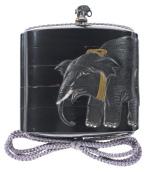
Estimate EUR 6,000
Starting price EUR 3,000
37
29
A FINE AND RARE LACQUER BUNKO (DOCUMENT BOX) WITH INTEGRATED SUZURIBAKO (WRITING BOX)

Japan, 19th century, Edo period (1615-1868)
Published & Exhibited: Cornell University, Herbert F. Johnson Museum of Art, Scattered Gold and Midnight Gloss: Japanese Lacquer from the Anbinder Collection, 31 March – 8 July 2007.

Of rectangular form with recessed rounded corners and edges in gold fundame and a flush-fitting (inrobuta) cover. The exterior bearing a sparse hirame ground finely decorated in gold and colored takamaki-e, hiramaki-e, and togidashi-e with e-nashiji to depict carp swimming in a pond with aquatic plants, two fish depicted emerging from the water in the manner of the Shijo school of painting.
The interior fitted with a tray (kakego) holding an inkstone (suzuri) and a silvered copper waterdropper (suiteki) in the form of a tortoise. The interior of the cover and the kakego each bearing a sparse hirame ground similarly decorated and with inlays of aogai and gold and silver foil to depict goldfish swimming in a stream with omodaka (arrowhead) and giboshi (hosta). The interior of the box of roiro sprinkled with silver and gold lacquer.
SIZE 12.7 x 25.6 x 33.5 cm
With a wood storage box (tomobako).
Condition: Good condition with some wear, the underside with nicks and light scratches, the cover with minor age cracks. The suzuribako tray with a crack.
Provenance: Kyoto Gallery, Arts of Pacific Asia, 24 March 2002, New York. The Paul and Helen Anbinder Collection, acquired from the above. Paul Anbinder (b. 1940) is a retired editor who was a director at important publishers including Random House and Hudson Hills. Helen Anbinder (1942-2022) was an education administrator who ran the Inter-village Continuing Education Program for Ardsley, Dobbs Ferry, Hastings, and Irvington, New York. The couple were avid museumgoers and collectors of art. They donated many books and prints from their collection to their alma mater Cornell University and the Herbert F. Johnson Museum of Art.
Estimate EUR 8,000
Starting price EUR 4,000
Carp by Maruyama Okyo, Shijo school, Ashmolean Museum Ashmolean − Eastern Art Online, Yousef Jameel Centre for Islamic and Asian Art
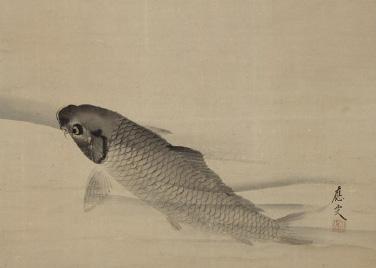
30
Detail image of the interior cover

A LACQUER SUZURIBAKOO DEPICTING BLOSSOMING BELLFLOWERS (KIKYO) AND MAPLE LEAVES


Japan, 19th century
Of rounded rectangular form, with silver rims and an overhanging cover. The exterior with a lustrous roiro ground finely decorated in gold, silver, and red hiramaki-e and subtle gold takamaki-e to depict a gnarled branch bearing leaves, buds, and blossoms of bellflower (kikyo). The interior of the cover with a crimson-red ground richly decorated in gold and colored hiramaki-e with superb inlays of mother-of-pearl and gold foil to depict scattered colorful maple leaves and a swirling stream, the box fitted with two similarly decorated trays, one of which is fitted with a rectangular inkstone (suzuri) and a moon-shaped silver waterdropper (suiteki), further with an incised and inscribed blade and an engraver, both with handles and covers lacquered in roiro with nashiji and decorated in shades of gold hiramaki-e with stylized bellflower blossoms and maple leaves. The base both on the exterior and interior of roiro with sparse nashiji.
SIZE 4.5 x 21.3 x 24.7 cm
Condition: Very good condition with minor wear, the inkstone with a minor chip.
Provenance: Ex-collection Shep Brozman, New York.
The bellflower is called kikyo in Japanese. Traditionally, it is one of the Seven Autumn Flowers. In addition, the ‘Bellflower Seal’ (kikyo mon) is the crest (kamon) of some clans. The maple likewise signifies the arrival of autumn, momiji is the word for the maple leaves tinted of red in the fall, while koyo designates the natural process of the leaves changing colors in autumn.
Estimate EUR 3,000
Starting price EUR 1,500
40 31
32
A RINPA-STYLE INLAID LACQUER SUZURIBAKO WITH BLOSSOMING HORTENSIA
School of Ogata Korin (1658-1716), unsigned Japan, 19th century
Of rounded rectangular form, with a slightly domed overhanging cover. The exterior with a reddish-brown and kinji ground decorated in shades of gold takamaki-e with inlays of mother-ofpearl and pewter to depict a large tub filled to the brim with leafy blossoming hortensia (ajisaizoku). The interior of the cover bearing a lustrous roiro ground similarly decorated and with gold and silver hiramaki-e to depict iris (shobu) and grasses along the bank of a meandering swirling river. The interior of the box with a reddishbrown ground similarly decorated and fitted with a rectangular inkstone (suzuri) and rectangular brass waterdropper (suiteki) neatly incised with an iris design.

SIZE 5.5 x 22.6 x 24 cm
Condition: Very good condition with minor wear and few minor losses and a repair to inlays.
With a wood tomobako storage box.
Ogata Korin (1658-1716) was a famous and highly influential Japanese landscape illustrator, lacquerer, painter, and textile designer of the Rinpa School. Korin is best known for his byobu folding screens, such as Irises and Red and White Plum Blossoms (both registered National Treasures), and his paintings on ceramics and lacquerware produced by his brother Kenzan (1663-1743). Also a prolific designer, he worked with a variety of decorative and practical objects, such as round fans, makie writing boxes, or inro
medicine cases. He is also credited with reviving and consolidating the Rinpa school of Japanese painting, fifty years after its foundation by Hon’ami Koetsu (1558-1637) and Tawaraya Sotatsu (c. 1570-c. 1640). In fact the term ‘Rinpa’, coined in the Meiji period, means ‘school of [Ko]rin’. In particular he had a lasting influence on Sakai Hoitsu (1761-1828), who replicated many of his paintings and popularized his work, organizing the first exhibition of Korin’s paintings at the hundredth anniversary of his death.
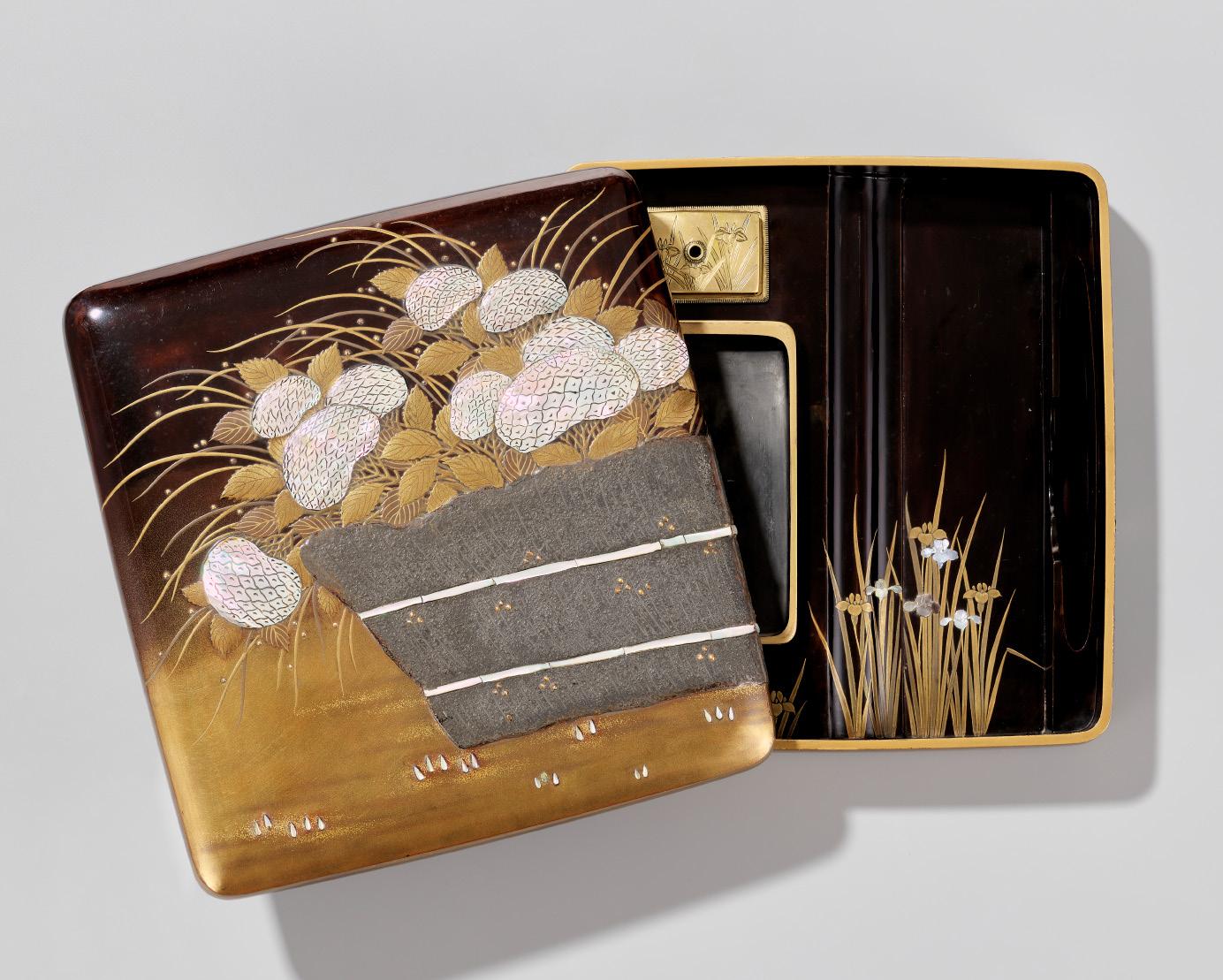
AUCTION COMPARISON
Compare a related Rinpa-style lacquer suzuribako, signed Hokkyo Korin, dated late 19th century, Meiji period, at Christie’s, 1 October 2020, New York, lot 9 (sold for 23,750 USD).

Estimate EUR 5,000
Starting price EUR 2,400
KAJIKAWA: A FINE LACQUER SUZURIBAKO (WRITING BOX) DEPICTING BOYS AT PLAY

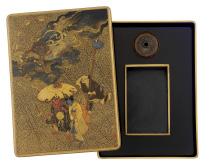


By a member of the Kajikawa family, signed Kajikawa saku and with pot seal Ei Japan, Edo (Tokyo), 19th century, Edo period (1615-1868)
Of rectangular form with a flush-fitting (inrobuta) cover and silver rims. The exterior with a gyobu nashiji ground, the cover with a shaped panel bearing a mirror-black ground, finely decorated in colored takamaki-e and hiramaki-e with three karako, two of which are mischievously drawing with brushes on their sleeping companion, an inkstone and lesson book on the ground beside them.
The interior of the cover with a rich gold hirame ground similarly decorated with five boys wearing elaborate patterned robes, one riding a hobby horse, three playing musical instruments, and one standing behind a tsuitate (standing screen) depicting a misty mountain landscape superbly rendered in sumi-e togidashi-e and bearing the signature and seal of the Kano painter Isen’in (Naganobu, 1775-1828).

The interior bearing a nashiji ground and fitted with a nine-section board (ita) with two raised sections above and below the inkstone (suzuri), the upper section cut with a recess for the lozenge-shaped gilt-copper and silver waterdropper (suiteki), signed underneath the inkstone KAJIKAWA saku [made by Kajikawa] with a red ‘tsubo’ seal Ei.
SIZE 4.6 x 21 x 23 cm
Condition: Very good condition with minor wear and few small losses to lacquer.
Provenance: Christie’s, 18 September 2013, New York, lot 680. The Paul and Helen Anbinder Collection, acquired from the above. Paul Anbinder (b. 1940) is a retired editor who was a director at important publishers including Random House and Hudson Hills. Helen Anbinder (1942-2022) was an education administrator who ran the Inter-village Continuing Education Program for Ardsley, Dobbs Ferry, Hastings, and Irvington, New York. The couple were avid museumgoers and collectors of art. They donated many books and prints from their collection to their alma mater Cornell University and the Herbert F. Johnson Museum of Art.
With a wood storage box (tomobako).
The Kajikawa family were Japanese lacquerware artists whose school in Edo flourished for more than 200 years. Kyujiro is generally acknowledged as the founder of the family and the inaugurator of its traditions. He excelled in designing particularly delicate lacquer inro. Kajikawa artists also designed lacquer netsuke. Suzuribako by this school are considerably rarer than inro and netsuke.
MUSEUM COMPARISON
Compare a lacquer suzuribako, also signed Kajikawa saku and with a red seal, in the collection of the Freer Gallery of Art in the National Museum of Asian Art, Smithsonian Institution, accession number F1955.24a-e.
AUCTION COMPARISON
Compare a lacquer suzuribako, also signed Kajikawa saku and with a red pot seal, at Christie’s, 1 October 2020, New York, lot 21 (sold for 18,750 USD).
Estimate EUR 6,000
Starting price EUR 3,000
42 33
Landscape by Kano Isen’in Naganobu similar to the one depicted on the screen on the inside cover

A LACQUER SUZURIBAKO DEPICTING AN OX-HERDER PLAYING THE FLUTE

Japan, 19th century, Edo period (1615-1868)
Of rounded rectangular form with a flush-fitting cover, the exterior bearing a nashiji ground finely decorated in gold, silver, and black hiramaki-e and takamaki-e with kirikane to depict an ox-herder riding a black ox, playing a transverse flute, wearing voluminous robes, a small sickle attached to the belt, all below thick clouds and above craggy rockwork and grasses. The interior bearing a roiromura-nashiji ground, the interior of the cover similarly lacquered with three horses grazing and strolling below a gold-foil full moon partly obscured by thick clouds, the baseboard decorated with grasses, rocks, and bamboo and fitted with a rectangular inkstone (suzuri) and copper waterdropper (suiteki) of circular form.
Condition: Good condition with minor wear, the cover with expected age cracks, some possibly with minor old repairs.

Ten Bulls or Ten Ox Herding Pictures is a series of short poems and accompanying drawings used in the Zen tradition to describe the stages of a practitioner’s progress toward enlightenment, and their return to society to enact wisdom and compassion. The best known version of the oxherding pictures was drawn by the 12th century Chinese Rinzai Chán (Zen) master Kuoan Shiyuan, who also wrote accompanying poems and introductory words attached to the pictures. The present writing box depicts the sixth poem, ‘Riding the Bull Home’:
Mounting the Ox, slowly Measuring with hand-beats I return homeward. the pulsating harmony, The voice of my flute intones I direct the endless rhythm. through the evening. Whoever hears this melody will join me.
MUSEUM COMPARISON
Compare a related lacquer suzuribako depicting the same subject, dated 19th century, Edo period, in the Metropolitan Museum of Art, accession number 38.25.106a–d.

Estimate EUR 2,000
Starting price EUR 1,000
34
23.8 cm
SIZE 4.5 x 21 x
A LACQUER MINIATURE SUZURIBAKO DEPICTING
THE UJI BRIDGE
Japan, 19th century

Of rounded rectangular form with a flush-fitting cover, the exterior bearing a roiro ground richly decorated in gold and silver hiramaki-e and takamaki-e with kirikane to depict the Uji bridge over gushing waves with rockwork, willows, and thick clouds. The interior of rich nashiji with gold fundame edges, the baseboard fitted with a rectangular inkstone (suzuri) and silver waterdropper (suiteki) of circular form with raised chrysanthemum decoration. The underside of rich nashiji.
SIZE 2.3 x 10.7 x 11 cm
Condition: Very good condition with minor surface wear and few microscopic age cracks.
The bridge by the Uji River, in southeast Kyoto, is a view long celebrated in literary works such as The Tale of Genji. Uji serves as the setting for the last ten chapters of The Tale of Genji, ending with ‘The Bridge of Dreams.’ Paintings of the Uji Bridge decorated palaces by the 900s and remained popular for the next thousand years.
Estimate EUR 2,000
Starting price EUR 1,000
45 35
A GOLD LACQUER SUZURIBAKO DEPICTING THE BATTLE OF KAWANAKAJIMA
Japan, Meiji period (1868-1912) to Taisho period (1912-1926)
Of rectangular form, with a flush-fitting cover. The exterior bearing a kinji ground richly decorated in gold and colored hiramaki-e and takamaki-e with e-nashiji, mura-nashiji, gyobu nashiji, and kirikane to depict a fierce battle between a horse-mounted samurai on a surprise attack on an encampment, raising his katana high above his head as he is about to strike a standing warrior wearing a kabuto with an oni maedate, only able to defend himself with a fan for the moment but about to draw his own sword, while a soldier defends his master with a long yari (spear), all amid a meandering stream framed by grasses, rocks, and bamboo leaves below thick swirling clouds, continuing over to the long sides, the short sides and base of nashiji.

The interior of rich nashiji, the cover similarly decorated and with inlays of mother-of-pearl and gold foil to depict a river amid rolling hills, reeds, bamboo, and rockwork, the nine-section ita (baseboard) fitted with a rectangular inkstone (suzuri) and fan-shaped copper waterdropper (suiteki).
SIZE 5.2 x 23.1 x 26.1 cm
Condition: Excellent condition with minor wear.
With the original lacquered wood transport box with a goldlacquered inscription 川中島合戦図蒔絵御硯箱 “Kawanakajimagassen zu makie on-suzuribako” [Lacquer suzuribako, with the design of the Battles of Kawanakajima].
The Battles of Kawanakajima (Kawanakajima no tatakai) were a series of battles fought in the Sengoku period of Japan between Takeda Shingen of Kai Province and Uesugi Kenshin of Echigo Province from 1553 to 1564. Shingen and Kenshin contested each other for control of the plain of Kawanakajima between the Sai River and Chikuma River in northern Shinano Province, located in the present-day city of Nagano. The battles were triggered after Shingen conquered Shinano, expelling Ogasawara Nagatoki and Murakami Yoshikiyo, who subsequently turned to Kenshin for help. Five major battles of Kawanakajima occurred: Fuse in 1553, Saigawa in 1555, Uenohara in 1557, Hachimanbara in 1561, and Shiozaki in 1564. The most famous and severe battle was fought on 18 October 1561 in the heart of the Kawanakajima plain, thus being known as the Battle of Kawanakajima. The battles were ultimately inconclusive and neither Shingen or Kenshin established their control over the plain of Kawanakajima. The Battles of Kawanakajima became one of the most cherished tales in Japanese military history, the epitome of Japanese chivalry and romance, mentioned in epic literature, woodblock printing, and later in movies. They were a popular subject for woodblock prints in the Edo period, in part because both the Takeda and Uesugi clans had died out and glorification of their deeds did not therefore pose any threat to the ruling Tokugawa shogunate.


Estimate EUR 8,000
Starting price EUR 4,000
36
A triptych by Utagawa Hiroshige depicting the Battle of Kawanakajima, 1845; the central print depicting Takeda Shingen on the left and Uesugi Kenshin on the right

FUNABASHI SHUMIN: AN IMPERIAL PRESENTATION LACQUER SUZURIBAKO
By Funabashi Shumin (1859-after 1914), signed to the wood box
Maki-e Funabashi Shumin
Japan, Meiji period (1868-1912)
Of rectangular form with rounded corners, an overhanging cover, and silver rims. The exterior bearing a kinji ground superbly decorated in shades of gold and silver hiramaki-e, takamaki-e, and togidashi-e with hirame and e-nashiji to depict a wagtail perched on a craggy rock by a meandering stream below cedars and pines in a misty mountain landscape.
The interior bearing a rich nashiji ground, the cover with a large 16-petal chrysanthemum mon in gold takamaki-e, the box fitted with a nine-section ita (board) with gold fundame edges, the inkstone (suzuri) similarly lacquered, the silver waterdropper (suiteki) of circular form and finely chased and incised with scrolling foliage against a ring-punched ground, the pair of writing brushes, paper pricker, paper knife, and inkstick holder similarly lacquered and with matching silver fittings.
SIZE 5.2 x 22.2 x 26 cm
Condition: Excellent condition with minor wear.
With a lacquered wood storage box (tomobako) decorated with a 16-petal chrysanthemum in gold hiramaki-e and inscribed on the interior Maki-e FUNABASHI SHUMIN (‘lacquer by Funabashi Shumin’).
Funabashi Shumin (1859-after 1914) was a pupil of Uematsu Homin. He exhibited at domestic and foreign expositions and worked for the Imperial Family. He won many prizes including at the Fifth National Industrial Exhibition in 1903 and the St. Louis Exposition in 1904. He won a silver medal at the Louisiana Purchase Exhibition in 1904. The last recorded data about the artist is a bronze medal he won at an exhibition in Tokyo in 1914.
The 16-petal kiku mon indicates the present piece was an Imperial commission.
Literature comparison: For a related suzuribako with summer trees by Funabashi Shumin in the Baur Collection, see Dees, Jan (1983) L’art japonais du lacque de 1900 a 1940 dans les collections Baur, Collections Baur 59, MOA Museum of Art, Kindai Nihon no shikkogei (Japanese lacquer of recent times), p. 106, no. 58/1. For an Imperial presentation box (tebako) by Funabashi Shumin see Wrangham, Edward et. al. (1995) Meiji no Takara: Treasures of Imperial Japan - The Nasser D. Khalili Collection, The Kibo Foundation, vol. 2, no. 230, and Dees, Jan (1997) Japanese Imperial Presentation Boxes 1900-1930, Oriental Art, Vol. 43, No. 1, fig. 5, p. 4.
MUSEUM COMPARISON
Compare a document box by Funabashi Shumin in the Rijksmuseum, Amsterdam, object number AK-MAK-391.


AUCTION COMPARISON
Compare a closely related lacquer suzuribako by Funabashi Shumin, also dated to the Meiji period, at Bonhams, 6 November 2012, London, lot 401 (sold for 32,450 GBP). This suzuribako is currently in the collection of the Rijksmuseum, Amsterdam, on loan from Jan Dees & René van der Star, object number AK-C-2016-1.

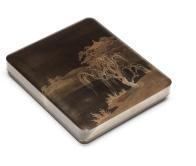
Estimate EUR 10,000
Starting price EUR 5,000
37

SUZUKI KONYU II: A LACQUER SUZURIBAKO DEPICTING A GIBBON REACHING FOR THE REFLECTION OF THE MOON

The present suzuribako refers to a Buddhist story in which a monkey attempts to seize the reflection of a moon in a well; it fails when the branch from which it is hanging breaks. The monkey stands for unenlightened people who cannot distinguish between reality and illusion.
 By Suzuki Konyu II
By Suzuki Konyu II
(b. 1945), signed to the tomobako Konyu with seal Suzuki Japan, Kyoto, second half of 20th century, Showa period (1926-1989)
Of rectangular form with an overhanging cover and silver rims. The exterior bearing a roiro ground, exquisitely decorated to the top of the cover in shades of gold takamaki-e and hiramaki-e with mura-nashiji, e-nashiji, and kirikane to depict a gibbon hanging from a gnarled pine branch growing from a craggy cliff above sinuous waves and a cluster of pine leaves. The ape is reaching to grab the reflection of the moon, subtly lacquered in silver togidashi-e. The interior bearing a roiro ground and fitted with a rectangular inkstone (suzuri) and a metal waterdropper (suiteki) of circular form, further with two writing brushes and an inscribed ink cake.
SIZE 3.1 x 15.2 x 16.8 cm
Condition: Excellent condition with minor wear.
With a wood storage box (tomobako) inscribed to the top of the cover Enko mizu wo sukuu makie, suzuribako (‘Suzuribako box in makie lacquer, with the design of a gibbon scooping water’) and signed to the back of the cover KONYU with seal SUZUKI.
Estimate EUR 2,500
Starting price EUR 1,200
50 38
39 A LACQUER SUZURIBAKO (WRITING BOX) DEPICTING A HERON


Japan, late 19th to early 20th century, Meiji (1868-1912) to Taisho period (1912-1926)
Of circular form, the rims of silver, the exterior bearing a lustrous roiro ground, the flush-fitting cover finely decorated in gold takamaki-e with a flying heron, its wings spread out, the tail feathers subtly rendered in gold and silver togidashi-e. The interior of the cover bearing a densely sprinkled ground similarly decorated and with kirikane to depict a river with wooden planks and bamboo, continued on the similarly lacquered interior of the box with a central raised section fitted with an oval inkstone (suzuri) and silver waterdropper in the form of a crescent moon, the form of the writing box evoking a full moon.
DIAMETER 24.6 cm
Condition: Very good condition with minor wear and light surface scratches.
With an inscribed wood storage box (tomobako).
The design of the present suzuribako was clearly inspired by the work of Ogata Korin (1658-1716) of the Rinpa school, which is particularly evident in the reeds on the interior of the cover.
MUSEUM COMPARISON
Compare a circular suzuribako with design of a deer, attributed to Hon’ami Koetsu (15581637) and dated to the early 17th century, in the Philadelphia Museum of Art, accession number 1992-7-1a--d.

AUCTION COMPARISON
Compare a related circular suzuribako, also dated Meiji to Taisho period, at Bonhams, Property from the Collection of Drs. Edmund and Julie Lewis, Part I, 11 September 2019, New York, lot 588 (sold for 13,200 USD).

Estimate EUR 4,000
Starting price EUR 2,000
51

Buddhist Art
Lots 40 to 68

A RARE AND EARLY BRONZE FIGURE OF BUDDHA, KAMAKURA TO EARLY MUROMACHI
Japan, 14th-15th century, late Kamakura (1185-1333) or early Muromachi period (1336-1573)
Finely cast seated in dhyanasana, his left hand raised in a rare mudra with the ring finger bent and the others extended, his right hand resting on his knee. He is wearing loose-fitting robes opening at the chest. His serene face with heavy-lidded eyes below arched brows as well as full lips flanked by long pendulous earlobes. His hair arranged in deeply incised wavy locks over the high ushnisha.
HEIGHT 8.6 cm
WEIGHT 185 g
Condition: Very good condition
Provenance: The private collection of Michael Phillips (born 1943), who is an Academy Award-winning film producer. Born in Brooklyn, New York, his parents were Lawrence and Shirley Phillips, noted New York dealers in Asian fine arts, selling to the Met, the LACMA, the Chicago Art Institute, and the British Museum among others. Michael Phillips is a collector of Asian art himself, particularly Indian, Southeast Asian, and Himalayan sculpture. His most important films include The Sting (winning the Academy Award for Best Picture in 1973), Taxi Driver (winning the Palme d’Or at the 1976 Cannes Film Festival), and Steven Spielberg’s Close Encounters of the Third Kind.

MUSEUM COMPARISON
Compare a related standing bronze figure of Amida Nyorai in the collection of The Metropolitan Museum of Art (The MET), New York, accession no. 23-1011-016.

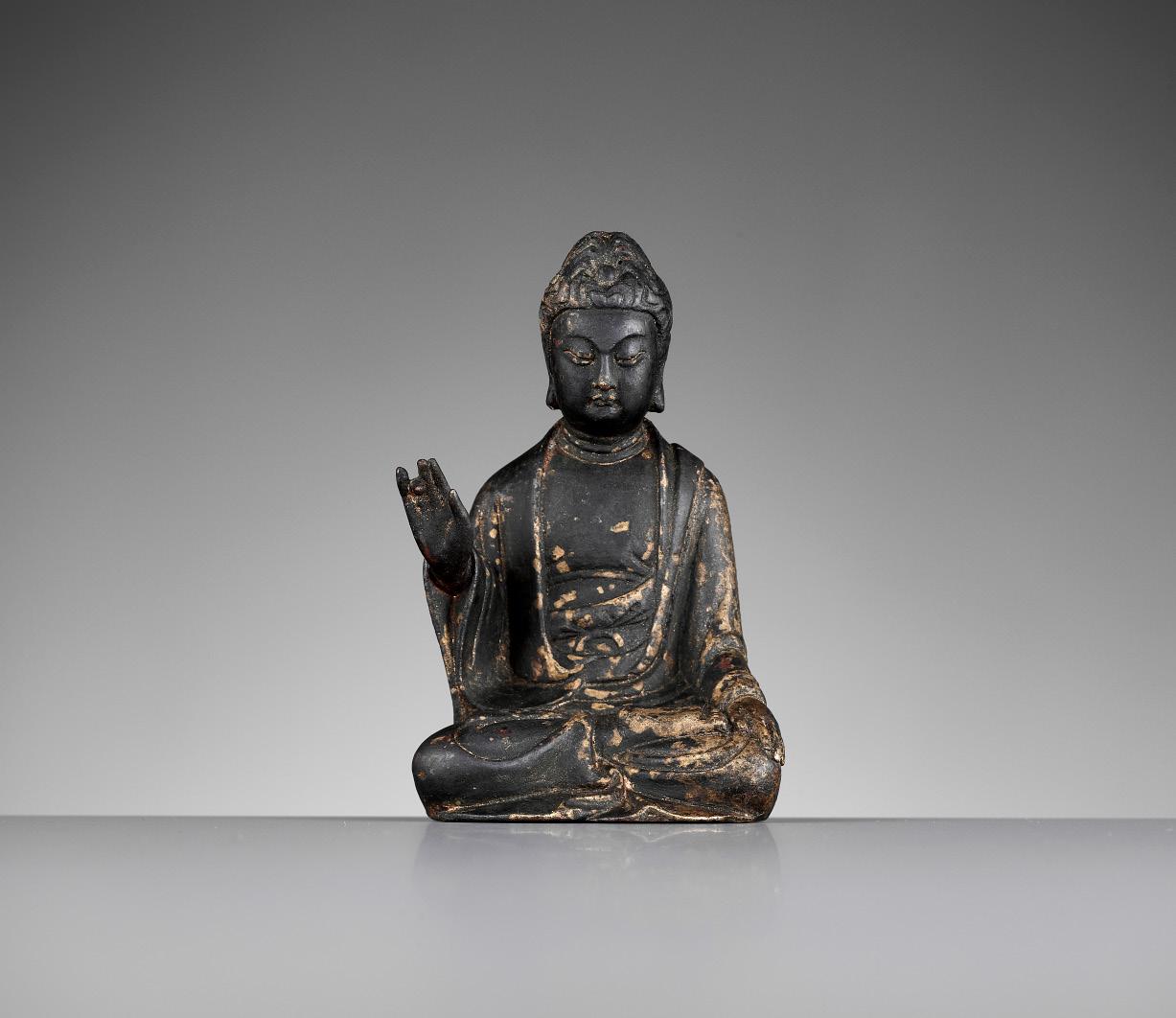
Estimate EUR 4,000
Starting price EUR 2,000
54 40
Michael Phillips at the 46th Academy Awards in 1974 after winning the Best Picture Oscar for the Sting
A BRONZE FIGURE OF AMIDA NYORAI, HEIAN TO EARLY KAMAKURA

Japan, Heian period (794-1185) to early Kamakura period (1185-1333)
Finely cast standing on a waisted lotus base with incised overlapping petals above a large leaf with raised veins. Amida is wearing loose-fitting monastic robes opening at the chest and cascading in voluminous folds. His hands are held in raigo-in (vitarka mudra). His serene face with heavy-lidded eyes below gently arched brows centered by a raised circular byakugo (urna). The hair arranged in tight curls over the domed ushnisha. The back with a small, looped tang above a large aperture showing the hollow interior. The sides of the figure are incised with a lengthy votive inscription. The copper-brown bronze with a rich, naturally grown, dark patina.
HEIGHT 25 cm
WEIGHT 675 g
Condition: Good condition with some wear, minor casting flaws including casting grit, minor losses, small dents, tiny nicks, light surface scratches.
The sculpture represents Amitabha, known in Japanese as Amida Nyorai, or the Buddha of Limitless Light. Amitabha reigns over the Western Pure Land, a paradise to which anyone is welcomed if they faithfully and sincerely incant his name. This place of salvation became central to the Jodo [lit. Pure Land] sect of Buddhism. Propounded in 1175 by the monk Honen, the accessibility of such tenets of redemption allowed this form of Buddhism to proliferate across the nation and feudal classes of Japan.
AUCTION COMPARISON
Compare a related bronze figure of Amida, measuring 36.5 cm, at Bonhams, Fine Japanese and Korean Art, 14 September 2016, New York, lot 149 (sold for 26,250 USD).

Estimate EUR 4,000
Starting price EUR 2,000
41

42 YASUCHIKA: A SUPERB AND VERY RARE SILVER FIGURE OF KANNON BOSATSU, DATED 1738
By
Tsuchiya
Yasuchika (1670-1744), signed Yasuchika with kakihan Japan, dated 1738, Edo period (1615-1868)
The bodhisattva of compassion finely cast standing and holding in her left hand a lotus bud borne on a gently curved stem, the right hand raised in semui-in (abhaya mudra), the gesture of fearlessness. She is wearing a loose-fitting robe opening at the chest and cascading in voluminous folds, flanked by billowing scarves hanging from each arm. Her serene face with heavy-lidded eyes below gently arched brows, fer full lips forming a calm smile, the hair piled up into a high chignon secured by a plain headdress and surmounted by a jewel.
HEIGHT 9.4 cm (the figure, excl. stand) and 11.6 cm (the mandorla, excl. stand)
WEIGHT (excluding base) 208 g
Condition: Very good condition with minor wear, minimal casting irregularities, and few tiny nicks.
Provenance: Spink & Son Ltd, London, 1977. European collection, acquired from the above.
The separately cast figure and mandorla fitted into an associated wood stand.
Published & Exhibited: Spink & Son Ltd, Japanese Works of Art, 10-17 June 1977, London, no. 58.
The present figure is an extremely rare work by either Tsuchiya Yasuchika I (1670-1744) or Yasuchika II (1695-1747) who were retainers of Daizen, Matsudaira Daimyo of Shonai. The inscription to the back of the mandorla dates the present piece to Genbun 3rd year, a good day in the seventh month (1738) and is dedicated to Ganshu Matsudaira Izumonskami of Izumo Province.
AUCTION COMPARISON
Compare a related, yet significantly later (Meiji period), silver figure of Kannon, at Bonhams, Japanese Works of Art, 19 March 2009, New York, lot 395 (sold for 14,640 USD).



Estimate EUR 6,000
Starting price EUR 3,000
57

AN EXTREMELY RARE AND IMPRESSIVE WOOD FIGURE OF THE ASCETIC SHAKYAMUNI BUDDHA, KAMAKURA PERIOD

Japan, early 14th century, Kamakura period (1185-1333)
Exceptionally well carved, seated in a relaxed pose imbued with movement, the Buddha one with his grotto-like environment, his movements echoed by his naturalistic throne, with which he almost appears to merge.
The exquisitely serene face is finely carved with heavy-lidded eyes, gently arched brows, a glass-inlaid byakugo (urna), pronounced cheekbones, full lips, and long pendulous earlobes. His features subtly indicate his ascetic character, which is further suggested by the treatment of his slightly emaciated torso, partly obscured by the loose-fitting robe cascading in voluminous folds. His hair is arranged in tight curls over the high, domed ushnisha.
HEIGHT 32.4 cm (excl. stand) and 39.2 cm (incl. stand)
Condition: Superb condition, the wood with natural imperfections including signs of insect activity, at least some of which is inherent to the carving and only adding to the exceptional and breathtaking appearance of the figure. Wear, minor losses, light surface scratches, all as expected.
Provenance: Ex Paris Ancienne Collection

Vignier, acquired during the 1930s. Jacques Barrère, Paris, February 2005. Liliane and Michel Durand-Dessert, Paris, acquired from the above. A signed expertise from Jacques Barrère, dated 14 February 2005, confirming the dating and provenance above, accompanies this lot. Jacques Barrère took over his mother’s flea market business, specializing in Far Eastern porcelain, cloisonné, and sculpture, in 1969. In the same year, he opened his gallery in SaintGermain-des-Prés. The current Jacques Barrère gallery has been located on Rue Mazarine for over three decades and specializes in Chinese sculpture, archaeology, ceramics, and decorative arts, as well as Japanese sculpture and porcelain. In 2008, Jacques’ son Antoine Barrère has been running the gallery, bringing a fresh vision in a globalized art market. Objects once owned by Jacques Barrère have been included in major museums around the world, including the Musée Guimet and the Musée Cernuschi, the Shanghai Museum, and the Miho Museum. Liliane and Michel Durand-Dessert were luminous gallery owners who worked in Paris from 1975 to 2004, and were both informed and avant-garde collectors. They are significant not only because of the analytical and original approach the couple applied in each acquisition, but also because of their visionary take on exhibiting the most radical 20th-century art in their gallery, which was the subject of a 2004 retrospective organized by the Museum of Grenoble. According to Michel Durand-Dessert, who was inspired to open the couple’s first gallery by a visit to Documenta in 1968, “it is certain that a collection is a portrait, and that the objects we buy are those in which we sometimes recognize ourselves, sometimes we project ourselves. One way or another, acquiring them means adopting them, in every sense of the word.”
Mounted on an old wood stand.
The present sculpture vividly portrays Siddharta Gautama after renouncing his princely life, practicing extreme asceticism in the wilderness during his search for enlightenment. At the age of 29, Siddhartha left the comforts of his palace to seek answers and spiritual solace. He cut his hair and removed his jewelry. He tried fasting to test his dedication, but the hunger distracted
him from meditation. During this time, he realized that such self-punishment was ultimately futile, and he eventually attained enlightenment through meditation and the Middle Path of balance and moderation. Images of the fasting Siddhartha promote this philosophy of moderation.
Depictions of the Buddha as an emaciated ascetic appeared in the ancient kingdom of Gandhara, and later also in Chinese art. It was in the Yuan dynasty that the modelling of Buddha in this manner became popular and a convention in Chinese art. However, according to Sherman Lee and Wai-kam Ho in Chinese Art Under the Mongols: The Yuan Dynasty (1279-1368), 1968, p. 124, “the prototype could be traced back at least to Kuan-hsiu’s Sixteen Arhats of the Five Dynasties period, or Buddhist paintings of the ninth and tenth centuries showing hermits and the familiar figure of Vasu in Tun-huang and Central Asia.”
MUSEUM COMPARISON
Compare a related lacquered wood figure of the ascetic Shakyamuni, dated 17th-18th century, Edo period, 21.6 cm high, accession number 88.145a-b.
AUCTION COMPARISON
Compare a Chinese bronze figure of the ascetic Buddha, dated Yuan to Ming dynasty, 17.2 cm high, at Sotheby’s, 20 September 2022, New York, lot 130 (sold for 50,400 USD). Compare also a related wood sculpture of a seated Buddha, dated 12th century, 31.6 cm high, at Bonhams, 16 September 2009, New York, lot 3073.



Estimate EUR 20,000

Starting price EUR 10,000

59 43
Jacques & Antoine Barrère in the 1990’s
Liliane and Michel DurandDessert

A VERY LARGE AND RARE LACQUERED WOOD FIGURE OF HOKAN SHAKA NYORAI, MUROMACHI PERIOD
Japan, 14th-16th century, Muromachi period (1333-1573)
Finely carved and assembled in yosegi-zukuri technique, painted in gofun, polychrome pigments, lacquer and gold leaf. The robe is decorated in relief with flowers and scrolls in a technique called domon 土紋, a decoration made from clay and fixed with lacquer. The hairstyle is topped with a high bun called hokei and girded with a thin tiara, the tenkandai. Two holes in the tenkaidai show that originally a golden copper crown, hokan, was attached to the head.
Hokan Shaka Nyorai (the historical crowned Buddha) is shown seated in dhyanasana atop a tall lotus throne with individually carved petals, the hands lowered in zenjoin (dhyana mudra). The serene face with heavy-lidded eyes below gently arched brows centered by a rock crystal byakugo (urna).
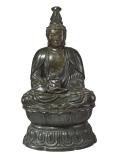
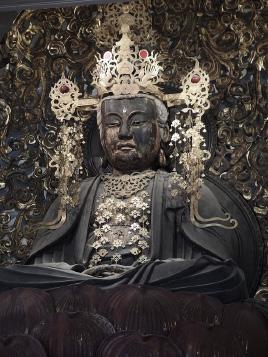


The base consists of three tiers: - a round gilded base decorated with stylized upside-down lotus petals; - above it, a thin open lotus flower on which rests a carved and open-worked element decorated with lotus flowers and scrolls; - then, a large lotiform base whose petals are realistically carved. Each of the petals is
covered with an ornament painted in polychrome and in relief according to the domon technique representing the three sacred jewels on a lotus (Sanbo no shinboru - 三宝のシンボル) symbolizing the Buddha: the enlightened one who has attained Nirvana, the Dharma: the Buddha’s teaching, and the Shanga: the Buddhist monastic order.
HEIGHT 74 cm (the figure) and 112 cm (total)
Condition: Good condition, commensurate with age. Extensive wear, age cracks, chips, losses, flaking, repairs and touchups, nicks, scratches. The mandorla and crown are lost.
Provenance: From a private collection in Paris, France.
MUSEUM COMPARISON
Compare the related figure of Amida Nyorai with jeweled crown, dated 13th century, in the Zaika-ji Temple in Toyokawa, Aichi, exhibited in New Life for Timeless Art, Tokyo National Museum, 1 October – 1 December 2019. Compare the related figure of Hokan Shaka Nyorai dated 1352 in the Hoko-ji Temple in Shizuoka (an Important Cultural Property), exhibited in The Art of Zen. From Mind to Form, Tokyo National Museum, 18 October – 27 November 2016. Also compare a related bronze figure of Maitreya, dated 1713 by inscription, 110 cm high, in the National Palace Museum, Taipei, illustrated in Yu-min, Lee / Tyuyin, Chung (2015) Imprints of Buddhas: Buddhist Art in the National Palace Museum Collection, p. 214, no. 86.

Estimate EUR 25,000
Starting price EUR 12,000
61
44
Hokan Shaka Nyorai, late kamakura period (1185-1333)

A
GILT AND LACQUERED WOOD
FIGURE OF KANNON BOSATSU HOLDING LOTUS BLOSSOMS
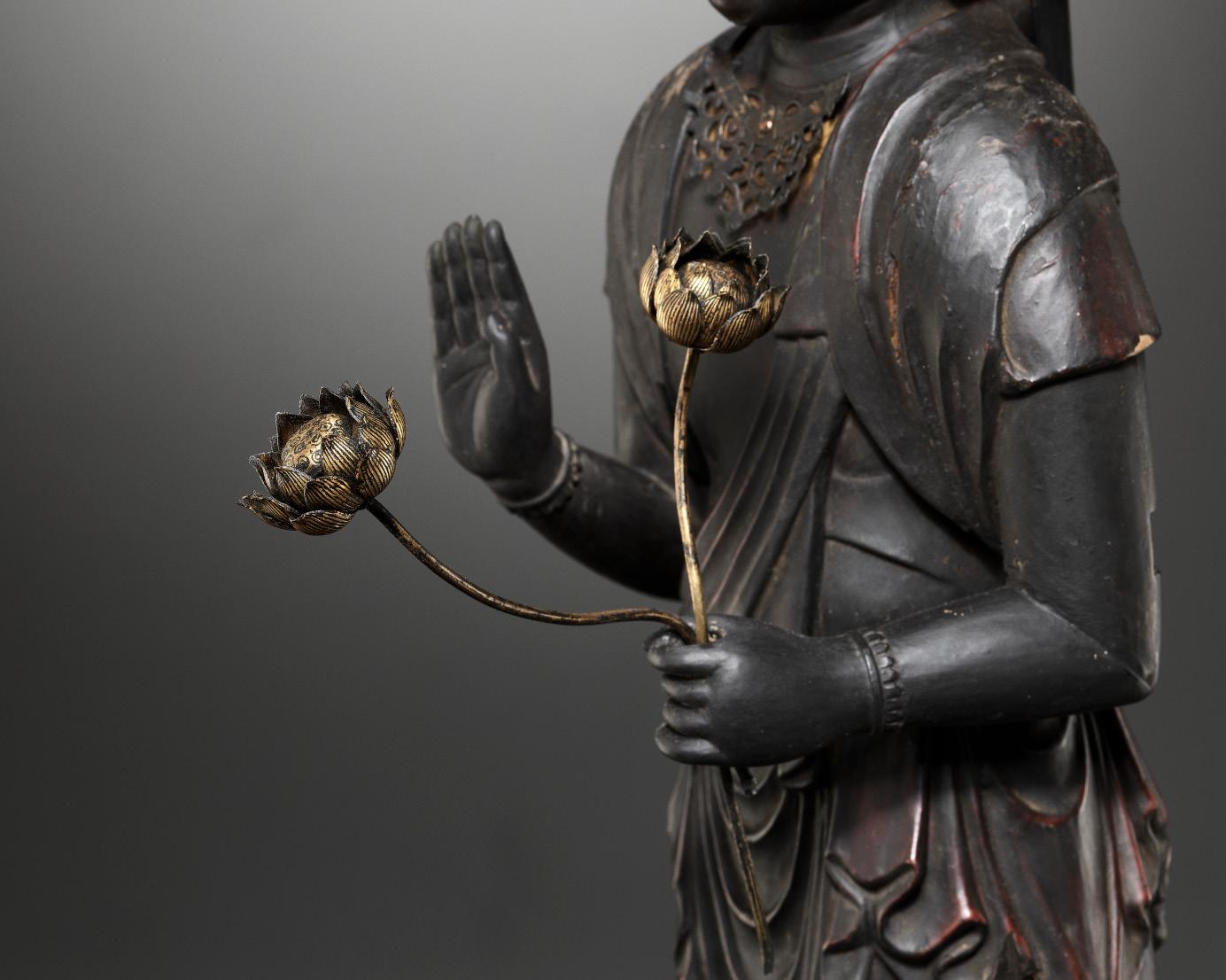
Japan, c. 1600, late Momoyama (1573-1600) to early Edo period (1615-1868)
Carved from cypress wood and assembled in yosegi-zukuri technique, the bodhisattva standing on a lotus dais supported on an elaborate tiered hexagonal pedestal carved with foliate, diapered, prunus, and cloud designs. The bodhisattva is wearing long flowing robes draped over both shoulders and with deeply carved folds. The right hand is held in semui-in (abhaya mudra) while the left holds two gilt-metal lotus blossoms borne on long stems. The serene face with heavy-lidded eyes below gently arched brows, centered by a glass or rock crystal byakugo (urna), further with full lips forming a subtle smile, flanked by long pierced pendulous earlobes. The hair piled in a topknot and adorned with a hokan (jeweled crown) and munakazari (ornamental necklace). The base inset with a flattened post surmounted by a circular halo.
HEIGHT 89 cm
Condition: Good condition with some wear, minor age cracks, small losses, minor flaking to lacquer, small chips. Rich, dark patina.
Provenance: Kyoto Gallery, Brussels, 21 March 2009. Liliane and Michel DurandDessert, Paris, acquired from the above. Liliane and Michel Durand-Dessert were luminous gallery owners who worked in Paris from 1975 to 2004, and were both informed and avant-garde collectors. They are significant not only because of the analytical and original approach the couple applied
in each acquisition, but also because of their visionary take on exhibiting the most radical 20th-century art in their gallery, which was the subject of a 2004 retrospective organized by the Museum of Grenoble. According to Michel Durand-Dessert, who was inspired to open the couple’s first gallery by a visit to Documenta in 1968, “it is certain that a collection is a portrait, and that the objects we buy are those in which we sometimes recognize ourselves, sometimes we project ourselves. One way or another, acquiring them means adopting them, in every sense of the word.” An expertise from Kyoto Gallery, dated 21 March 2009, written and signed by Tony Cammaert, confirming the dating above, and stating a value for the present lot of 10,500 EUR, accompanies this lot.

Yosegi-zukuri, or joined wood-block construction, is a sculpting method in which several rectangular blocks of wood are individually selected and carved into shapes. Yosegi-zukuri, together with ichiboku-zukuri (single block construction), are the two main techniques associated with wood sculpture in Japan. There were several advantages of a sculpture made from multiple blocks of wood. It was much lighter than one carved out of a single block of wood. The technique also helped to minimize the cracking of the wood caused by the outside layer drying faster than the core of the sculpture.
AUCTION COMPARISON
Compare a related wood figure of Kannon, dated to the Nanbokucho period, 14th century (with an amendment stating that the dating “could be as late as early Muromachi period (15th century)”, at Bonhams, 18 March 2015, New York, lot 3107 (sold for 27,500 USD).

Estimate EUR 12,000
Starting price EUR 6,000
63 45
Liliane and Michel Durand-Dessert
A PAIR OF WOOD KOMAINU (KOREAN GUARDIAN DOGS), MUROMACHI PERIOD


Japan, 15th-16th century, Muromachi period (1333-1573)
Each finely carved from cypress wood of an attractive grain and color, seated on its haunches, the flaming tail rising upwards, the head with fierce expression, large painted eyes behind glass, and scrolling mane. One lion with a horn and closed mouth, uttering the syllable ‘um’, the other without the horn and with the mouth open, uttering the syllable ‘ah’.

HEIGHT 83 cm and 74 cm
Condition: Good condition, commensurate with age. Extensive wear, flaking and losses to gesso and pigment, expected age cracks, minor chips, small losses.
Male and female pairs of shishi guard the approaches to the holy enclosures of Shinto shrines. They are usually known as komainu (literally ‘dogs of Koma’ – Koma meaning Kokuryo, one of the three countries of ancient Korea). The lion not being indigenous to Asia, the concept of the shishi was probably originally introduced to Japan through China and Korea via India from the Middle East. They are found in Shinto shrines from the late Heian period onwards standing to the left and right of a pathway or entrance. That on the right has an open mouth, and that on the left has a closed mouth said to signify the universal sounds ‘ah’ and ‘um’ – the beginning and the end. Sometimes early examples have a single horn as with this pair.
MUSEUM COMPARISON
Compare a related pair of komainu, dated c. 1450, each 39.4 cm high, in the Indianapolis Museum of Art, accession number 2006.71.1-.2.
AUCTION COMPARISON
Compare a related pair of carved and painted wood komainu, dated 14th-15th century, Nambokucho to Muromachi period, at Christie’s, 15 October 2014, London, lot 5 (sold for 30,000 GBP).
Estimate EUR 20,000
Starting price EUR 10,000
46


AN EXCEPTIONAL PAIR OF MONUMENTAL WOOD FIGURES OF NIO GUARDIANS




Japan, Edo period (1615-1868)
Each finely carved and decorated with gesso and pigment to depict a Nio guardian, Agyo with the mouth open, holding a tama (sacred jewel) in his lowered right hand, his left hand extended with the palm facing forward, in a protective gesture akin to the abhaya mudra, Ungyo with the mouth closed, his right hand extended with the thumb and index finger joined similar to vitarka mudra. Both are wearing flowing skirts with deeply carved folds, gathered at the waist revealing their strong muscular bodies, and adorned with necklaces. Their faces showing fierce expressions and well detailed with thick brows, strong cheeks, and large black glass eyes, flanked by thick pendulous earlobes. Each with the hair drawn up into a high chignon.
HEIGHT 205 cm (each excl. base) and 214 cm (incl. base)
Condition: Good condition, commensurate with age. Extensive wear, flaking and losses to gesso and pigment, expected age cracks, minor chips, small losses. Provenance: A private collection of Japanese and Southeast Asian Buddhist art. A private collection in the United Kingdom, gifted from the above during the 1980s.
Each figure is supported on an associated metal base of rectangular form.
Nio or Kongorikishi are two wrathful and muscular guardians of the Buddha standing today at the entrance of many Buddhist temples in East Asian Buddhism in the form of frightening wrestler-like statues. They are dharmapala manifestations of the bodhisattva Vajrapani, the oldest and most powerful deity of the Mahayana Buddhist pantheon. According to Japanese tradition, they traveled with Gautama Buddha to protect him. Within the generally pacifist tradition of Buddhism, stories of dharmapalas justified the use of physical force to protect cherished values and beliefs against evil. Nio are also seen as a manifestation of Mahasthamaprapta, the bodhisattva of power that flanks Amitabha in Pure Land Buddhism and as Vajrasattva in Tibetan Buddhism. They are usually a pair of figures that stand under a separate temple entrance gate, usually called Niomon in Japan.
Guhyapada (Japanese: Misshaku Kongo) is a symbol of overt violence: he wields a vajra mallet and bares his teeth. His mouth is depicted as being in the shape necessary to form the ‘ha’ or ‘ah’ sound, wherefore he is also known as Agyo in Japan. Narayana (Naraen Kongo) is depicted either bare-handed or wielding a sword. He symbolizes latent strength, holding his mouth tightly shut. His mouth is rendered to form the sound ‘hum ’, ‘heng’, or ‘un’. He is also referred to as Ungyo in Japanese due to his closed mouth.
MUSEUM COMPARISON
Compare a pair of wood Nio guardians, dated mid-14th century, each 193 cm high, in the Minneapolis Institute of Arts, accession numbers 83.76.1 and 83.76.2.
Estimate EUR 40,000
Starting price EUR 20,000
67 47
A pair of wooden Nio guardians protecting the Tozan temple in Arita
A GILT AND LACQUERED WOOD ZUSHI (PORTABLE SHRINE) CONTAINING A LACQUERED WOOD FIGURE OF TOBATSU BISHAMONTEN

Japan, 18th century (the figure possibly earlier, c. 15th-16th century)
The exterior of the shrine lacquered red, the gilt-metal fittings chased and incised with foliate designs against a ring-punched ground, further with floral handles and a hinged lock in the form of tasseled ribbons. The hinged doors open to reveal a carved and lacquered wood figure of ten-armed Tobatsu Bishamonten riding a lion standing foursquare on a polychrome rockwork base raised on a gold-lacquered tiered pedestal carved with floral and cloud designs, flanked by two gold-lacquered pillars decorated with overlapping shippo designs, supporting a canopy decorated with clouds and rinzu, and backed by a flaming halo. Tobatsu holds various implements in his ten hands, including a sword, stupa, and wish-fulfilling jewel.
HEIGHT 27.6 cm
Condition: Very good condition with some wear, minor age cracks, minor flaking and small losses to lacquer, some with associated minor touchups, the figure with remnants of gilt.
Provenance: Elder’s Antiques, January 2005, Nokomis, Florida, USA. Collection of John Hendrickson, Bloomington, Minnesota, USA, acquired from the above. This lot is accompanied by old photographs of the shrine and figure as well as photocopies of related literature with personal notes from the collector used to identify the subject of the figure.
Tobatsu Bishamonten is one of the manifestations of Bishamonten, the Guardian King of the North, who is usually included in a group of Four Guardian Kings (Shitenno), protectors of the four directions. However, in the manifestation of Tobatsu Bishamonten, the deity is always shown independently and typically stands on a mount supported by the female earth deity, Jiten, and two dwarf demons, Niranba and Biranba.
Estimate EUR 1,500
Starting price EUR 800
48
A SUPERB AND LARGE LACQUERED WOOD ZUSHI (PORTABLE SHRINE) CONTAINING

A GILT WOOD FIGURE OF AMIDA NYORAI

Japan, 18th century, Edo period (1615-1868)
The exterior of the shrine lacquered black with gilt-metal fittings. The hinged doors are gold-lacquered on the interior and open to reveal a figure of Amida seated in dhyanasana atop a double-lotus throne supported on an elaborate tiered pedestal base carved with floral designs, key-fret, birds, prunus, and clouds, flanked by two slender columns supporting a shaped canopy with baku heads to either side, backed by a kohai (aureole) carved with thick swirling clouds and a central openworked flowerhead.
Amida’s hands are lowered above his lap and joined in mida no jouin (dhyana mudra). He is wearing a loose-fitting robe opening at the chest and cascading in voluminous folds. His serene face with heavy-lidded downcast eyes below gently arched brows centered by a circular glass-inlaid byakugo (urna), his full lips forming a subtle smile, flanked by long pendulous earlobes. His hair is arranged in tight curls over the domed ushnisha with a second glass-inlaid jewel.
HEIGHT 59.5 cm
Condition: Good condition with some wear, flaking and minor losses to lacquer, small chips here and there, light surface scratches. Provenance: From a private collection in Zurich, Switzerland.
Estimate EUR 3,000
Starting price EUR 1,500
69
49
A LARGE PORTABLE SHRINE (ZUSHI) CONTAINING A GILT AND POLYCHROME WOOD FIGURE OF JIZO BOSATSU

Japan, 16th-17th century, late Muromachi (1333-1573) to early Edo period (1615-1868)
The exterior of the shrine of roiro with hinged doors and giltmetal fittings chased and incised with floral and foliate designs, containing a finely carved sculpture of Jizo Bosatsu standing on a double lotus dais raised on square plinth surrounded by rockwork supported on a tiered square base. The bodhisattva is dressed in a long flowing robe applied with gilt and colored pigments as well as an ornamental necklace suspending small beads. He is holding the hoju (treasure jewel) in his left hand and the shakujo (staff) suspending loose rings in his right. His serene face with glass-inlaid eyes and byakugo (urna). The lotus dais is inset with a flattened post surmounted by a circular halo.
HEIGHT 33.5 cm (the figure) and 70 cm (the shrine)
Condition: Good condition with some wear, minor age cracks, old repairs to hands and feet, flaking and small losses to lacquer, some with associated minor touchups.
Provenance: From a Hungarian private collection.
AUCTION COMPARISON
Compare a related wood figure of Jizo Bosatsu, dated to the Muromachi period, 16th century, the figure 46.1 cm high, at Bonhams, Property from the Collection of Drs. Edmund and Julie Lewis, Part I, 11 September 2019, New York, lot 597 (sold for 20,075 USD).

Estimate EUR 4,000
Starting price EUR 2,000
70
50
A RARE GILT AND POLYCHROME WOOD FIGURE OF JIZO BOSATSU


Japan, 13th-14th century, Kamakura period (1185-1333)
Finely carved, the bodhisattva standing on a double lotus dais with beaded rim raised on a naturalistically carved rockwork base supported on a tiered rectangular pedestal carved with diapered floral and rinzu designs. He is dressed in a long flowing robe applied with gilt and colored pigments as well as an ornamental necklace suspending small beads. He is holding the hoju (treasure jewel) in his left hand and the shakujo (staff) suspending loose rings in his right. His serene face with heavylidded eyes below gently arched brows centered by a crystalinlaid byakugo (urna). The lotus dais is inset with a flattened post surmounted by a metal halo applied with three metal foliate elements.
HEIGHT 33.2 cm
Condition: Good condition with some wear, minor age cracks, minor flaking and small losses to lacquer and pigments, few tiny losses, one foot restored.
Provenance: Kyoto Gallery, Brussels, 2000. Liliane and Michel Durand-Dessert, Paris, acquired from the above. Liliane and Michel Durand-Dessert were luminous gallery owners who worked in Paris from 1975 to 2004, and were both informed and avant-garde collectors. They are significant not only because of the analytical and original approach the couple applied in each acquisition, but also because of their visionary take on exhibiting the most radical 20th-century art in their gallery, which was the subject of a 2004 retrospective organized by the Museum of Grenoble. According to Michel Durand-Dessert, who was inspired to open the couple’s first gallery by a visit to Documenta in 1968, “it is certain that a collection is a portrait, and that the objects we buy are those in which we sometimes recognize ourselves, sometimes we project ourselves. One way or another, acquiring them means adopting them, in every sense of the word.”
Jizo Bosatsu (Ksitigarbha) has been worshipped since the Heian period, particularly as the protector of children. This bodhisattva is a merciful figure who alone among Buddhist deities moves through the six worlds of illusion in his role of saving all sentient beings. As in this example he is usually depicted as a monk with the hoju (treasure jewel) and shakujo, a staff with a finial of rings which jingle to warn small creatures of his approaching footfalls.
MUSEUM COMPARISON
Compare a related gilt-decorated wood figure of Jizo dated to the Kamakura period, 13th century, 35.5 cm high, in the collection of the Freer Gallery of Art in the National Museum of Asian Art, Smithsonian Institution, accession number F1965-19a-h. Compare a related gilt and polychrome wood figure of Jizo standing on a similar gilt double-lotus dais, dated to the 12th century, 88 cm high, in the Ny Carlsberg Glyptotek, Copenhagen, object number IN 2262.
AUCTION COMPARISON
Compare a related wood figure of Jizo Bosatsu, with the gilt and pigments mostly lost, dated Heian or Kamakura period, 12th century, 50.4 cm high, at Bonhams, 15 March 2017, New York, lot 6154 (sold for 33,750 USD).


Estimate EUR 8,000
Starting price EUR 4,000
71 51
A LACQUERED WOOD FIGURE OF A RAKAN (ARHAT)
Japan, c. 1700, Edo period (1615-1868)
The rakan seated in dhyanasana on a rectangular base, which is lacquered with an inscription to the interior. His left hand is lowered above his lap and holding a large leaf with incised veins. He is dressed in loose-fitting robes falling in graceful folds below the legs as if draped over an edge and finely decorated with dragons, a phoenix, and a butterfly as well as foliate designs, and goldlacquered inscription of a Buddhist votive mantra. His face with a serene expression marked by heavy-lidded eyes inlaid with reversepainted crystal, thick arched brows, full lips forming a subtle smile, and long pendulous earlobes.

HEIGHT 33 cm
Condition: Good condition with some wear, flaking and minor losses to lacquer, expected age cracks, minor losses, small nicks, light surface scratches.
Provenance: From an old French private estate, found in an apartment in Paris’ sixteenth arrondissement.
According to Buddhist scripture, arhats (rakan) are protectors of the Dharma who also use assorted magical powers to assist the faithful. They were frequently depicted in groups of eight, sixteen, eighteen, twenty-eight, or five hundred.
As Buddha’s apostles, arhats were first mentioned as sixteen in the Mahayanavataraka which was translated into Chinese in AD 437 and later also into Japanese. A full transcript of these sixteen names was given in AD 653 by the pilgrim monk Xuan Zang with the additional two that were probably adopted by the end of the 10th century, these being the Arhats who tamed the Dragon and the Tiger representing Eastern and Western directions respectively.

AUCTION COMPARISON
Compare a related, yet larger, lacquered wood figure of a rakan at Zacke, Fine Japanese Art, 4 June 2021, Vienna, lot 126 (sold for 101,120 EUR).
Estimate EUR 4,000
Starting price EUR 2,000
72 52
A RARE GILT AND POLYCHROME WOOD FIGURE OF IZUNA GONGEN
Japan, 16th-17th century, late Muromachi (1336-1573) to early Edo period (1615-1868)
Well carved and finely painted to depict the blue-skinned winged tengu-like deity with wrathful expression standing atop a plump fox over a compressed globular base with openworked foliate design raised on a naturalistically carved gilt-lacquered rockwork base further supporting a small gilt-lacquered stupa as well as a metal candle stick with a small wax candle. The deity is holding a gilt sword in his right hand and a metal wire rope with two glass beads in his left. He is wearing long flowing robes decorated with foliate and diapered designs as well as a metal necklace suspending glass beads. His face is well-detailed with narrowed eyes, thick furrowed brows, and a long beak. He is backed by red-painted metal flames which subtly convey the beak and comb of a chicken.

HEIGHT 32.8 cm
Condition: Good condition with some wear, minor flaking and small losses to lacquer and pigments, few minor age cracks, minor dents to flame. The stupa and candlestick are later-mounted attributes for worship.
Izuna Gongen, also called Izuna Myojin and enshrined in Izuna Shrine in Nagano, represents the kami of Mount Iizuna. Iconographically, Izuna Gongen is usually depicted in the form of a tengu riding a white fox. This depiction resembles that of Akiba Daigongen, the god of fire prevention at Akibayama Sanjakubo, located in Shuchigun, Totomi Province, and associated with Fudo Myo-o. Another tengu depicted atop a white fox (and thus probably linked to Dakiniten-Benzaiten) is Doryo Daigongen, who was a mountain ascetic before becoming a Soto Zen monk. He was eventually appointed as head cook and administrator at Daiyuzan Temple in Kanagawa Prefecture. After his death in 1411, legend says he transformed into a tengu and became the monastery’s guardian. According to Duncan Williams in The Other Side of Zen: A Social History of Soto Zen Buddhism in Tokugawa Japan (2005), “[upon his death] his body was engulfed in flames as he appeared transformed and stood on a white fox to promise a life free from illness and full of riches for those who sincerely worshipped him.”
Estimate EUR 3,000
Starting price EUR 1,500
73 53

A RARE AND LARGE POLYCHROME WOOD FIGURE OF THE PRINCE SHOTOKU TAISHI
Japan, dated 1840 by inscription

The large figure depicting the semilegendary regent Shotoku Taishi, standing with his arms folded before him, the wood treated with thick polychrome lacquer and pigments over gofun, the eyes painted behind crystal or glass. Shotoku has a long beard and his hair is tied into two knots covered by a long cloth which is draped over the head and shoulders. The prince’s robe is adorned with shippo crests. The figure stands on a square base in the manner of a tatami mat and is inscribed and to the base: 天保十一 庚子、十月廿五日、仙臺(仙台)、 御細工業、某、中川兵吉一山作之
Tempo juuichi kanoe-ne, juugatsu nijuu-go nichi, Sendai, on-saikugyo, nanigashi, Nakagawa Heikichi Issan kore o tsukuru [This is made by Nakagawa Heikichi (Hyokichi), art name Issan, a craftsman, Sendai, on the 25th of the 10th month, in Tempo 11 (1840)].
HEIGHT 72.5 cm
Condition: Some scattered losses and general wear. The lacquer is slightly loose and is prone to splitting. Overall the figure presents well.
Prince Shotoku, or Shotoku Taishi in Japanese, is considered the founder of Buddhism in Japan. Immediately after his death around 622, stories of his miraculous achievements began to form a rich sacred biography, which in turn generated painted and sculpted icons of the statesman.

Estimate EUR 6,000
Starting price EUR 3,000
55
A POLYCHROME WOOD FIGURE OF KARITEIMO (HARITI), MUROMACHI PERIOD
Japan, 16th century, Muromachi period (1336-1573)
Finely painted in polychrome pigments and gesso, standing on a rockwork base on top of a stepped square pedestal, depicting Kariteimo (Hariti) cradling an infant child, the details finely carved, the eyes painted behind crystal or glass. The back inset with a metal halo.
HEIGHT total 44 cm
Condition: Good condition with some general and typical wear and few losses (notably to the halo and to the object formerly held in her hand), minor repairs and possibly few minuscule touch-ups.
Provenance: From an old Danish private collection, acquired in the 1960s.
Kariteimo (Hariti), was originally a fierce spirit who kidnapped children and fed them to her own offspring. After realizing the pain and suffering she has caused countless parents she converts to Buddhism and adopts the role of protector of all children.
AUCTION COMPARISON
Compare a related polychrome wood figure of Kariteimo, dated 16th century, at Bonhams, Fine Japanese and Korean Art, 15 March 2007, New York, lot 6157 (estimate 6,000-8,000 USD).


Estimate EUR 2,000
Starting price EUR 1,000
75 54
Prince Shotoku Taishi, Musee Guimet, Paris
A LARGE AND IMPRESSIVE LACQUERED WOOD FIGURE OF THE HEAVENLY KING ZOCHOTEN

Japan, 16th century, Muromachi period (1336-1573)
Exhibited: Morikami Museum and Japanese Gardens, Palm Beach County, Florida, April to August 2009.
Carved from cypress wood and assembled in yosegi-zukuri technique. Powerfully modeled standing in a dynamic pose atop a vanquished demon lying on a naturalistically carved rockwork base, the guardian and demon both with large eyes inlaid with reverse-painted crystal. The guardian wearing Chinese-style robes and full armor. He is holding his sword in his raised right hand, poised to strike.

HEIGHT 85 cm (excl. sword)
Condition: Good condition with some wear, expected age cracks, flaking and minor losses to lacquer, possibly some re-lacquering and touch-ups, small nicks, light surface scratches, minor chips, few minor losses.
Zochoten (Virudhaka) is one of the Four Guardian Kings, mighty protectors of the Buddhist law. Clad in armor, they stand at the four corners of a Buddhist altar, protecting the principal image. Each represents one of the four cardinal directions. The blue-faced, scowling Zochoten, stamping on a hapless, squirming demon, is the guardian of the south. He is the ruler of the wind. His symbolic weapon is the sword which he carries in his right hand to protect the Dharma and the southern continent. The aggressive stance and grimacing demeanor are standard for these guardians, whose mission is to ward off evil.
AUCTION COMPARISON
Compare a closely related lacquered wood figure of Zochoten, dated to the Nanbokucho period, 14th century, the figure 83 cm high, the base 25.4 cm high, at Christie’s, Japanese & Korean Art, 24 March 2010, New York, lot 594 (sold for 47,500 USD).
Estimate EUR 5,000
Starting price EUR 2,400
56
A LARGE AND IMPRESSIVE LACQUERED WOOD FIGURE OF A NIO GUARDIAN

Japan, 18th century, Edo period (1615-1868)
Powerfully modeled standing in a dynamic pose on a separately carved naturalistic rockwork base, the face evoking a wrathful expression with reverse-painted glass crystal, thick furrowed brows, the mouth agape showing tongue and teeth. His hair is piled up into a high chignon and secured by a jewel-form headdress. He is wearing a flowing skirt which is decorated with stylized flame and foliate designs, and his muscular body is well carved.
HEIGHT 72 cm
Condition: Good condition with some wear, expected age cracks, flaking and minor losses to lacquer, some with associated touchups, few small nicks, minor losses, minor old repairs.
Provenance: Hotel des Chevau-Légers, 17 January 1981, Versailles, lot 193. French private collection, acquired from the above. Copies of the catalog cover, description, and original invoice from Hotel des Chevau-Légers accompany this lot.
Nio or Kongorikishi are two wrathful and muscular guardians of the Buddha standing today at the entrance of many Buddhist temples in East Asian Buddhism in the form of frightening wrestlerlike statues. They are dharmapala manifestations of the bodhisattva Vajrapani, the oldest and most powerful deity of the Mahayana Buddhist pantheon. According to Japanese tradition, they traveled with Gautama Buddha to protect him. Within the generally pacifist tradition of Buddhism, stories of dharmapalas justified the use of physical force to protect cherished values and beliefs against evil. Nio are also seen as a manifestation of Mahasthamaprapta, the bodhisattva of power that flanks Amitabha in Pure Land Buddhism and as Vajrasattva in Tibetan Buddhism. They are usually a pair of figures that stand under a separate temple entrance gate, usually called Niomon in Japan.
Guhyapada (Japanese: Misshaku Kongo) is a symbol of overt violence: he wields a vajra mallet and bares his teeth. His mouth is depicted as being in the shape necessary to form the ‘ha’ or ‘ah’ sound, wherefore he is also known as Agyo in Japan.
Estimate EUR 3,000
Starting price EUR 1,500
57

A VERY LARGE GILT AND LACQUERED ANNAMI SCHOOL WOOD FIGURE OF AMIDA NYORAI

Japan, the figure 15th-16th century, the lacquer Edo period (1615-1868)
Finely carved standing on a lotus dais surrounded by individually carved petals raised on a leafy section supported by a shishi seated in a recumbent pose over lotus lappets on a red-lacquered base. His hands are held in raigo-in (vitarka mudra), used to receive the souls of the deceased as Amida descends from heaven, with the right hand raised and left hand lowered. He is wearing loose-fitting robes with neatly carved folds and decorated with swirling clouds and geometric designs. His serene face with heavy-lidded eyes, gently arched brows, a glass-inlaid byakugo (urna), and full red lips, with thinly painted brows and mustache. His hair is arranged in tight curls over the high ushnisha with a rose-colored stone nikkeishu (jewel of wisdom).
HEIGHT 98 cm (the figure) and 139.5 cm (total)
Condition: Good condition with minor wear, little flaking and few small losses to lacquer, minor age cracks, minor old repairs with associated touchups.
Provenance: From the private collection of a gentleman in the San Francisco Bay Area, USA. The back with an old label reading: “Amida Buddha - “Annami School” Ashikaga Period - 1393-1573 Decorated circa 1675 (Tokugawa) Agent claims this image long known to him at Horyuji (??)”

This particular style of Amida Nyorai sculpture is called Annamiyō (Annamistyle), a name which is derived from An-amidabutsu, a Buddhist title given to Kaikei (act. c. 1183-1223). Often compared with another Kei-School great master Unkei (d. 1224), Kaikei was one of the most important Buddhist sculptors in Japanese art history, active in the late-Heian to Kamakura periods. Kaikei’s works are generally known to be graceful, while keeping the reality of the figure. With the rise of the Jōdo (Pure Land) Buddhism sect, Kaikei, as a devout believer, produced a number of Sanjaku Amida (standing Amida figures of approx. 80cm to 1m high) with raigōin, a mudra welcoming believers into the Great Western Paradise, throughout his career. Their beautifully proportioned faces are gentle and intellectual, bodies are moderately fleshy and the pictorial robes drape delicately. In his later works, the drapery becomes more complicated, making the figures even more graceful. Widely favoured as the ideal embodiment of Amida Nyorai in Japan, Kaikei’s style was carried on and developed by his followers and later generations. Most standing Amida figures produced during and after the time of Kaikei are said to be more or less influenced by his style.

Estimate EUR 20,000
Starting price EUR 10,000
58
Annami school figure by Kaikei

A LARGE AND IMPRESSIVE GILT WOOD FIGURE OF AMIDA NYORAI


Japan, 18th-19th century, Edo period (1615-1868)
Carved from cypress wood and assembled in yosegi-zukuri technique, Amida seated in dhyanasana atop a lotus throne raised on an elaborate tiered hexagonal base carved with lotus, cloud, and foliate designs as well as key-fret and floral diaper, the topmost tier centered by a polychrome wood figure of a celestial maiden.
His hands are lowered above his lap and joined in mida no jouin (dhyana mudra). He is wearing a loose-fitting robe opening at the chest and cascading in voluminous folds. His serene face with heavy-lidded downcast eyes below gently arched brows centered by a circular glass-inlaid byakugo (urna), his full lips forming a subtle smile, flanked by long pendulous earlobes. His hair is arranged in tight curls over the domed ushnisha.
The kohai (aureole) is elaborately carved in openwork with a flame-like design radiating from the central stylized lotus flowerhead.
HEIGHT 93 cm
Condition: Good condition with some wear, flaking and minor losses to lacquer, small chips, tiny nicks, light surface scratches, minor losses (particularly to the mandorla), minor old repairs.
Provenance: From a French private collection.
The sculpture represents Amitabha, known in Japanese as Amida Nyorai, or the Buddha of Limitless Light. Amitabha reigns over the Western Pure Land, a paradise to which anyone is welcomed if they faithfully and sincerely incant his name. This place of salvation became central to the Jodo [lit. Pure Land] sect of Buddhism. Propounded in 1175 by the monk Honen, the accessibility of such tenets of redemption allowed this form of Buddhism to proliferate across the nation and feudal classes of Japan. Often depicted with an elaborate mandala, the boat-shaped halo is said to remind his followers that he serves as a guide for them to cross the ocean of suffering which contaminates the living.
AUCTION COMPARISON
Compare a closely related lacquer figure of Amida of similar size at Zacke, Fine Japanese Art, 2 December 2022 (sold for 18,200 EUR).
Estimate EUR 6,000
Starting price EUR 3,000
59
A GILT WOOD FIGURE OF KANNON BOSATSU


Japan, 17th-18th century, Edo period (1615-1868)
The bodhisattva leaning slightly forward and standing on a lotus dais supported on an elaborate tiered hexagonal base, the hands lowered in front, the hair piled in a topknot and adorned with a hokan (jewelled crown) and munakazari (ornamental necklace), wearing a long flowing robe with finely carved folds. The serene face with heavylidded eyes below gently arched brows, centered by a glass or rock crystal byakugo (urna), further with full lips and a thin painted mustache, flanked by long pierced pendulous earlobes. The kohai (aureole) with swirling clouds and a central lotus blossom carved in relief.
HEIGHT 90 cm
Condition: Good condition with some wear, minor age cracks, small chips, minor losses, minor old repairs, the screw for the mandorla replaced.
Provenance: From a German private collection.
AUCTION COMPARISON
Compare a related gilt wood figure of Kannon Bosatsu, dated “probably Muromachi period”, 82.5 cm high, at Bonhams, 6 November 2014, London, lot 275 (bought-in at an estimate of 15,000-25,000 GBP). Compare a related figure of Seishi Bosatsu, dated 15th-16th century, Muromachi period, at Galerie Zacke, 28 October 2020, Vienna, lot 149 (sold for 10,112 EUR).
Estimate EUR 5,000 Starting price EUR 2,400

60
61 A GILT WOOD FIGURE OF AMIDA NYORAI

Japan, 18th-19th century, Edo period (1615-1868)
Amida standing on a lotus dais raised on a compressed globular section carved in openwork with a Dharmachakra and foliage over a leafy base supported by a shishi seated in a recumbent pose atop an elaborate stepped circular pedestal with lotus and foliate designs. He is wearing a loose-fitting monastic robe draped over both shoulders, opening at the chest and cascading in voluminous folds. His hands are held in raigou-in mudra, welcoming the dead into his Pure Land. His serene face with heavy-lidded downcast eyes below gently arched eyebrows centered by a glass or rock crystal byakugo (urna), a broad nose, full lips, and a thin painted mustache, flanked by long pendulous pierced earlobes. His hair is arranged in tight curls over the domed ushnisha with a further glass or rock crystal inlay. The kohai (aureole) behind him with swirling clouds and a central lotus flower.
HEIGHT 78 cm
Condition: Good condition with minor wear, few minor age cracks, minor old repairs, light surface scratches here and there, the mandorla with few minor chips and a small loss.
Provenance: From a German private collection.
The sculpture represents Amitabha, known in Japanese as Amida Nyorai, or the Buddha of Limitless Light. Amitabha reigns over the Western Pure Land, a paradise to which anyone is welcomed if they faithfully and sincerely incant his name. This place of salvation became central to the Jodo [lit. Pure Land] sect of Buddhism. Propounded in 1175 by the monk Honen, the accessibility of such tenets of redemption allowed this form of Buddhism to proliferate across the nation and feudal classes of Japan. Often depicted with an elaborate mandala, the boat-shaped halo is said to remind his followers that he serves as a guide for them to cross the ocean of suffering which contaminates the living.
Estimate EUR 6,000
Starting price EUR 3,000
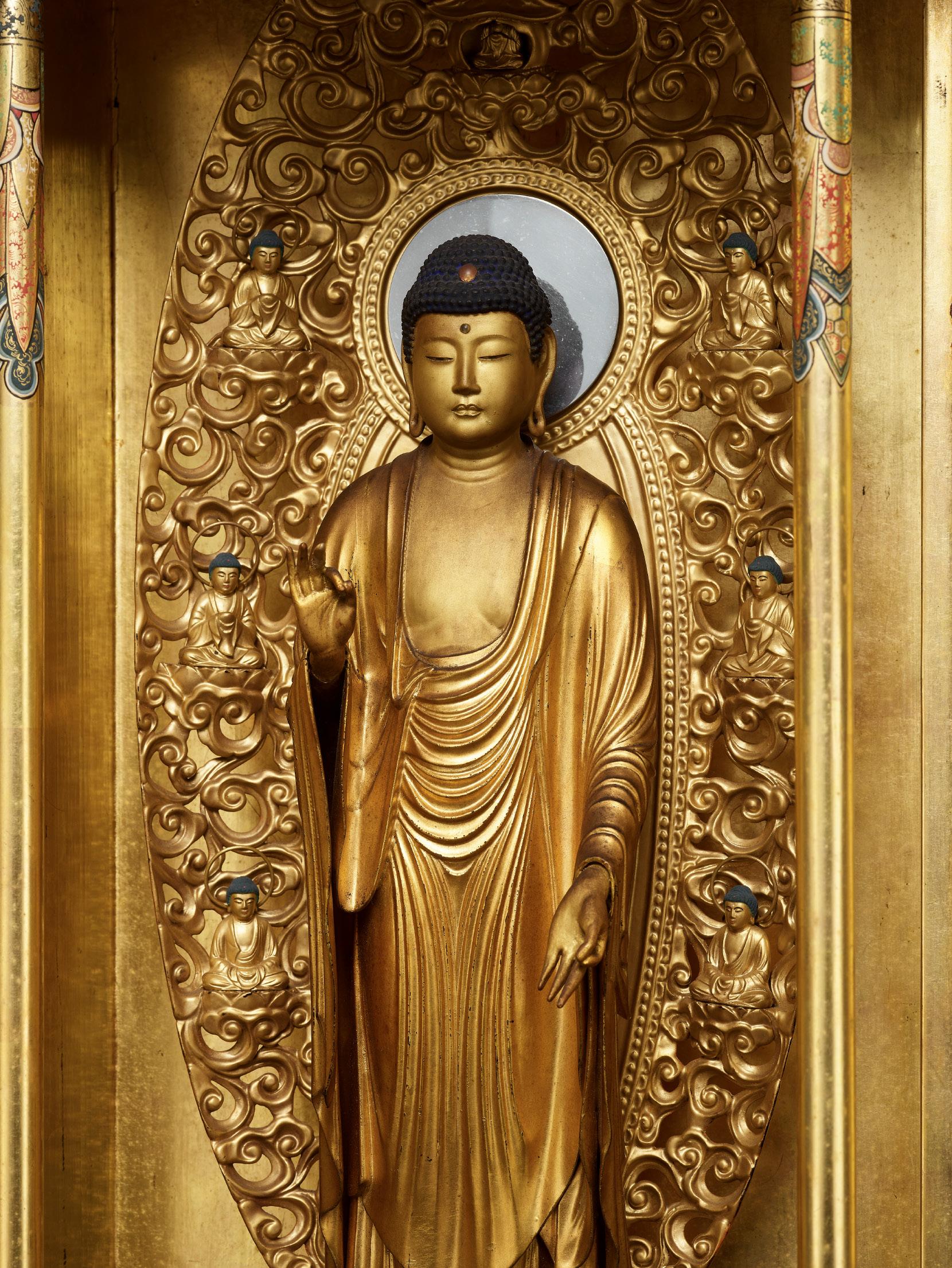
AN IMPRESSIVE LARGE LACQUERED WOOD ZUSHI (PORTABLE SHRINE) CONTAINING A GILT WOOD FIGURE OF AMIDA NYORAI

Japan, 18th-19th century, Edo period (1615-1868)
Amida standing on a lotus dais raised on a compressed globular section carved with clouds over a leafy section supported on an elaborate tiered octagonal pedestal base, carved partly in openwork, decorated with lotus, jewel, foliate, key-fret, and floral designs. The slender columns are painted with elaborate brocade designs. The kohai (aureole) is intricately carved in openwork with swirling clouds, further with seven seated Buddhas, the topmost within a stupa, above a circular silvered mirror.
The exterior of the shrine of a reddish-brown wood with copper fittings including shaped hinges and floral handles, the interior of the shrine lacquered gold.
Condition: Good condition with minor wear, little flaking to lacquer, few small nicks, light surface scratches, few minor old repairs.
The sculpture represents Amitabha, known in Japanese as Amida Nyorai, or the Buddha of Limitless Light. Amitabha reigns over the Western Pure Land, a paradise to which anyone is welcomed if they faithfully and sincerely incant his name. This place of salvation became central to the Jodo [lit. Pure Land] sect of Buddhism. Propounded in 1175 by the monk Honen, the accessibility of such tenets of redemption allowed this form of Buddhism to proliferate across the nation and feudal classes of Japan. Often depicted with an elaborate mandala, the boat-shaped halo is said to remind his followers that he serves as a guide for them to cross the ocean of suffering which contaminates the living.
Estimate EUR 15,000
Starting price EUR 8,000
85 62
HEIGHT 89.3 cm
A LARGE BUTSUDAN (BUDDHIST ALTAR) FOR AMIDA
Japan, 19th century
Ornately crafted, the black-lacquered exterior with gilt metal fittings, with three drawers and two sets of doors, the inner doors with thin lining of silk to enable a respectful view of the Buddha, opening to reveal a beautiful shrine with rich gold lacquer and a standing figure of Amida in front of three miniature hanging scroll paintings depicting Amida in the center and two praying figures. The interior of the shrine is further decorated with carved relief panels with ho-o (phoenixes) and with two open-worked metal lanterns suspended from either side of the Buddha figure.

HEIGHT 137 cm
Condition: Very good condition. Some scattered losses here and there. Presents beautifully.
Provenance: From a French private collection.
A Butsudan (仏壇, lit. “Buddhist altar”), sometimes spelled Butudan, is a shrine commonly found in temples and homes in Japanese Buddhist cultures. A butsudan is either a defined, often ornate platform or simply a wooden cabinet sometimes crafted with doors that enclose and protect a Gohonzon or religious icon, typically a statue or painting of a Buddha or Bodhisattva, or a calligraphic mandala scroll.

The Butsudan’s primary use is for paying respects to the Buddha, as well as to family members who have died.
AUCTION COMPARISON
Compare a very large Butsudan, lacking the interior figures and paintings, at Lempertz, Asian Art, 27 June 2020, Cologne, lot 42 (sold for 4,750 EUR).
Estimate EUR 5,000
Starting price EUR 2,400
86 63
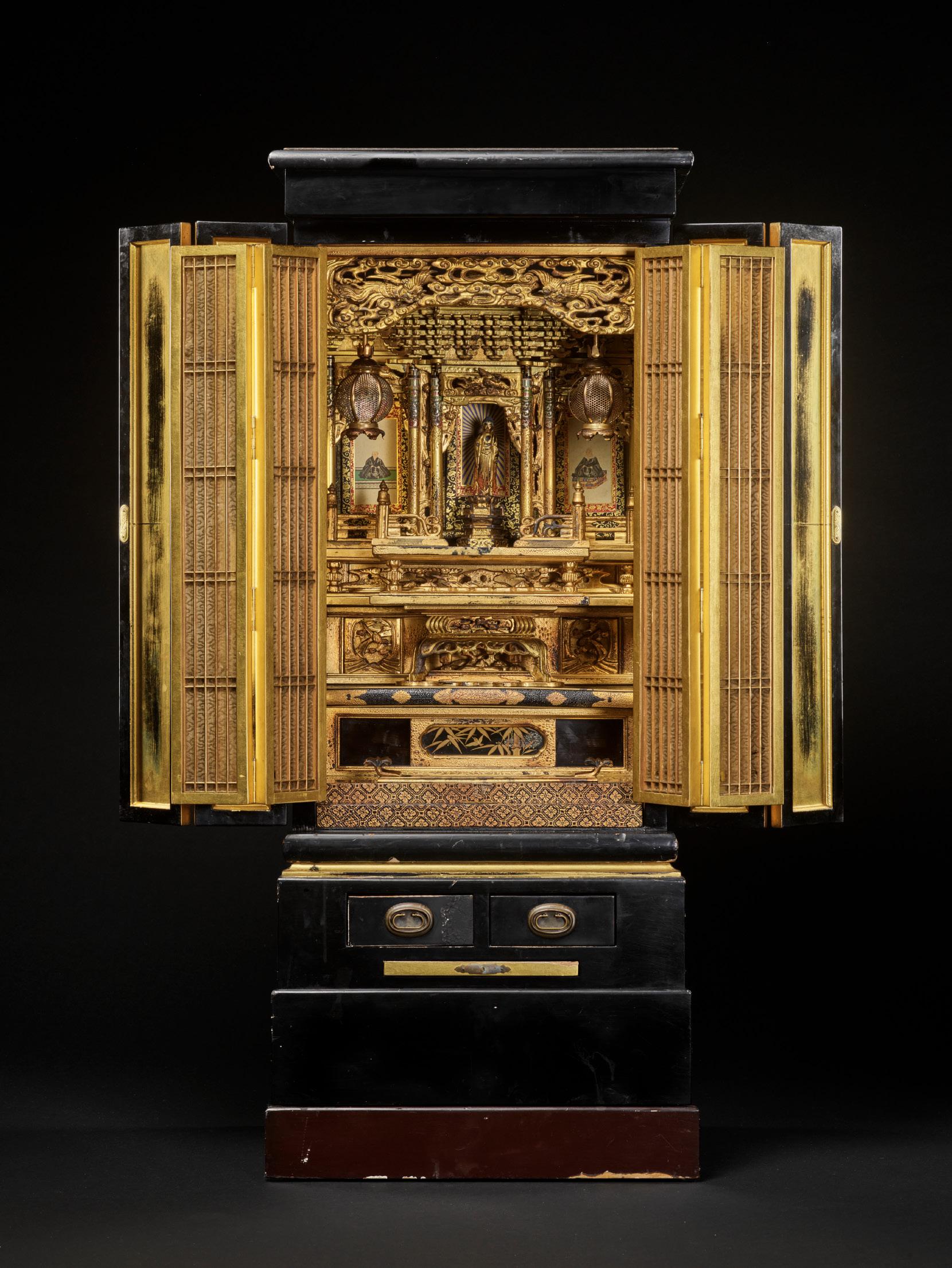
A RARE HOSHI MANDARA, MUROMACHI PERIOD
Japan, 15th-16th century, Muromachi period (1336-1573)
Mounted onto silk brocade and supported by a wooden frame, the central image neatly executed in tempera, ink and gilt on paper. Set inside a vintage frame, behind glass. Depicted is Ichijikinrin Butcho, who usually takes the form of Shaka Kinrin (Shaka of the Golden Wheel). The Shaka Kinrin is a manifestation of Shaka Buddha (the historical Buddha), in which he holds a golden wheel in his hands, with the wheel resting on the knees and the hands forming the Hokkai Join Mudra (dharma-real meditation mudra). The Shaka Kinrin is surrounded by the twelve constellations or zodiacs in the intermediate frame, followed by the twenty-eight houses in the outermost frame.

SIZE 90 x 50.5 cm (image only), 119.5 x 67 cm (total)
Condition: Good, worn condition with some old wear, minor stains and soiling, possibly some minor re-touching, minimal losses and creases. Traces of use and wear to mounting.
Provenance: Old French private collection.
The Star Mandala (Japanese: Hoshi Mandara) is unique to Japan and is created for use in both Shingon and Tendai rituals relating to stellar deities, which were also incorporated into the pantheons of these Buddhist schools. In these mandaras, the central Buddha figure is surrounded by squares or circles representing stars, within which are both peaceful and wrathful deities. Star worship never became a part of mainstream Buddhist practice in Japan, but these rare mandalas reveal an early Japanese integration of sophisticated astrological practices into Buddhist beliefs and art, created over several hundred years with tremendous artistry and precision.


MUSEUM COMPARISON
Compare a related Hoshi Mandara in the Museum of Fine Arts Boston, dated 18th-19th century, excollection William Sturgis Bigelow, accession no. 11.713. Also compare a Hoshi Mandara in the Museum of Fine Arts Boston, dated 13th century, ex-collection Denman Waldo Ross, accession no. 09.87.
Estimate EUR 10,000
Starting price EUR 5,000
88 64

A VERY RARE AND EARLY JAPANESE HANGING SCROLL PAINTING OF AN IMMORTAL, 14TH-16TH CENTURY
Japan, 14th -16th century, Kamakura (1185-133) to Muromachi period (1336-1573)
Painted with polychrome pigments and applied gold leaf on silk, depicting an immortal seated in dhyanasana above clouds, his hands lowered in dhyana mudra, surrounded by a halo, with long curly hair and a mustache, his expression painted sensitively with downcast eyes and red painted lips. Mounted as a hanging scroll with a clearly treasured blue silk brocade mounting with intricate geometric designs, ho-o (phoenix) and dragon medallions, as well as clouds, manji designs. With incised gilt brass fittings and roller ends.

SIZE (image only) 90.5 x 39 cm, SIZE 190 x 63 cm (total)
Condition: Old, worn condition with rolling and handling creases, scattered losses and possibly some minor touch-ups, light foxing and staining.
Provenance: From a private collection in Dallas, Texas, USA.

Estimate EUR 4,000
Starting price EUR 2,000
90 65

66
A LARGE EMBROIDERED SILK PANEL WITH BINZURU RAKAN AND HIS TIGER

Japan, 19th century
The large silk brocade panel is finely embroidered in various shades of brown, black, gold and bronze, depicting Binzuru rakan with his tiger. The central embroidery is framed by a fabric border and mounted to a wooden stretcher frame.
SIZE 156 x 89 cm
Condition: Overall still good condition with intricate detail with soiling, loose threads, small tears, and material loss to the fabric borders.
Provenance: The Langlois Collection. Jean-Marie-Charles Langlois, a Senior Railway Engineer in Indochina from 1920 to 1949, was passionate about Asian art and managed to build a collection that was later repatriated to France by his wife and children after his death. He tragically lost his life in 1949 during a Viet-Minh train attack. His son, Jean Marie Langlois, inherited the collection and continued to expand it with the support of his wife, aiming for coherence and quality in tribute to his father. The collection, which spans over a hundred years of collecting, was recently rediscovered in the family home.
Estimate EUR 2,000
Starting price EUR 1,000
92
A LARGE EMBROIDERED SILK PANEL WITH THREE RAKANS
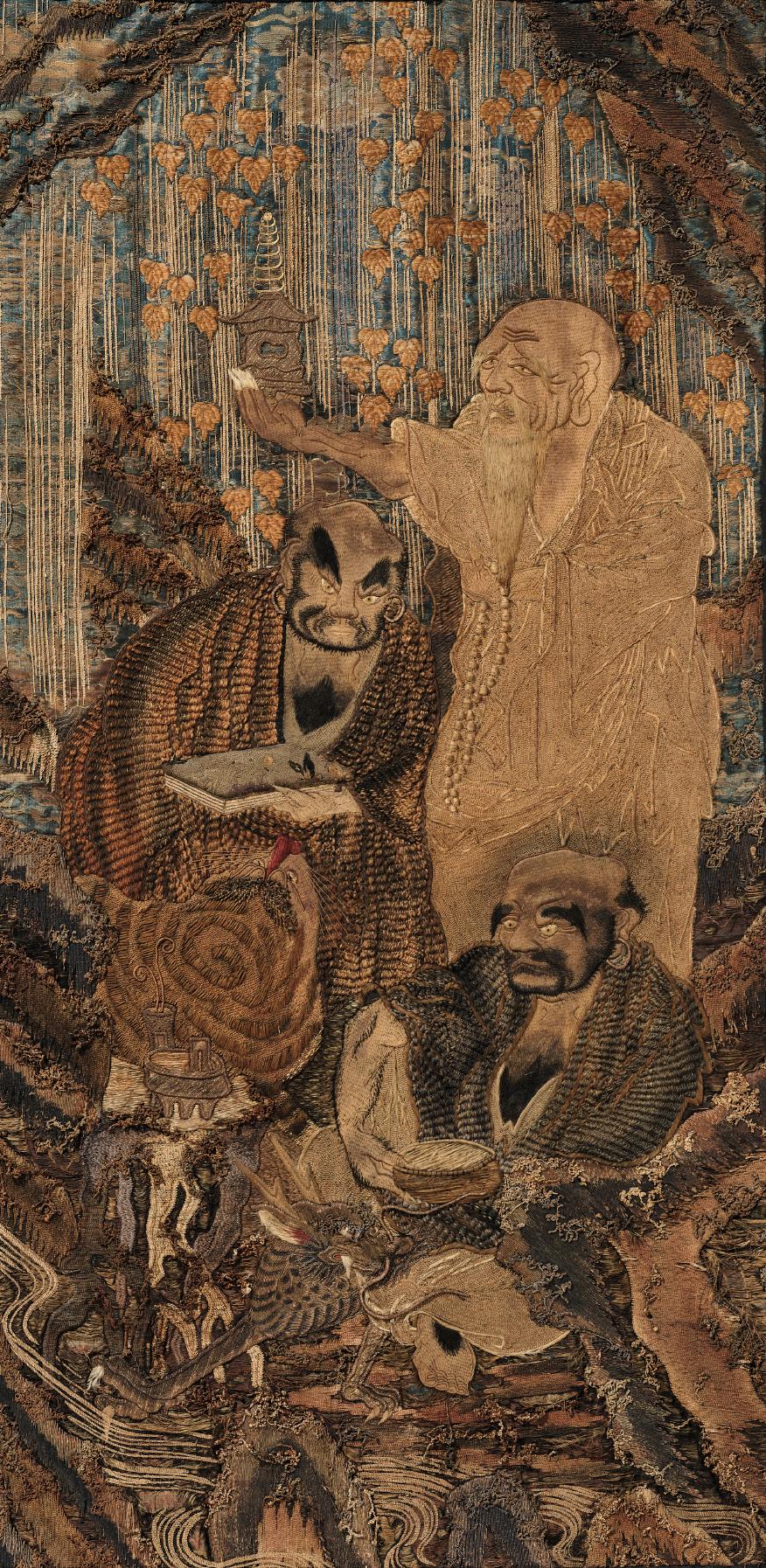
Japan, 19th century
The large panel is finely embroidered in various shades of red, brown, black, gold, bronze and blue, depicting three rakans under a vine, with one holding a miniature pagoda, another a book, and the last one being Handaka Sonja holding his bowl of alms from which the dragon in front of him emerged. The central embroidery is framed by a silk brocade border and mounted to a wooden stretcher frame.
SIZE 156 x 89 cm
Condition: Overall still good condition with intricate detail with soiling, loose threads, small tears, and material loss to the silk brocade borders.
Provenance: The Langlois Collection. Jean-Marie-Charles Langlois, a Senior Railway Engineer in Indochina from 1920 to 1949, was passionate about Asian art and managed to build a collection that was later repatriated to France by his wife and children after his death. He tragically lost his life in 1949 during a Viet-Minh train attack. His son, Jean Marie Langlois, inherited the collection and continued to expand it with the support of his wife, aiming for coherence and quality in tribute to his father. The collection, which spans over a hundred years of collecting, was recently rediscovered in the family home.
Estimate EUR 2,000
Starting price EUR 1,000
93 67
A SUPERBLY EMBROIDERED PANEL OF YOMEIMON GATE
Japan, Meiji period (1868-1912)

A very intricately embroidered silk panel with silk threads in various shades of salmon, ivory, cream, bronze and grey, depicting the Yomeimon Gate at the Tokugawa Tosho-gu shrine in Nikko. Mounted by a slender frame on a board with silk brocade backing.
SIZE 73 x 69.5 cm
Condition: Excellent condition and intricate detail. Few stray strands and a small hole on the verso backing.
The Yomeimon Gate is often referred to as the “Gate of the Setting Sun” and is renowned for its intricate carvings, gold leaf decorations, and vibrant colors. It serves as a symbol of wealth, power, and prestige, reflecting the high status and influence of the Tokugawa shogunate during its reign. The gate is also considered a masterpiece of Japanese architectural and artistic craftsmanship, showcasing various styles, motifs, and techniques, including Buddhist, Shinto, and Chinese influences.
Estimate EUR 6,000
Starting price EUR 3,000
94 68



& Woodblock Prints Lots 69 to 101
Paintings


98
A SIX-PANEL FOLDING SCREEN DEPICTING A BATTLE SCENE


Japan, Edo period (1615-1868)
Finely decorated with ink, gouache, watercolor and gold splash on paper with brocade silk mountings, depicting a detailed battle scene. Mounted to a blacklacquered wood screen with gilt metal fittings with incised decorations.
Note the fine quality of the painting, particularly evident in the elaborate armor decorations, naturalistically painted horses, and overall dynamic composition. The six panels provide a panoramic view of the battle scene, from samurais in turbulent waters to those in the forefront of the battle, on ground.
SIZE (when opened) 79 x 255 cm
Condition: Good condition with minor wear, little soiling, creases, and occasional light scratches. Some tears and minor material loss now hardly noticeable due to the backing with occasional touch-ups.
Estimate EUR 8,000
Starting price EUR 4,000
99 69
AN IMPRESSIVE PAIR OF SIX-PANEL BYOBU SCREENS DEPICTING A DOG-CHASING EVENT (INOUMONO)
Japan, 18th century, Edo period (1615-1868)
Finely decorated with ink, watercolors, and gold foil on paper to depict a large dog-chasing event (inoumono) watched by numerous spectators standing outside the fenced area, along with street vendors and entertainers as well as other contestants, amid gnarled pine and maple trees, as horse-mounted archers chase dogs of all stripes and colors, pointing their large padded arrows at the fleeing canines, with some dogs held by leashes by attendants on foot, including two attendants and three dogs resting under a tree as the chaotic scene unfolds, framed by thick clouds.
SIZE 171.8 x 63.5 cm (each panel) and SIZE (when opened) 171.8 x 367 cm
Condition: Very good condition with minor wear and little soiling, some expected tears and creases, the wood screen with minor nicks and scratches and some old repairs.
Provenance: From the collection of L. Harrison Bernbaum, Chicago, Illinois, USA. L. Harrison Bernbaum is a Chicago businessman who co-founded the outdoor company High Sierra with his father Harry Bernbaum (1917-2015), who had been one of the first American businessmen to travel to Japan in 1956, helping to pioneer manufacturing relationships between America and Japan for the American sporting goods industry.
With a silk brocade frame and mounted to a brown-lacquered screen with parcel-gilt fittings decorated with blossoming flowers and foliate scroll.
Shooting dogs from horseback was a form of samurai training that began in the Muromachi period (1392–1573). During the peaceful 1600s this activity was revived as a samurai sporting event that attracted many spectators. As a sport, dog chasing involved two teams of seventeen participants each. The riders used softly padded arrows in order not to seriously hurt the dog, which was released within a circle of rope to begin the game. A strike on the dog‘s torso scored points; strikes on the head or legs did not count. The winning team usually received prizes of lengths of white silk cloth. The present screen shows the game in progress, with the judges sitting in the building at the left of the field. As many as eighteen pairs of screens on this subject are known in Japan and the West. Later examples, such as this pair, show greater numbers of spectators, probably reflecting the growing popularity of the sport.
LITERATURE COMPARISON
Compare a closely related six-panel folding screen, also depicting a dogchasing event, dated approx. 1640, in the collection of the Asian Art Museum of San Francisco, object number B60D1.
AUCTION COMPARISON
Compare a closely related single sixpanel folding screen, also depicting a dog-chasing event, dated 17th-18th century, 171.5 x 370.8 cm, at Bonhams, Fine Japanese Works of Art, 19 March 2014, New York, lot 3098 (bought-in at an estimate of USD 20,000-30,000).




Estimate EUR 8,000
Starting price EUR 4,000

100 70
Harry Bernbaum and his wife, Harriet, on a buying trip to Japan in the 1950s


101

A FINE SIX-PANEL BYOBU SCREEN DEPICTING SNOW COVERED PINES

Japan, 18th-19th century, Edo period (1615-1868)
Masterfully painted with ink, gouache, and watercolors on a gold background, and mounted to a brown-lacquered wood screen with simplistic copper fittings. The beautiful and large six-panel byobu (room divider) employs a refined and naturalistic technique to show gnarled pine trees in snow.
SIZE (when opened) 174 x 350 cm
Condition: Good condition with minor wear, little soiling, occasional light scratches, and few minuscule losses. Some repaired tears with touch-ups.
Pine is an auspicious symbol in Japan, representing longevity due to its long life, and endurance as it remains green throughout the winter months which becomes evident on the present imagery with the wintry snow.
Estimate EUR 5,000
Starting price EUR 2,400
71
KISHI GANRYO (1798-1852): A BEAUTIFUL SIX-PANEL BYOBU SCREEN DEPICTING CRANES AND PINES
 By Kishi Ganryo
By Kishi Ganryo
Finely decorated with gouache and ink on a vibrant gold leaf background. Signed Utanosuke Shiryo, and with two seals: Ganryo no and Shiryoin (lower right corner). The panels are mounted with silk brocade borders, one made of thin white brocade, and the other, wide moss-green brocade. Mounted to a black-lacquered wood screen with gilt metal fittings with incised decorations.
An exceptional and beautiful large six-panel byobu (room divider) with a refined and naturalistic painting of five red-crowned cranes surrounded by young pines. Two cranes are depicted lying on the ground, appearing to rest, with one shown sleeping. Two others stand nearby, one picking at its toes and the other in a relaxed pose with one leg half tucked up. The last crane is shown in motion, walking towards something that has caught its attention in the distant left.
72
(1798-1852), signed Utanosuke Shiryo and sealed ‘Ganryo no’ and ‘Shiryoin’ Japan, 19th century, Edo period (1615-1868)
SIZE (when opened) 169.9 x 372.6 cm
Condition: Very good condition with minor wear, little soiling, occasional light scratches, and few minuscule tears.
Kishi Ganryo (1798-1852), was a Kyoto artist. He was the nephew, pupil and adopted son of Kishi Ganku (1749-1838). Like his father, he was a retainer of Prince Arisugawa and attached to the imperial court. His surviving work is extremely rare.
The crane is one of the most prominent symbols of longevity and good fortune in Asia. The red-crowned, or Japanese, crane depicted in this painting is said to live for 1,000 years.

Pine is an auspicious symbol in Japan, representing longevity due to its long life, and endurance as it remains green throughout the winter months. The pine trees depicted in this painting introduce a freshness and liveliness which complements the spirited movements of the cranes.
Estimate EUR 6,000
Starting price EUR 3,000
A MAKIMONO PAINTING OF CRANES IN A LANDSCAPE


Japan, 19th century
A makimono painting in ink and colors, with a gold dust background, set in a landscape with green hills, depicting seven red-hooded cranes with three colts, among pine and cherry trees in bloom. Set inside a vintage frame, behind glass.
SIZE ca 27 x 112 cm (image cut-out) and 33 x 118.5 cm (frame)
Condition: Excellent condition, vivid colors and intricate details. Frame with traces of wear and age.
The crane is one of the most prominent symbols of longevity and good fortune in Asia. The red-crowned, or Japanese, crane depicted in this painting is said to live for 1,000 years.
Pine is an auspicious symbol in Japan, representing longevity due to its long life, and endurance as it remains green throughout the winter months. The pine trees depicted in this painting introduce a freshness and liveliness which complements the spirited movements of the cranes.
Estimate EUR 1,500
Starting price EUR 800
106 73
OOKA SHIHO: A FINE AND LARGE PAINTING OF A HAWK CHASING CRANE
By Ooka Shiho,
signed and sealed by the artist
Japan, c. 1830, Edo period (1615-1868)
Painted in ink and polychrome on silk, with a brocade frame, lined, and mounted as a hanging scroll. Depicting a hawk, painted in shades of brown, chasing a white crane. Signed and inscribed to the lower right: 天保十二年霜月中旬、應于需圖六十三歳

士豊 Tempo juuninen shimotsuki chujun, rokujusansai motome ni ojite zu su, Shiho [This is painted on commission, in the mid month of November, painted by Shiho, at the age of 63].
With two seals: 獨糸(Dokushi)& 弐岳間 人 (Nigaku kanjin).
SIZE (image) 127 x 57.5 cm, 201 x 67 cm (including mounting)
Condition: Good condition, and very minor stains, signs of repair and material loss. One roller end lost.
Ooka Shiho 大岡士豊 was a talented painter and one of the best pupils of Maruyama Okyo (1733-1796)
Hawks are often depicted as fierce predators, swooping down to catch their prey with their sharp talons. They are also associated with the sport of falconry, which was popular among the nobility in Japan during the Edo period (1603-1868).
The crane is one of the most prominent symbols of longevity and good fortune in Asia. For at least two millennia, the Chinese have viewed them as living to a great age and as being able to navigate between heaven and earth. In turn, these attributes have made them logical companions of sennin, the Taoist Immortals. The redcrowned, or Japanese, crane depicted in this painting is said to live for 1,000 years.
Estimate EUR 2,000
Starting price EUR 1,000
107 74
TSUKIOKA SETTEI: A KAKEMONO OF A COURTESAN

Tsukioka Settei (1726-1786), signed Shinten’o oju giga Japan, late 18th century, Edo period (1615-1868)
Very finely painted with ink, gouache, gold, and watercolors on silk, mounted as a hanging scroll on a finely woven and embroidered silk brocade frame with lacquer handles. Depicting a courtesan wearing voluminous robes decorated with flower motifs, and a gold dragon embroidered black Haori coat, posed alone against a blank background. The red cuffs and hems provide the only bright spots of color. The courtesan depicted is from the high-ranking Oiran class. Her obi (kimono sahs) is tied at the front which is seen in the Kansai region of pleasure quarters.

Signed and inscribed to the lower right with seal: 信天翁應需戯 画 “Shinten’o oju giga” (Painted on commission with a light spirit by Shinten’o).
The Seal: 姓源、氏木田、名昌信、字大渓、号雪鼎、初号月岡、 自称、信天翁。
“Sei Minamoto, uji Kida, na Masanobu, aza Daikei, go Settei, hatsugo Tsukioka jisho Shinten’o” (The honorary surname Minamoto, family name Kida; alternative names: Masanobu, Daikei, Settei, Tsukioka, personal art name Shinten’o)
SIZE (image) 86.5 x 30.3 cm, 154 x 37.5 cm (including mounting)
Condition: Very good condition with minor traces of wear and age and few small touch-ups.
Provenance: Family collection of either Felix Tikotin (1893-1986) or his son-inlaw Louis (Loek) Borensztajn (19352021), Netherlands. Felix Tikotin (18931986) was an architect, art collector, dealer, and founder of the first Museum of Japanese Art in the Middle East. He became one of the world’s leading collectors of Japanese art, starting at the age of 18, and continued to collect and work as an art dealer in Berlin in the 1920s.
Felix Tikotin (1893-1986), center, in front of his gallery in Berlin

Tsukioka Settei (1726-1786) was a prominent Japanese painter and print artist known for his exquisite depictions of beauties, particularly courtesans and geishas, in grand and elegant robes. He studied under Takada Keiho of the Kyoto Kano school, and his early works reflected the influence of Nishikawa Sukenobu. Settei’s artistic talent blossomed, and he designed over fifty illustrated books, many of which depicted the manners and customs of women from historical eras. He gradually developed his own style and began to paint hanging scrolls of contemporary beauties, for which he is most renowned. His works featured bold patterning, intricate details, and the use of high-quality pigments, with red outlines on faces and limbs being a distinctive feature. Settei’s paintings and prints also included erotica of refined technical skill. In about An’ei 1 (1772), Settei was elevated to the rank of Hogen, which he often used in his signature. His son, Sessai, and other pupils continued his artistic legacy, emulating his style in their works.
AUCTION COMPARISON
Compare with a closely related Kakemono sold at Bonhams, Japanese Works of Art 19 Mar 2009, New York, Lot 305 (sold for 6,710 USD).
Estimate EUR 2,000
Starting price EUR 1,000
108 75
MATSUMATO FUKO: A HANGING SCROLL OF SOTOBA KOMACHI
 By Matsumoto Fuko (1840-1923), signed and sealed Fuko Takatada Japan, Meiji period (1868-1912)
By Matsumoto Fuko (1840-1923), signed and sealed Fuko Takatada Japan, Meiji period (1868-1912)
Ink and watercolor on silk, mounted on fabric coated paper as a hanging scroll with wooden handles. Titled Sotoba Komachi (title from Noh-Theatre), signed along with artist seal: Fuko Takatada. Japanese inscription on the verso, and enclosed in a red lacquer box. In the composition of various shades of grey, our attention is drawn to the red pouch tucked under Komachi’s right breast, around her waist.
Sotoba Komachi is a Noh play written by Kan’ami. Much of the strength of the play derives from the variety provided by the three main and distinct sections: lament for lost beauty; witty religious debate; and ghostly possession.
SIZE (image) 109 x 37.8 cm, 178 x 48.6 cm (including mounting)
Condition: Very good condition with minor traces of age and wear, creasing, soiling, foxing, and very minor loss of material along the edges. Fabric pilling on the verso.
Matsumoto Fuko (1840-1923) was a renowned Japanese painter and poet known for his contributions to the Nihonga movement. He studied under Shiokawa Bunrin and was associated with Sotobakomachi, a literary and artistic circle that explored classical Japanese literature and poetry. Fuko’s works were characterized by his mastery of traditional Japanese painting techniques, poetic inscriptions, and references to classical poetry. He received numerous awards and accolades for his art, and his works are highly sought after for their exquisite beauty and deep connection to Japanese culture and nature.
Estimate EUR 1,500
Starting price EUR 800
109 76
A LARGE AND RARE EMAKI HANDSCROLL WITH FOUR SEPARATE LEAVES, ONE WITH A DEPICTION OF GASHADOKURO
Japan, 19th century
Watercolor and ink on paper. Large horizontal emaki scroll depicting villagers armed with swords, sticks, and torches chasing a fox (kitsune) into a cave. The four separate leaves illustrate their journey inside the cave where they are greeted by a large Gashadokuro. As they rush and hide for cover, they are confronted by more yokai. The scroll with stag antler handles.
Scroll: SIZE 29.4 x 600 cm
Leaf (I): SIZE 29 x 80 cm
Leaf (II): SIZE 29 x 88 cm
Leaf (III): SIZE 29 x 73 cm
Leaf (IV): SIZE 29 x 50.5 cm
Condition: Each scroll in a superb state of preservation with fresh colors, the scrolls were evidently stored well. Some minor nondistracting surface wear, little soiling and creasing, few minuscule losses and tears.
Provenance: Family collection of either Felix Tikotin (1893-1986) or his son-in-law Louis (Loek) Borensztajn (1935-2021), Netherlands.
Felix Tikotin (1893-1986) was an architect, art collector, dealer, and founder of the first Museum of Japanese Art in the Middle East. He became one of the world’s leading collectors of Japanese art, starting at the age of 18, and continued to collect and work as an art dealer in Berlin in the 1920s. In the 1930s Felix Tikotin fled from the Nazis and hid his collection in the Netherlands. After the war, he decided that his collection should be taken to Israel, where in 1959 and with the help of Abba Hushi, who was the mayor of Haifa, The Tikotin Museum of Japanese Art was established. The Museum’s collection comprises more than 8,000 items of art and crafts.
Felix Tikotin (1893-1986), center, in front of his gallery in Berlin

their bodies further decay, they grow angrier and more vengeful, holding a grudge against humanity for what they have. They wander fields in the night their teeth chatter and bones rattle making a “gachi gachi” sound, hence the name Gashadokuro. If they happen upon a human, they will silently sneak up behind them and catch their victim. Crushing them in their hand or biting their head off. Gashadokuro are too large and powerful to be defeated. As such they will wander the fields until the malice stored in their bodies fade away.
Yokai is a term in Japanese folklore that refers to supernatural monsters, spirits, or demons. They are often depicted as strange or bizarre creatures with unusual appearances or behaviors and can range from mischievous and playful to terrifying and malevolent.
Emaki, also called emakimono (or less commonly ekotoba), is an illustrated horizontal narration system of painted handscrolls that dates back to the Nara period in 8th century Japan, initially copying its much older Chinese counterparts. They combine calligraphy and illustrations and are painted on long rolls of paper or silk sometimes measuring several meters. The reader unwinds each scroll little by little from right to left, revealing the story as seen fit. Emakimono are therefore a narrative genre similar to the book, developing romantic or epic stories, or illustrating religious texts and legends. The format of the emakimono, long scrolls of limited height, requires the solving of all kinds of composition problems: it is first necessary to make the transitions between the different scenes that accompany the story, to choose a point of view that reflects the narration, and to create a rhythm that best expresses the feelings and emotions of the moment. In general, there are thus two main categories of emakimono: those which alternate the calligraphy and the image, each new painting illustrating the preceding text, and those which present continuous paintings, not interrupted by the text, where various technical measures allow the fluid transitions between the scenes. Today, emakimono offer a unique historical glimpse into the life and customs of Japanese people, of all social classes and all ages, during the early part of medieval times
AUCTION COMPARISON
Gashadokuro is a Yokai made up of the bones of soldiers or victims of famine whose bodies rotted and didn’t have a proper burial. These people die with anger and pain in their hearts. Unable to pass on, their souls gather to form a giant skeleton. As
Compare the skeleton to a print by Kuniyoshi at Bonhams, Japanese and Korean Art, 23 March 2022, New York, lot 540 (sold for 150,312 USD).


Estimate EUR 6,000
Starting price EUR 3,000
77
Leaf I
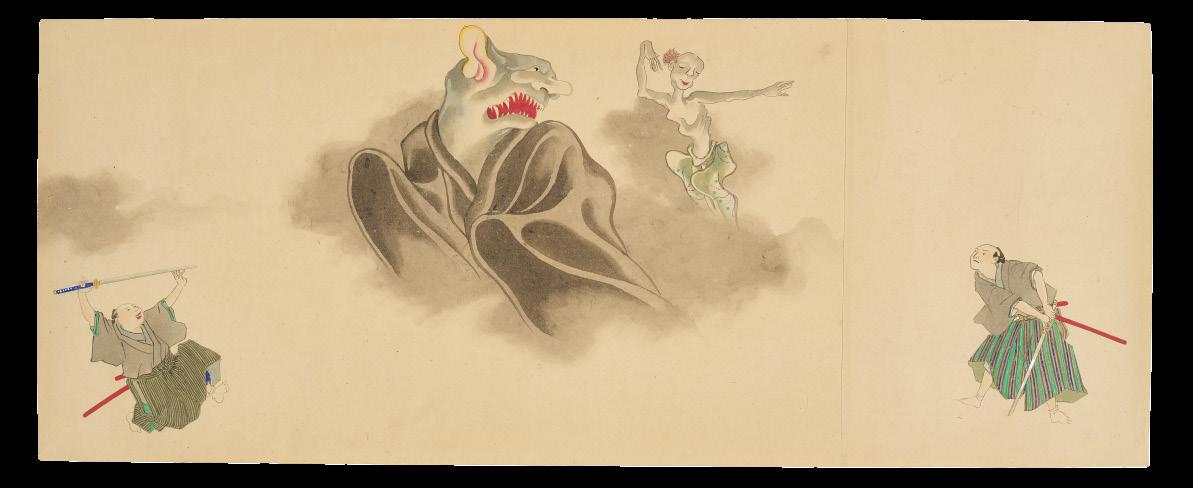
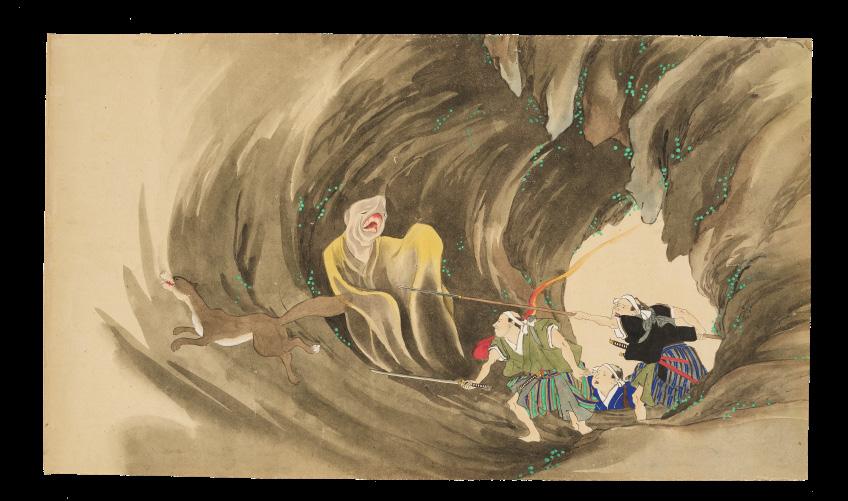

111
II
III
Leaf
Leaf
IV
Leaf
UTAGAWA HIROSHIGE (1797 – 1858), HONMOKU CLIFF IN MUSASHI PROVINCE
By Utagawa Hiroshige (1797 – 1858), signed Hiroshige ga Japan,

Color
A beautiful landscape portrait with a clear view of Mount Fuji.
SIZE of the sheet 35.8 x 24.5 cm
Condition: Good condition and impression with slightly faded colors. Very minor holes and backed with paper tape on the left margin from the verso.
Provenance: Austrian private collection, acquired in the 1990s at Galerie Zacke, Vienna.
Utagawa Hiroshige (1797 – 1858)
Utagawa Hiroshige (also referred to as Ando Hiroshige) is recognized as one of the last great masters of the ukiyo-e (“pictures of the floating world”) woodblock printing tradition. His style can be characterized in the genre of landscape print, innovated by his early
contemporary Hokusai (1760-1849). Hiroshige can be attributed to having created over 5,000 prints of everyday life and landscape in Edo-period Japan. Inspired by Katsushika Hokusai’s popular Thirty-Six Views of Mount Fuji, Hiroshige took a softer, less formal approach with his Fifty-Three Stations of the Tokaido (1833–34), completed after a trip he made between Edo and Kyoto, which is acclaimed to be perhaps his finest achievement.
He made numerous other journeys within Japan and issued a series of such prints, expressing in great detail the poetic sensibility inherent in the climate and topography of Japan and its people. Hiroshige’s prolific output was somewhat due to his being paid very little per series. Still, this did not deter him, as he receded to Buddhist monkhood in 1856 to complete his brilliant and lasting One Hundred Famous Views of Edo (1856–58). He died in 1858, 10 years before Monet, Van Gogh, and a lot of Impressionist painters became eager collectors of Japanese art.

MUSEUM COMPARISON
An identical print is in the collection of the Van Gogh Museum, Amsterdam, object number n0089V1962.
Estimate EUR 1,000
Starting price EUR 500
112 78
dated 1858
woodblock print on paper. Vertical Oban. Signed Hiroshige ga with Tsutaya Kichizo publisher seal. Entitled Honmoku Cliff in Musashi Province, from the series Thirty-Six Views of Mount Fuji.
ICHIYUSAI KUNIYOSHI (1797-1861), HOSOKUTE: HORIKOSHI DAIRYO
By Ichiyusai Kuniyoshi
(1797-1861), signed Ichiyusai Kuniyoshi ga Japan, dated 1852

Color woodblock print on paper. Vertical Oban. Signed Ichiyusai Kuniyoshi ga and published by Yawataya Sakujiro; censor seal: Mera, Watanabe, dated: 1852 (Kaei 5/Month 7). Entitled Hosokute: Horkoshi Dairyo, no. 49 from the series Kisokado rokujukyu tsugi no uchi (The Sixty-nine Stations of the Kisokaido).
Horikoshi Dairyo, the villainous nobleman, drawing his sword against the ghost of Asakura Togo in a scene from the Kabuki play Higashiyama Sakura soshi.
SIZE of the sheet 35.5 x 24 cm
Condition: Great impression and vivid colors with trimmed margins; 2 very tiny holes and creasing along the centerfold which is reinforced with small squares of masking tape.
MUSEUM COMPARISON
An identical print is in the collection of the Museum of Fine Arts, Boston accession number 11.28766.
Estimate EUR 800
Starting price EUR 400
ICHIYUSAI KUNIYOSHI (1797-1861), OKABE. THE STORY OF THE CAT STONE
By Ichiyusai
Kuniyoshi (1797-1861), signed Ichiyusai Kuniyoshi ga and sealed with artist’s paulownia seal Japan, c. 1845-1846
Color woodblock print on paper. Vertical Oban. Signed Ichiyusai Kuniyoshi ga, with artist’s paulownia seal, and published by Ibaya Kyubei (Kinseido); censor seal: Mura (Murata Sahei). Entitled Okabe: Neko Ishi No Hanashi (Okabe: The Story of the Cat Stone), from the series Tokaido gojusan tsui (Fifty-three Pairings for the Tokaido).

Station 22, from a series jointly designed by Hiroshige, Kunisada, and Kuniyoshi. The cat-witch of Okabe and her female victim.
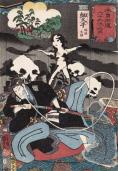

SIZE of the sheet 36 x 24.4 cm
Condition: Good impression and great colors, with trimmed margins, very minor material loss and glue residue along the margins, creasing along the centerfold.
MUSEUM COMPARISON
An identical print is in the collection of the British Museum, museum number 2008,3037.04324. Another identical print is in the collection of the Museum of Fine Arts, Boston accession number 11.25044.
“The village of Okabe is remembered for the dark weathered cat-shaped stone located next to a small temple. People generally thought that a cat witch once haunted the temple grounds and that the ordeal for the villagers would not end until the cat witch had died and turned to stone. The Okabe story was adapted for the kabuki theatre... but the text at the top of this print also states that nobody knows the exact details of the tale.” (Heroes and Ghosts: Japanese Prints by Kuniyoshi by Robert Schaap, p. 72.)
Estimate EUR 800
Starting price EUR 400
113 79
80
UTAGAWA KUNISADA II (1823-1880), PENTAPTYCH: COURTESANS OF THE HOUSE OF OWARIYA HIKOTARO VIEWING CHERRY BLOSSOMS
By Utagawa Kunisada II (1823-1880), signed Kunisada ga Japan, dated 1866
Color woodblock print on paper. Vertical oban pentaptych. Each sheet signed Kunisada ga; published by Tsutaya Kichizo (Koeido), 1866, 2nd month. Entitled Shin Yoshiwara karitaku, Owariya Hikotaro kakae yujo hanami zu (Temporary quarters of the New Yoshiwara: Courtesans of the House of Owariya Hikotaro Viewing Cherry Blossoms). Sold with a frame (behind glass).
Here courtesans decked out in their finery parade in decorated boats on the Sumida River in Edo. They are embarking on a cherry blossom-viewing party, accompanied by their young attendants, also dressed in elaborate gowns. A spectacle equal to the blossoming flowers, the women are the center of attention of boatloads of patrons, many of whom include samurai who wave and call out to them. Taking advantage of the expansiveness of the

82
ICHIYUSAI KUNIYOSHI (1797-1861), TRIPTYCH: DESCENDING GEESE AT TAKADONO
By Ichiyusai Kuniyoshi (1797-1861), signed Ichiyusai Kuniyoshi ga and sealed with artist’s paulownia seal Japan, dated 1846
Color woodblock print on paper. Oban Triptych. Signed Ichiyusai Kuniyoshi ga, sealed with artist’s paulownia seal, censor’s seal: Mura; publisher: Enshu-ya Matabei. Entitled Takadono no rakugan (Descending Geese at Takadono) from the series Mitate hakkei (Selection for the Eight Views).
Masakado drinking sake on a terrace with Kikyo-no-maye and other ladies watching a flight of wild geese in the year 939.

FuULL SIZE 36.5 x 76 cm
Condition: Good condition with vivid colors and fine impression. Minor stains and abrasions.
pentaptych (five-part) format, Kunisada creates a panoramic view of the festivities.
Oban pentaptych SIZE ca. 35 x 123 cm (the image) and 49 x 136.5 cm (the frame)
Condition: Good colors and impression. With minor stains, fading, creasing mainly along the centerfold, repairs, material loss and tears.
Utagawa Kunisada II (1823-1880), also known as Toyokuni III, was a prominent ukiyo-e artist of the Edo period, specializing in prints of actors, kabuki theater scenes, and beautiful women. He was a student and adopted son of ukiyo-e master Utagawa Kunisada (Toyokuni I). Despite facing financial challenges, Kunisada II continued to produce a significant body of work known for its distinctive style and innovative compositions. His prints are prized for their artistic merit and cultural significance, and he is recognized as a prominent figure in Japanese art history.
Estimate EUR 1,000
Starting price EUR 500
Ichiyusai Kuniyoshi (1797-1861) was a renowned Japanese ukiyo-e artist who achieved great fame during the Edo period. He was known for his dynamic and bold depictions of warriors, heroes, and landscapes. Kuniyoshi’s prints often featured imaginative and fantastical themes, and he was particularly renowned for his series on heroes and warriors, which earned him a wide following. His prints were characterized by his skillful use of color, intricate details, and expressive compositions.
Estimate EUR 1,000
Starting price EUR 500
114
81
ICHIEISAI YOSHITSUYA (1822-1866): TRIPTYCH OF YORIMITSU TRIES TO CAPTURE HAKAMADARE BY DESTROYING HIS MAGIC
 By Ichieisai Yoshitsuya (1822-1866), signed Ichieisai Yoshitsuya Japan, dated 1858
By Ichieisai Yoshitsuya (1822-1866), signed Ichieisai Yoshitsuya Japan, dated 1858
Color woodblock print on paper. Oban Triptych. Signed Ichieisai Yoshitsuya with censor’s seal Horse 4. The print was published by Tsutaya Kichizo (Koeido), 4th month 1858. Titled Kijutsu o yabutte Yorimitsu Hakamadare o karamen to su (Yorimitsu tries to capture Hakamadare by destroying his magic).
The triptych depicts the confrontation between Minamoto no Yorimitsu and the magician Hakamadare Yasumasa from the Taiheiki (Chronicle of Great Peace), which is a Japanese historical epic written in the late 14th century and covers the period from 1319 to 1367. Lord Minamoto Yorimitsu (also known as Raiko) and three of his four top retainers pursue the notorious thief Hakamadare, who attempts to evade capture by using magic to create a distracting illusion of a fight between a bear and an enormous snake.

OBAN 24.5 x 37 cm; 25.5 x 36.8 cm; 24.9 x 37.3 cm
Condition: Excellent condition with vivid colors and fine impression. Very minor creasing.
Ichiesai Yoshitsuya (1822-1866) was a Japanese ukiyo-e artist who worked primarily in the mid-19th century. He was a student of Utagawa Kuniyoshi and specialized in creating prints featuring kabuki actors and historical subjects. Yoshitsuya was known for his dynamic and dramatic compositions, as well as his use of bright colors and intricate details. He collaborated with other prominent artists and publishers of his time and created a large body of work that continues to be highly regarded. Yoshitsuya died at the young age of 44.
Museum comparison: An identical print is in the collection of the Museum of Fine Arts, Boston accession number 11.39705a-c.
AUCTION COMPARISON
Compare with an identical triptych, sold at Christie’s, From Artist to Woodblock: Japanese Prints, 4 July – 11 July 2019, Online, Lot 100 (sold for 6,875 GBP). Compare with another identical triptych, sold at Christie’s, From Artist to Woodblock: Japanese Prints, 11 June –18 June 2020, Online, Lot 72 (sold for 5,000 GBP).
Estimate EUR 4,000
Starting price EUR 2,000
115 83
ABOUT THE ARTIST (Lots 84-86)
Leonard Tsuguharu Foujita (1886-1968) was a celebrated JapaneseFrench painter known for his unique blend of traditional Japanese art and Western modernism. His works featured bold outlines, flat colors, and strong design, often depicting portraits of women, cats, and scenes from everyday life. Foujita was an active member of the School of Paris, a group of international artists who converged in Paris in the early 20th century. His close friendships with prominent artists, including Modigliani and Picasso, contributed to the development of modern art movements in France and beyond.

84 LEONARD TSUGUHARU FOUJITA (1886-1968), FILLETTE AU CHAT, FROM LES ENFANTS
Japan, c. 1929
Fillette au Chat, from Les Enfants Catalog Raisonné Buisson I.29.66 Etching and aquatint printed in colors, circa 1929, chine appliqué to japan support, signed in pencil on the bottom right corner, edition numbering mostly erased but last 0 still visible, this etching is most certainly part of the 100 editions, apart from the artist prints, published by Les Editions Artistiques Apollo, Paris, with full margins.
SIZE of the sheet 40.5 x 31.7 cm
Condition: Well-preserved with detailed impression and great colors. Slightly browned commensurate with age. Evident glue residue and markings where frame was attached to the margin. Sheet is trimmed.
Provenance: From the collection of Gaston Lazard (1878-1956) and his wife Jane Levy (1886-1985) and thence by descent within the same family.
AUCTION COMPARISON
Compare with another edition (52/100) of this etching sold at Mainichi Auction, Paintings, Prints and Sculpture, 20 April 2019, Tokyo, Lot 13 (sold for 18,750 EUR).

Estimate EUR 12,000
Starting price EUR 6,000
116
Tsuguharu Foujita photographed in 1927

LEONARD TSUGUHARU FOUJITA (1886-1968), TWISTING CAT, FROM LES CHATS

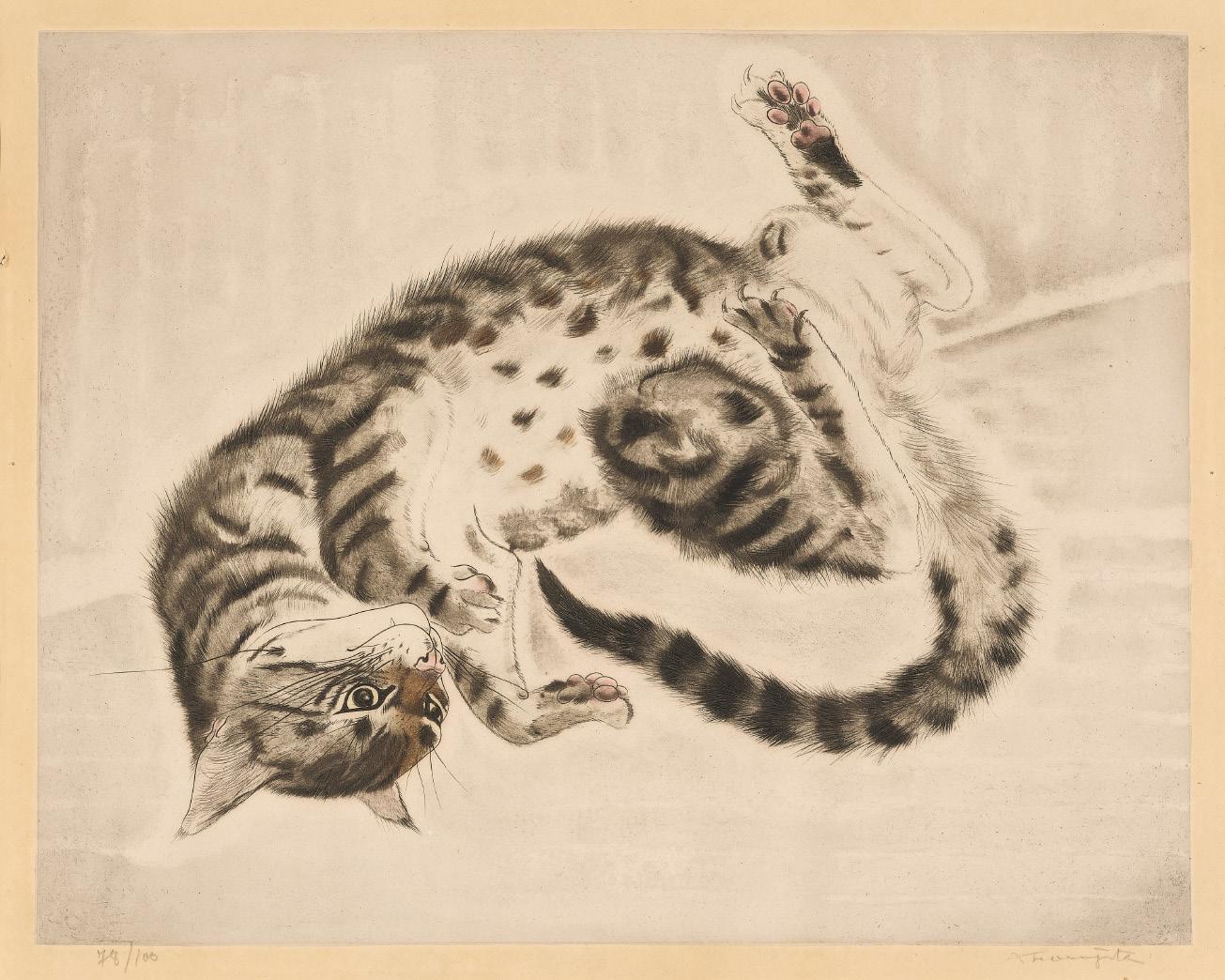
Japan, c. 1930
Chat couché, from Les Chats Catalog Raisonné Buisson 29.200.1
Etching and aquatint printed in colors, circa 1930, chine appliqué to japan support, signed and numbered 78/100 in pencil, published by Les Editions Artistiques Apollo, Paris, with full margins.
Foujita had a great fondness for cats and often included them in his paintings. In fact, he is sometimes referred to as the “Cat Painter” and is credited with popularizing the idea of the “artist and cat” archetype. This edition of “Les Chats” is a testament to Foujita’s love of felines and features his unique style that blends elements of traditional Japanese art with Western modernism.
SIZE of the sheet 44.8 x 51.9 cm
Condition: Well-preserved with detailed impression and great colors. Slight signs of wear commensurate with age, minor browning, and few small holes at the margin.
Provenance: From the collection of Gaston Lazard (1878-1956) and his wife Jane Levy (1886-1985) and thence by descent within the same family.
AUCTION COMPARISON
Compare with another edition (81/100) of this etching sold at Bonhams, Prints & Multiples, 16 November 2016, London, Lot 21AR (sold for 16,250 GBP).
Estimate EUR 12,000
Starting price EUR 6,000
118
85
LEONARD TSUGUHARU FOUJITA (1886-1968), SEATED CAT, FROM LES CHATS


Japan, c. 1930
Chat assis, from Les Chats
Catalog Raisonné Buisson 29.06
Etching and aquatint printed in colors, circa 1930, chine appliqué to japan support, signed and numbered 37/100 in pencil, published by Les Editions Artistiques Apollo, Paris, with full margins.
Foujita had a great fondness for cats and often included them in his paintings. In fact, he is sometimes referred to as the “Cat Painter” and is credited with popularizing the idea of the “artist and cat” archetype. This edition of “Les Chats” is a testament to Foujita’s love of felines and features his unique style that blends elements of traditional Japanese art with Western modernism.
SIZE of the sheet 52.8 x 43.8 cm
Condition: Well-preserved with detailed impression and great colors. Slight signs of wear commensurate with age, and minor browning.
Provenance: From the collection of Gaston Lazard (1878-1956) and his wife Jane Levy (1886-1985) and thence by descent within the same family.
AUCTION COMPARISON
Compare with another edition of this etching sold at Ader, Estampes Anciennes et Modernes, 19 November 2015, Paris, Lot 235 (sold for 7,200 EUR).
Estimate EUR 7,000
Starting price EUR 3,400
119
86
OHARA KOSON (1877-1945), THREE SPARROWS

By Ohara Koson (1878-1945), sealed Koson Japan, first half of 20th century, late Meiji (1868-1912) to early Showa period (1926-1989)
Color woodblock print on paper. Artist’s seal “Koson” to the bottom left. Showing three sparrows amidst a banana plant. Firmly mounted inside a passepartout.
SIZE of the image cut-out 32.5 x 18 cm, Size incl. matting 43.5 x 27.5 cm
Condition: Excellent condition with good impression and fresh colors.
Estimate EUR 800
Starting price EUR 400
OHARA KOSON (1877-1945), SCOPS OWL IN FLIGHT, CHERRY BLOSSOMS AND FULL MOON

By Ohara Koson (1878-1945), signed and sealed Shoson
Japan, first half of 20th century, late Meiji (1868-1912) to early Showa period (1926-1989)
Color woodblock print on paper in Naga Oban format. Published by Kokkeido (Akiyama Buemon). Scops Owl in Flight, Cherry Blossoms and Full Moon. Keen-eyed owl flies past a cherry branch full of blossoms. A large full moon is seen in the background.
SIZE of the sheet 50 x 22 cm
Condition: Excellent condition with good impression and fresh colors. Provenance: From the private collection of a British artist, formed in the 1990s.
Ohara Koson (1877-1945) was a Japanese painter and woodblock print designer of the late 19th and early 20th centuries, part of the shin-hanga (“new prints”) movement. He is famous as a master of kacho-e (bird-andflower) designs. Throughout a prolific career, in which he created around 500 prints, he went by three different titles: Ohara Hoson, Ohara Shoson, and Ohara Koson.
MUSEUM COMPARISON
A closely related print is in the collection of the Harvard Art Museum, object number 1937.117.
Estimate EUR 3,000
Starting price EUR 1,500
120
88
87

121
KAWASE HASUI (1883-1957), MT. FUJI FROM YUIMACHI AT SURUGA
By Kawase Hasui (1883-1957), signed Hasui and sealed Sui Japan, dated 1934
Color woodblock print on paper. Vertical Oban. Signed Hasui with seal “sui” (bottom-right) in the image along with Watanabe publisher seal from the years 1931-1941 along the bottom-right margin. Entitled Mt. Fuji from Yuimachi at Suruga from the series Tokaido Fukei Senshu (Selection of Views of the Tokaido). Vertical inscription along the left margin.

Mount Fuji seen from the town of Yui in Suruga province.
SIZE of the sheet 37.6 x 25.8 cm
Condition: Detailed impression and colors commensurate with age. Trimmed margins with slight material loss and creasing. Remains of paper mounting on the verso.
Provenance: The Chaplain Collection, USA. Sylvia and Philip Chaplain were involved in the business of art and antique collecting for over six decades. Their interest in Asian arts and antiques began with the purchase of Japanese woodblock prints. After selling one for $90 and then discovering it was worth more than $500, they realized the value of their acquisitions and dedicated themselves to learning more. They traveled throughout Asia, acquiring items for their growing collection, and participating in American antique shows including the Arts of Pacific Asia shows in New York City and San Francisco.
Kawase Hasui (1883-1957) was a prominent Japanese artist and printmaker of the shin-hanga (“new prints”) movement. He is best known for his landscape prints depicting scenes of Japan, which were highly detailed and often captured the beauty and tranquility of the country’s natural landscapes. Hasui’s works were characterized by their delicate colors and sophisticated composition, and his legacy as a master of shin-hanga continues to influence Japanese art and culture today.
Estimate EUR 3,000
Starting price EUR 1,500
122 89
KAWASE HASUI (1883-1957), ROAD TO NIKKO
 By Kawase Hasui (1883-1957), signed Hasui and sealed Sui Japan, dated 1930
By Kawase Hasui (1883-1957), signed Hasui and sealed Sui Japan, dated 1930
Color woodblock print on paper. Vertical Oban. Signed Hasui with seal “sui” (bottom-right) in the image along with a black Watanabe publisher seal below it. Entitled Nikko gaido (The Road to Nikko). Vertical inscription along the left margin.
A road through the deep forest of large cryptomeria trees in Nikko. The sun rays cast dappled patterns on the sides of the ancient trees and on the shaded forest road. A villager is walking toward the opening, where the blue sky with white clouds and the brightly lit trees are seen.
SIZE of the sheet 39.3 x 26.8 cm
Condition: Great impression, vivid colors and registration with two very small binding holes on the left margin.
Provenance: The Chaplain Collection, USA. Sylvia and Philip Chaplain were involved in the business of art and antique collecting for over six decades. Their interest in Asian arts and antiques began with the purchase of Japanese woodblock prints. After selling one for $90 and then discovering it was worth more than $500, they realized the value of their acquisitions and dedicated themselves to learning more. They traveled throughout Asia, acquiring items for their growing collection, and participating in American antique shows including the Arts of Pacific Asia shows in New York City and San Francisco.
Museum comparison: An identical print is in the collection of the Museum of Fine Arts, Boston accession number 50.2852.
AUCTION COMPARISON
Compare a closely related print by Kawase Hasui at Christie’s, From Artist to Woodblock: Japanese Prints from 18th-20th Century, 28 June 2016, London, lot 102 (sold for 2,000 GBP).

Estimate EUR 2,000
Starting price EUR 1,000
123 90
91 KAWASE HASUI (1883-1957), EVENING GLOW IN SPRING, TOSHOGU SHRINE, UENO
By Kawase Hasui (1883-1957), signed Hasui and sealed Sui Japan, dated 1948
Color woodblock print on paper. Vertical Oban. Signed Hasui with seal “sui” (bottom-right) in the image along with a 6mm red Watanabe publisher seal on bottom-left corner. Entitled Haru no yu (Ueno Toshogu). Vertical inscription along the left margin. Wonderfully simple yet bold image of a pagoda with cherry blossoms in the foreground.

SIZE of the sheet 39.5 x 26.3 cm
Condition: Great impression, registration and vivid colors.
Estimate EUR 1,500 Starting price EUR 800
92 KAWASE HASUI (1883-1957), MATOBA IN TAKEHARA


By Kawase Hasui (1883-1957), signed Hasui and sealed Sui Japan, dated 1948
Color woodblock print on paper. Horizontal Oban. Signed Hasui with seal “sui” (lower-right) in the image along with publisher Watanabe’s seal (bottom-left corner). Entitled Takehara Matoba (Matoba in Takehara). Mounted inside a cardboard passepartout.
Landscape scene depicting Matoba beach in Takehara.
SIZE of the sheet 26.5 x 39 cm
Condition: Great impression, fresh colors, very few holes and creases along the outer margin.
MUSEUM COMPARISON
An identical print is in the collection of the Art Institute of Chicago, reference number 1990.607.575.
Estimate EUR 1,500
Starting price EUR 800
124
KAWASE HASUI (1883-1957), SENJU WATERFALL, AKAME
By Kawase Hasui (1883-1957), signed Hasui and sealed Sui Japan, dated 1951
Color woodblock print on paper. Oban-tate format. Signed Hasui with seal “sui” (right) in the image along with publisher Watanabe’s seal on the margin (bottom-left corner). Titled in kanji on the left margin. Entitled Akame Senjudaki (Senju Waterfall, Akame). The serene autumn landscape showcases a waterfall cascading into a pristine blue pool, while the foreground is adorned with vibrant orange hues of maple leaves. The verso with a penciled inscription ‘Hasui 1952’.


SIZE of the sheet 40.2 x 26.5 cm
Condition: Great impression, vivid colors and registration.
One of Hasui’s best waterfall views.
Estimate EUR 1,500
Starting price EUR 800
KAWASE HASUI (1883-1957), MYOHONJI TEMPLE, KAMAKURA
By Kawase Hasui (1883-1957), signed Hasui and sealed Sui Japan, dated 1931
Color woodblock print on paper. Oban-tate format. Signed Hasui with seal “sui” (lower-right) in the image along with publisher Watanabe’s seal (bottom-left corner). Entitled Kamakura Myohonji (Myohonji Temple, Kamakura).
Depicting the Myohonji Temple of the Nichiren Sect in Kamakura, the cherry trees are in full bloom at the main gate.
SIZE of the sheet 39.5 x 26.5 cm
Condition: Great impression, good colors, firmly mounted to cardboard. Minor signs of wear, and slightly browned commensurate with age.
Estimate EUR 1,500
Starting price EUR 800
125 93
94
TSUCHIYA KOITSU (1870-1949), THE POND OF SARUSAWA, NARA ON A RAINY EVENING

SIZE of the sheet 40.5 x 26.5 cm
By
Tsuchiya
Koitsu (1870-1949), signed Koitsu with seal ‘Shin’ Japan, dated 1941
Color woodblock print on paper. Vertical Oban. Signed Koitsu with ‘Shin’ seal on the bottom right corner of the image along with Baba Nobuhiko publisher seal on the left margin. Entitled Nara Sarusawa no Ike (Sarusawa Pond at Nara). This print appears to be part of the “export” version as it has the title and Koitsu signature written in the Latin script in the bottom margin. Vertical inscription along the right margin.
Sarusawa Pond and the silhouette of Kofuku temple Pagoda on a rainy evening. The daylight still lingers at the horizon. The orange lights from the houses and streetlamps cast their reflections on the dark water surface.
Condition: Great impression, registration and vivid colors. Very minor wear.
Tsuchiya Koitsu (1870-1949) was a renowned landscape artist and a student of the famous Meiji-era print designer Kobayashi Kiyochika (1847-1915). He gained prominence as a designer of shin hanga (New Prints) for major woodblock print publishers from the early 1930s to 1940. Tsuchiya Koitsu’s prints were known for their dramatic use of light and interesting color effects, influenced by his teacher Kiyochika. While some critics praised his work, noting its quality on par with famous shin hanga landscape artists like Kawase Hasui, Kasamatsu Shiro, and Yoshida Hiroshi, others criticized his heavy-handed design and unconventional color sensibility.
Estimate EUR 1,500
Starting price EUR 800
126 95
97 TSUCHIYA KOITSU (1870-1949), SENGAKUJI TEMPLE AT TAKANAWA

By Tsuchiya Koitsu (1870-1949), signed Koitsu with seal ‘Shin’ Japan, dated 1933
Color woodblock print on paper. Horizontal Oban. Signed Koitsu with ‘Shin’ seal on the bottom left corner of the image. With Doi Hangaten publisher watermark ‘Doi’ located on the top-left corner. Vertical inscription along the right margin.
96 TSUCHIYA KOITSU (1870-1949), BENKEI BRIDGE

By
Tsuchiya Koitsu (1870-1949),
signed Koitsu with seal ‘Shinsei’ Japan, dated 1933
Color woodblock print on paper. Vertical Oban. Signed Koitsu with ‘Shinsei’ seal on the bottom right corner of the image. With Doi Hangaten publisher watermark ‘Doi’ located on the top-left corner. Entitled Benkei Bashi (Benkei Bridge) from the series Tokyo Fukei (Views of Tokyo). Vertical inscription along the right margin.
A beautiful bridge illuminated by streetlights on a spring evening with trees in full bloom.
SIZE of the sheet 40 x 26.5 cm
Condition: Great impression, registration and vivid colors. Wear commensurate with age with two minor binding holes on the left margin.
Estimate EUR 1,200
Starting price EUR 600
An evocative night scene of the Sengakuji Temple in the evening during rainfall. Beautiful colors illuminate the street as reflected light bounces off it.
SIZE of the sheet 26.8 x 39.8 cm
Condition: Great impression, vivid colors and registration. Wear commensurate with age with very minor browning.
Estimate EUR 1,000
Starting price EUR 500
127
98
TSUCHIYA KOITSU (1870-1949), TOMONOTSU

By Tsuchiya Koitsu (1870-1949), signed Koitsu with seal ‘Shin’ Japan, dated 1940
Color woodblock print on paper. Vertical Oban. Signed Koitsu with the ‘Shin’ seal along the right margin of the image along with a black 6mm Watanabe publisher seal below it. Entitled Tomonotsu from the series Seto Naikai (Inland Sea). Vertical inscription along the left margin.
Sailboats quietly float in the waning glow of sunset at a harbor in Tomonotsu.
SIZE of the sheet 38.5 x 26.6 cm
Condition: Great impression, good colors, with slightly trimmed margins and minor browning of paper commensurate with age. Two minor binding holes on the left margin and negligible residue of tape.
MUSEUM COMPARISON
An identical print is in the collection of the Art Institute of Chicago, reference number 1990.607.280. Another identical print is in the collection of the Museum of Fine Arts, Boston accession number 52.45.


Estimate EUR 1,200
Starting price EUR 600
99
TAKAHASHI SHOTEI (1871-1945), SEKIYADO
By Takahashi Shotei (1871-1945), signed Takahashi Shotei and sealed ‘hiroaki’ Japan, dated 1936
Color woodblock print on paper. Nishiki-e. Signed Takahashi Shotei and sealed ‘hiroaki’. Titled Sekiyado in the 1936 Watanabe Catalogue as number 242.
Fishing boats head home against the setting sun with geese flying overhead. The sky retains a reddish hue, and the faint lights from the houses and boats provide the only illumination in the otherwise dark composition.
SIZE of the sheet 38.5 x 17.4 cm
Condition: Excellent condition and vivid colors. Very minor browning, commensurate with age.
Estimate EUR 1,000
Starting price EUR 500
128
100
UEMURA SHOEN (1875-1949), THE SNOW WOMAN


By Uemura Shoen (1875-1949), signed and sealed Shoen Japan, Taisho Era, 1922

Color woodblock print on paper. Ink, white gouache and gold paint. Oban-tate format. Signed top right Shoen with artist’s seal. Yuki Onna (The Snow Woman), from the play Yuki Onna Gomai Hagoita, adapted from the book Dai Chikamatsu Zenshu (Woodblock Prints depicting Chikamatsu Monyaemon’s collected works).
SIZE of the sheet 43.5 x 28.5 cm
Condition: Good impression, color and registration, with slightly trimmed margins and minor creasing along the edges.
Provenance: From the private collection of a British artist, formed in the 1990s.
MUSEUM COMPARISON
An identical print is in the collection of the Museum of Fine Arts, Boston accession number 59.840.
Estimate EUR 1,000
Starting price EUR 500
101 PAUL JACOULET (1902-1960), CHAGRIN D’AMOUR: KUSAI, EST CAROLINES
By Paul Jacoulet (1902-1960), signed Paul Jacoulet along with the red Butterfly seal Japan, dated 1940
Color woodblock print on paper. Vertical Oban. Signed Paul Jacoulet in pencil, along with the red Butterfly seal (bottomright), carver and printer seal: Maeda/Uchikawa; printed title in French at the bottom. Entitled Chagrin d’Amour, Kusale, Est Carolines (Sorrows of Love, Kusale, Caroline Islands). Stamped no. 67/350 in red on the verso.
Maeda, Jacoulet’s carver, considered the delicate claws of the scarlet parrot circling the lovestruck young woman’s finger to be one of his best carvings. The vivid blues, green and red contrast with the flowers and the tattered leaves in a way that is peculiarly Jacoulet’s.
SIZE of the sheet 44.6 x 34.4 cm
Condition: Good, detailed impression and great colors with slightly trimmed margins; very minor material loss along the bottom margin.
Estimate EUR 1,000
Starting price EUR 500
129

Metalwork, Cloisonné, Ceramics & Flower Baskets
102 to 176
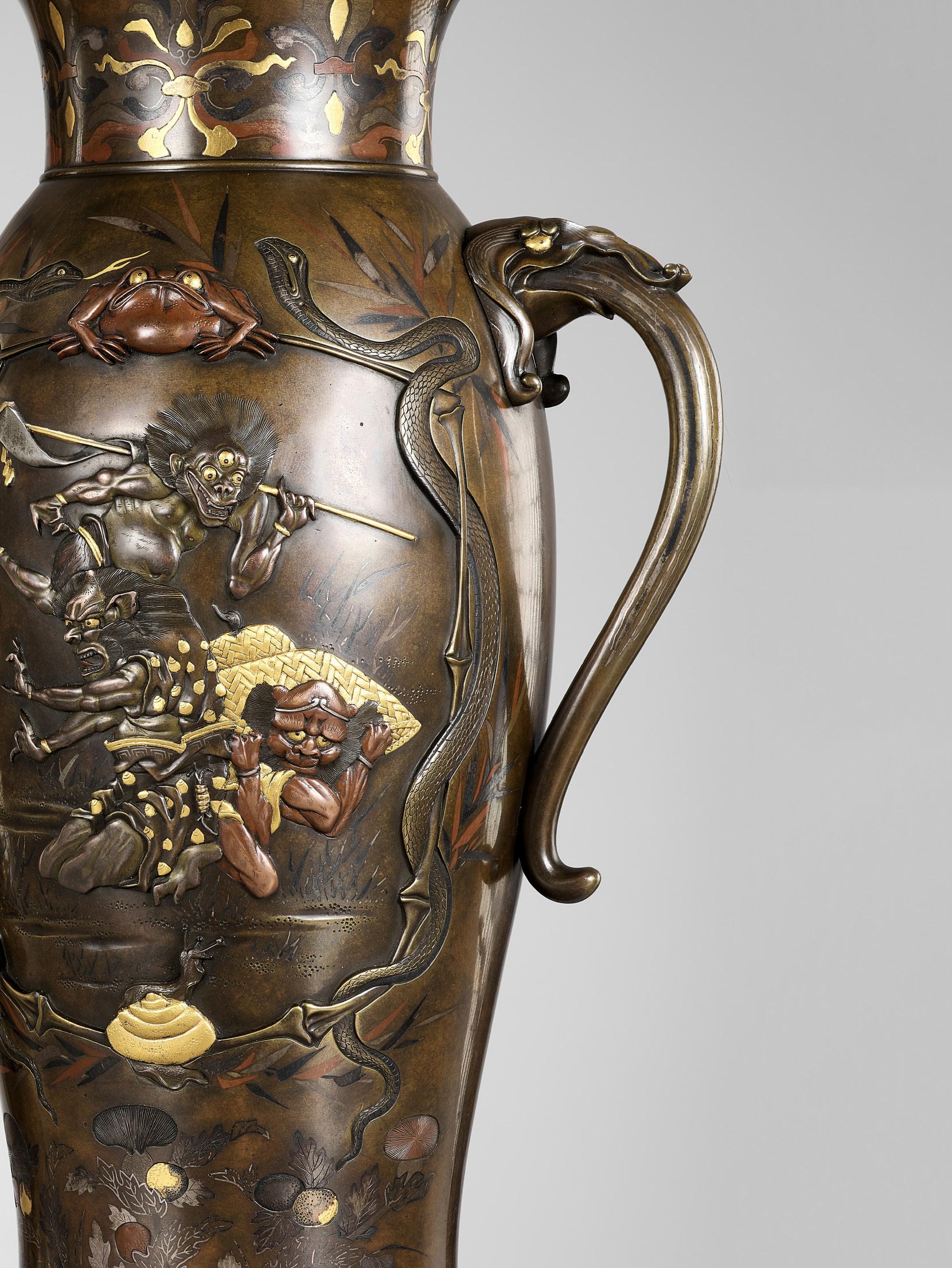
MYOCHIN MUNEYOSHI: A RARE SHIBUICHI ARTICULATED JIZAI HAKO (BOX) OKIMONO OF A CRAB
By Tanaka Tadayoshi (Myochin Muneyoshi, died 1958), signed Muneyoshi Japan, first half of 20th century
The shibuichi crab constructed of many joined segments, the eight legs, eyes and claws movable, the carapace on the top opening to reveal a silver-lined interior. Signed underneath one of the pincers MUNEYOSHI.
LENGTH 12 cm
WEIGHT 59 g
Condition: Excellent condition, minor wear.
Provenance: From a French private collection.
Tanaka Tadayoshi (died 1958), was a talented metal artist active in the Taisho and Showa periods and known for his articulated sculptures. Tadayoshi apprenticed in the Kyoto workshop of Takase Kozan (1869-1934), who directed the production of ornamental iron pieces for both domestic and international markets.
AUCTION COMPARISON
Compare a closely related jizai okimono of a crab by Tanaka Tadayoshi, signed Myochin Muneyoshi at the age of 77, at Sotheby’s, Art d’ Asie, 16 December 2015, Paris, lot 137 (sold for 8,125 EUR). Also compare a closely related small jizai okimono of a crab by Takase Kozan, measuring 5.1 cm wide, at Christie’s, Innovative Japanese Design: Art of the Meiji period, 18 November 2015, New York, lot 36 (sold for 11,250 USD).
Estimate EUR 4,000
Starting price EUR 2,000
MYOCHIN: A MASTERFUL IRON ARTICULATED JIZAI OKIMONO OF A CRAB
By a member of the Myochin family, signed Myochin Japan, 18th-19th century, Edo period (1615-1868)
The russet-iron crab masterfully constructed of numerous hammered plates jointed inside the body, the eyes, limbs, claws and legs movable, the details finely carved and chiseled, the eyes embellished with gilt.
LENGTH 26 cm
WEIGHT 282 g
Condition: The end-piece of one leg lost with an associated repair. Otherwise excellent condition with minor wear.
Provenance: From a Swiss private collection.
The art of creating lifelike figures of animals in metal, known as jizai okimono, which developed during the Edo period, is an example of outstanding Japanese craftsmanship. Meticulously constructed with hammered plates of iron, these articulated figures were greatly sought after for decorative use. They were placed in alcoves alongside pieces of porcelain, pottery and hanging scrolls, and were the object of entertainment and discussion.
Popular subjects for jizai okimono included insects, fish, crustaceans, and even dragons. This articulated crab is an outstanding example of such objects and was made by the famous Myochin family workshop, renowned for its production of Samurai armor, especially helmets and highly decorative embossed plate iron cuirasses.
AUCTION COMPARISON
Compare a closely related articulated iron okimono of a crab, unsigned and measuring 38.4 cm, at Christie’s, An Inquiring Mind: American Collecting of Japanese and Korean Art, 22 April 2015, New York, lot 93 (sold for 45,000 USD).






Estimate EUR 15,000
Starting price EUR 8,000
103
102



A RARE AND IMPRESSIVE IRON JIZAI OKIMONO OF A HAWK
Japan, late 19th century, Meiji period (1868-1912)
Naturalistically rendered, the eyes inlaid in gilt with black pupils, the predatory bird perched in a portrait-like pose, the leg joints, wings, beak, and tail meticulously crafted from numerous movable segments.
LENGTH 30 cm, HEIGHT 26 cm
WEIGHT 1,234 g
Condition: Very good condition with minor wear, some expected age-related stiffness to the joints.
The art of creating lifelike figures of animals in metal, known as jizai okimono, which developed during the Edo period, is an example of outstanding Japanese craftsmanship. Meticulously constructed with hammered plates of iron, these articulated figures were greatly sought after for decorative use. They were placed in alcoves alongside pieces of porcelain, pottery and hanging scrolls, and were the object of entertainment and discussion. Popular subjects for jizai okimono included insects, fish, crustaceans, and even dragons. Jizai okimono depicting birds are extremely rare
Literature comparison: Compare with an articulated hawk by Myochin Kiyoharu in the collection of the Tokyo National Museum, illustrated by Ito Yoshiaki et al., in the NHK Exhibition Catalogue, Commemorating the 2005 World Exposition, Aichi, Japan Arts of the East and West from World Expositions, 1855-1900, Paris, Vienna and Chicago, 2004, p. 080, no. I-191; and another articulated iron hawk (unsigned), in a private collection in France, illustrated by Harada Kazutoshi, ibid., p. 058, no. 19.
AUCTION COMPARISON
Compare a related kusshin jizai okimono model of a hawk, attributed to Itao Shinjiro, dated circa 1894, 29 cm high, at Bonhams, Fine Japanese Art, 16 May 2013, London, lot 563 (sold for 121,250 GBP). Compare to a closely related iron jizai okimono of a hawk, measuring 23 cm, sold at Woolley & Wallis, Japanese Works of Art, 27 July 2021, Salisbury, lot 358 (sold for 43,000 GBP).




Estimate EUR 40,000
Starting price EUR 20,000
135 104
SHOUN: A LARGE BRONZE OKIMONO OF BOTAN SHISHI
By Yamaguchi Shoun, signed Shoun Japan, Meiji period (1868-1912)
Massively cast, the bronze patinated to a deep-black finish, depicting a shishi with finely incised curling mane and bushy tail, playfully snarling and holding a blooming peony (botan) flower in its mouth. Incised to the lower back with the two-character signature SHOUN.

LENGTH 43 cm
WEIGHT 10 kg
Condition: Very good condition with minor wear, minimal casting flaws, few minuscule nicks, occasional light surface scratches.
Estimate EUR 2,000
Starting price EUR 1,000
105
A MASSIVE BRONZE KORO (CENSER) OF JUROJIN SEATED ON A DEER

Japan, late 19th century, late Edo period (1615-1868) to early Meiji period (1868-1912)
Massively cast as the lucky god Jurojin seated on his deer familiar, the deer with large separately cast antlers, the lucky god holding a tama in one hand, his face with a jolly expression framed by pendulous earlobes and with a long, neatly incised beard. The deer’s saddle cloth is carved in relief with a sinuous rain dragon. The bronze patinated to a deep-black finish and bearing a fine, unctuous patina.
LENGTH 63 cm
WEIGHT 14 kg
Condition: Very good condition with minor wear, minimal casting flaws, few minuscule nicks, occasional light surface scratches, few tiny dents.
Estimate EUR 3,000
Starting price EUR 1,500
106
HIDEMITSU: A LARGE AND IMPRESSIVE BRONZE BOWL WITH TWO DRAGONS
 By Hidemitsu (Shuko), signed Hidemitsu kansei Japan, Meiji period (1868-1912)
By Hidemitsu (Shuko), signed Hidemitsu kansei Japan, Meiji period (1868-1912)
The large revolving bowl with deep rounded sides rising to a galleried twelve-sided rim decorated with pierced diapered manji designs, surmounted by two ferocious dragons with sharp claws, finely incised scales, ridged spines, long horns, and spiked manes, the larger dragon with a small rock crystal tama clutched in its claws, the exterior carved with crashing waves, all supported on a large separately cast base with finely cast and openworked crashing waves, the top of the base cast in the center with the signature HIDEMITSU kansei.
HEIGHT 49.5 cm, WIDTH 45 cm
WEIGHT 23.9 kg
Condition: Good condition with minor wear, few minuscule nicks, one beard hair of the larger dragon with a minor old repair.
Estimate EUR 8,000
Starting price EUR 4,000
138
107
A MASSIVE BRONZE VASE WITH DRAGONS

Japan, Meiji period (1868-1912)
A massively cast and unusually large bronze vase of baluster shape, the shoulder carved with a concentric band of swirls in relief, further decorated with two sinuously writhing celestial dragons bending around the body, worked in increasingly higher relief, appearing like they are emerging from the vessel, the scales and other details very finely incised.
HEIGHT 72 cm
WEIGHT 27.9 kg
Condition: Very good condition with minor general wear and casting flaws. Repair to one hand and a loss to one whisker. The inset base ring possibly added. Presents beautifully.
Provenance: A private collection in Massachusetts, USA. Remnants of an old label to the interior.
Estimate EUR 8,000
Starting price EUR 4,000
108
109
SHOKAKEN EISHUN: A BRONZE FIGURE OF AMIDA NYORAI AFTER THE GREAT BUDDHA OF KAMAKURA
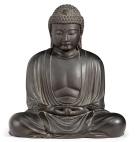 By Shokaken Eishun, signed Shokaken Eishun Japan, early 20th century, Meiji (1868-1912) to Taisho period (1912-1926)
By Shokaken Eishun, signed Shokaken Eishun Japan, early 20th century, Meiji (1868-1912) to Taisho period (1912-1926)
Well cast seated in dhyanasana, the hands lowered above his lap and joined in mida no jouin (dhyana mudra), wearing a loose-fitting robe opening at the chest and cascading in voluminous folds, his serene face with heavy-lidded downcast eyes below gently arched brows centered by a circular byakugo (urna), flanked by long pendulous earlobes, the hair arranged in tight snail-shell curls over the domed ushnisha. The base incised with the signature SHOKAKEN EISHUN.
HEIGHT 20.7 cm
WEIGHT 2,309 g
Condition: Very good condition with minor wear, casting flaws, few tiny nicks.
AUCTION COMPARISON
Compare a closely related bronze model of Amida, signed Akimine saku, also dated Meiji to Taisho period, early 20th century, 29 cm high, at Bonhams, 16 September 2014, New York, lot 2186 (sold for 8,750 USD).


Estimate EUR 2,000
Starting price EUR 1,000
110 GENRYUSAI SEIYA: A FINE AND LARGE BRONZE OF A BEAUTY
By Genryusai Seiya,
Finely cast as a young beauty with well-crafted garment folds and sensitive expression, carrying a double gourd by her side, the details superbly worked, the composition set on a shaped base. Signed underneath SEIYA.
HEIGHT 39.8 cm
WEIGHT 5,336 g
Condition: Condition: Very good condition with minor wear and few light surface scratches and casting irregularities. Fine, unctuous patina.
Genryusai Seiya was a master craftsman in charge of a workshop specializing in export wares of the highest quality.
Estimate EUR 1,500
Starting price EUR 800
140
signed Seiya Japan, Meiji period (1868-1912)
111
A MASSIVE BRONZE KORO (CENSER) DEPICTING THE STORY OF SHIBA ONKO
Japan, late 19th century, late Edo period (1615-1868) to early Meiji period (1868-1912)
A large, massively cast, and superbly detailed bronze censer showing the legendary Han Dynasty hero Shiba Onko smashing a large pot which stands on a rock, cascades of water pouring out from the hole, his companion looking on beside him. The censer stands on a rectangular base with four lobed feet, the base decorated with rinzu and reishi motifs.
HEIGHT 52 cm
WEIGHT 13.7 kg
Condition: Very good condition with minor wear, minimal casting flaws, few minuscule nicks, occasional light surface scratches.
Provenance: A Danish private collection, purchased from Bruun Rasmussen, 27 January 2011, lot 1545.
AUCTION COMPARISON
Compare a related bronze jar depicting the story of Shiba Onko at Bonhams, Fine Japanese Art, 11 May 2010, London, lot 440 (sold for 3,600 GBP).



Estimate EUR 3,000
Starting price EUR 1,500
141

112
ATSUYOSHI FOR THE MARUKI COMPANY: A MASTERFUL BRONZE ‘PORTRAIT’ OKIMONO OF A BATHING NUDE
 By Miyabe Atsuyoshi
By Miyabe Atsuyoshi
Well cast and with finely incised details, depicting a Japanese maiden reclining on a rocky bank, lifting the cloth beneath her with her left hand, her right elbow resting on an elevated section of the rockwork base incised with the signature ATSUYOSHI saku with a raised seal MARUKI sei [made by Atsuyoshi for the Maruki Company].
LENGTH 20.3 cm, HEIGHT 17 cm
WEIGHT 2,348 g
Condition: Excellent condition with minor wear and minimal casting irregularities.
Provenance: From a French private collection.
Auction comparison: Compare a bronze okimono of a striding horse by Miyabe Atsuyoshi for the Maruki Company at Galerie Zacke, 20 January 2023, Vienna, lot 1099 (sold for 6,500 EUR).
Estimate EUR 4,000
Starting price EUR 2,000
143
for the Maruki Company, signed Atsuyoshi saku, Maruki sei Japan, Meiji period (1868-1912)

KIYOAKI: A SUPERB BRONZE OKIMONO OF TWO DUCKS SWIMMING IN WATER

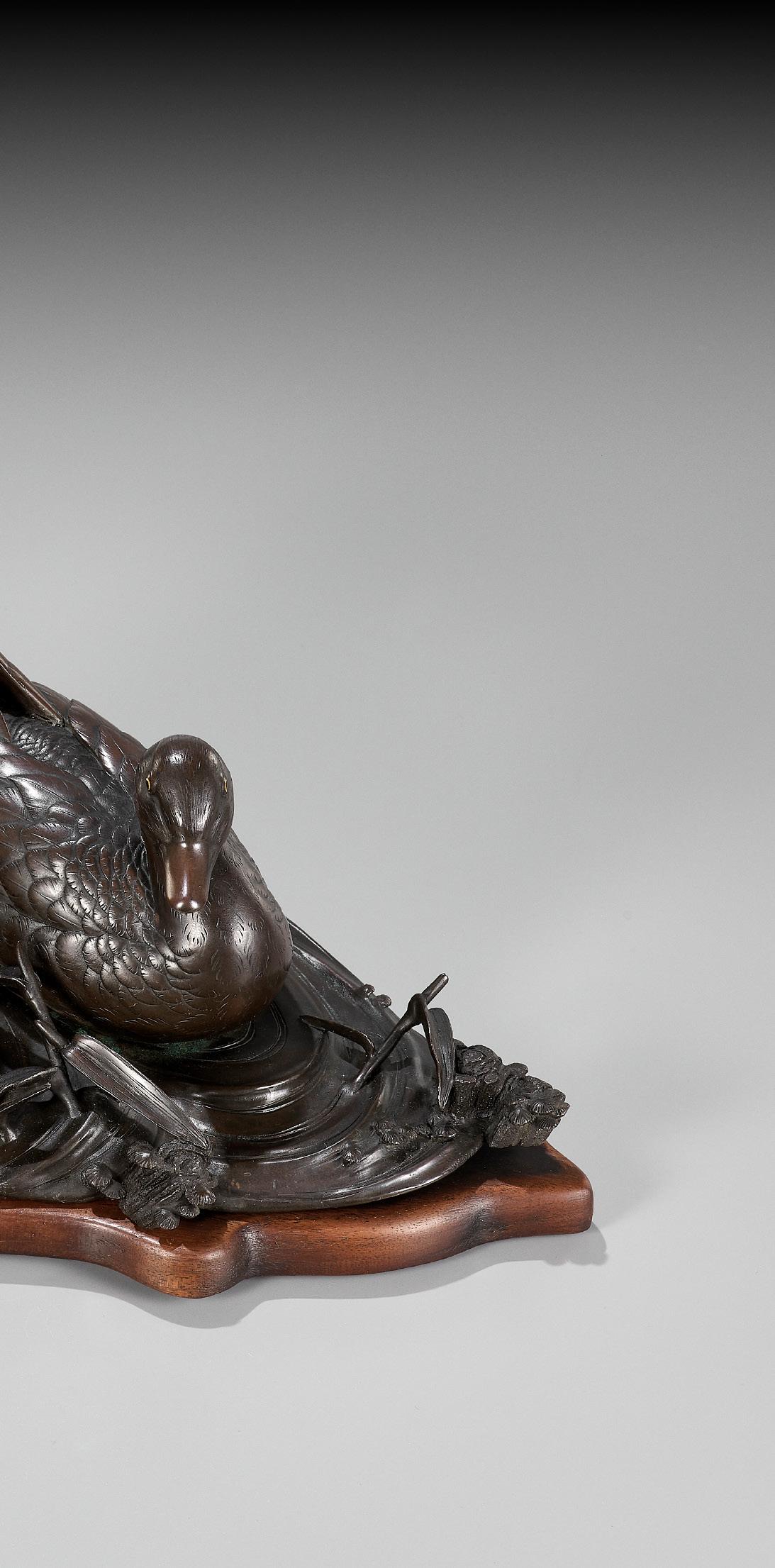 By Kiyoaki (Seimei), signed Kiyoaki saku Japan, Meiji period (1868-1912)
By Kiyoaki (Seimei), signed Kiyoaki saku Japan, Meiji period (1868-1912)
An elegant and beautifully crafted okimono depicting two ducks swimming in water, the water portrayed by subtly engraved lines and slightly elevated areas. The plumage of the birds is superbly incised, and the eyes are inlaid in goldringed shakudo. A few aquatic plants and reeds are shown emerging from the water. Signed to the underside KIYOAKI saku [made by Kiyoaki].
LENGTH 38.3 cm (the okimono), LENGTH 39.8 cm (with base)
WEIGHT (excluding base) 2.7 kg
Condition: Excellent condition with only very minor wear.
With a shaped hardwood base.
Estimate EUR 8,000
Starting price EUR 4,000
145
113

114
GENRYUSAI SEIYA: A VERY LARGE AND IMPRESSIVE BRONZE OKIMONO OF AN EAGLE
By
Genryusai Seiya, signed Genryusai Seiya zo Japan, Meiji period (1868-1912)
Superbly cast, the majestic eagle perched on a separately cast rocky outcrop above swirling and crashing waves, the smooth water and roughly textured rock creating a striking contrast, the eagle with intricately incised plumage, the wings spread out as the bird is about to take flight, its eyes in shakudo with gilt-ringed pupils, the strong beak elegantly curved, signed underneath within a square reserve GENRYUSAI SEIYA zo [Made by Genryusai Seiya].
HEIGHT 83.7 cm (incl. base), WIDTH 93.7 cm (the wingspan)
WEIGHT 36.7 kg
Condition: Very good condition, minor wear and casting flaws as are to be expected.
Provenance: Austrian private collection.
Genryusai Seiya was a master craftsman in charge of a workshop specializing in export wares of the highest quality. Production included human genre figures, vases and exotic bronze models of animals probably influenced by the opening of Tokyo Zoological Gardens in 1882. The present piece is a brilliant example of Seiya’s naturalistic bronzes.
AUCTION COMPARISON
Compare a closely related bronze model of an eagle by Genryusai Seiya, 92.2 cm wide, with a gnarled wood stand as opposed to the bronze base of the present lot, at Christie’s, Japanese and Korean Art, 22 March 2001, lot 226 (sold for 17,625 USD).


Estimate EUR 10,000
Starting price EUR 5,000
147
MASATSUNE: A SUPERB AND LARGE BRONZE OKIMONO OF A HAWK ON ROOTWOOD BASE

 By Masatsune, signed Masatsune chu Japan, Meiji period (1868-1912)
By Masatsune, signed Masatsune chu Japan, Meiji period (1868-1912)
The majestic bird superbly cast with neatly detailed plumage, its wings folded back and its body leaning forwards, the details picked out in gilt and shakudo, the bird set on a large and naturalistically carved root wood base. Signed within a rectangular reserve underneath MASATSUNE chu [made by Masatsune]. The artist was particularly well known for the quality of his productions of birds.
HEIGHT total 82 cm, HEIGHT hawk 28 cm, LENGTH hawk 40 cm
WEIGHT hawk 6,956 g
Condition: Good condition with minor casting irregularities, few tiny nicks, light surface scratches. The right leg has been restored.
Provenance: From an old French private collection.
AUCTION COMPARISON
Compare a closely related bronze okimono of a hawk depicted in a similar position, by Masatsune and set on a lacquered wood perch, at Bonhams, Fine Japanese and Korean Art, including the Crawford Collection of Surimono, 22 September 2021, New York, lot 1055 (sold for 16,562 USD). Also compare another closely related model of an eagle depicted in a similar position, by Masatsune and set on a bronze base, at Christie’s. The Meiji Aesthetic: Selected Masterpieces from a Private Asian Collection, 27 November 2018, Hong Kong, lot 3841 (sold for 275,000 HKD).

Estimate EUR 10,000
Starting price EUR 5,000
148 115

A FINE BRONZE OKIMONO OF A HERON
Japan, Meiji period (1868-1912)
Finely modeled as a standing heron, the legs and feet finely textured, the wings and plumage neatly incised, the eyes gilt with incised pupils, the bird further detailed with sinuous neck and long beak and crest, the bronze patinated to a coppery tone.


HEIGHT 25.6 cm (excl. base) and 28.2 cm (incl. base)
WEIGHT 1,767 g
Condition: Excellent condition with minor wear and casting irregularities.
Mounted on a black-lacquered wood base.
AUCTION COMPARISON
Compare a closely related bronze okimono of a heron at Zacke, Fine Japanese Art, 4 June 2021, Vienna, lot 10 (sold for 5,056 EUR).
Estimate EUR 3,000
Starting price EUR 1,500
116
The ungulate slowly walking ahead with the head lowered, the ears pricked and eyes open in an alert expression, the fur neatly yet sparingly incised, the animal further detailed with a short tail, the belly incised with the signature YOSHIMITSU.

LENGTH 28.5 cm
WEIGHT 2,675 g
Condition: Very good condition with minor wear, casting irregularities, light surface scratches.
Estimate EUR 2,000
Starting price EUR 1,000
151
117
YOSHIMITSU: A FINE BRONZE OKIMONO OF A DOE
By Yoshimitsu, signed Yoshimitsu Japan, Meiji period (1868-1912)
AKICHIKA: A FINE BRONZE VASE WITH LIZARD PREYING ON A FROG


The baluster-shaped bronze vase with a circular foot ring, long neck, and flaring rim, patinated to an attractive brown finish with striking mottled streaks of red, carved in relief around the neck with a lizard eyeing a small frog carved to the body of the vase. The details finely worked; the eyes of the lizard are gilt. Signed to the underside AKICHIKA with the characteristic ‘dragonfly’ seal.
HEIGHT 24.9 cm
WEIGHT 1,317 g
Condition: Very good condition with minor wear and few light surface scratches and casting irregularities.
Provenance: Old Parisian private collection.
AUCTION COMPARISON
Compare a closely related bronze vase with a similar design, also signed Akichika and with butterfly seal, at Christie’s, Japanese & Korean Art including Arts of the Meiji Period, 15 September 2010, New York, lot 618 (sold for 8,750 USD).
Estimate EUR 4,000
Starting price EUR 2,000

152 118
By Akichika, signed Akichika with dragonfly seal Japan, Meiji period (1868-1912)
A FINE BRONZE VASE DEPICTING SPARROWS AND BAMBOO
 Signed Narikane Japan, Meiji period (1868-1912)
Signed Narikane Japan, Meiji period (1868-1912)
Of baluster-shape, the bronze vase attractively patinated to a dark reddish-brown finish, finely worked in relief with neatly incised details depicting two sparrows on a leafy branch of bamboo, one grooming the other with its beak. Signed to the underside NARIKANE.
HEIGHT 29.2 cm
WEIGHT 2,055 g
Condition: Very good condition with minor wear and few light surface scratches and casting irregularities.
Provenance: Old Parisian private collection.
Estimate EUR 2,500
Starting price EUR 1,200
153 119
120
HIDEMITSU: A SUPERB AND LARGE BRONZE VASE DEPICTING HERONS AND LOTUS
 By Hidemitsu (Shuko), signed Hidemitsu sei Japan, Tokyo, late 19th century, Meiji period
By Hidemitsu (Shuko), signed Hidemitsu sei Japan, Tokyo, late 19th century, Meiji period
(1868-1912)
The pear-shaped body supported on a waisted foot and rising to a slender octagonal neck with a flared rim, the body superbly cast in relief with a group of seven herons with long beaks and gilt-ringed shakudo eyes perched amid lotus leaves executed in shallow relief which displays a particularly fine, almost misty quality. The other side of the vase is similarly cast with a hanging lotus leaf and a rising lotus pod. The bronze patinated to a warm coppery tone. The base cast HIDEMITSU sei [made by Hidemitsu].
HEIGHT 45.5 cm
WEIGHT 4,374 g
Condition: Very good condition with some wear and minor casting flaws.
Estimate EUR 3,000
Starting price EUR 1,500
KOITSU: A FINE AND LARGE NOGAWA COMPANY INLAID BRONZE VASE WITH A LONG-TAILED ROOSTER AND CHERRY BLOSSOMS


By Koitsu for the Nogawa company, signed Koitsu and with Nogawa company mark Japan, late 19th century, Meiji period (1868-1912)
The tall baluster-shaped bronze vase masterfully inlaid in iroe-e takazogan of rich silver, gold and copper, the details engraved in katakiri-bori, depicting a long-tailed rooster (onagadori) perched on a beautifully blossoming sakura tree. Incised signature KOITSU to the side and with the Nogawa company mark underneath.
HEIGHT 36 cm
WEIGHT 3,187 g
Condition: Excellent condition with minor wear.
Founded in Kyoto in 1825, during the Meiji era the Nogawa Company developed into a commissioning house that showed at major international expositions between 1893 and 1910 as well as at the Naikoku Kangyo Hakurankai (Domestic Industrial Promotion Exhibitions) in 1881 and 1890. The company had a popular store that was on the “mustsee” list for international globetrotters, as well as showrooms in the Kyoto and Miyako Hotels.
AUCTION COMPARISON
Compare a related Nogawa company vase of similar size bearing a different design at Zacke, Fine Japanese Art, 2 December 2022, Vienna, lot 62 (sold for 13,000 EUR).
Estimate EUR 4,000
Starting price EUR 2,000
121
OHASHI SAN’EMON: A MASTERFUL PAIR OF BRONZE TAKAOKA SHO-FORM KORO (INCENSE BURNERS)
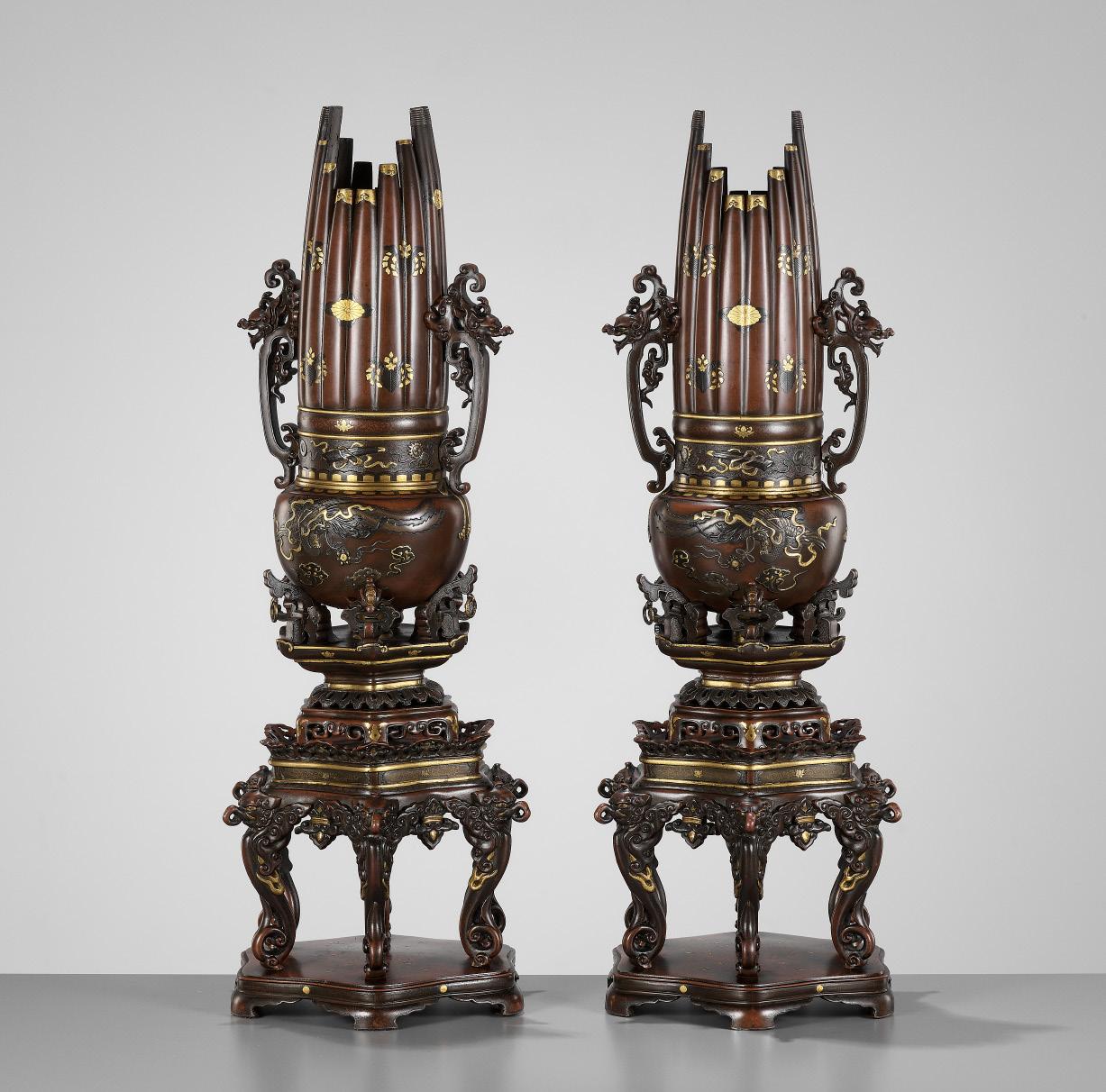
By Ohashi San’emon (Sanzaemon, 1851-1895), signed Dai Nihon Teikoku Toyama Ken Takaoka Shi Ohashi San’emon seizo Japan, Takaoka, late 19th century, Meiji period (1868-1912)
Each censer multi-tiered and set on a hexagonal base surmounted by six flared feet formed as baku. An open-worked structure with six roof tiles showing various beast masks, ho-o and shachihoko (dragonfish) supports the large container for incense in the shape of a sho (Buddhist reed instrument) with dragon handles and further decorated in masterful iro-e takazogan as well as shakudo and gold hirazogan with ho-o birds, various instruments and monemblems.
Each with an incised inscription and signature to the base: Dai Nihon Teikoku Toyama ken Takaoka Shi OHASHI SAN’ EMON seizo [Made by Ohashi San’emon, Takaoka City, Toyama Prefecture, Great Imperial Japan].
HEIGHT each 49 cm
WEIGHT 7,333 g & 7,565 g
Condition: Very good condition with minor wear and traces of use. Provenance: Private collection in Massachusetts, Boston.
Ohashi San’emon was born in 1851 and died in 1895, his most active period was between 1875-1895 and his contemporary metal artists were Kakuha Kanzaemon IX (Kakuha Zenjiro), Yokoyama Yazaemon II (1845-1903) and Kanamori Soshichi (1821-1892), who were pioneering doki (Japanese bronze ware) based in Takaoka, Etchu Province and Kaga Province, present-day Toyama and Ishikawa prefectures. They made many fine bronze items for domestic and foreign exhibitions and for the oversea markets.
The history of casting copper alloys in Takaoka, the provincial capital of Etchu (present day Toyama Prefecture), is reputed to date to the early Edo period, the industry encouraged by the local feudal government as a source of income. Around 1830, new sales venues were developed, extending from Edo city to the northernmost part of the Japanese archipelago, eventually expanding to overseas export markets during the Bakumatsu era.
AUCTION COMPARISON
Compare an inlaid bronze vase by Ohashi Sanzaemon at Bonhams, Fine Japanese Art, 13 September 2017, New York, lot 1059 (sold for 16,250 USD). Also compare a pair of bronze Takaoka vases, by Yazaemon II, at Bonhams, Tradition, Travel, Transition – Japanese Art across the centuries, 4 November 2021, London, lot 139 (sold for 12,750 GBP).
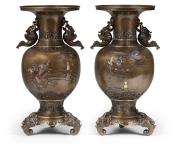

Estimate EUR 12,000
Starting price EUR 6,000
156
122

A PAIR OF SUPERB TAKAOKA
GOLD-INLAID BRONZE ‘MYTHICAL BEASTS’ KORO (INCENSE BURNERS) AND COVERS
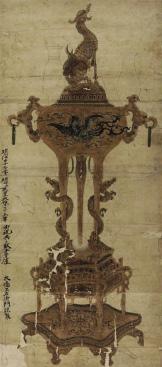

Attributed to Ohashi San’emon (Sanzaemon, 1851-1895), unsigned Japan, Takaoka, late 19th century, Meiji period (1868-1912)
Finely decorated in gold, silver, and shakudo takazogan, each censer of compressed globular form, inlaid to one side with a winged mythical beast chasing a ribboned vase and to the other with a ribboned vase flanked by a fan and a reishi cloud, the shoulder applied with baku-form handles suspending loose gold rings, the domed cover decorated with gold-inlaid swirling clouds above a lappet border and surmounted by a baying kirin, raised on three elongated legs encircled by three-clawed dragons and centered by a gold tama, above an elaborately cast and openworked tiered hexagonal base.
HEIGHT 38 cm and 37.5 cm
WEIGHT 2,802 and 2,816 g
Condition: Very good condition with minor wear and few minuscule nicks.
The history of casting copper alloys in Takaoka, the provincial capital of Etchu (present day Toyama Prefecture), is reputed to date
to the early Edo period, the industry encouraged by the local feudal government as a source of income. Around 1830, new sales venues were developed, extending from Edo city to the northern-most part of the Japanese archipelago, eventually expanding to overseas export markets during the Bakumatsu era.
Estimate EUR 8,000
Starting price EUR 4,000
Compare the design of the present koro to a drawing of a koro made by Ohashi San’emon in Meiji 27 (1894) to celebrate the 25th year wedding anniversary for the Meiji Emperor.
158 123
CHOMIN: A SUPERB PAIR OF INLAID BRONZE VASES WITH MINOGAME AND GEESE
 By Chomin (Nagatami), signed Chomin Japan, late 19th century, Meiji period (1868-1912)
By Chomin (Nagatami), signed Chomin Japan, late 19th century, Meiji period (1868-1912)
Each of ovoid form, supported on a short spreading foot and rising to a waisted neck with everted rim, decorated with fine incision work as well as masterfully executed flat and relief inlays in gold and silver takazogan. One vase depicts a minogame on a rocky outcrop below the full moon partly obscured by swirling clouds, a small turtle below the majestic thousand-year-tortoise. The other vase depicts three geese descending from the sky above trees and bamboo leaves, the reverse with swirling clouds. The base of each with a rectangular silver reserve incised with the signature CHOMIN.
HEIGHT 29 cm and 28.9 cm
WEIGHT 2,418 g and 2,220 g
Condition: Excellent condition with minor wear.
Takahashi Ryoun lived in Tokyo and was active from the late Meiji period into the early Showa period. He graduated from the Tokyo School of Fine Arts and was famed for his skill in bronze casting. The Tokyo Casting Association lists him as a designated special member, a ranking reserved only for the best artists. He exhibited his works at the Paris Great Exposition in 1900: three pieces were entered in the Exhibition Catalogue Two (Q 107, 161, 175), and one piece was exhibited in the Award Winning Catalogue. His work can be found in the Museum of the Japanese Imperial Collections (Sannomaru Shozo-kan) in Tokyo.
Estimate EUR 8,000
Starting price EUR 4,000
159 124
A TALL AND IMPRESSIVE PARCEL GILT BRONZE KORO (INCENSE BURNER) AND COVER, ATTRIBUTED TO THE MIYAO COMPANY
Japan, Meiji period (1868-1912)
The koro of rounded square form, fitted with a metal inset, the sides with two shaped panels in gold, copper, and shakudo takazogan to depict a rakan and oni conversing, the arhat wearing loose robes and holding a small figure of Kannon while the demon holds a staff, the reverse panel depicting pheasants and peony, the body cast with raised floral diaper and foliate designs against an archaistic scroll ground and flanked by two scrolling cloud-form handles. The cover similarly cast and surmounted by a boy wearing a gold-inlaid robe decorated with clouds and flowers, standing in a dynamic pose beside a red-capped crane with silvered body and plumage. The vessel is supported on four long legs issuing from fierce dragon heads atop a tiered base which is crisply cast with stylized butterflies surrounding a ho-o bird against a diapered ground, a superbly patinated and gold-inlaid figure of Kannon wearing a long flowing robe with deeply incised folds standing atop the base which is raised on four short feet decorated with goldinlaid ho-o birds. Unsigned, however confidently attributed to the Miyao company of Yokohama.

HEIGHT 91 cm
WEIGHT 14.6 kg
Condition: Very good condition with minor wear, minimal casting flaws, few minuscule nicks, occasional light surface scratches.
Founded by Miyao Eisuke, the Miyao Company of Yokohama specialized in the manufacture of bronze sculptures, embellished with gold and silver as well as patinated copper alloys, that represent generic samurai warriors as well as more precisely identifiable characters from Japanese myth and legend. In addition, the company also made a smaller number of pieces in other formats such as incense burners, vases, and chargers.
AUCTION COMPARISON
Compare a related parcel gilt bronze censer, measuring 44.5 cm, also with rakan and oni motif and by the Miyao company, sold at Zacke, Fine Japanese Art, 4 June 2021, Vienna, lot 6 (sold for 17,696 EUR).

Estimate EUR 12,000
Starting price EUR 6,000
160 125

MIYAO: A PARCEL-GILT BRONZE FIGURE OF A WARRIOR
By the Miyao company of Yokohama, signed Miyao with seal Ei Japan, late 19th century, Meiji period (1868-1912)
Finely modeled standing in a dynamic pose with one foot lunged forward, brandishing a spear (yari) above his head. The warrior is dressed in elaborately patterned robes with foliate designs, crashing waves, flying sparrows, and the musubi karigane mon (wild goose crest), and wearing typical armor. Two swords are attached to his belt. The man’s face is well detailed with bushy brows and mustache as well as intense eyes. The back of his billowing robe with a rectangular reserve signed in raised characters MIYAO with the seal EI.
HEIGHT 16.7 cm (excl. stand) and 20.8 cm (incl. stand)
WEIGHT 1,020 g
Condition: Very good condition with minor surface wear, the spear with a loss to the tip.
The figure is mounted on the original wood stand with gold-lacquered foliate designs.
Founded by Miyao Eisuke, the Miyao Company of Yokohama (later based in Nihonbashi-ku, Tokyo, after ca. 1890) specialized in the manufacture of bronze sculptures, embellished with gold and silver as well as patinated copper alloys, that represent generic samurai warriors as well as more precisely identifiable characters from Japanese myth and legend. In addition, the company also made a smaller number of pieces in other formats such as incense burners, vases, and chargers.
Estimate EUR 2,000
Starting price EUR 1,000
127
YOSHIMITSU: A BRONZE
FIGURE OF AN ARCHER
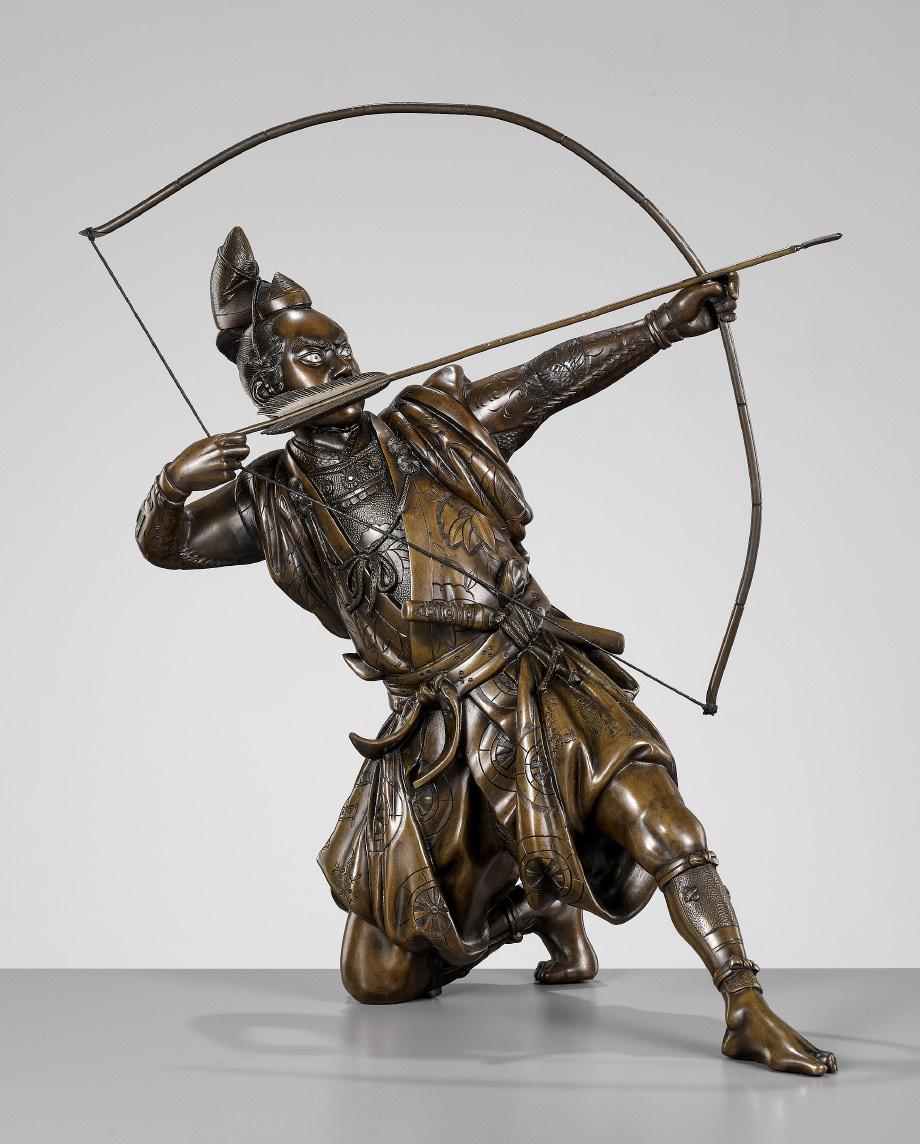
By Yoshimitsu, signed Yoshimitsu Japan, Meiji period (1868-1912)
The figure shown in a wide back-leaning stance with his bow drawn and arrow notched, the archer preparing to shoot at his target, supporting himself on one knee as the other one is fully outstretched, a wakizashi tucked under his belt, the bow and arrow crafted separately. His robes are neatly incised and finely engraved with linked shippo-crests and wheel roundels as well as clouds, young bamboo, and bird crests. The back with a rectangular reserve incised with the signature YOSHIMITSU.
HEIGHT 28 cm (excl. bow) and 33.1 cm (incl. bow)
WEIGHT 3,720 g
Condition: Very good condition with minor surface wear.
Provenance: Ex-collection Dr. Heinrich Dirksen (1861-1935), thence by descent in the same family.
AUCTION COMPARISON
Compare a related patinated bronze figure of an archer signed Miyao, 28 cm high, at Christie’s, 10 December 2020, Paris, lot 69 (sold for 8,750 EUR).


Estimate EUR 4,000
Starting price EUR 2,000
126
128
A BRONZE FIGURE OF A SAMURAI LIFTING A GONG
Japan, Meiji period (1868-1912)
Finely modeled standing with legs abreast, the torso turned to one side and the face with a ferocious expression looking up towards a bell supported on a circular tray held in his raised right hand, the gong incised with a writhing dragon, the warrior’s other hand holding a naginata lowered at his side, his armor and robe decorated with fierce oni as well as floral crests and cartwheels amid clouds.
HEIGHT 44 cm (the figure excl. base and bowl) and 65 cm (total)
WEIGHT 6.8 kg
Condition: Very good condition with minor wear, casting irregularities, few small nicks, minor dents.
Provenance: From an old Swiss private collection, thence by descent in the same family.
AUCTION COMPARISON
Compare a related bronze figure of a samurai holding aloft a gong, 65 cm high, at Bonhams, 6 November 2007, London, lot 391 (sold for 3,360 GBP).
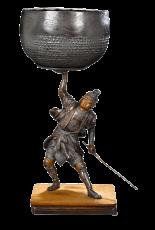

Estimate EUR 4,000
Starting price EUR 2,000
129
A SUPERB PAIR OF MIYAO-STYLE MIXED-METAL-INLAID AND PARCEL-GILT BRONZE VASES WITH SHOKI AND ONI

Japan, late 19th century, Meiji period (1868-1912)
Each vase with a baluster body supported on a spreading foot and rising to a gently waisted neck with flat everted rim, the shoulder with two long handles issued from baku heads, the exterior carved in high and sunken (shishiaibori) relief, inlaid in iro-e takazogan and hirazogan, and engraved in katakiri and kebori, with bambooframed panels surrounded by two snakes flanking a toad above and a snail below – an impressive example of the sansukumi motif. Each panel shows a different but complementary design, depicting on one vase a proudly standing Shoki holding his sword in one hand and extending the other, with a long-tailed pheasant amid chrysanthemums under a gnarled pine tree to the back; and on the other three oni depicted in different attitudes, one of them fighting back against the demon queller, the back with two long-tailed pheasants perched on a craggy rock. The body is further decorated with bamboo leaves, mushrooms, and leaves, the neck and foot with formalized bands.
HEIGHT each 30.5 cm
WEIGHT each 4.7 kg
Condition: Very good condition with minor surface wear. Provenance: From the private collection of an intrepid and seasoned connoisseur who tirelessly travels the globe and acquires with passion, discernment and above all a sense of all-embracing eclecticism, bound by no rigid formula of what should constitute a worthy object save the admiration and wonder that it can produce in the viewer.
The present pair of vases, impressively cast, finely carved in high and sunken relief, and masterfully inlaid in both hirazogan and takazogan, was clearly made by an extremely talented metalworker. The inspired use of inlays makes an attribution to the workshop of Miyao Eisuke reasonable. Although most often associated with large-scale bronze figures of samurai, the Miyao Company also manufactured or dealt in a wide range of craft goods including Shibayama-work panels and ivory figures. Apparently based first in Yokohama and then, after about 1890, in Nihonbashi-ku, Tokyo, the company is first recorded at the second Naikoku Kangyo Hakurankai (National Industrial Exposition) where Miyao Eisuke collaborated with the bronze caster Momose Sozaemon in the production of a bronze figure of seven drunken shojo.
Estimate EUR 12,000
Starting price EUR 6,000
164

A SUPERB KOMAI-STYLE GOLD AND SILVER INLAID BRONZE VASE WITH MONKEYS

Japan, Meiji period (1868-1912)
Of baluster form, supported on a spreading foot with slightly concave base, the straight shoulder surmounted by the shortwaisted neck and galleried rim. Finely decorated in gold and silver nunomezogan and takazogan with two shaped panels enclosing numerous monkeys huddled together in various poses, some constituting the sambiki saru motif, also referred to as the three wise monkeys, using their hands to cover their own or each other’s ears, eyes, or mouth, the simians further well detailed with finely incised fur and gold eyes. The panels are reserved against a silverinlaid ground of various brocade patterns, above stylized waves and dew drops at the foot, and below foliate scroll and chrysanthemum flowerheads to the shoulder, finely engraved clouds to the neck, and a silver-inlaid key-fret band around the rim.
HEIGHT 16 cm
WEIGHT 467 g
Condition: Very good condition with minor wear and few tiny nicks. Provenance: From a private collection in southern Germany, acquired before 2007.
The present vases are decorated in the manner of the famous Komai workshop of Kyoto. The Komai workshop is believed to have been founded in 1841, but it was only when Komai Otojiro I became its head, in 1865, that the company began to make the wares for which they were to become so famous. The workshop, under his leadership specialized in intricate inlaid work of gold and silver into iron. In a promotional brochure of about 1915 his son, Komai Otojiro II (his father having retired in 1906) called his workshop the ‘pioneer of damascene work’ and describes the process of the lacquering of the characteristic black ground, which required kiln firing and burnishing. The Komai style developed with an increasingly pictorial central motif on a background of both geometric patterns and free illustrations of nature, life, and landscapes with elaborate repeating borders. Most of these central motifs illustrate stories from Japanese history or mythology, and the Komai family retains a number of design books in which can be found drawings for many of their works.
Estimate EUR 6,000
Starting price EUR 3,000
166 130
131
MORIGUCHI: A PAIR OF KOMAI-STYLE DAMASCENED IRON VASES
By the Moriguchi workshop, each signed Moriguchi Japan, Kyoto, Meiji period (1868-1912)
Each of baluster form, supported on a spreading foot and rising to a short waisted neck with galleried rim, finely decorated in gold and silver nunomezogan and takazogan with two shaped panels, one of a landscape with rustic dwellings, reversed by a bird amid blossoms, all on a silver diaper-patterned ground below a cloudcollar of fruiting grape vines on the shoulder, further geometricpatterned bands on the neck, rim, and foot, the recessed base with the silver-inlaid signature MORIGUCHI.
HEIGHT 13.6 cm (each)
WEIGHT 221 & 235 g
Condition: Very good condition with minor surface wear and manufacturing irregularities.
Provenance: From a Danish private collection.
AUCTION COMPARISON
Compare a closely related pair of inlaid-iron vases signed Moriguchi, dated late 19th century, Meiji period, 13 cm high, at Christie’s, 23 March 2011, New York, lot 749 (sold for 8,750 USD). Compare a closely related pair of damascened iron vases signed Moriguchi, dated late 19th century, Meiji period, 14.5 cm high, at Bonhams, 19 March 2014, New York, lot 3317 (sold for 8,750 USD).




Estimate EUR 5,000
Starting price EUR 2,400
167
INOUE: A SUPERB INLAID BRONZE DISH DEPICTING BOYS ON A DRAGON BOAT
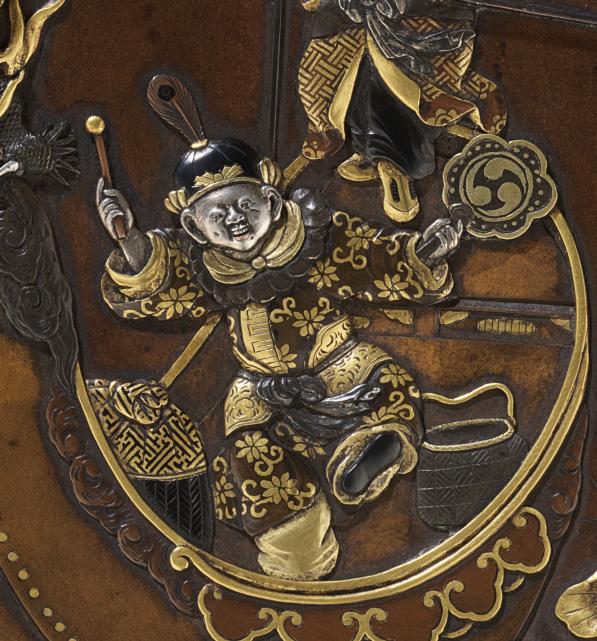

By Inoue company of Kyoto, signed Kyoto Inoue sei Japan, late 19th century, Meiji period (1868-1912)
The shallow rounded sides rising from a short spreading foot to a gold-inlaid lobed rim with a masterful Komai-style lozenge design, encircling a central medallion finely decorated in iro-e takazogan with three boys dressed in Korean festive garments and standing in a dragon boat in a lotus pond with neatly incised blossoms and furled leaves, detailed in katakiri, all below a long-tailed ho-o bird in flight. One boy is standing in the back, holding a long staff with reishi terminal, beside a flag waving in the wind, above a second boy dancing and holding a drumstick and fan, wearing a peacockfeathered hat, the third boy standing behind the large dragon head holding a trumpet in his hand, all against a rich copper-brown patinated ground. The base with the gilt signature Kyoto INOUE sei [made by Inoue of Kyoto].
DIAMETER 27.4 cm
WEIGHT 1,234 g
Condition: Very good condition with minor wear.
Estimate EUR 6,000
Starting price EUR 3,000
168 132
133
A LARGE AND IMPRESSIVE MIXED METAL DISH DEPICTING WASOBEI AND MOUNT FUJI

Japan, Meiji period (1868-1912)
The large bronze dish with raised rim neatly engraved with a cloud design, the front worked in iro-e takazogan of suaka, silver, shakudo, and gold depicting the giant Wasobei leaning against Mount Fuji with a somewhat disinterested attitude and glaring at two cranes which are flying past. The details are superbly rendered.
DIAMETER 45 cm
WEIGHT 7 kg
Condition: Very good condition with minor typical wear including some tiny nicks and light surface scratches.
Provenance: From a private collection in Chicago, USA.
The subject has also been previously identified as Daidarabotchi, a gigantic yokai in Japanese mythology, sometimes said to pose as a mountain range when sleeping.
AUCTION COMPARISON
Compare a closely related dish by Kazutoshi at Zacke, Fine Japanese Art, 2 December 2022, Vienna, lot 79 (sold for 13,000 EUR).

Estimate EUR 6,000
Starting price EUR 3,000
169
KATSUHIRO: A SUPERB MIXED METAL PLAQUE DEPICTING ARABABA AND THE YOKAI BOX
 By Suzuki Katsuhiro I (1827-1886), signed Katsuhiro with kakihan Japan, late 19th century, Meiji period (1868-1912)
By Suzuki Katsuhiro I (1827-1886), signed Katsuhiro with kakihan Japan, late 19th century, Meiji period (1868-1912)
The rounded rectangular plaque of finely polished shibuichi, worked in takazogan with highlights of silver, copper, and gold depicting Arababa after opening the treasure box, from the tale of Shitakiri Suzume (The Tongue Cut Sparrow), being attacked by three yokai, the long-necked rokurokubi in particular startling the woman. Signed to the lower right KATSUHIRO and with the artist’s gold kakihan (cursive monogram).
SIZE 12.2 x 9.4 cm
WEIGHT 105 g
Condition: Excellent condition with only very minor wear.
Suzuki Katsuhiro Dembei (1827-1886), listed in the Haynes Index of Japanese Sword Fittings and Associated Artists on pp. 577-578 (H 02766.0), was the first child of Hagiya Katsuhira and entered the Suzuki family after marriage. He worked in Mito first and then, after the ban on carrying swords, in Tokyo. A tsuba by the artist is listed in this catalog as lot no. 217.
Estimate EUR 4,000
Starting price EUR 2,000
170 134
135
SHUNGAKU: A FINE MIXED METAL KOGO (INCENSE BOX) WITH ONI YURI (TIGERLILY)
 By Shungaku, signed Shungaku koku Japan, Meiji period (1868-1912)
By Shungaku, signed Shungaku koku Japan, Meiji period (1868-1912)
Of shibuichi, the flush-fitting lid engraved and inlaid in gold and silver high relief with a single stalk of oni yuri (tigerlily), signed on the base with chiselled characters SHUNGAKU koku (carved by Shungaku).
DIAMETER 6 cm
WEIGHT 126 g
Condition: Excellent condition, minor wear.
Provenance: Belgian private collection, purchased at Bonhams, Fine Japanese Art, 11 May 2017, London, lot 398.
AUCTION COMPARISON
Compare a vase with flower design by Shungaku at Bonhams, Fine Japanese Art, 5 November 2009, London, lot 299 (sold for 3,600 GBP).

Estimate EUR 2,500
Starting price EUR 1,200
136
HATTORI: A RARE SILVER AND MIXED METAL KOGO (INCENSE BOX)

By the Hattori company, signed jungin Hattori sei Japan, c. 1933
Of circular form, the cover of shibuichi engraved with white flowers and details in gold and katakiribori, surmounted by a silver knop in the form of a pine cone, the inside of the cover inscribed around the side Shibusawa Seien-o dozo kensetsu kinen [Commemoration of the erection of a bronze statue of Mr Seien Shibusawa] the body carved in low relief with a rattan design, stamped on the base jungin HATTORI sei [pure silver, made by Hattori).
DIAMETER 8.2 cm
WEIGHT 78 g
Condition: Excellent condition, minor wear.
Provenance: Belgian private collection, purchased at Bonhams, Fine Japanese Art, 11 May 2017, London, lot 398.
Shibusawa Eiichi, 1st Viscount
Shibusawa (1840 –1931) was a Japanese industrialist widely known today as the “father of Japanese capitalism”, having introduced Western capitalism to Japan after the Meiji Restoration. In 1926 Shibusawa was nominated for the Nobel Peace Prize by the prime minister of Japan.
Statue of Shibusawa Eiichi (18401931) in Tokiwabashi Park, Tokyo, erected in 1933
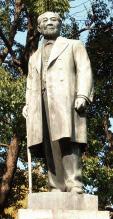
Kintaro Hattori founded the Hattori Clock and Jewelry store in 1881. The company produced and retailed luxury goods such as silverware for export and sold them in their department store in the Ginza area of Tokyo. In 1924 Hattori founded a watchmaking factory called Seiko which became the world’s largest watch manufacturer.
Estimate EUR 2,000
Starting price EUR 1,000
171
137
A SILVER IMPERIAL PRESENTATION BONBONIERRE WITH KIKUMON
Japan, 1909-1911
The silver box with overhanging cover decorated with a takazogan sixteen-petaled kikumon (Chrysanthemum Seal), the Imperial Seal of Japan.



SIZE 2.1 x 4.9 x 5.7 cm
WEIGHT 81 g
Condition: Very good condition with minor wear. Provenance: Czech private collection, with an old, inscribed label to the interior.
These types of silver bonbonnières were given as gifts by the emperor and the Imperial Family usually during special events and ceremonies. For further information on Japanese imperial silver bonbonnières see Arts of Asia Journal, Susan Tosk and David Cole, Japanese Imperial Silver Bonboninières: Elegance in the Palm of Your Hand – The Nancy and Robin Markbreiter Collection, spring 2022, no. 9.
Auction comparison: Compare to two closely related imperial silver bonbonnière at Hindman, Japanese and Korean Works of Art, 25 March 2022, Chicago, lot 14 (sold for 2,250 USD).
Estimate EUR 1,000
Starting price EUR 500
138
AN ENAMELLED SILVER IMPERIAL PRESENTATION BONBONIERRE WITH KIKUMON
Japan, early 20th century, Meiji period (1868-1912) to Taisho period (1912-1926)
The silver box with overhanging cover decorated with a takazogan sixteen-petaled kikumon (Chrysanthemum Seal), the Imperial Seal of Japan, and further enameled in green and purple shippo with two paulownia crests (kirimon) and scrolling vines.
SIZE 2 x 3.8 x 5.6 cm
WEIGHT 126 g
Condition: Very good condition with minor wear. Provenance: Czech private collection.
AUCTION COMPARISON
Compare to two closely related imperial silver bonbonnière at Hindman, Japanese and Korean Works of Art, 25 March 2022, Chicago, lot 14 (sold for 2,250 USD).
Estimate EUR 1,000
Starting price EUR 500
172
MASATADA: AN IMPERIAL PRESENTATION INLAID BRONZE VASE WITH KIKUMON (CHRYSANTHEMUM SEAL)
 By Masatada, signed Masatada (Seichu) Japan, Meiji period (1868-1912)
By Masatada, signed Masatada (Seichu) Japan, Meiji period (1868-1912)
Of slender baluster form, supported on a short foot and rising to a tapered neck with incurved rim, finely decorated in shakudo and copper hirazogan with a band of stylized sparrows above a band of formalized floral designs, all above a silver takazogan sixteen-petaled kikumon (Chrysanthemum Seal), the Imperial Seal of Japan. The base with the silver-inlaid signature MASATADA.
HEIGHT 27.4 cm
WEIGHT 1,486 g
Condition: Excellent condition with minor wear and casting irregularities.
The Chrysanthemum Seal (kikumon) found on the present vase indicates it was commissioned by the Emperor of Japan or a member of the Imperial Family. The Imperial Seal of Japan or National Seal of Japan, also called the Chrysanthemum Seal (kikumon), Chrysanthemum Flower Seal (kikukamon, kikukamonsho) or Imperial chrysanthemum emblem (kikunogomon) is the crest (mon) used by the Emperor of Japan and members of the Imperial Family. It is one of the national seals of Japan and is used in a manner similar to the national coat of arms of Japan. During the Meiji period, no one was permitted to use the Imperial Seal except the Emperor of Japan, who used a 16-petaled chrysanthemum with sixteen tips of another row of petals showing behind the first row. Therefore, each member of the Imperial family used a slightly modified version of the seal. Shinto shrines either displayed the imperial seal or incorporated elements of the seal into their own tag.
Estimate EUR 2,000
Starting price EUR 1,000
139
JUKOSHI
MITSUTSUGU: AN ICONIC AND LARGE SILVER OKIMONO OF MOUNT FUJI
 By Jukoshi Mitsutsugu, signed Jukoshi Mitsutsugu with gold seal Mitsutsugu
By Jukoshi Mitsutsugu, signed Jukoshi Mitsutsugu with gold seal Mitsutsugu
Japan, late 19th century, Meiji period (1868-1912)
Masterfully cast and chiselled as the iconic Mount Fuji, the details naturalistically engraved, signed to the underside JUKOSHI MITSUTSUGU with gold square seal MITSUTSUGU.
LENGTH 42.2 cm
WEIGHT 3.4 kg
Condition: Very good condition, minor wear, few scratches to underside.
Mount Fuji is frequently depicted in pictorial Japanese Art, however the present okimono showing Mount Fuji in figural form must be considered extremely rare and quite possibly unique.
Estimate EUR 12,000
Starting price EUR 6,000
View of Mount Fuji from Lake Yamanaka in summer

140

141
A MASTERFUL SILVER AND CLOISONNÉ ENAMEL KORO (INCENSE BURNER AND COVER), ATTRIBUTED TO HIRATSUKA MOHEI
Attributed to Hiratsuka Mohei (born 1836), unsigned Japan, late 19th century, Meiji period (1868-1912)
The cup-form body set on a spreading foliate foot and rising to a tapered shoulder, flanked by two scroll-form handles, the interior fitted with a removable silver liner, surmounted by a domed cover with a floral finial. The body decorated with two shaped panels pierced and carved in high relief and worked in bright enamels and silver wire with a rooster and hen amid leafy chrysanthemums and peony to one side and two butterflies fluttering amid chrysanthemums and aster to the other, the cover similarly decorated with a single beatle amid chrysanthemum, prunus blossoms, and other flowers. The foot, handles, and shoulder worked in translucent enamels and silver wire with butterfly, floral, cloud, and geometric designs.


HEIGHT 14.7 cm
WEIGHT 516 g
Condition: Very good condition with minor wear and manufacturing irregularities, few tiny dents, few light surface scratches.
The enamel work on this piece is by Hiratsuka Mohei (b. 1836), who contributed similar decoration to several silver pieces in the Khalili and other collections (see Literature comparison).
Literature comparison: For two similar examples of a metal koro and cover by Hiratsuka Mohei, see O. Impey, M. Fairley (eds.), Meiji No Takara: Treasures Of Imperial Japan: Metalwork Vol I, London 1995, nos. 61 and 62, in the Nasser D. Khalili Collection, and for two more examples of a similar koro and cover, see the Sano Museum (ed.), Kindai Shippo no Hana, Meiji no Shippo, p. 98, nos. 144 and 145.
AUCTION COMPARISON
Compare a related silver and cloisonné enamel incense burner by Hiratsuka Mohei, 12.1 cm high, at Bonhams, 12 September 2018, New York, lot 1214 (sold for 23,750 USD).
Estimate EUR 8,000
Starting price EUR 4,000

142
ANDO JUBEI: A SUPERB MORIAGE CLOISONNÉ ENAMEL VASE WITH FRUITING PERSIMMON TREE

By Ando Jubei (1876-1953), signed Ando sei and with the Ando company mark Japan, early 20th century, Meiji (1868-1912) to Taisho period (1912-1926)
Of baluster-shape, the quatrefoil-lobed very finely worked in silver wire with brightly colored enamels arranged in four panels with bamboo (take), iris (shobu), plum (ume), and chrysanthemum (kiku), masterfully worked in the moriage technique. The mouth and foot rims of silver, stamped jungin (pure silver), and signed to the underside in seal script ANDO sei [made by Ando] and with the Ando company mark.
HEIGHT 31.4 cm
WEIGHT 2,551 g
Condition: Excellent condition.
Provenance: From a private collection in Denver, Colorado, USA. With a hand-written note from Shangrila Asia Museum appraising the present piece.
Moriage (lit. ‘piling-up’) is a painstaking technique, which requires extreme care, especially at the polishing stage; it involves the building up of layers of enamel to produce a three-dimensional effect. It was ideally suited to natural subjects such as plants and flowers. The difficulty of the technique coupled with its striking effect has made moriage cloisonné works highly cherished by collectors.
Ando Jubei (1876–1953) was a Japanese cloisonné artist from Nagoya. Along with Hayashi Kodenji, he dominated Nagoya’s enameling industry in the late Meiji era. Ando, Namikawa Yasuyuki, and Namikawa Sosuke are considered the three artists whose technical innovations brought in the “Golden Age for Japanese cloisonné” in the late 19th century.
Ando Jubei was the Meiji era’s most prolific creator of presentation wares (artworks that were commissioned by members of the Imperial Family for presentation to foreign dignitaries). He exhibited at the Japan–British Exhibition of 1910.
AUCTION COMPARISON
Compare a related moriage cloisonné vase bearing a similar design of chrysanthemum, bamboo, plum, and iris, also signed Ando sei and with Ando company mark, at Christie’s, An Inquiring Mind: American Collecting of Japanese and Korean Art, 22 April 2015, New York, lot 121 (sold for 20,000 USD).

Estimate EUR 12,000
Starting price EUR 6,000
178
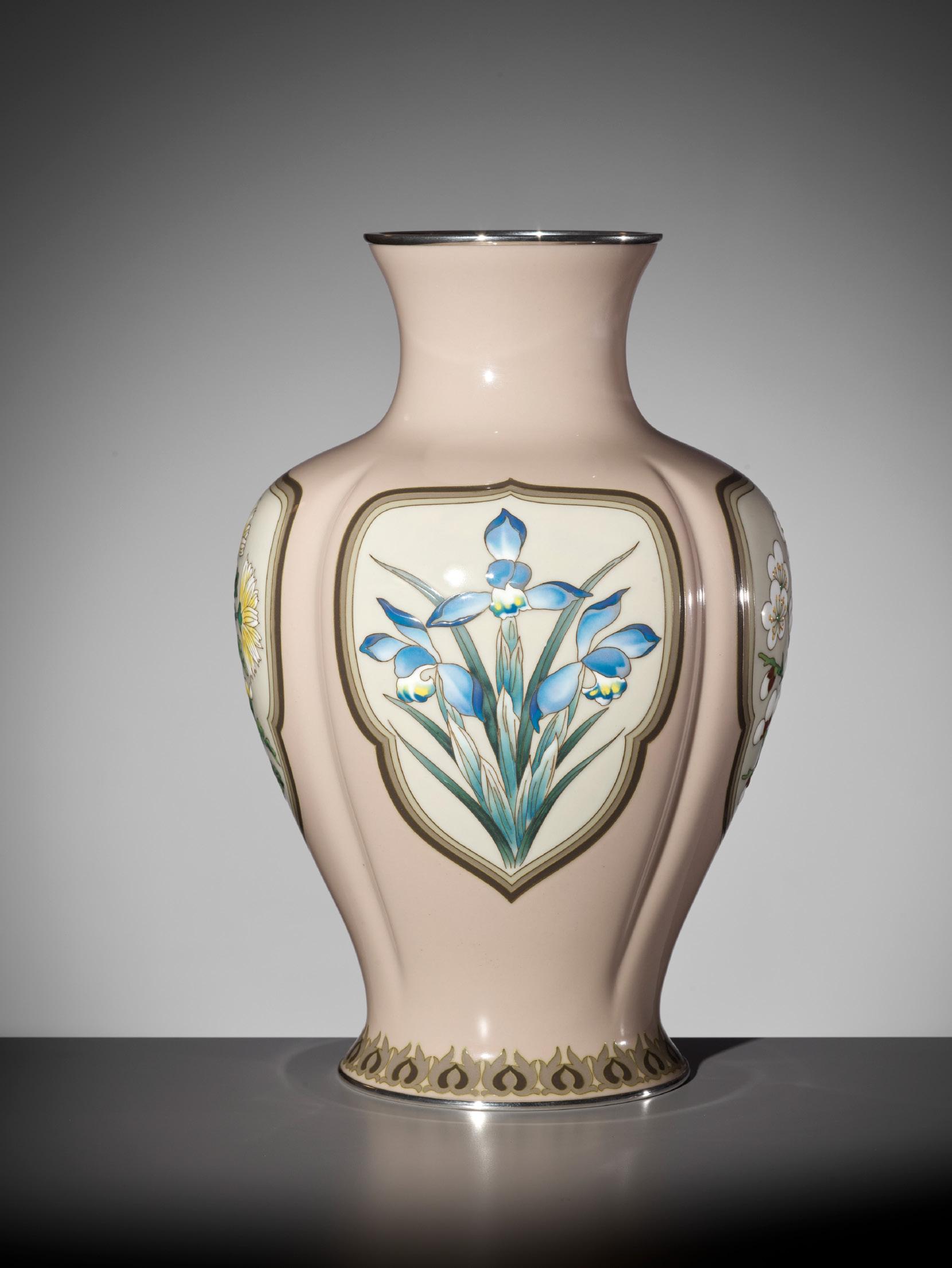
ANDO JUBEI: A FINE CLOISONNÉ ENAMEL VASE WITH FRUITING PERSIMMON TREE
By the workshop of Ando Jubei (1876-1953), signed with the Ando company mark Japan, first half of 20th century, Taisho period (1912-1926) to early Showa period (1926-1989)
Of baluster shape, worked in silver wire and musen-shippo (wireless) with brightly colored enamels depicting a ripe persimmon tree with leafy branches heavy with fruit, the main branch masterfully silhouetted in wireless cloisonné against the paleceladon ground. The leaves and fruit are worked with remarkable naturalism showing varying gradients of color simulating the subtle difference of ripeness of fruit and exposure to the sun of the leaves. With silver rims, stamped ‘silver’ and with the silver-wire Ando company mark to the underside.
HEIGHT 24.5 cm
WEIGHT 1,739 g
Condition: Very good condition, some minor pitting, some light manufacturing-inherent crackling under the surface. Provenance: From a private collection, Australia.
Ando Jubei (1876–1953) was a Japanese cloisonné artist from Nagoya. Along with Hayashi Kodenji, he dominated Nagoya’s enameling industry in the late Meiji era. Ando, Namikawa Yasuyuki, and Namikawa Sosuke are considered the three artists whose technical innovations brought in the “Golden Age for Japanese cloisonné” in the late 19th century.
Ando Jubei was the Meiji era’s most prolific creator of presentation wares (artworks that were commissioned by members of the Imperial Family for presentation to foreign dignitaries). He exhibited at the Japan–British Exhibition of 1910.
AUCTION COMPARISON
Compare a related moriage cloisonné enamel vase decorated with a persimmon tree, by Ando Jubei, at Bonhams, Fine Japanese and Korean Works of Art, 12 September 2018, New York, lot 1218 (sold for 35,000 USD).


Estimate EUR 4,000
Starting price EUR 2,000
180 143

144
GONDA HIROSUKE: A CLOISONNÉ ENAMEL BOX AND COVER

SIZE 5.1 x 7.7 x 9.3 cm
WEIGHT 308 g
Condition: Good condition with some minor pitting and manufacturing flaws. A small crack to one side.
Estimate EUR 1,500
Starting price EUR 800
182
By Gonda Hirosuke (1865-1937), signed with the mark of Gonda Hirosuke Japan, Meiji period (1868-1912)
Finely worked with a design of leafy chrysanthemums (kiku) against the deep-blue ground, the imagery overlapping from the box to the cover. The interior lined with a brocade textile. The underside with the mark of Gonda Hirosuke.
145
A FINE PLIQUE-À-JOUR VASE WITH BUTTERFLIES



Japan, Meiji period (1868-1912)
The baluster body supported on a short foot and rising to a waisted neck with bulbous mouth, the rims of silver, the translucent enamels worked in silver wire decorated with colorful butterflies and stylized clouds, against the pale green ground.
HEIGHT 12.5 cm
WEIGHT 127 g
Condition: Very good condition with minor surface wear and fine, manufacturing-inherent cracks. In remarkably fine condition for this type.
Provenance: From an old Austrian private collection, purchased at Dorotheum Auctions, Vienna.
AUCTION COMPARISON
Compare a closely related plique-à-jour vase, dated late 19th century, Meiji period, at Christie’s, 13 July 2006, London, lot 399 (sold for 10,200 GBP).
Estimate EUR 2,000
Starting price EUR 1,000
183
146 A CLOISONNÉ ENAMEL VASE AND COVER WITH DRAGONS AND HO-O
Japan, Meiji period (1868-1912)
Of elegant shape, the bulbous body resting on a stem with circular base, the cover with a large knop in the form of a sacred tama jewel. The circular base is decorated with cresting waves, the main body with three sinuous dragons grasping sacred jewels against a yellow ground, and the cover with ho-o birds and floral crests.

HEIGHT 35 cm
WEIGHT 1,137 g
Condition: A loss to the lid and to the lower part of the body. Otherwise, good condition with minor pitting and manufacturing flaws.
Estimate EUR 2,000
Starting price EUR 1,000
184
A PALE CELADON GLAZED ELEPHANT-FORM KORO (INCENSE BURNER AND COVER)

Japan, Edo period (1615-1868)
Finely modeled as an imaginary elephant with densely wrinkled skin and long curling trunk, the animal seated in a recumbent pose, the almond-shaped eye with a rust-brown pupil, the cover pierced with four small apertures.
LENGTH 18 cm
Condition: Very good condition with minor surface wear and firing irregularities, including rust-brown spots and small firing cracks.
With an old wood storage box.
Imaginary elephants (sozo-no-zo) like the present lot were also popular architectural elements found on temples, such as the Toshogu Shrine Complex in Nikko, Japan.
AUCTION COMPARISON
Compare a related elephant-form koro, also with a bluish-white glaze, also dated late 17th to early 18th century, 31 cm high, at Woolley & Wallis, 23 November 2021, Wiltshire, lot 1052 (sold for 24,000 GBP).

Estimate EUR 2,500
Starting price EUR 1,200
147

148
A
Japan, 18th -19th century, Edo period (1615-1868)
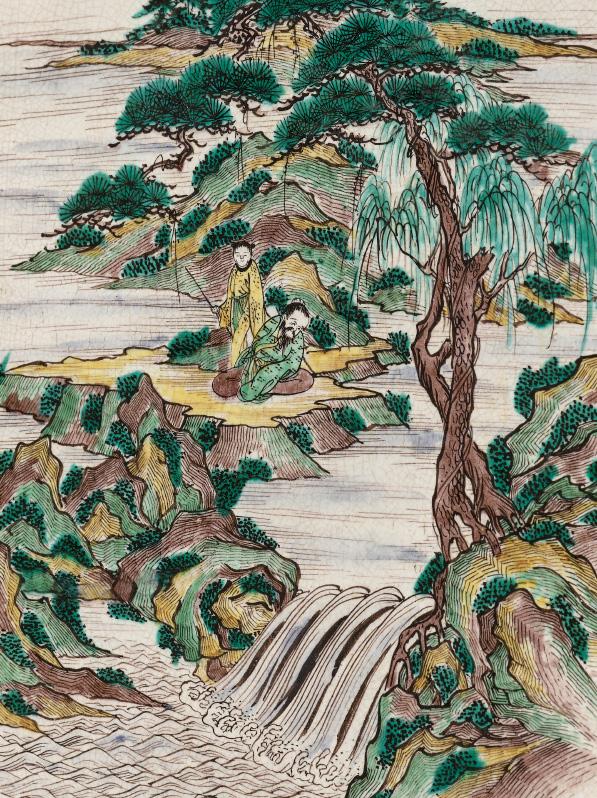
The rectangular suzuribako painted in bright polychrome enamels of mainly green, yellow and purple, with some red, all against a fine crackled ground, the lid beautifully decorated with an image of three birds within a dense floral composition set on a rock by the water, the image framed by two borders featuring geometric designs and rinzu. The interior cover and box are decorated with Chinese landscapes and with a literati and attendant. The board (ita) is made up of two removable sections. With a suzuri (inkstone) and a suiteki (water-dropper) showing a view of Mount Fuji. The sides are painted with elaborate karakusa designs.

SIZE 3.7 x 18.3 x 24.5 cm
Condition: Some tiny chips and scattered minuscule losses. Some old repairs, particularly along the edges. Presents very well.
Provenance: Ancient collection Dutuit, France.
Eugène Dutuit (1807-1886) was a French politician and art collector who formed an outstanding and wide-ranging collection with his brother Auguste, which was bequeathed to the City of Paris in 1902. It is now housed in the Petit Palais.

Estimate EUR 4,000
Starting price EUR 2,000
187
VERY RARE KO-KUTANI STYLE PORCELAIN SUZURIBAKO (WRITING BOX)
Bust of Eugène Dutuit (1807-1886)
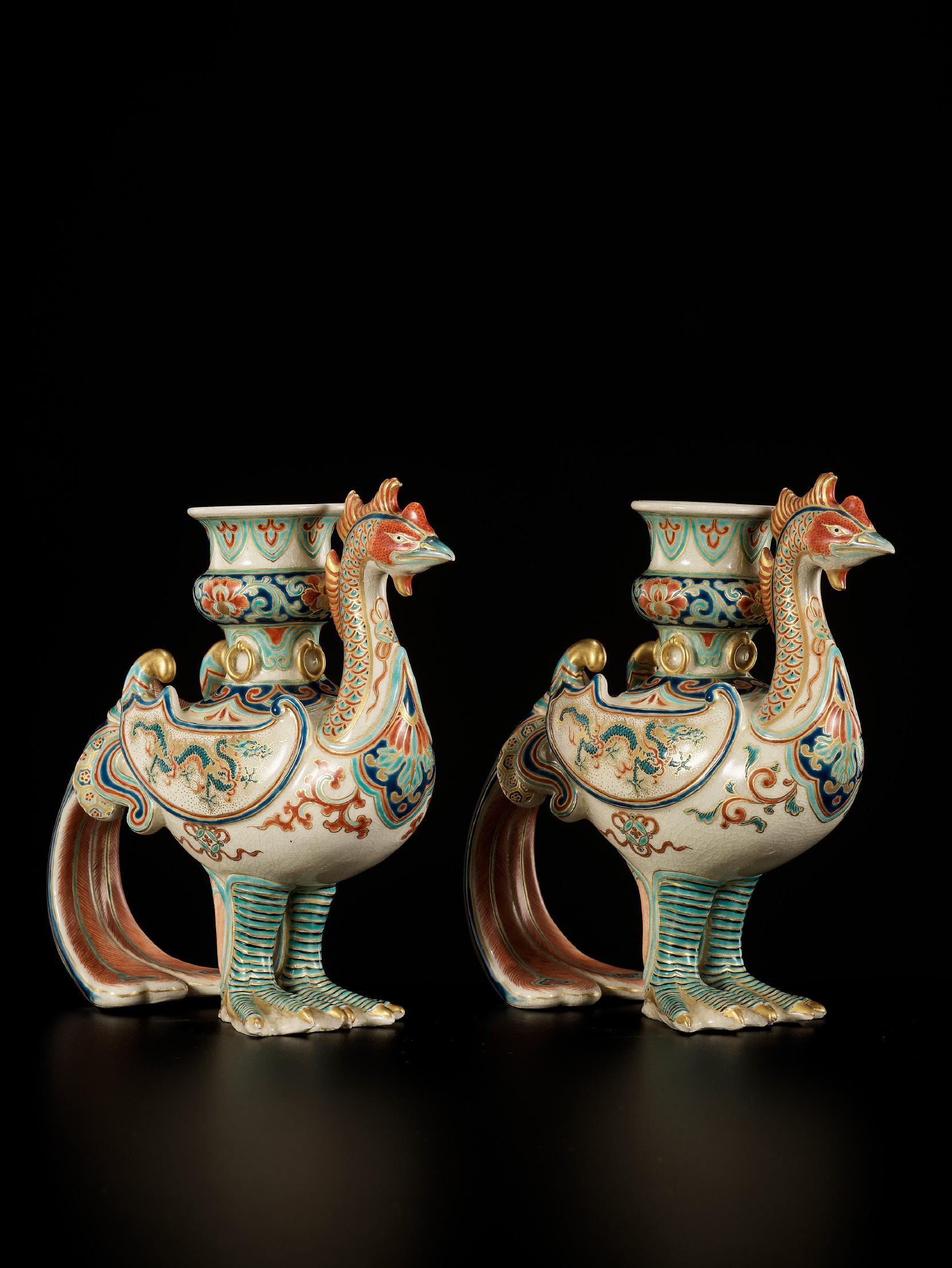
MAKUZU KOZAN: A SUPERB PAIR OF PHOENIX-FORM EARTHENWARE CANDLESTICKS

Each well-modeled in the form of a ho-o (phoenix) supporting a candle holder suspending mock rings on its back, its stout feet and elegantly curved tail forming the base, finely decorated in gilt and polychrome enamels with lotus, foliate, tasseled shippo, diapered brocade, and pendent lappet designs as well as sinuous threeclawed two-horned dragons, the base with the impressed signature MAKUZU.

HEIGHT 18.9 cm
Condition: Excellent condition with minor wear and minimal firing irregularities.
Provenance: From a private collection in New York, USA.
Makuzu Kozan (1842-1916), also known as Miyagawa Kozan, was a potter who moved his ceramics studio from his hometown of Kyoto to the port city of Yokohama in 1870. His early works copying styles and forms derived from earlier Japanese and Chinese ceramics soon found favor with Western buyers and his business quickly expanded. Kozan’s work was also much admired within Japan and achieved special notoriety after the Meiji Emperor touched one of his vases at the First National Industrial Exhibition in 1877.
MUSEUM COMPARISON
Compare a closely related phoenix-form candlestick by Makuzu Kozan, dated circa 18701880, 20 cm high, in the Kruizenga Art Museum, Hope College, object number 2013.6.2.
Estimate EUR 5,000
Starting price EUR 2,400
189
149
By Makuzu Kozan (1842-1916), signed Makuzu Japan, late 19th century, Meiji period (1868-1912)

150
YABU MEIZAN: A VERY FINE SATSUMA VASE WITH BIRDS IN AUTUMN


By Yabu Meizan (1853-1934), signed Yabu Meizan Japan, late 19th to early 20th century, Meiji period (1868-1912)
The baluster-shaped body with broad shoulders rising from a recessed foot to an everted flat rim, finely enameled and gilt to the sides and around the neck with a flock of birds flying around and perched on a trailing branch in autumn. The image stands out beautifully against the pure ivory-white crackled ground. Signed to the base YABU MEIZAN within a gilt seal.
HEIGHT 16.5 cm
Condition: Excellent condition with only minor wear to gilt.
AUCTION COMPARISON
Compare a related vase by Yabu Meizan with bird and autumn design, 23.6 cm high, at Zacke, Asian Art Discoveries - Japanese Art, 1 September 2022, Vienna, lot 55 (sold for 8,216 EUR).
Estimate EUR 6,000
Starting price EUR 3,000
191
151
A FINE SATSUMA CERAMIC VASE WITH ‘HUNDRED ANTIQUES’ DESIGN

Japan, Meiji period (1868-1912)
Of baluster-shape with a long neck and flaring rim, finely potted and covered in a creamy-white crackled glaze, decorated in polychrome enamels and gilt with a design of hundred treasures and antiques. A concentric band near the base features a rinzu band with scroll and the mouth and shoulder ring with a further neatly painted rinzu band.

HEIGHT 24.6 cm
Condition: Excellent condition with only very minor wear and rubbing to gilt.
The Hundred Antiques is a miscellaneous or general collection of emblematic forms comprising the Eight Treasures, the Four Treasures, the symbols of Four Fine Arts (music, chess, calligraphy, and painting) together with numerous conventional representations of sacrificial vessels, flowers, animals etc. This motif was particularly popular in Chinese Art during the 17th century.

Estimate EUR 1,500
Starting price EUR 800
A FINE SATSUMA DISH WITH AN AUTUMNAL SCENE DEPICTING A DEER AND FULL MOON, AFTER A DESIGN BY OGATA
KENZAN
Unsigned, after a design by Ogata Kenzan (1663-1743) Japan, Meiji period (1868-1912)
Finely potted and painted in polychrome enamels with rich gilt, all against a creamy-white crackled glaze, depicting a stag standing amongst autumn grasses beneath the silver-enamelled full moon, some maple leaves falling to the side of the image. The rim finished with a geometric-patterned border, ‘signed’ to the lower left Kenzan ga with red square seal Kenzan, inscribed on the underside Nihon Togashi

DIAMETER 29 cm
Condition: Excellent condition with only very minor wear and rubbing to gilt. The foot ring with two perforations and inset metal wire so that the dish can be mounted to a wall.
Autumn ivy by Ogata Kenzan, signed Kenzan with red square seal

Ogata Kenzan (1663-1743), brother to the artist Ogata Korin (1658-1716), was an important Japanese potter and painter of the Rinpa school.
Estimate EUR 2,000
Starting price EUR 1,000
152
153
SHIZAN:
A MAGNIFICENT SATSUMA CERAMIC TRAY WITH TEMPLE SCENE
 By Shizan, signed Shizan sei Japan, Meiji period (1868-1912)
By Shizan, signed Shizan sei Japan, Meiji period (1868-1912)

The rectangular satsuma tray finely potted and magnificently painted with bright polychrome enamels and rich gilt against a creamy-white crackled glaze, depicting a lively scene inside a temple complex with ladies engaged in various festive activities, the scenes separated by byobu screens beautifully painted with butterflies, flowers, and birds, the temple garden visible in the distance. The inner rim is decorated with a superbly painted millefleur motif, and the outer rim decorated with gilt scroll against a black ground. Signed to the back within a gilt cartouche SHIZAN sei [made by Shizan].

SIZE 14.2 x 22.6 cm
Condition: Excellent condition with only very minor wear and rubbing to gilt.
Provenance: From an old Parisian private collection.
AUCTION COMPARISON
Compare a closely related satsuma tray with similarly decorated rim, measuring 24.5 cm across, at Bonhams, Fine Japanese and Korean Art, 15 March 2017, New York, lot 6249 (sold for 16,250 USD).
Estimate EUR 8,000
Starting price EUR 4,000
194

154 KOZAN: A FINE SATSUMA CERAMIC VASE
By Kozan, signed Dai Nippon Kozan zo Japan, Meiji period (1868-1912)
Finely potted with a bulbous body, long neck, and garlic-head mouth, beautifully painted in polychrome enamels and rich gilt depicting alternating scenes of flowers, samurai and a group of rakan above a band of gilt plovers above waves, the neck decorated flowers and scrolling vines. Signed to the underside within a gilt cartouche Dai Nihon Kozan zo [made by Kozan in great Japan].
HEIGHT 24.8 cm
Condition: Very good condition with only very minor wear and rubbing to gilt. The signature underneath is partially worn away.
Estimate EUR 1,500
Starting price EUR 800
155 KINKOZAN: A FINE SATSUMA CERAMIC VASE WITH FLOWER MOTIF
By the Kinkozan company, signed Kinkozan and sealed Kinkozan zo Japan, Kyoto, Meiji period (1868-1912)
Of baluster shape, finely potted and painted with a deep cobaltblue ground embellished with gilt plants and floral medallions save for a central reserve separated by a gilt ‘bamboo’ band in relief, the central image very finely painted with bright polychrome enamels and gilt depicting a spring scene of various flowers in full bloom including chrysanthemum, peonies, and wisteria as well as some baskets. Signed in gilt to the side KINKOZAN and with impressed seal mark to the underside KINKOZAN zo [made by Kinkozan].


HEIGHT 14.5 cm
Condition: Excellent condition with only very minor wear and rubbing to gilt.
Provenance: Old Austrian private collection.
The Kinkozan workshop was one of the most successful producers of so-called ‘Kyo-Satsuma’ (Kyoto Satsuma) wares. Like their equivalents from Osaka, Yokohama, and Tokyo, these pieces were Kyoto’s response to the Western demand for delicately painted Japanese pottery. The exhibits at the 1867 Paris Expo fascinated the West and a great admiration for Japanese cultures known as Japonisme made exports of Kyo-Satsuma ware increase drastically.
Estimate EUR 1,200
Starting price EUR 600
196
BANKOZAN: A FINE AND LARGE SATSUMA CERAMIC VASE
By Bankozan, signed Bankozan Japan, Meiji period (1868-1912)
Of baluster shape, finely potted and painted with a deep cobalt-blue ground embellished with gilt plants and mon-emblems save for two large central reserves painted in polychrome enamels and rich gilt depicting idyllic figural scenes and cherry blossoms in full bloom. Signed within a gilt reserve BANKOZAN below the Shimazu crest mark. The artist produced fine quality work in the style of Kinkozan and is rarely encountered.
HEIGHT 46 cm
Condition: Excellent condition with only very minor wear and rubbing to gilt.
Provenance: Austrian private collection, purchased at Dorotheum Auctions, Vienna, in the 1990s. Old inventory number to the underside.
AUCTION COMPARISON
Compare a related large satsuma vase by Bankozan at Bonhams, Fine Works of Asian Art, 18 June 2007, San Francisco, lot 6100 (sold for 3,300 USD).


Estimate EUR 3,000
Starting price EUR 1,500
156
157
KINKOZAN: A PAIR OF COBALT-BLUE GROUND SATSUMA CERAMIC DISHES WITH PHEASANTS AND QUAILS
By the Kinkozan company, each signed Kinkozan zo Japan, Kyoto, Meiji period (1868-1912)
Each sturdily potted, the shallow rounded sides rising from a short foot to a petal-lobed rim. The interior finely decorated in colored enamels and gilt, one depicting a spring scene of pheasants below cherry trees in full bloom, the other depicting an autumnal scene of quails amongst dense autumnal grasses above a brown-gray ground. The rim and reverse covered in a rich cobalt blue. The recessed base with the gilt signature KINKOZAN zo.



DIAMETER 18.3 & 19.3 cm
Condition: Very good condition, minor wear, mostly to the gilt, and firing flaws.
AUCTION COMPARISON
Compare a related cobalt-blue ground satsuma dish, signed Kinkozan, size 31 cm, late 19th century, at Christie’s, Japanese Art & Design, 11 May 2011, London, lot 147 (sold for 1,500 GBP).
Estimate EUR 2,000
Starting price EUR 1,000
158
KINKOZAN:
A SATSUMA CERAMIC ‘AUTUMN’ KORO
By the Kinkozan company, signed Kinkozan zo Japan, Kyoto, Meiji period (1868-1912)
The koro (incense burner) of compressed globular form rising from three lobed feet, the cover pierced, finely painted in polychrome enamels and with gilt depicting an autumnal scene with sparrows and butterflies amid branches of maple, all above a cream glaze with fine craquelure. The recessed base with the gilt signature KINKOZAN zo.

HEIGHT 6.6 cm
Condition: Very good condition, minor wear, mostly to the gilt, minuscule nibbling to the rim of the cover. Provenance: British private collection.
AUCTION COMPARISON
Compare a related koro, signed Kinkozan, size 10 cm, late 19th/early 20th century, at Bonhams, Fine Japanese Art, 17 May 2018, London, lot 375 (sold for 2,250 GBP).
Estimate EUR 1,500
Starting price EUR 800
198
159
KINKOZAN: A FINE GLOBULAR SATSUMA CERAMIC VASE
By the Kinkozan company, signed Kinkozan zo Japan, Kyoto, Meiji period (1868-1912)
Of globular shape, finely potted and painted with bright polychrome enamels and rich gilt, featuring a circumferential design of a Daimyo procession. Signed to the underside within a gilt square cartouche KINKOZAN zo [made by Kinkozan].

HEIGHT 7.5 cm
Condition: Excellent condition with only very minor wear and rubbing to gilt.
The Kinkozan workshop was one of the most successful producers of so-called ‘KyoSatsuma’ (Kyoto Satsuma) wares. Like their equivalents from Osaka, Yokohama, and Tokyo, these pieces were Kyoto’s response to the Western demand for delicately painted Japanese pottery. The exhibits at the 1867 Paris Expo fascinated the West and a great admiration for Japanese cultures known as Japonisme made exports of Kyo-Satsuma ware increase drastically.
Estimate EUR 1,500
Starting price EUR 800
160
KOZAN: A FINE SATSUMA CERAMIC TRIPOD KORO (CENSER) AND COVER
 By Kozan, signed Kozan Japan, Meiji period (1868-1912)
By Kozan, signed Kozan Japan, Meiji period (1868-1912)
The tripod koro finely potted with tapering sides and two flared handles, decorated in bright polychrome enamels with rich gilt, featuring young boys in festive dress amongst ladies and men, evocative of the tango-no-sekku, the scenes arranged in long horizontal panels separated by two richly decorated panels to the sides, the cover with a gilt kiku finial and pierced three times with an inome (boar’s heart) design, the underside with neatly painted brocade bands against the creamy-white crackle glaze. Signed within a gilt cartouche KOZAN.
LENGTH 12.3 cm
Condition: Excellent condition with only very minor wear and rubbing to gilt.
Traditionally, ‘Children’s Day’ is celebrated in Japan on 5th May. The Tango-no-Sekku, or Boys’ Festival is marked by special customs and observances focusing on the healthy growth and development of young boys.
Estimate EUR 1,500
Starting price EUR 800
199
161
A PAIR OF GILT SATSUMA EARTHENWARE VASES WITH KOMAI STYLE MOTIF

Each Marked Satsuma with Shimazu clan crest mark Japan, Meiji period (1868-1912)
Each of quadrilobed form with baluster sides supported on a short circular foot and rising to a short cylindrical neck with gilt lipped rim, the shoulder with two gilt lion handles with wide-open mouths. Painted with a continuous scene of thatched cottages in a tree-lined seashore landscape with Mount Fuji in the background, framed by diapered, floral, and foliate borders above the foot and below the rim. The countersunk base and interior covered in a finely crackled transparent glaze. The base with a central mark reading SATSUMA above a Shimazu clan crest mark.
HEIGHT 18.5 cm and 18.1 cm
Condition: Excellent condition with minor wear and firing irregularities.
The present vases are inspired by the works of the famous Komai workshop. The Komai workshop is believed to have been founded in 1841, but it was only when Komai Otojiro I became its head, in 1865, that the company began to make the wares for which they were to become so famous. The workshop, under his leadership specialized in intricate inlaid work of gold and silver into iron. In a promotional brochure of about 1915 his son, Komai Otojiro II (his father having retired in 1906) called his workshop the ‘pioneer of damascene work’ and describes the process of the lacquering of the characteristic black ground, which required kiln firing and burnishing. The Komai style developed with an increasingly pictorial central motif on a background of both geometric patterns and free illustrations of nature, life, and landscapes with elaborate repeating borders. Most of these central motifs illustrate stories from Japanese history or mythology, and the Komai family retains a number of design books in which can be found drawings for many of their works.
Estimate EUR 2,000
Starting price EUR 1,000
200
 The present pair of vases together with the Komai-style iron vases (lot 131)
The present pair of vases together with the Komai-style iron vases (lot 131)
162
A FINE HIRADO BLUE AND WHITE USUBATA-FORM VASE

Japan, 19th century
Well-modeled with a globular body supported on a short, tapered foot and rising to a tall flared neck with galleried rim, the shoulder and neck with finely and naturalistically molded crane-form handles, the exterior finely painted in shades of cobalt-blue with a gnarled pine tree with winding branches above leafy bamboo stalks.
HEIGHT 20.2 cm
Condition: Excellent condition with minor wear and firing irregularities, including a firing crack to the rim.
Provenance: Property from the Estate of Paul Revere Jr. Paul
Revere Jr. (1931-2019) was the third great-grandson of the American patriot and silversmith Paul Revere (1735-1818), who is best known for his midnight ride to alert the colonial militia in April 1775 to the approach of British forces before the battles of Lexington and Concord. In 1955, Paul Revere Jr. began a forty-year career as a sales manager with Revere Copper Products, Inc., a company that traces its roots to his famous ancestor. He served for fifty-three years as president of the Paul Revere Memorial Association, the non-profit that operates the Paul Revere House in Boston. During his tenure, he guided the institution from a small house museum staffed by retired public firemen to a renowned research and educational institution. He also served for many years on the board of the Freedom Trail Foundation and was active in the process of creating the Boston National Historical Park.
Estimate EUR 2,500
Starting price EUR 1,200
202
163
A PAIR OF BLUE AND WHITE ARITA PORCELAIN VASES

Japan, Meiji period (1868-1912)
Each finely potted and of double gourd-shaped, beautifully painted in underglaze blue with blooming prunus, peonies, and chrysanthemums, the sides fitted with open-worked handles.
HEIGHT each 27.5 cm
Condition: Excellent condition with minor firing irregularities and flaws.
Estimate EUR 1,200
Starting price EUR 600
A FINE BLUE AND WHITE HIRADO PORCELAIN DISH WITH CARPS

Marked Fukudaya Hirado yaki
Japan, early 20th century, Meiji period (1868-1912) to Taisho period (1912-1926)
Finely potted, the circular dish painted in underglaze blue with a design of a swimming carp with a further carp above in white relief and with neatly incised scales. Marked to the back in underglaze blue
FUKUDAYA Hirado yaki.
DIAMETER 21.2 cm
Condition: Excellent condition, minor firing irregularities.
Estimate EUR 1,000
Starting price EUR 500
164
165
TOKUDA YASOKICHI III: A FINE KUTANI GLAZED PORCELAIN VASE

By Tokuda Yasokichi III (1933-2009), signed Kutani Masahiko Japan, late 20th century
The globular body supported on a circular foot and rising to a long neck with flaring rim, covered overall in a rich, lustrous, finely crackled, blue-green streaked glaze, save for the white foot and base signed KUTANI MASAHIKO below an impressed foliate design. With the original inscribed tomobako storage box.
HEIGHT 29 cm
Condition: Excellent condition.
Tokuda Yasokichi III was designated a Bearer of Important Intangible Cultural Assets (a “Living National Treasure”) in 1997 for his mastery of the innovative saiyu glaze technique, based on traditional Kutani colored glaze enamels as handed down from his grandfather and father, Tokuda Yasokichi I (1873–1956) and Tokuda Yasokichi II (1907–1997). Before he succeeded his father in 1988 as Tokuda Yasokichi III, the artist was known as Tokuda Masahiko.
AUCTION COMPARISON
Tokuda Yasokichi III (1933-2009)

Compare a closely related vase by the same artist at Christie’s, Japanese and Korean Art, 22 March 2002, New York, lot 175 (sold for 6,463 USD).

Estimate EUR 3,000
Starting price EUR 1,500
204
166
TOKUDA YASOKICHI III: A FINE KUTANI GLAZED PORCELAIN VASE
By
Tokuda Yasokichi
III (1933-2009), signed Kutani Masahiko Japan, late 20th century
The globular body supported on a short broad foot and rising to a slender cylindrical stem-form neck, covered overall in a rich, lustrous, finely crackled, blue-green streaked glaze, save for the white foot and base signed KUTANI MASAHIKO below an impressed foliate design. With the original inscribed tomobako storage box.
HEIGHT 27 cm
Condition: Excellent condition.
Tokuda Yasokichi III was designated a Bearer of Important Intangible Cultural Assets (a “Living National Treasure”) in 1997
for his mastery of the innovative saiyu glaze technique, based on traditional Kutani colored glaze enamels as handed down from his grandfather and father, Tokuda Yasokichi I (1873–1956) and Tokuda Yasokichi II (1907–1997). Before he succeeded his father in 1988 as Tokuda Yasokichi III, the artist was known as Tokuda Masahiko.
MUSEUM COMPARISON
Compare a related spherical vase by the same artist in the collection of the Metropolitan Museum of Art, accession number 2001.734.



AUCTION COMPARISON
Compare a closely related vase by the same artist at Zacke, Fine Japanese Art, 2 December 2022, Vienna, lot 121 (sold for 4,940 EUR).
Estimate EUR 4,000
Starting price EUR 2,000
205
HARUMI NAKASHIMA: TWISTING BACK, MULTIPLYING
By Harumi Nakashima, signed by the artist Japan, 2011
Outstanding and large porcelain biomorphic abstract sculpture covered in clear glaze and regularly distributed opulent cobalt blue polka dots of varying sizes, titled ‘Twisting Back, Multiplying’, handbuilt by the famous Japanese ceramic artist Harumi Nakashima 中 島晴美 (1950). Signed at the bottom in a dot ‘1104 晴 (1104 Haru). Made in 2011.

HEIGHT 41 cm, WIDTH 53 cm, DEPTH 33 cm
Condition: Excellent condition.
Born in 1950 in Ena, Gifu Prefecture, Harumi Nakashima 中
島晴美 is known for his biomorphic porcelain sculptures decorated with opulent blue dots. He excels in clay creations far removed from both tradition and functionality. Taking great care to achieve a flawless surface and form, each piece is created over the course of six months.

Nakashima’s early reputation was cemented as one of the leading teachers at the Tajimi Pottery Design and Technical Center, having trained and influenced many of the promising young ceramicists of Japan since 1976. Nakashima has received leading prizes and tributes.
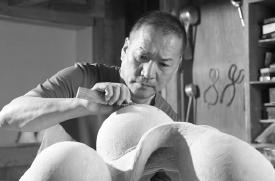
With works collected by 20 public institutions the world over, including the Museum of Arts and Design in New York and the Faenza Ceramics Museum in Italy, he is one of Japan’s most celebrated porcelain artist. Influenced by the blue sometsuke (under-glaze) motifs of traditional Japanese porcelain, Nakashima’s motifs also use cobalt blue over-glaze. Yet unlike traditional methods, Nakashima’s blue dots are painted over the body of a work after the main firing, and then fired into the white glaze of the porcelain with a second firing using the technique of “in-glazing”, thereby leading to the sinking of the dots upon the white overglaze. Perhaps more surprising is the fact that his organic, sprawling and fluid porcelain bodies are entirely hand-built. As porcelain is extremely difficult to manipulate by freehand, Nakashima intentionally uses this method to create not only tension, but an epic “battle with clay”.
AUCTION COMPARISON
Compare a closely related porcelain sculpture by Haruma Nakashima, titled ‘Struggling Form T-1’, at Sotheby’s, A Collection That We Dreamt Of: Art and Design from the New York Townhouse of Delphine and Reed Krakoff, 8 June 2022, New York, lot 88 (sold for 32,760 USD).
Estimate EUR 15,000
Starting price EUR 8,000
206 167
Harumi Nakashima at work on one of his sculptures


168
HONDA SYORYU: SPRING
By Honda Syoryu (Shoryu, born 1951), signed Syoryu Japan, 2004
Of abstract from, intricately carved from madake bamboo and rattan, signed on an inlaid bamboo tablet to the underside. With the original box.
SIZE 29 x 25.4 x 30.5 cm
Condition: Excellent condition.
Provenance: Tai Modern, Santa Fe, USA, 2004. Collection Robert and Ruth Vogele, Chicago, USA, acquired from the above. Robert and Ruth Vogele were avid collectors of fine art, folk art, and modern design. More than patrons, the Vogeles believed in establishing personal relationships with artists to better understand the artwork and inform their collecting. Tai Modern regularly features artworks by Honda Syoryu and has published several catalogs on the artist.
Honda Syoryu himself remarks about his work: “I create sculptures about space and time, about the magnificence and mystery of the universe. Six years ago, I moved to the city of Matsumoto, where the sky and mountains spread out before my eyes. I am becoming more and more inspired by the beauty of this area. Working with bamboo, it is almost impossible to have total control over the form that you intend to make. When I make my art, I am in constant dialogue with the bamboo. This material’s unique pliability allows
me to draw beautiful, naturally curving lines in space. The textures I create cannot be achieved with any other medium. I feel great satisfaction when working together with the bamboo leads me to create a sculpture beyond my imagination.”
Syoryu has virtually abandoned traditional ideas about the function of basketry acquired during his early training, choosing instead to create dramatic curvilinear sculptures from fine stained bamboo strips woven in nawame (twining) technique. Once a few rows of twining have been completed, he leaves the verticals exposed for several inches at both ends, uses hot water to soften the entire piece, and then kneads it into shape, pulling up some of the rows to form the gaps seen in the finished work. The free ends of the verticals are then plaited and secured with a binding of rattan.

Syoryu works are held in various museum collections such as The Metropolitan Museum of Art, New York, The Museum of Fine Arts, Boston, MA, and The Asian Art Museum, San Francisco. He has received many prizes for his bamboo sculptures.
AUCTION COMPARISON
Compare a related bamboo sculpture by the artist, titled Galaxy (Seiun) 2001, at Christie’s, The Collection of Victoria, Lady de Rothschild, 9 December 2021, London, lot 161 (sold for 18,750 GBP).

Estimate EUR 10,000
Starting price EUR 5,000
209
169
MAEDA CHIKUBOSAI II: A FINE WOVEN BAMBOO AND RATTAN HANAKAGO (FLOWER BASKET)
 By Maeda Chikubosai II (1917-2003), signed Chikubosai kore saku
By Maeda Chikubosai II (1917-2003), signed Chikubosai kore saku
Japan, 20th century
Of ovoid form and finely woven with openwork hexagonal plaiting which become narrower towards the shoulder and mouth. Signed underneath CHIKUBOSAI kore saku [this is made by Chikubosai]. With an otoshi (water holder).
The wood storage box with hakogaki at the top reading Uroko-ami tsubo katachi kago, the reverse signed Chikubosai tsukuru kore and sealed Chikubosai.
HEIGHT 24.9 cm
Condition: Excellent condition.
Maeda Chikubosai II was born in the Hirai section of Sakai, where all of the Maeda clan lives. A late child, he was considered too young to be trained by his father and learned plaiting techniques from his father’s students instead. He began to receive some recognition for his work during the mid-1930s. After World War II, he showed in Osaka-area exhibitions and aspired to show creative work in Nitten. In 1953 he had his first piece accepted in Nitten, and he exhibited in 1959 at Japan Traditional Crafts Exhibition. He was honored by the Japanese government in 1992, and named “Living National Treasure” in bamboo craft in 1995.
Literature comparison: Compare a closely related basket published in: Joe Earl, Baskets, Masterpieces of Japanese Bamboo Art, 18502015, 2018, p. 415, no. 145.
Estimate EUR 4,000
Starting price EUR 2,000
170
KOSUGE KOGETSU: A FINE WOVEN BAMBOO AND RATTAN HANAKAGO (FLOWER BASKET)
By Kosuge Kogetsu (1932-2016), signed Kogetsu saku Japan, Showa period (1926-1989)
Of cylindrical shape, the composition reminiscent of a tsuzumi (hand drum), finely woven in bamboo and rattan, signed underneath KOGETSU saku [made by Kogetsu]. With an otoshi (water holder).
The wood storage box with hakogaki at the top reading Hounsai, Kōgetsu-saku with seal Kogetsu.
HEIGHT 31.5 cm
Condition: Excellent condition.
The son and pupil of the famed Kogetsu Chikudo (1895-1966), the versatile Kogetsu here shows the influence of the Iizuka lineage of bamboo weavers working in Tochigi Prefecture and Tokyo, who pioneered this style of basket that relies for its aesthetic impact on the contrast between fine plaiting and plain, lighter-colored structural elements.

Kosuge studied tea ceremony and created baskets that expressed his earnest, charismatic personality. Among his prestigious awards are the Minister of Economy, Trade, and Industry Prize at Japan’s Flower and Tea Ware Art Exhibition and the Niigata Nippo Prize at the 16th Prefectural Art Exhibition. In 1972, the Niigata Governor commissioned the artist to create a basket as a gift to the Emperor of Japan and six years later he became a full member of the Japan Craft Art Association. Kosuge’s work is in the collection of the San Francisco Asian Art Museum.
Estimate EUR 3,000
Starting price EUR 1,500
171
OMORI CHIKUYUSAI: A FINE WOVEN BAMBOO AND RATTAN HANAKAGO (FLOWER BASKET)
By Omori Chikuyusai, signed Chikuyusai kore saku Japan, c. 1950, Showa period (1926-1989)
A very fine tall Japanese bamboo basket with an intricate multi-directional weave rendered in thin strips of bamboo. The top and bottom double rimmed and supports around the circumference tied in place with delicate knots of bamboo. The basket beautifully framed by a tall handle formed from two long strips of bamboo connected with knots of bamboo. Complete with a large lacquered bamboo water pot (otoshi) and wood storage box. Signed to the base CHIKUYUSAI kore saku [made by Chikuyusai].
HEIGHT 49 cm
Condition: Excellent condition.
Omori Chikuyusai was born in 1911 and was an associated member of the Nihon Kogeikai (Japan Art Crafts Association). He also rose to chairman of the Jokokai association. He lived and worked in Nagoya City, until 1971. He made bamboo baskets for Tea masters, especially for the Enshu School of Tea.
Estimate EUR 1,500
Starting price EUR 800
172
HAKUHOSAI: A FINE WOVEN BAMBOO AND RATTAN HANAKAGO (FLOWER BASKET)
By Hakuhosai, signed Hakuhosai Japan, Taisho period (1912-1926)
A very fine dark flower basket rendered rattan and bamboo. Three defined sections of the basket exist, each rendered with a different plait and each section separated with a knotted twined line. The bottom of the basket and lower section with a tight twill plait that transitions into a diamond-shaped plait using two stripes of bamboo for each run. The top half of the basket constructed from twill plaiting in various directions and utilizing various-sized stripes of bamboo. The rim constructed from a circular rim plaited over. The tall handle sweeps out wide framing the basket with delicate bamboo knots around the edges. The handle anchored to the basket using elegantly plaited thin stipes of bamboo. Signed HAKUHOSAI.


HEIGHT 54.5 cm
Condition: Excellent condition.
Hakuhosai worked in the Taisho period and with a small but fine production of work. A basket by the artist is held in the collection at the NGA (National Gallery of Australia) and an academic paper was published about the artist in 1963.
Estimate EUR 1,500
Starting price EUR 800
212
173
KOSHOSAI: A FINE WOVEN BAMBOO AND RATTAN HANAKAGO (FLOWER BASKET)
 By Koshosai, signed Koshosai Japan, early 20th century
By Koshosai, signed Koshosai Japan, early 20th century
HEIGHT 50 cm
Condition: Excellent condition.
Estimate EUR 2,000 Starting price EUR 1,000
213
The beautiful flower basket of traditional shape with a large curved handle, finely worked in woven bamboo and rattan, signed underneath KOSHOSAI.
The wood storage box with hakogaki at the top reading Teiryo hanakago, Koshosai, with seal Koshosai [Flower basket with handle, Koshosai, with seal Koshosai].
174 KAMEI TADASHI: A FINE WOVEN BAMBOO AND RATTAN HANAKAGO (FLOWER BASKET)

By
Kamei
Tadashi (art name Shoso), signed Shoso Japan, late 20th century
Of globular shape with a wide body, finely woven in thick strips of bamboo with some rattan accents. With an otoshi (water holder).
The wood storage box with hakogaki at the top reading: Hanakago, Shoso saku, with seal Shoso [Flower bamboo basket, made by Shoso, with seal Shoso].
LENGTH 32 cm
Condition: Excellent condition.
Kamei Tadashi (art name Shoso) was born in Showa 25 (1950). He entered the Bamboo Art Department of the Oita Beppu City Polytechnic College (Beppu Koto Shokugyo Kunrenko) in Showa 47 (1972) and graduated in Showa 49 (1974). In the same year, 1974, he started to further his study in bamboo crafting under his father Kamei Chikuryusai.
Estimate EUR 1,500
Starting price EUR 800
175
MATSUO CHIKUHO: A WOVEN BAMBOO AND RATTAN HANAKAGO (FLOWER BASKET)

By Matsuo Chikuho (born 1927), signed Chikuho Japan, c. 1970-1980, Showa period (1926-1989)
Of globular form, the main body of the bamboo has been constructed in double matte platting. With an otoshi (water holder).
The wood storage box with hakogaki at the top reading: Purple coloured bamboo, flower basket, by Chikuho, with seal Chikuho.
HEIGHT 23.5 cm
Condition: Excellent condition.
Matsuo Chikuho was born in 1927, his career as a bamboo artist culminated in 1981 with the winning of the President’s Award from the Japan Kogei-kai Association for Bamboo Work.
Estimate EUR 1,000
Starting price EUR 500
214
176 NAGAKURA KEN’ICHI: STRIPES
By Nagakura Ken’ichi (1952-2018), signed to a washi label applied to the box Kago hanaire, Shima, Nagakura Ken’ichi Japan, Showa period (1926-1989)
Of abstract shape, the composition titles ‘Stripes’, finely worked in woven bamboo and rattan. With an otoshi (water holder).
The large cardboard box with an applied label: Kago hanaire, Shima, Nagakura Ken’ichi [A flower basket, entitled Stripes, by Nagakura Ken’ichi] with a seal.
LENGTH 60 cm
Condition: Excellent condition.
The first recipient of the Cotsen Bamboo Prize in 2000, Nagakura Ken’ichi (1952-2018) studied under his grandfather but was mostly self-taught, drawing on a wide range of sources for his creative inspiration, from European sculpture through American pop art to traditional Japanese forms.
Nagakura’s organic, contemporary pieces are rooted in the functional baskets and flower arranging vessels made for centuries in Japan but also borrow from wide-ranging sources, including the richly material paintings of Anselm Kiefer and the rough-hewn statues made by the itinerant 17th century Buddhist monk Enku. However, throughout the entirety of his career, Nagakura’s primary inspiration has been the natural world. “For me,
inspiration comes from the workings of nature, both large and small, near and distant,” the artist states. “My desire is to share with other human beings the silent voice of nature.”
Nagakura’s works are held in various museum collections such as The Metropolitan Museum of Art, New York, and The Asian Art Museum, San Francisco.

AUCTION COMPARISON
Compare a related bamboo hanakago of twisted design by Nagakura Ken’ichi at Bonhams, Fine Japanese Works of Art, 25 March 2010, New York, lot 2222 (sold for 3,050 USD).



Estimate EUR 3,000
Starting price EUR 1,500
215

Samurai Art
Lots 177 to 252

A NIMAI-DO GUSOKU WITH A KOSHU TOKUBETSU KICHO SHIRYO PAPER
Japan, early Edo period (1615-1868)
The components lacquered black and gold and laced in orange, beige, and green. Comprising a russet-iron sixty-two plate suji-kabuto with a partly gilt and incised three-tiered tehen kanamono, the mabizashi with raised lines denoting eyebrows and forehead wrinkles, below the gold-lacquered circular maedate, flanked by gold-lacquered fukigaeshi, above the four-lame shikoro; the black-lacquered hanbo with a raised flowerhead at the chin above the four-lame yodarekake; a two-section-cuirass (nimai-do) made of iron-plate black-lacquered iyozane (wide scales assembled with almost no overlap); five sets of four-lame kusazuri; two four-lame sode; the kote and haidate with kusari (chain mail); and pairs of suneate and kegutsu.

Condition: Very good condition with minor surface and few typical losses.
With a storage box.
With a certificate issued by the NKBKHK (Nihon Katchu Bugu Kenkyu Hozon Kyokai, ‘The Association for the Research and Preservation of Japanese Helmets and Armor’), classifying the armor as Koshu Tokubetsu Kicho Shiryo (Especially Important Armor Object) grade and confirming the dating above, with a twelvecharacter seal.

Estimate EUR 15,000
Starting price EUR 8,000
177
178
A SUIT OF ARMOR WITH A KOBOSHI KABUTO


Japan, Edo period (1615-1868)
The components laced predominantly in blue and fitted with partly gilt copper hardware adorned with chrysanthemum and foliate designs. Comprising a russetiron sixty-two plate koboshi kabuto with a gilt-copper chrysanthemumform tehen kanamono, the mabizashi fitted with a red and gold-lacquered wood maedate in the form of a long-horned demon with funnel-shaped ears, flanked by the black-lacquered fukigaeshi with raised gold-lacquered prunus flowerheads, above the four-lame shikoro; the black lacquered menpo with a long horsehair mustache and a three-lame nodowa; a pair of five-lame sode; kote and haidate with kusari (chain mail); the russetiron iron do (cuirass) with six sets of five-lame kusazuri; and a pair of suneate. The wood storage box with red-lacquered kenkatabami mon (wood sorrel and ken sword crest) and fitted with the sashimono battle banner with circular emblem.
Condition: Very good condition with minor surface wear and few typical losses, the sashimono with tears and losses.
Provenance: From a Czech private collection.
Estimate EUR 8,000
Starting price EUR 4,000
AN O-YOROI WITH TOYOTOMI FAMILY CRESTS
The helmet by Myochin Munenao, signed Myochin Munenao with kakihan Japan, 19th century, Edo period (1615-1868)
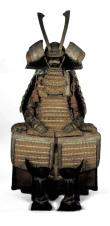
Constructed of honkozane lacquered gold and laced in orange and red, white omodaka odoshi style, the component parts decorated with elaborate stenciled doe skin, mounted with elaborate gilt-copper hardware adorned with butterflies, chrysanthemum, and kirimon (paulownia crests). Comprising a russet-iron twelveplate o-boshi kabuto dressed in gilt-copper karajiho and shinodare running down from a large giltcopper two-stage tehen kanamono, fitted with a wide five-lame o-manju shikoro with broad Heian-style fukigaeshi with silk cord highlights, the mabizashi similarly decorated and applied with a bold gilt-copper shishi kuwagatadai supporting long classical kuwagata, the bowl signed on a gilt plate on the exterior back MYOCHIN MUNENAO with a kakihan; the cuirass is o-yoroi style do open at the right side and with a waidate plate, four broad sections of five-lame kusazuri separated at the front and back in typical yoroi style; kyubi no ita; osode; namazugote with shakudo and gilt-copper plates, the chain mail lacquered black.

Condition: Very good condition with minor surface wear and few typical losses.
Provenance: From a Czech private collection.
With a storage box.
The kirimon or Paulownia Seal originally was the private symbol of the Japanese Imperial Family, from as early as the sixteenth century. The Toyotomi clan, led by Toyotomi Hideyoshi, later adopted the Paulownia Seal for use as the crest of his clan.
AUCTION COMPARISON
Compare a related o-yoroi with Shimazu family crest at Christie’s, 23 March 2000, New York, lot 108 (sold for USD 46,000).
Estimate EUR 20,000
Starting price EUR 10,000
179
180
A FINE MINIATURE SUIT OF ARMOR FOR THE TANGO NO SEKKU FESTIVAL
Japan, Meiji period (1868-1912)
Constructed in the same manner as a full-sized armor with the components laced in predominantly orange silk and mounted with silver hardware superbly carved and finely incised with shishi and peony. Comprising a twenty-four plate russet-iron za-boshi kaburo with a partly gilt three-tiered chrysanthemum-form tehen kanamono, the mabizashi and fukigaeshi with applied and finely patterned textile, the gilt maedate in the form of a kenkatabami mon (wood sorrel and ken sword crest), repeated on the shikorolame below the fukigaeshi, further with a five-lame shikoro; a russet-iron menpo with horsehair mustache and gilt teeth as well as two sets of two-lame yodarekake; the do (cuirass) fitted with four sections of five-lame kusazuri; two kote of elaborate silk brocade with sukari; kyubi no ita and sendan no ita; two o-sode; two kawara haidate; russet-iron suneate with applied silver butterflies and gilt kenkatabami mon; and a pair of kegutsu.

HEIGHT 77 cm (total, mounted on box and stand)
Condition: Very good condition with minor surface wear and few minor dents.
The wood storage box supported on six tall black-lacquered legs, all with elaborately chased metal fittings with floral and foliate designs.
During the 17th century, samurai families used to display a set of helmet and armor, weapons and banners outdoors on the Tango-no-Sekku Festival (The Boy’s Festival), held on the fifth day of the fifth month, designated as an important ceremonial day by the Edo Shogunate Government. Later in the Edo period, these items, except for the banners, were moved indoors and displayed in rooms facing the street. The armors gradually became miniaturized, thus keeping splendid decorations on, as such armors and helmets were also to display the prosperity of their household.

Estimate EUR 6,000
Starting price EUR 3,000
A SAOTOME SCHOOL RUSSET-IRON SUJI-KABUTO WITH NICHIRIN (SUN) MAEDATE
By Saotome Ienari, signed Joushu-ju Saotome Ienari Japan, mid-16th century, Muromachi period (1336-1573)
The 62-plate bowl with a three-tiered chrysanthemum-form tehen kanamono, the lobed mabizashi lacquered red to the interior, the gold-lacquered maedate of nichirin (sun) form, the gilt-copper and leather fukigaeshi with gilt mon fittings incised with foliate designs against a ring-punched ground, the four-lame shikoro lacquered black and with blue lacing. The interior of the helmet with the signature Joushu-ju SAOTOME IENARI.
HEIGHT 16 cm (the helmet) and 47 cm (total)
Condition: Good condition with minor wear and light rust, the lacquer with expected age cracks, light surface scratches.
Saotome Ienari was the third master of the Saotome family of armor makers. He worked in the area that is modern Hitachi, active from 1532 to 1569.
Suji-kabuto, or “line helmets” are a style of kabuto helmet that were used in Nanbokucho period through to the Muromachi era. The lines were created by layering long thin vertical iron boards individually. These were connected by small rivets, which were then flattened so that only the layered parts of the iron plates could be seen. These helmets were named according to the number of plates used: in this case, sixty-two.
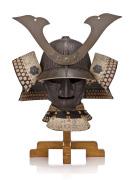

AUCTION COMPARISON
Compare a related russet-iron sixty-two plate sujikabuto by Saotome Ienari, dated mid-16th century, at Bonhams, The Samurai Sale, 22 October 2009, New York, lot 3007 (sold for 21,960 USD).
Estimate EUR 6,000
Starting price EUR 3,000
222
181
182
A BLACK AND GOLD-LACQUERED
KAWARI KABUTO WITH ONI MAEDATE
Japan, 17th-18th century, early Edo period (1615-1868)
A rare kawari kabuto (eccentrically shaped helmet), the blacklacquered iron plate helmet forming to a point at the top, flanked by gold-lacquered fukigaeshi above the four-lame gold-lacquered shikoro with blue and orange silk lacing, the gold and polychrome lacquered maedate in the form of an oni with long horns and large funnel-shaped ears.

HEIGHT 29 cm (the helmet) and 37 cm (total)
Condition: Good condition with minor surface wear, the lacquer with expected age cracks, the helmet with a small loss to one side with a minor old repair and associated touchups, the maedate with some repairs.
AUCTION COMPARISON
Compare a related kawari kabuto of similar form at Galerie Zacke, Fine Japanese Art, 28 October 2020, Vienna, lot 83 (sold for 10,112 EUR).

Estimate EUR 6,000
Starting price EUR 3,000
AN IRON KABUTO AND MENPO
Japan, Edo period (1615-1868)
The fourteen-plate bowl with a large five-tiered tehen kanamono of chrysanthemum form, the lowest tier of a lobed star shape, the central plates with rivets incorporated into an applied and neatly incised arrow design, the front plate with three rivets and the back plate with two, the helmet further with a mabizashi with patterned textile and metal fittings, large square fukigaeshi, and a plain twolame shikoro with blue silk lacing. The menpo with a removable nose plate above the applied mustache and three-lame yodarekake with silk lacing and finely chased gilt-metal openwork fittings in the form of kiku-flowerheads amid scrolling vines.
HEIGHT 27 cm (the helmet incl. shikoro) and 28 cm (the menpo incl. yodarekake)

Condition: Very good condition with minor surface wear, minor chips, few minor losses, small dents.
Estimate EUR 5,000
Starting price EUR 2,400
224
183
184
A RARE MYOCHIN SCHOOL IRON SOMEN (FULL FACE MASK)
Japan, 18th century, mid-Edo period (1615-1868)

Forged in sections with a removable nose plate and designed with deeply embossed eyebrows and deep wrinkles on the cheeks, with straight cord pegs on the chin on cherry-floret grommets. Fitted with a gold-lacquered two-lame yodarekake with orange and cream lacing as well as metal dragon-form fittings.
HEIGHT 25.4 cm (the mask) and 37 cm (total)
Condition: Very good condition with minor surface wear, fine dark patina.
The existence of somen (full masks) goes back to the Muromachi Period but quickly declined in popularity as the full coverage of the face was found to be uncomfortable and impractical since it did not provide any functional advantage. They continued to be made as showpieces for high-ranking lords as opposed to practical armor accoutrements.

AUCTION COMPARISON
Compare a closely related iron Myochin school Menpo at Christie’s, Bushell Collection of Japanese Sword Fittings & Works of Art, 28 October 1998, New York, lot 707 (sold for 21,850 USD).
Estimate EUR 6,000
Starting price EUR 3,000
225
185
A TANTO IN FINE WOOD SAYA WITH MIXED METAL INLAID ZODIAC ANIMALS (JUNISHI)
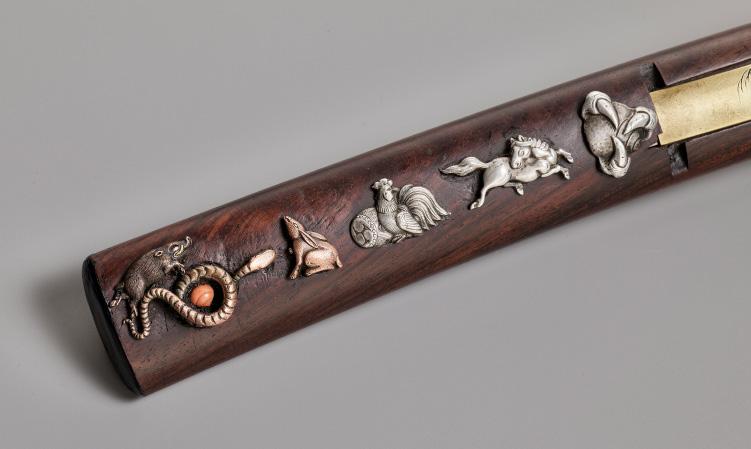


Japan, Meiji period (1868-1912)
The saya (scabbard) finely decorated in fine takazogan of silver, copper and gold, with highlights of shakudo, depicting the twelve zodiac animals (junishi) and further with Daruma and hossu, sambaso dancers, the kozuka of sentoku decorated with a horse and willow, the back with a two-character signature Toshimasa.
LENGTH 33.7 cm
Condition: Very good condition with minor typical wear. Few age cracks. The kurigata is lost.
Provenance: Old Viennese private collection.
Estimate EUR 3,000
Starting price EUR 1,500
226
186
KUNIYASU: A TANTO IN SHIRASAYA
By Kuniyasu, signed Kuniyasu Japan, Yamato Province, 12th century, early Kamakura period (1185-1333)
The slender, gently curved blade is kanmuri-otoshi-zukuri with naginata-hi to either side, a thin groove to one side, and iori mune. The hamon is suguha with nioi. The hada is masame-itame. The silver habaki with diagonal file marks and dew drops. The nakago with two mekugi-ana, a kuri-jiri, and the mei KUNIYASU.

NAGASA 20.9 cm, LENGTH 36.5 cm (total)
Condition: Very good condition with minor surface wear.
Provenance: Hungarian private collection.
The kanmuri-otoshi-zukuri configuration is typically found in swords from Yamato Province made during the early Kamakura period.
Estimate EUR 5,000
Starting price EUR 2,400
187
AN IMPORTANT ECHIZEN SCHOOL KATANA IN KOSHIRAE WITH NBTHK HOZON TOKEN PAPER, ATTRIBUTED TO YASUTSUGU I

The blade attributed to Yasutsugu I, the tang inscribed Nanbantetsu o motte, Bushu ni oite and with aoi mon Japan, early 17th century, late Momoyama (1573-1615) to early Edo period (1615-1868)
The blade:
The superbly forged blade with shinogi-zukuri and iori mune. The hamon is suguha with nie and nioi, the hada is itame. The nakago is suriage (shortened), with kuri jiri, and two mekugi-ana, the mei reads Nanban-tetsu o motte, Bushu ni oite (‘Made from Southern Barbarian steel, in Bushu Province’) and with an aoi (hollyhock) mon.
The mounting: The gilt habaki with diagonal file marks and raised dew drops. The iron tsuba of oval form with two hitsu, finely carved in sukashibori and decorated in gold, silver, and copper takazogan with a design of warriors engaged in battle signed SOHEISHI NYUDO SOTEN sei (‘Made by Soheishi Soten, with the Nyudo title’). The shakudo fuchi-kashira with similar inlays also depicting warriors, the shakudo menuki with similar inlays depicting warriors on horseback. The tsuka with rayskin samegawa and dark-green silk tsuka-ito. The saya finely lacquered in black and golden-brown with a wood grain pattern.
NAGASA 68.2 cm, LENGTH 98 cm (total)
Condition: Very good condition with minor surface wear to the blade and to the mounting, little ware and fukure, the tsuba and fuchi-kashira with tiny dents and minuscule nicks, minor tears to the tsuka-ito.
Provenance: Czech private collection.
This sword has been judged and attested by the NBTHK to be the Hozon Token (‘Worthy of Preservation’) rank. The NBTHK Hozon paper, no. 342985, dated 28 March Heisei 8 (1996), with a photograph of the tang and the seal of the NBTHK, with a registration stamp from the Educational Committee of Tokyo, no. 270320, registration date 2 February Heisei 7 (1995), issue date 1 June Heisei 8 (1996), accompanies this lot.

This katana is by Yasutsugu I working in Edo where he was retained by the shoguns Tokugawa Ieyasu and Hidetada in the early seventeenth century. He received the privilege of the use of the character yasu in his name from Ieyasu, and also the right to carve the triple-hollyhock leaf crest of the Tokugawa clan. Both the first and second generations resided alternately in Echizen and Edo, and styled themselves Echizen Yasutsugu even when working in Edo.

The inscription Nanban-tetsu o motte (‘Made from Southern Barbarian steel’), which is frequently found on works of the Echizen school, implies the use of imported steel.
AUCTION COMPARISON
Compare a related wakizashi in shirasaya by Yasutsugu I, also with aoi mon (hollyhock crest), dated to the early Edo period, at Christie’s, Important Swords from the Museum of Japanese Sword Fittings, 29 March 2005, New York, lot 37 (sold for 90,000 USD).
Estimate EUR 60,000
Starting price EUR 30,000
228

YASUTSUGU III: AN ECHIZEN WAKIZASHI IN SHIRASAYA
By
Yasutsugu
III, signed Yasutsugu Japan, 17th century, Edo period (1615-1868)
The slender curved blade is shinogi-zukuri with iori mune. The hamon is notare with nie and nioi. The gilt habaki with horizontal and vertical file marks. The nakago with one mekugi-ana, the tip is iriyamagate, the yasurime is sujikai, one side with the mei reading YASUTSUGU with the Tokugawa aoi mon (hollyhock crest) and further inscribed nanbantetsu o motte, Bushu Edo ni oite kore o tsukuru (‘Made with Southern Barbarian steel in Edo, Bushu Province’)
NAGASA 52.2 cm
Condition: Very good condition with minor wear and little ware.
Provenance: From a Czech private collection.
The saya is inscribed Matsudaira ke shozo hin (‘Collection of the Matsudaira Family’). The Matsudaira clan was a Japanese samurai clan that descended from the Minamoto clan. It originated in and took its name from Matsudaira village, in Mikawa Province (modern-day Aichi Prefecture). During the Sengoku period, the chieftain of the main line of the Matsudaira clan, Matsudaira Motoyasu became a powerful regional daimyo under Oda Nobunaga and Toyotomi Hideyoshi and changed his name to Tokugawa Ieyasu. He subsequently seized power as the first shogun of the Tokugawa shogunate which ruled Japan during the Edo period until the Meiji Restoration of 1868. Under the Tokugawa shogunate, many cadet branches of the clan retained the Matsudaira surname, and numerous new branches were formed in the decades after Ieyasu. Some of those branches were also of daimyo status.
The inscription Nanban-tetsu o motte (‘Made from Southern Barbarian steel’), which is frequently found on works of the Echizen school, implies the use of imported steel.
AUCTION COMPARISON
Compare a related katana by the same swordsmith at Christie’s, Important Swords from the Museum of Japanese Sword Fittings, 10 November 2004, London, lot 18 (sold for 13,145 GBP).


Estimate EUR 5,000
Starting price EUR 2,400
230 188
189
KOYAMA
MUNETSUGU: A WAKIZASHI
IN SHIRASAYA, DATED 1831 BY INSCRIPTION
By Koyama Munetsugu I (1802-1872), signed Koyama Munetsugu saku Japan, dated
1831
The slender curved blade is hira-zukuri with omaru boshi and iori mune, both sides with well carved horimono, one a sanko-no-kurikara dragon chasing the sacred jewel and rendai lotus and the other a sankozuka-ken (ken sword with vajra hilt). The hamon is gunome-midare in nioi deki with some ashi. The hada is itame with some masame. The silver habaki with diagonal file marks and dew drops. The nakago with one mekugi-ana, the tip is iriyamagate, the front with the mei reading KOYAMA MUNETSUGU saku, the back inscribed Tempo Ninen Hachigatsu Hi (‘A day in the eighth month of the second year of the Tenpo era [corresponding to 1831]’)
NAGASA 40.8 cm and LENGTH 59.2 cm (total)

Condition: Good condition with minor wear, light surface scratches, minor blemishes, all as visible on the images provided.
With a Juho token rui torokusho registration paper issued by the Educational Committee of Tokyo, registration number Tokyo-to 160039, issued on 18 February Showa 46 (1971), with the seal Tokyo-to Kyoiku Iin-kai.

Munetsugu’s given name was Koyama Sobei and he was born in 1802 in Shirakawa province in Oshu Prefecture. He was the younger brother of Koyama Munehira and Koyama Munetoshi. He was a member of the Kato Tsunahide Mon and he also studied sword making under Tsunahide’s younger brother Chounsai Tsunatoshi. Munetsugu went to Edo and worked as a retained swordsmith of Lord Matsudaira of the Kuwana family.
In the second year of Koka (1845) he received the title of Bizen no Suke. It is believed that he was given this title because of his expertise in producing swords in the Bizen tradition. True to the Bizen tradition, most of his blades display a chôoi-gunome midare hamon done in nioi deki. There are also some works that are made in suguha to emulate the Ko-Aoe style of workmanship. He produced many fine blades from around 1830 up until the beginning of Meiji. His works done in the Tenpo era (1830-1845) are considered some of his best.
Estimate EUR 6,000
Starting price EUR 3,000
190
SUISHINSHI MASAHIDE: A KATANA IN SHIRASAYA
By
Suishinshi Masahide,
signed Suishinshi Masahide with kakihan Japan, Edo period (1615-1868)
The slender curved blade is shinogi-zukuri with iori mune. The hamon is gunome notare, with nie and nioi. The gilt habaki with horizontal file marks. The nakago with one mekugi-ana, the tip is iriyamagate, the mei reads Suishinshi Masahide.
NAGASA cm, LENGTH 96.3 cm

Condition: Very good condition with minor surface wear and tiny blisters.
Estimate EUR 4,000
Starting price EUR 2,000
By Yoshimichi
NAGASA 41.3 cm, LENGTH 60.8 cm (total)

Condition: Good condition with minor wear, few small blisters, and minor wear.
With a Juho token rui torokusho registration paper issued by the Bunka Hozonkai of Tokushima Prefecture, registration number Tokushima 4529, issued on 17 February Showa 33 (1958), with official seals.

Estimate EUR 1,500
Starting price EUR 800
191
YOSHIMICHI III: A RARE BOY’S KATANA IN SHIRASAYA
III, signed Yamato no Kami Yoshimichi Japan, Kanbun era (1661-1673), Edo period (1615-1868)
The slender curved blade is shinogi-zukuri with iori mune. The hamon is suguha with little midare. The hada is itame with some masame. The gilt-copper habaki with diagonal file marks. The nakago with one mekugi-ana, the tip is haagari, the mei reads Yamato no Kami YOSHIMICHI.
HARA KAZUTOMO: A SUPERB SHAKUDO NANAKO TSUBA WITH WRITHING DRAGON
By
Hara Kazutomo,
signed Hara Kenkosai Kazutomo with kakihan Japan, Omori school, c. 1830, Edo period (1615-1868)
The shakudo marugata tsuba with a kogai and kozuka hitsu-ana bearing a masterfully chiseled nanako ground all around, worked in takazogan with a sinuously writhing dragon amongst dense clouds and above crashing waves with inlaid gold dew drops, the tongue and eyes of the dragon as well in gilt. Signed to the front HARA KENKOSAI KAZUTOMO with the artist’s kakihan (cursive monogram).
HEIGHT 7.6 cm, LENGTH 7.1 cm
WEIGHT 203 g
Condition: Excellent condition with only minor rubbing to the surface and some light scratches as are to be expected.
The artist is listed in the Haynes Index of Japanese Sword Fittings and Associated Artists on p. 629 (H 03045.0) and is assumed to be the brother of Omori Hidetomo (H 01173.0). He was a remarkable craftsman with a superb skill in the nanako technique.
AUCTION COMPARISON
Compare a related tsuba by the same artist at Bonhams, Fine Japanese and Korean Works of Art, 18 March 2015, New York, lot 3196 (sold for 2,750 USD).


Estimate EUR 2,500
Starting price EUR 1,200
193 SEIRYUKEN EIJU: A LARGE IRON TSUBA WITH DRAGONS CHASING PEARLS

By Okamoto Naofusa (Seiryuken Eiju), signed Seiryuken Eiju with seal Narihide Japan, c. 1780, Edo period (1615-1868)
The iron suba of marugata shape, heavily cast and exceptionally thick, engraved with a design of dragons chasing tama executed in an interesting technique of sunken and high relief. The kogai hitsu-ana with a gilt nanako ategane, the nakago-ana with some sekigane. Signed to the front SEIRYUKEN EIJU with a gold square seal Narihide.
HEIGHT 9 cm, LENGTH 8 cm
WEIGHT 308 g
Condition: Excellent condition with minor wear.
The artist is listed in the Haynes Index of Japanese Sword Fittings and Associated Artists on pp. 1313-1314 (H 06602.0) and was a student of Okamoto Harukuni and adopted son of Okamoto Naoshige.
Estimate EUR 1,500
Starting price EUR 800
192
194
A SHAKUDO NANAKO TSUBA WITH SHOKI AND ONI
Unsigned Japan, late 18th to early 19th century, Edo period (1615-1868)
The shakudo tsuba of rounded rectangular shape with a kogai hitsu-ana and with some sekigane, partially worked in sukashibori (openwork) and bearing a superbly chiseled nanako ground, worked in takazogan with gold highlights depicting the demon queller Shoki in pursuit of an oni who is ingeniously hiding within the tsuba.
HEIGHT 6.6 cm, LENGTH 6.1 cm
WEIGHT 92 g
Condition: Excellent condition with only minor rubbing to the surface and some light scratches as are to be expected.
Estimate EUR 2,000
Starting price EUR 1,000
195
A RARE IRON NAMBAN TSUBA WITH ASTROLOGICAL DESIGN
Unsigned Japan, 17th-18th century, Edo period (1615-1868)
Of marugata shape, with a kozuka hitsu-ana, engraved with an unusual design of an armillary sphere and a compass, the compass with highlights of gold, silver and shakudo.
HEIGHT 7.6 cm, LENGTH 7.1 cm
WEIGHT 131 g
AUCTION COMPARISON
Compare a related iron nanban tsuba, dated 17th century, at Bonhams, Arts of the Samurai, 27 October 2014, New York, lot 1187 (sold for 3,750 USD).


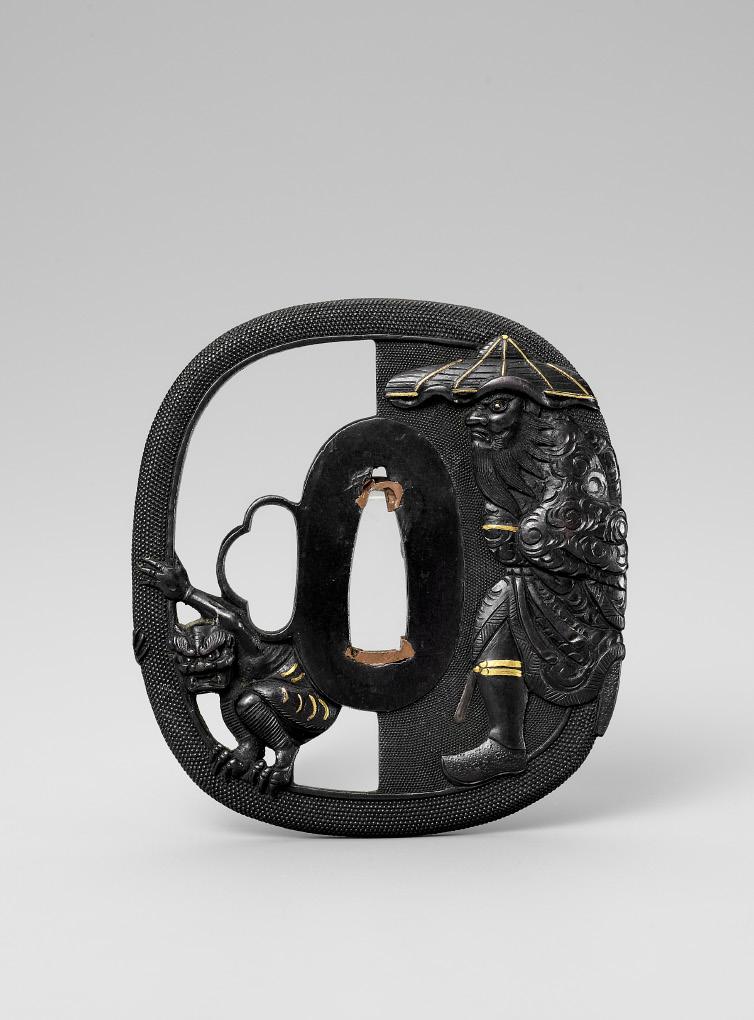
Estimate EUR 2,000
Starting price EUR 1,000
196
KENJO: A BRONZE TSUBA REFERENCING THE LEGEND OF THE MANTIS AND CHARIOT
By Kenjo, signed Kenjo with kakihan Japan, 18th century, Edo period (1615-1868)
Of mokko-gata shape, with a kogai hitsu-ana and some sekigane, the surface pierced with three Genji-mon and worked in iro-e takazogan of shakudo, silver, shibuichi and gold depicting a praying mantis below a leafy vine to the front, the verso showing a cartwheel. Signed to the front KENJO and kakihan. There are two artists listed in the Haynes Index of Japanese Sword Fittings and Associated Artists that signed Kenjo (H 03102.0 & H 03103.0), both are Goto school.
HEIGHT 7.2 cm, LENGTH 7 cm
WEIGHT 142 g
Condition: Excellent condition with minor typical wear.
The mantis is a symbol of courage and strength to overcome all odds. The present tsuba references the popular Chinese legend when Duke Chuang of Ts’i (B. C. 794-731) went hunting and there was a mantis raising its feet and seizing the wheel of his chariot. He questioned his charioteer as to this insect who said in reply: “This is a mantis; it is an insect who knows how to advance but will never know how to retreat; without measuring its strength, it easily offers resistance.” The Duke answered: “Truly, if it were a man, it would be the champion-hero of the empire.” Then he turned his chariot to dodge it, and this act won him all heroes to go over to his side.

Estimate EUR 1,500
Starting price EUR 800
197
AN IRON SUKASHI TSUBA WITH INSECTS AND SNAIL

Unsigned Japan, 17th-18th century, Edo period (1615-1868)
Of octagonal shape, worked in sukashibori with four pleasing triangular apertures to the sides, with a kozuka hitsu-ana, decorated in iro-e takazogan of gold, silver, and copper to both sides depicting a stag beetle, a spider, a snail, a dragonfly, and a cricket amongst viny creepers.
HEIGHT 6.9 cm, LENGTH 6.6 cm
WEIGHT 83 g
Condition: Excellent condition with minor typical wear.
Estimate EUR 1,000
Starting price EUR 500
236
198
KINAI: AN IRON ECHIZEN SUKASHI TSUBA WITH A MYRIAD OF SHELLS

Of marugata shape, finely worked in sukashi with a myriad of various shells, the details rendered in kebori. Signed to the front ECHIZEN ju KINAI saku.
HEIGHT 7.6 cm, LENGTH 7.4 cm
WEIGHT 107 g
Condition: Excellent condition with minor typical wear.
The first Kinai was a student of the Kyoto Shoami school ca. 1650-75. There are a total of eight generations of Kinai and as they all only signed their works Kinai it is very difficult to separate the generations.
Estimate EUR 1,000
Starting price EUR 500
199
MASATOMO: AN IRON SUKASHI TSUBA WITH AUTUMNAL PLANTS

The iron tsuba of marugata shape, with sekigane, finely carved with various autumnal plants including ginkgo, maple, pine, and chestnut. Signed with a gold seal MASATOMO.
HEIGHT 7.3 cm, LENGTH 7.1 cm
WEIGHT 110 g
Condition: Excellent condition with minor typical wear.
Estimate EUR 1,000
Starting price EUR 500
237
By Kinai, signed Echizen ju Kinai saku Japan, Echizen school, 18th century, Edo period (1615-1868)
By Masatomo, signed with gold seal Masatomo Japan, 18th century, Edo period (1615-1868)
200 KIKUCHI SEIJO: A SHAKUDO TSUBA WITH CHINESE LITERATI AND LANDSCAPE
By
Kikuchi Seijo,
signed Kikuchi Seijo with kakihan Japan, 19th century, Edo period (1615-1868)
The shakudo migakiji (polished ground) tsuba of marugata shape, with a kozuka and kogai hitsu-ana and some sekigane, partially worked in sukashi (openwork) and iroe-e takazogan of gold, silver, and copper depicting Chinese literati above a landscape dominated by pagodas, pine trees, reishi clouds, and craggy rocks. Signed to the back KIKUCHI SEIJO with kakihan.
HEIGHT 6.9 cm, LENGTH 6.5 cm
WEIGHT 99 g
Condition: Excellent condition with minor typical wear.
Estimate EUR 1,500 Starting price EUR 800
201 TSUNESHIGE: A FINE SENTOKU TSUBA DEPICTING ARIWARA NO NARIHIRA
By Nara Tsuneshige, signed Tsuneshige Japan, Nara school, second half of 18th century, Edo period (1615-1868)
Published: Heckmann, Günther (1995) Tsuba, no. T79.
The sentoku tsuba of nade-kakugata shape, with a kozuka hitsu-ana, depicting the poet Ariwara no Narihira on horseback by the Tamagawa River, below a pine tree, the image rendered partially in sunken relief and decorated with iro-e takazogan of gold, silver, and copper. Signed to the back TSUNESHIGE.

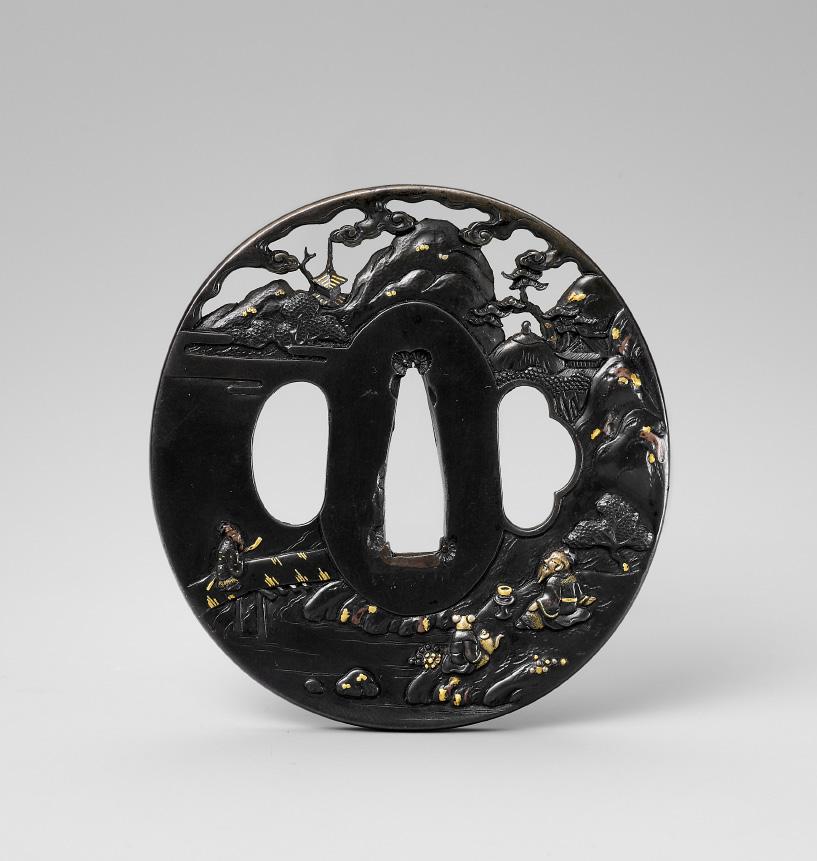
HEIGHT 7.3 cm, LENGTH 6.7 cm
WEIGHT 157 g
Condition: Excellent condition with minor typical wear.
The artist is listed in the Haynes Index of Japanese Sword Fittings and Associated Artists on p. 2125 (H 10905.0) and was trained by Nara Shigetsugu (H 08508.0).
Ariwara no Narihara (825-880) was one of the six great poets of Japan, the “Rokkasen”. After an intrigue at court, he went into exile. He is usually depicted on his journey, either when riding through Sugura on his way to Azukama, or along the river Tamagawa in Yamashiro as in the present piece.
Estimate EUR 2,000
Starting price EUR 1,000
238
202
A RARE SET OF SOTEN SCHOOL SWORD FITTINGS
The tsuba signed Soheishi Nyudo Soten sei Japan, Soten school, late 18th to early 19th century, Edo period (1615-1868)
The set depicting samurai warriors depicted in different attitudes worked in iro-e takazogan, the kozuka and fuchi-kashira with a shakudo nanako ground, the tsuba made of iron. The set consisting of a pair of menuki, a fuchi and kashira, a kozuka, and a tsuba. The tsuba is signed Soheishi Nyudo SOTEN sei.

Tsuba SIZE 7.5 x 7. cm, Kozuka HEIGHT 9.6 cm, Kashira LENGTH 3.7 cm, Menuki LENGTH 2.5 cm
Condition: All in very good condition with minor typical surface wear and minor areas of discoloration.
Estimate EUR 2,500
Starting price EUR 1,200
239
AN IRON TSUBA WITH THE TWELVE ANIMALS OF THE ZODIAC (JUNISHI)

Unsigned Japan, 18th century, Edo period (1615-1868)
Of marugata shape, with a kozuka hitsu-ana and some sekigane, finely worked in iro-e takazogan with gold, silver, copper and shakudo, depicting the twelve animals of the zodiac (junishi) arranged on both sides amongst various grasses.
HEIGHT 6.1 cm, LENGTH 5.8 cm
WEIGHT 70 g
Condition: Excellent condition with minor typical wear.
Estimate EUR 1,500
Starting price EUR 800
204
A FINE AND SMALL KOFU SCHOOL TSUBA DEPICTING A DRAGON
Unsigned Japan, Kofu school, early 19th century, Edo period (1615-1868)
Published: Heckmann, Günther (1995) Tsuba, no. T113.
The maru-bori copper tsuba made for a tanto or aikuchi, the sekigane of white metal, finely worked as a sinuous, three-clawed dragon, its eyes and flames gilt.


HEIGHT 5.3 cm, LENGTH 4.3 cm
WEIGHT 36 g
Condition: Very good condition with minor typical wear.
Estimate EUR 1,200
Starting price EUR 600
240 203
205
SHOZUI: A HAMANO SCHOOL IRON TSUBA WITH DEER, TORII GATE AND PINE
School of Hamano Masayuki (Shozui), signed with gold seal Shozui Japan, Hamano school, 18th century, Edo period (1615-1868)
The large iron tsuba of mokkogata shape, with a kozuka and kogai hitsu-ana and sekigane, finely worked in iro-e takazogan of gold, silver, copper, shakudo and shibuichi, depicting to the front a family of deer below a pine tree and next to a torii gate, the verso with two further deer by a stream below a waterfall. Gold seal to the front SHOZUI.



HEIGHT 8.5 cm, LENGTH 7.9 cm
WEIGHT 162 g
Condition: Excellent condition with minor typical wear.
Provenance: Doyle’s, Asian Works of Art, 20 March 2007, New York, lot 2279 (sold for 1,920 USD). The provenance listed there as St. John’s University.
Estimate EUR 2,500
Starting price EUR 1,200
206 HIROCHIKA: A FINE SENTOKU TSUBA WITH LUNAR HARE

By Hirochika after a design by Tsuchiya Yasuchika, signed Yasuchika zu and Hirochika cho Japan, Nara school, 19th century, Edo period (1615-1868)
The sentoku tsuba of mokko-gata shape, the kozuka and kogai hitsu-ana with silver sekigane and some copper sekigane to the nakago hitsu-ana, finely worked in ito-sukashi depicting a lunar hare looking up at the moon, partially obscured by engraved clouds, all amongst zenmai and bamboo grasses worked in iro-e takazogan. Signed to the front Yasuchika zu, HIROCHIKA cho [engraved by Hirochika, after a design by Yasuchika].
HEIGHT 7.3 cm, LENGTH 6.7 cm
WEIGHT 81 g
Condition: Very good condition with minor typical wear, some light scratches and bruising.
AUCTION COMPARISON
Compare a closely related tsuba with a similar design, with gold seal Hirochika, at Lempertz, Asian Art, 11 December 2021, Cologne, lot 259a (sold for 5,000 EUR).
Estimate EUR 2,500
Starting price EUR 1,200
241
HIRATA HARUAKI: A RARE ENAMELLED IRON TSUBA WITH INSECT DESIGN
 By Hirata Haruaki, signed Hirata Haruaki Japan, Hirata school, c. 1880, Meiji period (1868-1912)
By Hirata Haruaki, signed Hirata Haruaki Japan, Hirata school, c. 1880, Meiji period (1868-1912)
Published: Heckmann, Günther (1995) Tsuba, no. T76.
The iron tsuba of marugata shape, the ground finely worked in mokume resembling tree bark, inlaid with seven various insects to both sides executed in gold wire and predominantly emerald green translucent enamels with some white, purple, and yellow. Signed to the front HIRATA HARUAKI.


HEIGHT 7.4 cm, LENGTH 7.2 cm
WEIGHT 142 g
Condition: Excellent condition. The enamels are all intact with some very light pitting and manufacturing flaws.
The artist is listed in the Haynes Index of Japanese Sword Fittings and Associated Artists on p. 198 (H 00765.0) and is said to be the student and later coworker of Hirata Haruyuki (H 00939.0).
Estimate EUR 2,500
Starting price EUR 1,200
By Kawarabayashi Tenkodo Hidekuni (1825-1891), signed Tenkodo Hidekuni with kakihan Japan,
second half of 19th century
Published: Heckmann, Günther (1995) Tsuba, no. T119
The shakudo migakiji (polished ground) tsuba of marugata shape, the kozuka and kogai hitsu-ana with ategane, with some sekigane, decorated with a flock of cranes above pine and idyllic huts by the water, in polychrome enamels with gold hirazogan appearing like gold lacquer painting. Signed to the verso TENKODO HIDEKUNI and kakihan.
HEIGHT 7.1 cm, LENGTH 6.8 cm
WEIGHT 125 g
Condition: Good condition with some discoloration, scratches and general wear to the ground, some light pitting to enamels.
The artist is listed in the Haynes Index of Japanese Sword Fittings and Associated Artists on page 242 (H 01054.0). He lived in Kyoto and was a student and adopted son of Kawarabayashi Hideoki. He was conferred the art name of Tenkodo by the emperor Komei and was also famous for his paintings, the execution of the tsuba here being reminiscent of a painting.
Crane and pine are both auspicious and together indicate a wish for good fortune.
Estimate EUR 2,500
Starting price EUR 1,200
242 207
208
TENKODO HIDEKUNI: A FINE ENAMELLED SHAKUDO TSUBA WITH CRANES AND PINE
209
A SOTEN SCHOOL IRON TSUBA WITH BIRDS AND AUTUMN GRASSES
Signed Hikone no ju Soten Japan, 18th century, Edo period (1615-1868)
The large iron tsuba of marugata shape, the kozuka hitsu-ana with ategane in migakiji shakudo, with some sekigane, worked in very fine iro-e takazogan of gold, silver, copper, and shibuichi depicting to one side crows descending from clouds towards rich autumn flowers and grasses, the verso showing further clouds and a group of sparrows, one of them landing on one of the grasses. Signed to the front Hikone no ju SOTEN.

HEIGHT 8.6 cm, LENGTH 8.4 cm
WEIGHT 168 g
Condition: Excellent condition with minor typical wear.
Estimate EUR 2,000
Starting price EUR 1,000
210 RYUMEISHI KAZUHIDE: A FINE SHIBUICHI TSUBA WITH SPRING FLOWERS AFTER RAIN

By Ryumeishi Kazuhide, signed Ryumeishi Kazuhide to Japan, Goto school, Ichijo school, late 19th century
The tanto-sized shibuichi tsuba of mokkogata shape, the surface beautifully polished, with a kozuka hitsu-ana, superbly decorated in iro-e takazogan of gold, silver, shakudo, silver, and shibuichi depicting autumnal flowers after rain, indicated by silver-inlaid dew drops, including poppies, valerian, and chrysanthemums. Signed to the back RYUMEISHI KAZUHIDE to [carved by Ryumeishi Kazuhide].
HEIGHT 6.7 cm, LENGTH 6.4 cm
WEIGHT 111 g
Condition: Very good condition, some minor wear.
The artist is listed in the Haynes Index of Japanese Sword Fittings and Associated Artists on p. 619 (H 02984.0).
Estimate EUR 2,000
Starting price EUR 1,000
243
211
A RARE SHAKUDO NANAKO HAMIDASHI TSUBA
Unsigned Japan, 19th century, Edo period (1615-1868)
The hamidashi tsuba (with the hitsu-ana open to one side) crafted for a tanto, worked in superb shakudo nanako and decorated in gold and copper takazogan with a flute, the gilt rim formed by a long, tied cord attached to a cloth embellished with a gold hirazogan brocade design. A simple, yet beautifully constructed and elegant design.

HEIGHT 5.6 cm, LENGTH 3.9 cm
WEIGHT 64 g
Condition: Very good condition, minor expected wear, few minuscule nicks.
Estimate EUR 1,500
Starting price EUR 800
212
TOSHITERU: A FINE SHAKUDO TSUBA WITH DEER


By Takeshi Toshiteru, signed Toshiteru with kakihan Japan, Tanaka school, c. 1850, Edo period (1615-1868)
The shakudo marugata tsuba of tanto size, beautifully worked with an ishimeji ground, decorated in iro-.e takazogan of gold, copper, shibuichi and silver, depicting two deer standing on a craggy outpost with clouds and pine below, the verso with a silver full moon partly obscured by clouds and further pines on a hilly landscape below. Signed to the front TOSHITERU with kakihan (artist’s cursive monogram) and with a lengthy inscription to the back: 於東府城南、芝海里作之 Tofu jonan nite, Shiba kairi tsukuru kore [This is made at the Shiba bay area, the south of Edo Castle, Tokyo (Eastern capital)].
HEIGHT 6.1 cm, LENGTH 5.6 cm
WEIGHT 82 g
Condition: Very good condition, minor expected wear, few minuscule nicks.
The artist is listed in the Haynes Index of Japanese Sword Fittings and Associated Artists on page 2075 (H 010593.0) and was a pupil of the Tanaka school.
Estimate EUR 2,000
Starting price EUR 1,000
244
214
SASAYAMA TOKUOKI: A GORGEOUS SHAKUDO
NANAKO TSUBA WITH HOLLYHOCK AND INSECTS
By Sasayama Tokuoki (1813-1891), signed Tokuoki and kakihan Japan, Otsuki school, c. 1860
Of tanto size and rounded rectangular shape, the shakudo tsuba with a kozuka hitsu-ana, bearing a masterfully executed nanako ground along the rim as well, worked in superb iro-e takazogan of rich gold and shakudo, depicting on one side a leafy hollyhock trained on a bamboo stem and to the other two crickets with long antennae. Signed to the back TOKUOKI with the artist’s kakihan (cursive monogram).
HEIGHT 6 cm, LENGTH 5.1 cm
WEIGHT 92 g
213
MASANAGA: A FINE SHAKUDO NANAKO TSUBA WITH AUTUMN PLANTS AND INSECTS
By Masanaga, signed Bushu no ju Masanaga Japan, 19th century, Edo period (1615-1868)
The shakudo tsuba of marugata shape, with a kozuka and kogai hitsu-ana, bearing a superbly executed nanako ground along the rim as well, worked in glamorous iro-e takazogan of gold, copper, silver, shibuichi and shakudo depicting a praying mantis and several different crickets amongst autumn grasses and flowers. Signed to the front Bushu no ju Masanaga – possibly an Ito school artist working in the Goto style.
HEIGHT 7.6 cm, LENGTH 7.1 cm
WEIGHT 158 g
Condition: Excellent condition with minor typical wear.
Estimate EUR 2,000
Starting price EUR 1,000
Condition: Excellent condition.
The artist is listed in the Haynes Index of Japanese Sword Fittings and Associated Artists on page 1948 (H 09786.0). He belonged to the renowned Otsuki School and had studied with Kawarabayashi Hideoki, who was the best student of master Otsuki Mitsuoki. Tokuoki received orders for making the fittings of a sword worn by the Tokugawa Shogun, for which he was rewarded with the honorary title of Osumi no Jo. The year after, in 1863, he had the honor of making sword fittings for Emperor Komei and was given the art name Ikkosai on this occasion.
AUCTION COMPARISON
Compare to another tsuba by the artist, dated 1868 and signed Ikkosai Tokuoki sei, at Christie’s, Japanese and Korean Art, 20 March 2007, New York, lot 267 (sold for 20,400 USD).




Estimate EUR 3,000
Starting price EUR 1,500
245
215
A SUPERB MINO-GOTO SCHOOL
NANAKO SHAKUDO TSUBA DAISHO SET WITH INSECTS AND SPRING FLOWERS

Unsigned Japan, Mino-Goto school, c.1800, Edo period (1615-1868)
Published: Heckmann, Günther (1995) Tsuba, no. T40

The daisho pair of mokkogata shape, each with a kozuka hitsuana and kogai hitsu-ana with gold ategane, the design masterfully worked in low relief in rich gold, silver and shakudo against a
superb nanako ground, depicting a spring flower scene of mostly chrysanthemums, the leaves with copper dew drops, and various insects including dragonflies, praying mantis, butterflies, and crickets.
SIZE 8.2 x 7.6 cm & 7.7 x 7.1 cm
WEIGHT 138 and 158 g
Condition: Excellent condition with minor typical wear.
Estimate EUR 6,000
Starting price EUR 3,000
MASAYOSHI: A SUPERB ISHIGURO SCHOOL NANAKO SHAKUDO TSUBA DAISHO SET WITH CROWS AND OWLS


By Masayoshi, signed Masayoshi with kakihan
Japan, Ishiguro school, c. 1800, Edo period (1615-1868)
The daisho pair of marugata shape, each with a kozuka hitsu-ana and kogai hitsu-ana, with some sekigane, masterfully worked with a shakudo nanako ground also covering the rim, decorated in superb iro-e takazogan with gold, shibuichi, copper, and shakudo depicting crows in flight and an owl perched on a branch covered in leafy vines. Each signed to the back MASAYOSHI with kakihan (cursive monogram).
SIZE 7.8 x 7.3 cm & 7.4 x 6.9 cm
WEIGHT 147 and 174 g
Condition: Excellent condition with minor typical wear.
Estimate EUR 6,000
Starting price EUR 3,000
216
SUZUKI KATSUHIRO: A MASTERFUL IRON TSUBA DEPICTING CARPS

 By Suzuki Katsuhiro I (1827-1886), signed Suzuki Katsuhiro saku Suifu no ju
By Suzuki Katsuhiro I (1827-1886), signed Suzuki Katsuhiro saku Suifu no ju
Japan, Mito school, second half of 19th century
Published: Heckmann, Günther (1995) Tsuba, no. T79
Of kawari-kakugata shape, the iron tsuba worked in splendid openwork, depicting a total of six carps in various attitudes forming a dense composition, each with gilt eyes and masterfully engraved scales and fins. Signed to the front SUZUKI KATSUHIRO saku Suifu no ju.
HEIGHT 8.9 cm, LENGTH 7.9 cm
WEIGHT 218 g
Condition: Excellent condition with minimal wear to exposed areas.
Suzuki Katsuhiro Dembei (1827-1886), listed in the Haynes Index of Japanese Sword Fittings and Associated Artists on pp. 577-578 (H 02766.0), was the first child of Hagiya Katsuhira and entered the Suzuki family after marriage. He worked in Mito first and then, after the ban on carrying swords, in Tokyo.
The carp is an important symbol of strength and perseverance in Japan.
Estimate EUR 10,000
Starting price EUR 5,000
248 217

TOSHINAGA: A SUPERB AND LARGE IRON TSUBA WITH EAGLE
Signed Toshinaga with kakihan Japan, Nara school, Meiji period (1868-1912)
The massive iron tsuba worked in partial openwork, the surface formed as a large rock, an eagle descending from above, its feathers minutely detailed and eyes gilt, searching for the monkey, worked in silvered copper, which hides within a little cave below and screeches up at its predator. The verso shows the underside of the eagle with gilt feet and the back of the monkey. Signed to the front TOSHINAGA and kakihan (artist’s monogram).


HEIGHT 10.5 cm, LENGTH 9.5 cm
WEIGHT 342 g
Condition: Excellent condition with minor wear.
Provenance: Old French private collection, purchased 12 March 1968. Old label to the reverse. The sekigane stamped ‘583’.
Estimate EUR 8,000
Starting price EUR 4,000
250
218
AND MONKEY

HAMANO NORIYUKI II: A MASTERFUL IRON TSUBA DEPICTING A MONKEY AND CRESCENT MOON

 By Hamano Noriyuki II (1771-1852), signed Noriyuki Japan, Hamano school, late 18th to early 19th century, Edo period (1615-1868)
By Hamano Noriyuki II (1771-1852), signed Noriyuki Japan, Hamano school, late 18th to early 19th century, Edo period (1615-1868)
Published: Heckmann, Günther (1995) Tsuba, no. T98.
Of nade-kakugata shape, the iron tsuba with a kozuka hitsu-ana, masterfully worked in gold, silver, and copper takazogan, as well as minute katakiri-bori engraving with a monkey seated in a relaxed pose on a rocky outpost, some gold leaves above him and creepers growing along the rock, the reflection of a silver crescent moon below, the still water suggested by the superbly polished surface. The verso shows an engraved pine tree in the rain as well as the signature NORIYUKI.
HEIGHT 8.1 cm, LENGTH 7.4 cm
WEIGHT 146 g
Condition: Excellent condition with minor wear.
Hamano Noriyuki II (1771-1852) had already been named a master at the age of 16. His work was strongly oriented towards the work of Noriyuki I, a pupil of the famous Hamano Masayuki.
Estimate EUR 10,000
Starting price EUR 5,000
252 219

MIBOKU MASAYUKI: A MASTERFUL IRON TSUBA DEPICTING FUTEN
 By Miboku Masayuki (Gyokkei, 1696-1769), signed Miboku Masayuki Japan, Hamano school, 18th century, Edo period (1615-1868)
By Miboku Masayuki (Gyokkei, 1696-1769), signed Miboku Masayuki Japan, Hamano school, 18th century, Edo period (1615-1868)
Published: Heckmann, Günther (1995) Tsuba, no. T99.

Of nade-kakugata shape, the iron tsuba with a kozuka hitsu-ana and with silver sekigane, worked in a myriad of techniques in perfect harmony, including iro-e takazogan of gold, silver and suaka, katakiri-bori, and gold nonume-zogan. The wind god Futen is depicted in a dramatic manner as a two-horned demon clutching a tama pearl, his windbag adorned with thunder crests releasing billowing clouds, the back showing his celestial scarf as well as two claws within the clouds. Signed to the back MIBOKU MASAYUKI.
HEIGHT 8 cm, LENGTH 7.3 cm
WEIGHT 162 g
Condition: Excellent condition with minor wear.
Miboku Masayuki (Gyokkei) (1696-1769) was a pupil of Nara Toshinaga I and the famous founder of the artist family and school of Hamano. Together with Toshinaga, Joi and Yasuchika, he is regarded to be one of the “Four Great Nara-Masters”.
Estimate EUR 15,000
Starting price EUR 8,000
254 220

TOSHINAGA: A SUPERB SUAKA TSUBA DEPICTING SHOKI
Signed Toshinaga with kakihan Japan, Nara school, Meiji period (1868-1912)
The suaka (copper) tsuba depicting the demon queller with grim expression, the beard minutely engraved in katakiri-bori, the eyes of silver with shakudo pupils. Shoki lifts up the hem of his robe, producing finely worked folds, and draws his silver sword. Some details worked in gold. The back with the signature TOSHINAGA.


HEIGHT 8.5 cm, LENGTH 8.5 cm
WEIGHT 228 g
Condition: Very good condition with minor wear and discoloration. Some green verdigris.
Provenance: Old French private collection.
Estimate EUR 5,000
Starting price EUR 2,400
256
221
222 ISHIGURO KORETSUNE: A SUPERB IRON TSUBA WITH RAKAN
By Ishiguro Koretsune, signed Ishiguro Koretsune Japan, Ishiguro school, c. 1850, Edo period (1615-1868)
The iron tsuba of mokkogata shape with a kogai hitsu-ana, with copper sekigane, decorated in ito-sukashi, iro-e takazogan of gold, sentoku, and copper, depicting a dramatic image of a rakan surrounded by a halo and holding up a gold image of Buddha on a lotus throne, a three-star constellation above. The verso shows an oni mask and a gold cartouche housing the signature ISHIGURO KORETSUNE. The character Dai 大 (great) is carved several times into the composition.



HEIGHT 9.2 cm, LENGTH 8.5 cm
WEIGHT 167 g
Condition: Excellent condition with minor expected wear.
The artist is listed in the Haynes Index of Japanese Sword Fittings and Associated Artists on pp. 721-722 (H 03488.0) and was a son of the first Masatsune (H 04751.0), founder of the famous Ishiguro school.
Estimate EUR 5,000
Starting price EUR 2,400
257
HAGIYA KATSUHIRA: A FINE IRON TSUBA WITH FUJIN AND GEISHA

 By Hagiya Katsuhira (1804-1886), signed Seiryoken Suimin with kakihan Japan, Mito school, c. 1860
By Hagiya Katsuhira (1804-1886), signed Seiryoken Suimin with kakihan Japan, Mito school, c. 1860
Of rounded square shape, with some sekigane, decorated in superb iro-e takazogan of sentoku, gold, silver and shibuichi depicting an amusing scene of the Wind God Fujin releasing gusts of wind from his bag in order to lift the kimono of a Geisha who bends over protecting herself struggling to keep her modesty. Fujin’s expression is carved with intricate detail, lustfully awaiting results, the eyes of gold with shakudo pupils. The verso shows a man seeking cover from the wind, worked in copper hirazogan with katakiri details. Signed to the back in fluent calligraphy SEIRYOKEN SUIMIN and with the artist’s kakihan (cursive monogram). Seiryoken is the art name of Hagira Katsuhira and Suimin 醉眠 literally means ‘drunken sleepy man’.

HEIGHT 8.3 cm, LENGTH 7.3 cm
WEIGHT 181 g
Condition: Very good condition with minor wear, some light surface scratches and discoloration.
Provenance: Austrian private collection, Vienna, purchased at Dorotheum, Asian Art, 26 April 1994.
Hagiya Katsuhira, art name Seiryoken, is recorded in the Haynes Index of Japanese Sword Fittings and Associated Artists on p. 566 (H 02759.0). In 1844, the Matsudaira Daimyo of Mito Domain appointed him an official metal artist to the Tokugawa government.
AUCTION COMPARISON
Compare a related iron tsuba by the same artist, signed Seiryoken Katsuhira, at Bonhams, The Edward Wrangham Collection of Japanese Art Part II, 10 May 2011, London, lot 44 (sold for 4,200 GBP).
Estimate EUR 4,000
Starting price EUR 2,000
258
223
224 OTSURYUKEN MIBOKU: A FINE HAMANO SCHOOL IRON TSUBA WITH ONI NEMBUTSU DESIGN
HEIGHT 8.8 cm, LENGTH 8.3 cm
WEIGHT 184 g
By Otsuryuken
Miboku, signed Otsuryuken Miboku saku Japan, Hamano school, second half of 19th century
The iron tsuba of marugata shape, decorated in relief with highlights of gold, silver, and copper, depicting a repentant oni (oni nembutsu) with neatly detailed features, caught in the wind, his umbrella flying away and several ginkgo leaves flying about. The verso shows a dog carved into the design in sunken relief barking up at the falling ginkgo leaves, the visible eye gilt. Signed to the back OTSURYUKEN MIBOKU saku [made by Otsuryuken Miboku] – a Hamano school metal artist.




Condition: Excellent condition with minor typical wear.
AUCTION COMPARISON
Compare to a closely related iron tsuba, Hamano school and signed Otsuryuken Miboku, at Bonhams, Fine Japanese Art, 14 May 2015, London, lot 148 (estimate 3,800-4,500 GBP).
Estimate EUR 4,000
Starting price EUR 2,000
259
KAZUTOMO: A RARE SENTOKU TSUBA FORMED AS A TANUKI TEA KETTLE
 By Kazutomo, signed Kazutomo Japan, 19th century
By Kazutomo, signed Kazutomo Japan, 19th century
The sentoku tsuba formed as the tanuki kettle with amusing expression, from the famous folktale Bunbuku-Chagama, the head and bushy tail carved to the sides, the details picked out in gilt and fine katakiri-bori. Two looped metal handles to either side. Signed KAZUTOMO.
HEIGHT 7.9 cm, LENGTH 8.4 cm
WEIGHT 152 g
Condition: Excellent condition with minor typical wear. Provenance: OId French private collection, old label ‘T50’ to one side.
The popular folktale Bunbuku-Chagama tells of a tanuki being mistreated as a tea kettle at a temple, before being sold off and bringing great wealth to its new owner using its shapeshifting powers.

Estimate EUR 2,500
Starting price EUR 1,200
226 A FINE HAMANO SCHOOL SHAKUDO KOZUKA WITH SANJO MUNECHIKA FORGING THE FOX BLADE
Attributed to Hamano Noriyuki II (1771-1852), unsigned Japan, Hamano school, 19th century, Edo period (1615-1868)
The shakudo kozuka bearing a ishimeji ground beautifully worked in iro-e takazogan of gold, silver, shakudo and copper depicting the swordsmith Sanjo Munechika forging the blade Kogitsunemaru (‘Little Fox’), assisted by the fox deity Inari in disguise, the reverse with flush gold inlay of wavy lines to the polished ground, the top and bottom gilt.

HEIGHT 9.8 cm
WEIGHT 38 g
Condition: Excellent condition.
With a padded wood tomobako storage box and old label reading: 小柄 小鍛治 東龍齋 “Kozuka, Kokaji, Toryusai” – indicating the Hamano school artist Hamano Toryusai Noriyuki (1771-1852, H 07455.0).
Estimate EUR 2,000
Starting price EUR 1,000
Woodblock print by Ogata Gekko, Inari and their fox spirits help the blacksmith Munechika forge the blade kogitsune-maru (Little Fox) in the late 10th century. This legend is the subject of the Noh drama Sanjo Kokaji.
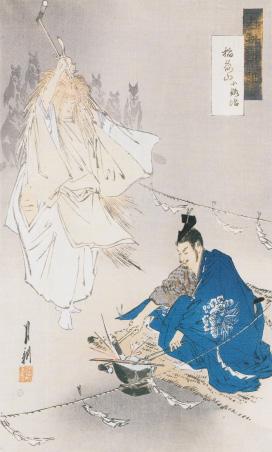
225
227
YOKOYA SOMIN: A SUPERB SHIBUICHI KOZUKA WITH HOTEI SLEEPING
By Yokoya Somin III, signed Somin and kakihan Japan, Yokoya school, first half of 19th century, Edo period (1615-1868)
The shibuichi tsuba masterfully worked in iro-e takazogan with solid gold, shakudo, shibuichi and copper, depicting the lucky god Hotei sleeping blissfully enveloped by his treasure bag, fan, and gnarly staff. The details are superbly crafted and the gold is of a remarkable quality. Signed to the back SOMIN and kakihan (artist’s cursive monogram).
LENGTH 9.7 cm
WEIGHT 39 g
Condition: Excellent condition.
With a padded wood tomobako storage box bearing an attestation by Unno Kiyoshi (1884-1956) to the interior cover:
横谷宗珉作、眠布袋色繪高彫小柄、海野清、極 “Yokoya Somin, nemuri hotei iroe takabori kozuka, Unno Kiyoshi, with the seal Kiwame” [Made by Yokoya Somin, a Kozuka with the design of sleeping Hotei finished in colored metal in high relief, authenticated by Unno Kiyoshi, with the seal “kiwame” which means “attested”]
The artist is listed in the Haynes Index of Japanese Sword Fittings and Associated Artists on page 1774 (H 08919.0) and is a direct descendant of Yokoya Somin I (1670-1733) and as a student of Goto Mitsumori at the age of 29.
AUCTION COMPARISON
Compare another kozuka by the artist, signed Somin with an identical kakihan, with Tokubetsu Kicho papers (especially precious sword fitting), at Bonhams, Arts of the Samurai, 27 October 2021, New York, lot 70 (sold for 5,355 USD).


Estimate EUR 2,000
Starting price EUR 1,000
228
A FINE SHAKUDO KOZUKA WITH TEKKAI SENNIN
Signed Minamoto Sensai (Gensensai)
Japan, 19th century, Edo period (1615-1868)


Of shakudo migakiji (polished ground), finely worked in iro-e takazogan of gold, copper, shakudo, and shibuichi depicting the Daoist immortal Tekkai (Lie Tieguai) exhaling is anima. The top and bottom with a gilt fitting, the back signed Minamoto Sensai (Gensensai) with kakihan.
HEIGHT 9.7 cm
WEIGHT 29 g
Condition: Excellent condition.
Estimate EUR 1,500
Starting price EUR 800
261
229
TSUCHIYA SHOMIN: A FINE SHIBUICHI KOZUKA WITH NIO GUARDIAN
By Tsuchiya Shomin, signed Tounsai Tsuchiya Shomin Japan, Tsuchiya school, mid-19th century, Edo period (1615-1868)
Worked in takazogan and partly silvered, depicting a dramatic rendition of a Nio guardian with gold eyes, shakudo pupils, and copper tongue. The reverse signed Tounsai TSUCHIYA SHOMIN.

HEIGHT 9.6 cm
WEIGHT 28 g
Condition: Very good condition with minor wear and some discoloration.
With a padded wood tomobako storage box and attestation naming the artist and his achievements.
The artist is listed in the Haynes Index of Japanese Sword Fittings and Associated Artists on p. 1735 (H 08760.0). He was a student of the Kikugawa family school and of the fifth Yasuchika, Kunichika (H 11108.0). He was also a preparer to Kunichika and called himself, and signed, as Yasuchika.
AUCTION COMPARISON
Compare a related kozuka with the same design, attributed to Iwama Masayoshi, at Bonhams, Fine Japanese Art, 12 May 2011, London, lot 4 (sold for 3,600 GBP).

Estimate EUR 2,000
Starting price EUR 1,000
230
A YOKOYA SCHOOL SHIBUICHI KOZUKA DEPICTING OKAME

Unsigned Japan, Yokoya school, 18th-19th century, Edo period (1615-1868)
The shibuichi kozuka finely worked in sunken relief with fine katakiri and kebori, as well as gold highlights, depicting the Shinto goddess of mirth Okame, laughing, and holding a hiogi (court fan). The back with neatly engraved designs.
HEIGHT 9.7 cm
WEIGHT 36 g
Condition: Excellent condition, minor wear.
Estimate EUR 1,200
Starting price EUR 600

IWAMOTO KONKAN: A FINE IWAMOTO SCHOOL SHIBUICHI KOZUKA WITH SHITENNO
School of Iwamoto Konkan (1744-1801), signed Iwamoto Konkan Japan, Iwamoto school, late 18th to early 19th century, Edo period (1615-1868)
The shibuichi kozuka very finely worked in iro-e takazogan of gold, silver, copper and shakudo depicting one of the Shitenno (Four Heavenly Kings) upon a cloud, holding a staff and raising a gold dharma wheel. Signed to the back IWAMOTO KONKAN.


HEIGHT 9.8 cm
WEIGHT 34 g
Condition: Excellent condition, minor wear. Provenance: From the collection of Felix Tikotin, and thence by descent within the family. Felix Tikotin (1893-1986) was an architect, art collector, and founder of the first Museum of Japanese Art in the Middle East.
Iwamoto Konkan is listed in the Haynes Index of Japanese Sword Fittings and Associated Artists on pp. 716-717 (H 03464.0).
Estimate EUR 1,200
Starting price EUR 600 232
Felix Tikotin (1893-1986), center, in front of his gallery in Berlin

A FINE YOKOYA SCHOOL SHIBUICHI KOZUKA DEPICTING JUROJIN AND CRANE

Unsigned Japan, Yokoya school, 18th-19th century, Edo period (1615-1868)
The migakiji (polished ground) shibuichi tsuba finely worked in sunken relief with gold highlights, depicting the lucky god Jurojin holding a scroll, a neatly incised pine tree above and the back with a crane with gold eye. The details engraved in katakiribori.
HEIGHT 9.7 cm
WEIGHT 27 g
Condition: Excellent condition, minor wear, some minute nibbling to edges.
Estimate EUR 1,200
Starting price EUR 600
231
233
A FINE GOTO SCHOOL SHAKUDO AND GOLD NANAKO KOZUKA WITH DRAGON CHASING TAMA
Unsigned Japan, 18th-19th century, Edo period (1615-1868)
Of shakudo, the front bearing a fine gold nanako ground and worked in shakudo takazogan with a sinuous dragon chasing after a tama pearl, the scales neatly incised, clutching the sacred jewel in one three-clawed hand.
LENGTH 9.8 cm
WEIGHT 31 g
Condition: Very good condition with minor typical wear, some green verdigris to the back.
With a padded wood tomobako storage box.
AUCTION COMPARISON
Compare a related shakudo nanako kozuka, by Goto Mitsutaka, depicting a tiger and dragon, at Zacke, Fine Japanese Art, 2 December 2022, Vienna, lot 156 (sold for 2,860 EUR).



Estimate EUR 1,500
Starting price EUR 800
234
OMORI TERUMASA: A FINE SHAKUDO NANAKO KOZUKA WITH ISE-EBI (SPINY LOBSTERS)
By Omori Terumasa (1705-1772), signed Terumasa with kakihan Japan, Omori school, 18th century, Edo period (1615-1868)
Of shakudo, the front bearing a fine nanako ground and worked in gold and shakudo takazogan depicting two spiny lobsters (ise-ebi), a popular new year’s delicacy, the details superbly crafted. Signed to the back TERUMASA with the artist’s kakihan (cursive monogram).
LENGTH 9.8 cm
WEIGHT 32 g
Condition: Excellent condition, minor wear.
The artist is listed in the Haynes Index of Japanese Sword Fittings and Associated Artists on pp. 1909-1910 (H 09587.0).

AUCTION COMPARISON
For another shakudo nanako kozuka by the same artist, with Tokubetsu Kicho (especially precious sword fitting), see Bonhams, The Paul Goodman Collection of Japanese Arrowheads, Swords and Fittings Part I, 20 October 2015, New York, lot 163 (sold for 3,500 USD).
Estimate EUR 1,500
Starting price EUR 800
264
School of Tamagawa Yoshihisa, signed Tamagawa Yoshihisa and kakihan
Japan, Mito school 18th-19th century, Edo period (1615-1868)
Of copper and finely worked in nanako and decorated in shakudo takazogan with writing dragons with gold eyes, flames, and claws. Signed underneath the fuchi on the shakudo plate TAMAGAWA YOSHIHISA and kakihan (artist’s cursive monogram).

LENGTH 3.9 cm
WEIGHT 38 g
Condition: Excellent condition, minor wear.
Tamagawa Yoshihisa is listed in the Haynes Index of Japanese Sword Fittings and Associated Artists on pp. 2267-2268 (H 11642.0) and is also mentioned in the Soken Kisho of 1781. Haynes lists a total of five generations.
Estimate EUR 1,500
Starting price EUR 800
School of Iwamoto Konkan (1744-1801), signed Iwamoto Konkan and kakihan
Japan, Iwamoto school, late 18th to early 19th century, Edo period (1615-1868)
Of shakudo, each bearing a fine nanako ground and worked in copper and gold takazogan with spiny lobsters (ise-ebi), a popular New Year’s delicacy. Signed underneath the fuchi IWAMOTO KONKAN and kakihan (artist’s cursive monogram).

LENGTH 4 cm
WEIGHT 43 g
Condition: Excellent condition, minor wear.
Iwamoto Konkan is listed in the Haynes Index of Japanese Sword Fittings and Associated Artists on pp. 716-717 (H 03464.0).
Estimate EUR 1,500
Starting price EUR 800
265
235 TAMAGAWA YOSHIHISA: A COPPER NANAKO MITO SCHOOL FUCHI AND KASHIRA WITH DRAGONS
236 IWAMOTO KONKAN: A FINE IWAMOTO SCHOOL FUCHI AND KASHIRA WITH ISE-EBI (SPINY LOBSTERS)
237
HIDEMASA: A FINE SHAKUDO NANAKO FUCHI AND KASHIRA WITH BISHAMONTEN PURSUING AN ONI
Signed Kawakami Hidemasa Japan, 18th-19th century, Edo period (1615-1868)
Of shakudo, each bearing a fine nanako ground, the kashira finely worked in gold and shakudo takazogan depicting an oni fleeing with a stolen pagoda, the lucky god Bishamonten, finely worked in iro-e takazogan of gold, silver, and shakudo, in pursuit of the demon on the kashira, both floating on reishi-shaped clouds. Signed underneath KAWAKAMI HIDEMASA (Shusei) – the artist appears to be unrecorded.
LENGTH 4 cm
WEIGHT 36 g
Condition: A small dent to the fuchi, otherwise good condition with minor typical wear.
Estimate EUR 1,500
Starting price EUR 800
Bishamonten pursuing an oni, Hashimoto Gaho, c. 1885, Philadelphia Museum of Art, accession no. 1941-107-15

238
INAGAWA NAOKATSU: A LARGE AND RARE IRON FUCHI AND KASHIRA DEPICTING SHOKI AND FUJIN


By Inagawa Naokatsu (1719-1761), signed Inagawa Naokatsu with kakihan Japan, 18th century, Edo period (1615-1868)
Boldly carved in relief as the demon queller Shoki, visible on the fuchi, depicted in motion and fighting against the storm sent down by the Wind God Fuijin, depicted here as an oni and enveloped in thick clouds. Signed underneath INAGAWA NAOKATSU with the artist’s kakihan (cursive monogram).
LENGTH 4 cm
WEIGHT 78 g
Condition: Excellent condition with minor typical wear.
The artist is listed in the Haynes Index of Japanese Sword Fittings and Associated Artists on pp. 1321-1322 (H 06652.0). He was a student of Inagawa Shigeyoshi and signed with both the Inagawa and Yanagawa family names.
Estimate EUR 1,200
Starting price EUR 600
266
239
YASUKUNI: A SHAKUDO FUCHI AND KASHIRA DEPICTING TAIRA NO TADAMORI AND THE OIL THIEF

 By Genjiro Yasukuni, signed Yasukuni
By Genjiro Yasukuni, signed Yasukuni
Japan, Mito school, 19th century, Edo period (1615-1868)
Published: Cuba - záštita japonského meče, Tsuba - the Japanese sword guard (2010), p. 139.
Of shakudo, finely worked in iro-e takazogan of shakudo, copper, silver, and gold depicting Taira no Tadamori (1096-1163) capturing the Oil Thief Abura Bozu with fierce expression. The fuchi is decorated with a lantern and a pine tree, the details picked out in gold and katakiribori. Signed underneath YASUKUNI.
LENGTH 3.9 cm
WEIGHT 45 g
Condition: Excellent condition with minor typical wear. With an associated wood tomobako storage box.
The artist is listed in the Haynes Index of Japanese Sword Fittings and Associated Artists on p. 2196 (H 11166.0).
Estimate EUR 1,500
Starting price EUR 800
240
HAMANO MASAYUKI: A FINE HAMANO SCHOOL SHIBUICHI FUCHI AND KASHIRA WITH HORSES
By Hamano Masayuki (Shozui, 1696-1769), signed Shuhosai Masayuki (Shozui) gyorei rokujuroku Japan, Hamano school, c. 1762, Edo period (1615-1868)
Each finely engraved in katakiri-bori with highlights and inlay of gold and depicting expressively carved, frolicking horses. Signed to the underside Shuhosai MASAYUKI (Shozui) gyorei rokujuroku [Made by Masayuki (Shozui), art name Shuhosai, at the age of 66].
With a wood tomobako storage box with attestation by Sato Kanzan (1907-1978): Oborogin ji katakiri bori zogan, Hamano Masayuki (Shozui) saku, Meiji sanjuunen yanagitsuki (ryugetsu) hi, Kanzan with his seal [This is a work by Hamano Masayuki (Shozui), made of shibuichi, finished in the katakiri-bori engraving with inlay work, attested by Kanzan (Sato Kanzan: 1907-1978), on a day in January in Showa 30 (1955), with a seal].
LENGTH 3.7 cm
WEIGHT 25 g
Condition: Excellent condition with minor and typical wear.
Estimate EUR 1,200
Starting price EUR 600
267
241
TANAKA SOKAKU: A FINE SHAKUDO NANAKO FUCHI AND KASHIRA WITH WINGED DRAGON FISH
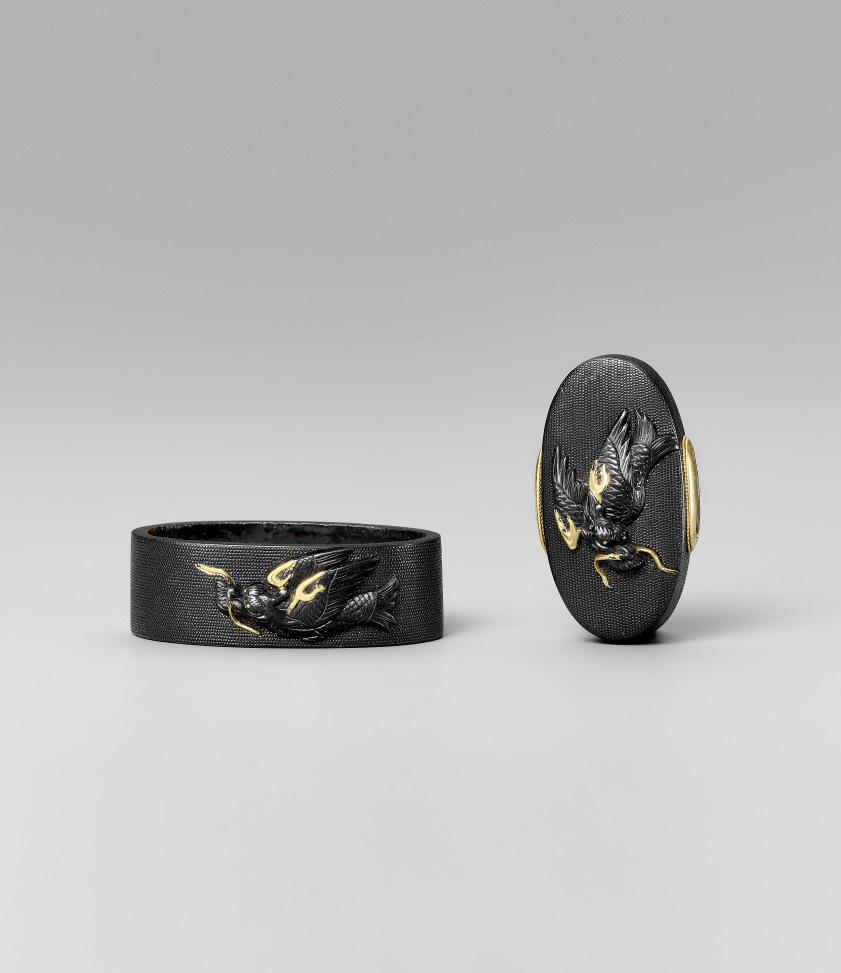
By Tanaka Sokaku, signed Nanto Tanaka no ju Tanaka Sokaku seishi
Japan, 19th century, Edo period (1615-1868)
Each superbly crafted and bearing a shakudo nanako ground, worked in fine takazogan with gold and worked with two shachihoko (winged dragon fish), signed underneath Nanto Tanaka no ju TANAKA SOKAKU seishi [made by Tanaka Sokaku, residing at Tanaka, Nara].
LENGTH 3.9 cm
WEIGHT 32 g
Condition: Excellent condition, minor wear.
With a padded wood tomobako storage box.
The artist is listed in the Haynes Index of Japanese Sword Fittings and Associated Artists on p. 1770 (H08903.0).
Shachi-hoko were thought to have the power to summon rain, they are commonly found as architectural elements on Edo Period temples, castles, samurai homes and gates as protectors from fire.
Estimate EUR 1,500
Starting price EUR 800
242
IWAMOTO KONKAN: A FINE SHIBUICHI FUCHI AND KASHIRA WITH SWEETFISH (AYU)
School of Iwamoto Konkan (1744-1801), signed Iwamoto Konkan and kakihan Japan, Iwamoto school, late 18th to early 19th century, Edo period (1615-1868)
Of shiuichi, finely worked in iro-e takazogan with silver, shakudo, and gold depicting a school of sweetfish (ayu) within a stream, amongst rocks applied with gold barnacles. Signed underneath the fuchi IWAMOTO KONKAN and kakihan (artist’s cursive monogram).

LENGTH 3.9 cm
WEIGHT 33 g
Condition: Excellent condition, minor wear.
With a padded wood tomobako storage box.
Iwamoto Konkan is listed in the Haynes Index of Japanese Sword Fittings and Associated Artists on pp. 716-717 (H 03464.0).
Estimate EUR 1,500
Starting price EUR 800
268
243
OMORI TERUHIDE: A FINE OMORI SCHOOL SHIBUICHI AND GOLD FUCHI AND KASHIRA WITH A CARP
School of Omori Teruhide (died 1730), signed Omori Teruhide with kakihan
Japan, Omori school, 18th century, Edo period (1615-1868)
Of shibuichi and superbly chiseled and worked in gold takazogan, the kashira with turbulent waves with gold dew drops, the large fuchi continuing the design and depicting a majestic golden carp in water. Signed underneath OMORI TERUHIDE and kakihan (artist’s cursive monogram). The design is very typical for the Omori school.

LENGTH 3.9 cm
WEIGHT 51 g
Condition: Very good condition, minor wear, few minuscule nicks.
Omori Teruhide is listed in the Haynes Index of Japanese Sword Fittings and Associated Artists on pp. 1905-1906 (H 09566.0) and is also mentioned in the Soken Kisho of 1781.
AUCTION COMPARISON
Compare a related tsuba with similar design, bearing the same signature and with an additional dating of 1777, at Bonhams, The Harriet Szechenyi Sale of Japanese Art, 8 November 2011, London, lot 420 (sold for 5,000 GBP).
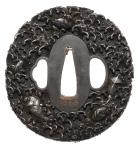
Estimate EUR 2,000
Starting price EUR 1,000
244
NAGATA NAOHIRO: A FINE SHAKUDO NANAKO FUCHI AND KASHIRA DEPCITING SEASHELLS

By Nagata Naohiro, signed Heian Nagato Naohiro with kakihan
Japan, 18th-19th century, Edo period (1615-1868)
Of shakudo, each bearing a superbly worked nanako ground and worked in fine iro-e takazogan of gold, shakudo, silver, shibuichi, and copper depicting various seashells amongst seaweed. Signed underneath Heian NAGATA NAOHIRO with the artist’s kakihan (cursive monogram).
LENGTH 3.8 cm
WEIGHT 31 g
With a padded wood tomobako storage box.
The artist is listed in the Haynes Index of Japanese Sword Fittings and Associated Artists on p. 1317 (H 06626.0) and signed with a very strong and deliberate signature, as in the present piece. The kakihan is a match to the one illustrated by Haynes.
Estimate EUR 1,500
Starting price EUR 800
269
245
ISHIGURO MASATSUNE III: A FINE SHAKUDO NANAKO FUCHI AND KASHIRA WITH HAWK AND SPARROWS
By Ishiguro Masatsune III, signed Ishiguro Moritsune horu with kakihan Japan, Ishiguro school, c. 1800-1820, Edo period (1615-1868)
Of shakudo, bearing a finely worked nanako ground and decorated in iro-e takazogan with rich silver and gold, the kashira depicting a hawk on a tree with gold leaves, the fuchi continuing the design and depicting two fleeing sparrows. Signed underneath ISHIGURO MORITSUNE horu and kakihan (artist’s cursive monogram).
LENGTH 3.9 cm
WEIGHT 42 g
Condition: Excellent condition, minor wear.
The artist is listed in the Haynes Index of Japanese Sword Fittings and Associated Artists on p. 983 (H 04752.0). Ishiguro Masatsune III used the art name Moritsune and succeeded the second Masatsune in 1829.
Estimate EUR 1,500
Starting price EUR 800
246
ZERAKU: A FINE SHAKUDO NANAKO FUCHI AND KASHIRA WITH BUTTERFLIES


By Zeraku (active c. 1800-50), signed Zeraku with kakihan Japan, 19th century, Edo period (1615-1868)
Of shakudo and bearing a superb nanako ground, decorated with three butterflies, one of silver, one of gold, and one of shakudo with gold details. Signed underneath ZERAKU and kakihan (artist’s cursive monogram).
LENGTH 3.9 cm
WEIGHT 35 g
Condition: Very good condition, minor wear.
Zeraku is listed in the Haynes Index of Japanese Sword Fittings and Associated Artists on pp. 2417 (H 12554.0).
Estimate EUR 2,000
Starting price EUR 1,000
270
247
IWAMOTO KONKAN: A FINE SHAKUDO AND GOLD IWAMOTO SCHOOL FUCHI AND KASHIRA WITH INSECTS


School of Iwamoto Konkan, signed Iwamoto Konkan with kakihan
Japan, Iwamoto school, late 18th to early 19th century, Edo period (1615-1868)
Of shakudo and bearing a beautifully finished ishimeji ground and decorated in takazogan with rich gold details, the kashira with a spider and its web, the fuchi depicting a grasshopper and firefly. Signed underneath IWAMOTO KONKAN and kakihan (artist’s cursive monogram).
LENGTH 3.8 cm
WEIGHT 34 g
Condition: Very good condition, minor wear.
Iwamoto Konkan is listed in the Haynes Index of Japanese Sword Fittings and Associated Artists on pp. 716-717 (H 03464.09).
Estimate EUR 2,000
Starting price EUR 1,000
248
WASHIDA MITSUCHIKA: A FINE SHAKUDO AND GOLD FUCHI AND KASHIRA WITH DRAGONFLIES
By Washida Mitsuchika (1823-1902), signed Koka ni kinoto-mi shujitsu Washida Mitsuchika
Japan, dated 1845, Edo period (1615-1868)
Of shakudo and finely decorated in iro-e takazogan with a design of naturalistically rendered dragonflies with gold veins and silver eyes as well as copper inlay to the abdomen. Signed underneath the fuchi Koka ni kinoto-mi shujitsu WASHIDA MITSUCHIKA [Washida Mitsuchika, Autumn 1845] and kakihan (artist’s cursive monogram).
LENGTH 3.9 cm
WEIGHT 38 g
Condition: Very good condition, minor wear.
Washida Mitsuchika is listed in the Haynes Index of Japanese Sword Fittings and Associated Artists on pp. 1049-1050 (H 05142.0).
Estimate EUR 1,500
Starting price EUR 800
271
249 MOTOTOSHI: A FINE SHIBUICHI FUCHI AND KASHIRA WITH MONGAKU SHONIN AND FUDO MYO-O
By
Katsukawa Mototoshi,
signed Katsukawa Mototoshi tsukuru Japan, 19th century, Edo period (1615-1868)
Of shibuichi and superbly worked in iro-e takazogan with rich gold and silver, depicting Fudo Myo-o on the kashira and with his two attendants Kongara Doji and Seitaka Doji under the icy Nachi Waterfall on the fuchi. Signed underneath KATSUKAWA MOTOTOSHI tsukuru [made by Katsukawa Mototoshi].
LENGTH 3.9 cm
WEIGHT 42 g
Condition: Very good condition, minor wear.
Estimate EUR 2,000
Starting price EUR 1,000
250 TETSUGENDO SHORAKU: A TETSUGENDO SCHOOL IRON FUCHI AND KASHIRA WITH GOSHISHO
By
Tetsugendo
Shoraku (Naoshige), signed Tetsugendo Shoraku with seal Toshiyuki Japan, Tetsugendo school, 18th century, Edo period (1615-1868)
Of iron, each worked in fine iro-e takazogan with shakudo, silver, copper and gold, the fuchi decorated with the Chinese warrior Goshisho (Chinese: Wu Zixu, d. 484 BC) writing a text at the same time as holding a 600-kilo bronze vessel above his head, the kashira decorated with Chinese literati and pine trees. Signed underneath TETSUGENDO SHORAKU with gold square seal TOSHIYUKI.


LENGTH 3.9 cm
WEIGHT 40 g
Condition: Excellent condition, minor wear.
With a padded wood tomobako storage box.
The artist is listed in the Haynes Index of Japanese Sword Fittings and Associated Artists on pp. 1339-1340 (H 06772.0).
AUCTION COMPARISON
Compare to a related iron tsuba by the same artist at Bonhams, Fine Japanese Art, 6 November 2007, London, lot 308 (sold for 4,800 GBP).

Estimate EUR 1,500
Starting price EUR 800
272
251
A PAIR OF GOLD AND COPPER MENUKI OF NIO GUARDIANS

Japan, 18th-19th century, Edo period (1615-1868)
Each finely cast in copper, with silver and gold highlights, as a Nio guardian standing in a dynamic posture, chanting their respective syllables, with muscular bodies and draped in billowing scarves.
HEIGHT 2.8 cm (each)
WEIGHT 9 g (total)
Condition: Excellent condition with minor wear.
Estimate EUR 600
Starting price EUR 300
252
A PAIR OF SOLID GOLD MENUKI OF WITH CHRYSANTHEMUMS

Unsigned
Japan, 18th-19th century, Edo period (1615-1868)
Each finely cast with a leafy kiku (chrysanthemum) flower enclosed by swirling bands and clouds.
LENGTH 3.7 cm (each)
WEIGHT 14 g (total)
Condition: Excellent condition, minor wear.
With a padded wood tomobako storage box.
AUCTION COMPARISON
Compare a related pair of solid gold menuki at Zacke, Fine Japanese Art, 27 May 2022, Vienna, lot 311 (sold for 8,848 EUR).

Estimate EUR 2,000
Starting price EUR 1,000
273

Okimono, Netsuke & Related Works of Art
Lots 253 to 438

A RARE AND LARGE PAINTED POTTERY OKIMONO OF A MONKEY EXAMINING A MONKEY NETSUKE



Japan, Meiji period (1868-1912)
Well modeled and painted with polychrome pigments, the monkey seated with its legs crossed, looking through a magnifying glass (now lost) held in his right hand to examine a monkey netsuke in his left, the netsuke attached to a kinchaku (pouch) decorated with a diapered brocade pattern and a globular ojime, both the monkey and the netsuke with neatly incised fur, the primate further detailed with large ears, a short tail, and alert eyes.
HEIGHT 22 cm
Condition: Good condition with minor wear and firing irregularities, including a small firing crack to the underside, the hand with old repair and minor touchups, few small chips to edges, the magnifying glass lost.
Provenance: From an English private collection, by repute formerly in the Charlton Collection. The underside with three old labels, two numbered ‘985’ and one inscribed in Japanese.
AUCTION COMPARISON
Compare a bronze okimono by Mitani depicting a similar subject, dated late 19th century, Meiji period, 10.2 cm high, at Bonhams, 16 September 2014, New York, lot 2162 (sold for 8,750 GBP).
Estimate EUR 2,000
Starting price EUR 1,000
253
254 TESSAI: A WOOD OKIMONO OF HOTEI
By Kano Tessai (1845-1925), signed Tessai with kakihan Japan, Nara, late 19th to early 20th century
Finely carved as a seated Hotei leaning against his huge sack, his face resting against his left hand, with a serene expression marked by full lips forming a subtle smile, the narrowed eyes with incised pupils below thick brows, flanked by large pendulous earlobes, his voluminous robe with deeply carved folds opening to reveal his chest and large belly. The underside carved with the signature TESSAI with a kakihan.

LENGTH 28 cm
Condition: Very good condition with minor wear and few minuscule nicks.
With a wood storage box (tomobako) inscribed Hotei zo and Taisho mizunoto-ushidoshi shoshu TESSAI [...] (‘In the early autumn in mizunoto-ushi year of Taisho [corresponding to 1913] by Tessai’) with a kakihan and seal TESSAI.
Kano Tessai (1845-1925) came from a Gifu family and started his life as a Buddhist priest, though his father instructed him in the art of carving. He studied Chinese literature and drawing and was a professor at Tokyo art school in 1872. He was also on the examining committee for investigating the ancient art of Japan and subsequently went to Nara where he engaged in the reproductions of old objects of art.
AUCTION COMPARISON
Compare another okimono of Hotei by Kano Tessai at Bonhams, Fine Japanese Works of Art, 19 March 2013, New York, lot 3205 (sold for 3,125 USD).


Estimate EUR 2,000
Starting price EUR 1,000
277
KANO TESSAI: A BAMBOO BRUSHPOT WITH KANSHI POEMS
By Kano Tessai (1845-1925), signed Tessai with kakihan Japan, Nara, early 20th century
The bamboo stalk with a copper liner and finely carved in shishiaibori (sunken relief) to the exterior with a snail (katatsumuri), a firefly (hotaru), and a larger bug. Each of the animals is accompanied by a boldly incised inscription, the larger bug inscribed and signed Yuiga Dokuson an, TESSAI (‘Made by Tessai at the studio Yuiga Dokuson an’), with a kakihan.

HEIGHT 30.2 cm
Condition: Good condition with minor wear, few small nicks, age cracks with associated repairs.
Provenance: Christie’s, Japanese and Korean Art, 18 September 2007, New York, lot 251. Ex-collection Shep Brozman, New York, acquired from the above.
With a wood storage box (tomobako) inscribed and signed Yuiga Dokuson an, TESSAI (‘Made by Tessai at the studio Yuiga Dokuson an’), with a kakihan and seal.
The kakihan on the brushpot and the tomobako is a monogram based on Ko (光) of Kotaro (光太郎).
The poems on the present brushpot are kanshi, a Japanese term for Chinese poetry in general as well as the Japanese poetry written in Chinese by Japanese poets. It literally means ‘Han poetry’. Kanshi was the most popular form of poetry during the early Heian period in Japan among Japanese aristocrats and proliferated until the modern period. During the Edo period and the early Meiji period many bunjin or ‘men of letters’ schooled in the philosophy of Neo-Confucianism composed kanshi. Kanshi had multiple forms, but most notable were in 5 or 7 syllables in 4 or 8 lines. The Japanese poets of kanshi were skilled in the strict rhyming rules of lüshi and jueju, the two forms of the regulated verse that had gained most popularity during the Tang dynasty in China.
The poem beside the snail can be translated as follows: ‘It is hard to measure how high it is, but I’ve managed to climb up on the dry wall with sticky endurance; my antennae do not seek fame and fortune but I am firmly grounded, even inside a small vase there are four seasons of the wind and the moon under the heaven.’ This poem is an almost direct quote of two well-known poems by the Chinese poets Su Shi (1037-1101) and Xu Youren (1287-1364).
The poem beside the firefly can be translated as follows: ‘The last glow of life shines from within, bright in the gathering night.’
Kano Tessai (1845-1925) came from a Gifu family and started his life as a Buddhist priest, though his father instructed him in the art of carving. He studied Chinese literature and drawing and was a professor at Tokyo art school in 1872. He was also on the examining committee for investigating the ancient art of Japan and subsequently went to Nara where he engaged in the reproductions of old objects of art, such as the present example.
AUCTION COMPARISON
Compare a related bamboo archaistic ding censer by Kano Tessai, dated 1914, at Galerie Zacke, 6 March 2021, Vienna, lot 566 (sold for 12,640 EUR).

Estimate EUR 8,000
Starting price EUR 4,000
255
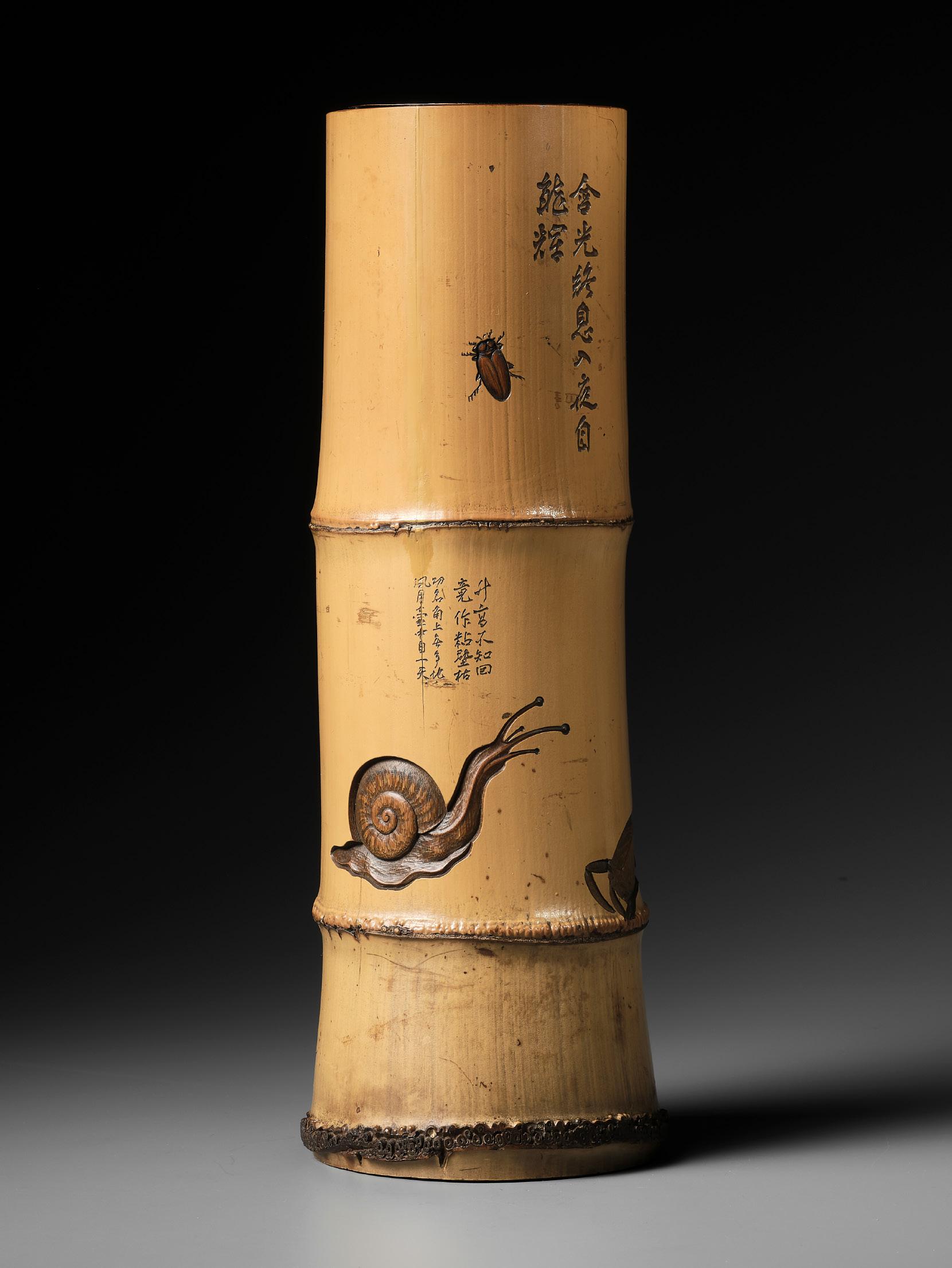
GYOSUI: A LACQUERED WOOD GIGAKU MASK OF TAIKOFU
By Gyosui, signed Gyosui saku with seal Gyosui Japan, Nara, early 20th century
Finely carved and lacquered to depict an elderly man with a long aquiline nose, full red lips forming a smile, elongated earlobes, and deeply carved wrinkles. The eyes and mouth are pierced. The back with a label inscribed Kokuho gigakumen wo mosu, Todaiji Koshofumen, GYOSUI saku (‘Made by Gyosui, a replica Gigaku mask based on the original Taikofu Gigaku mask at the Todaiji Temple’), with the seal GYOSUI. Rich, dark patina.

HEIGHT 26 cm
Condition: Good condition with some wear and simulated wear, minor age cracks, flaking and losses to lacquer, tiny chips to edges, possibly few minor old repairs.
This mask represents a lonely old man and is paired with Daikoji. It was carved by Gyosui, a pupil of Kano Tessai (1845-1925), who was engaged in copying ancient works of art from the Shoso-in repository in Nara.

This mask represents one of many varied and colorful characters of the masked dance drama called Gigaku, of which some are grotesque, some of Indian and Persian appearance, some from Buddhism and some from Brahmanism. According to
the Nihon Shoki, Gigaku was brought to Japan by one Mimashi, an immigrant from Baekche, Korea in 612. It originated in the Chinese kingdom of Wu, or Kure in Japanese, and was also known as Kure no Uta Mai (Song and Dance of Kure). The drama was performed in the recently built temples of Nara which were then the centers of learning and culture, and the Nihon Shoki further records that envoys from Silla were entertained with a performance of Gigaku at the Kawahara temple in 692. Masks of the period survive in the Horyuji and Todaiji temples, with more than a hundred preserved in the Shosoin repository, some with ink inscriptions of dates and the names of the characters. Among them some are dated 9 April 752 showing that they were used in celebrations accompanying the ‘Eye Opening’ ceremony for the great bronze Buddha in the Todaiji in that year. The Todaiji records indicate sixty musicians and four ‘Gigaku Masters’ present at the ceremony.
LITERATURE COMPARISON
Compare a similar mask from the Todaiji temple collection, possibly the original, illustrated in Nihon no Chokoku 4, Tenpyo Jidai (Bijutsu Shuppansha 1952).

MUSEUM COMPARISON
A carved and polychrome wood mask of Taikofu, dated to the 7th century (Asuka period), is in the Tokyo National Museum, no. N-216.
Estimate EUR 2,000
Starting price EUR 1,000
280
256
257
A RARE NOH MASK OF YASE-ONNA


Japan, 19th century
Finely carved and decorated in creamy white and polychrome pigments over wood to depict a gaunt, emaciated woman with heavy-lidded eyes and slender red lips, the eyes and mouth pierced, the back with the signature within a recessed reserve reading Kurozuru 黒鶴
HEIGHT 20 cm
Condition: Very good condition with minor wear, a small age crack to the chin, minor flaking to lacquer around the edges.
Provenance: From a French private collection.
Kurozuru 黒鶴 literally means ‘Black Crane’. This name is likely based on Shakuzuru (‘Red Crane’), a master Noh mask carver from the Nanbokuchu period (14th century).
Japanese Noh theater is magnificent and rarefied – a living Buddhist performance art more than 700 years old with roots and formal elements much older. In the 14th century, the performerplaywright and head of a performing clan family Kan’ami Kiyotsugu (1333-84) wrote the play Motomezuka (“The Sought-for Grave”), which tells the plight of a maiden who committed suicide after two young men killed each other when fighting over her. Kan’ami’s son, Zeami Motokiyo (c. 1363–c. 1443), further refined both the artistic and spiritual qualities of the play. Yase-onna represents
the suffering spirit of a woman who dies from a problematic love relationship and is associated with the character Unai in Act Two of Motomezuka.
LITERATURE COMPARISON
Compare a related Noh mask of Yase-onna, dated circa 19th century, illustrated in Nakanishi, Toru (1960) Noh Masks.
AUCTION COMPARISON
Compare a closely related Noh mask of Ko-omote with similar features, also dated 19th century, at Lempertz, Asian Art, 5 June 2015, Cologne, lot 800 (sold for 23,560 EUR).

Estimate EUR 4,000
Starting price EUR 2,000
Motomezuka, Act 2, performed by Kita Roppeita (1874–1971)

281
Japan, 18th-19th century, Edo period (1615-1868)
The handle carved in the form of a baku head with large narrowed eyes with round pupils, a long sinuous snout with curling end, gently curved tusks, scrolling mane, and long elephant ears, pierced with two small circular apertures.


LENGTH 45.1 cm
Condition: Good condition with minor wear, small nicks, light surface scratches, minor chips, few tiny age cracks.
Provenance: From the collection of Felix Tikotin, and thence by descent within the family. Felix Tikotin (1893-1986) was an architect, art collector, and founder of the first Museum of Japanese Art in the Middle East. Born in Glogau, Germany, to a Jewish family, his ancestors had returned with Napoleon from Russia from a town named Tykocin. He grew up in Dresden and after World War I, he traveled to Japan and immediately fell in love with the culture. In April 1927, he opened his own first gallery in Berlin. The entire family survived the holocaust, and in the 1950s Tikotin slowly resumed his activities as a dealer in Japanese art. He became, once again, very successful and prominent, holding exhibitions all over Europe and the United States. When he first visited Israel in 1956, he decided that the major part of his collection belonged in that country. In 1960, the Tikotin Museum of Japanese Art was opened in Haifa.
Felix Tikotin (1893-1986), center, in front of his gallery in Berlin

MUSEUM COMPARISON
Compare a related wood bokuto in the form of a baku by Naito Toyomasa, dated 1849 by inscription, in the British Museum, registration number 1985,1107.1.

AUCTION COMPARISON
During the Edo period, with the end of the civil rivalry between the Shogun and his enemies, carrying arms became obsolete in Japan. The wearing of small dummy swords by the Samurai was imitated by doctors, artists, and other professionals as a symbol of social and professional status. During the 18th and 19th centuries the bokuto lost its sword-like appearance and size and took on a more abstract and decorative form, continuing into the Meiji period.
Compare a related bokuto depicting a shachihoko at Zacke, Fine Japanese Art, 3 December 2021, Vienna, lot 69 (sold for 2,528 EUR).

Estimate EUR 2,500
Starting price EUR 1,200
282
258
A RARE WOOD BOKUTO (‘DOCTOR’S SWORD’) WITH BAKU HEAD
259
A FINE BAMBOO WRIST REST DEPICTING THE GHOST OF OIWA

Japan, 19th century
Of typical form, carved in shishiaibori (sunken relief) with a ghost (yurei) grasping a strand of her neatly incised long hair in her hand, another in her mouth, the disfigured face with large hollow eyes, the long flowing robe opening at the chest to reveal the emaciated ribcage.

LENGTH 21 cm
Condition: Very good condition with minor wear and fine age cracks.
Oiwa died in 1636 and even today it is believed that she haunts the place of her death as well as anyone who performs her story which was adapted into the famous kabuki play Tokaido Yotsuya Kaidan (Ghost story of Yotsuya in Tokaido) in 1825. The story is a tale of betrayal, murder, and ghostly revenge which features Tamiya Iemon who poisoned his loving wife Oiwa, who in turn haunted him and drove him mad.
Estimate EUR 5,000
Starting price EUR 2,400
A woodblock print of Onoe Kikugoro III as the Ghost of Oiwa in the play Yotsuya Kaidan by Utagawa Kuniyoshi, 1836
260
SHIZUO: A FINE IVORY OKIMONO OF AN AMA (DIVING GIRL) NURSING HER CHILD

Superbly carved as a diving girl seated and nursing her infant which crawls up against her lap, the details very finely carved and the ama’s long hair minutely incised and lightly stained. Several shells including an awabi and hamaguri are carved onto the shaped base next to the diving girl. Signed underneath within a red-lacquered cartouche SHIZUO (Seiyu).
LENGTH 6.5 cm
Condition: Excellent condition.
Estimate EUR 2,000
Starting price EUR 1,000
284
By Shizuo (Seiyu), signed Shizuo 静雄 Japan, Tokyo, Meiji period (1868-1912)
261
A FINE IVORY OKIMONO OF A MOTHER BATHING HER CHILD

Unsigned Japan, Tokyo, Meiji period (1868-1912)
Finely carved as mother stepping into her bath and holding her screaming infant which holds a small bucket, a washcloth held in the mother’s mouth. The details are superbly worked, the ivory neatly polished, the details stained with sumi (ink).

HEIGHT 6.3 cm
Condition: Very good condition, minor wear and one natural age crack.
Estimate EUR 1,500
Starting price EUR 800
262
AN IVORY OKIMONO DEPICTING URASHIMA TARO WITH TURTLE
Unsigned
Japan, 19th century, Meiji period (1868-1912)
Finely carved as a standing fisherman holding a small turtle in his right hand and looking at the animal with a bemused expression, his eyes narrowed and mouth agape. He is wearing a straw skirt over a neatly incised patterned robe. A gourd vessel is slung over his shoulder with the tasseled string held in his left hand. Beside him lies a woven basket with a long fishing rod sticking out and a smaller basket filled with fish.
HEIGHT 11.1 cm
Condition: Good condition with minor wear, few fine age cracks, the separately carved fishing rod with an old repair, the basket to his side is slightly loose.
Provenance: From the collection of Gaston Lazard (1878-1956) and his wife Jane Levy (1886-1985) and thence by descent within the same family.
The present okimono depicts a scene from the popular fairy tale of Urashima Taro, in which a fisherman is rewarded for rescuing a turtle, and carried on its back to the Dragon Palace beneath the sea. There he is entertained by the princess Otohime as a reward. He spends what he believes to be several days with the princess, but when he returns to his home village, he discovers he has been gone for at least 100 years. When he opens the forbidden jeweled box (tamatebako) given to him by Otohime on his departure, he turns into an old man.
AUCTION COMPARISON
Compare to a related ivory okimono of Urashima Taro, by Kazuo, at Bonhams. Fine Japanese Art, 17 May 2012, London, lot 183 (sold for 5,250 GBP).
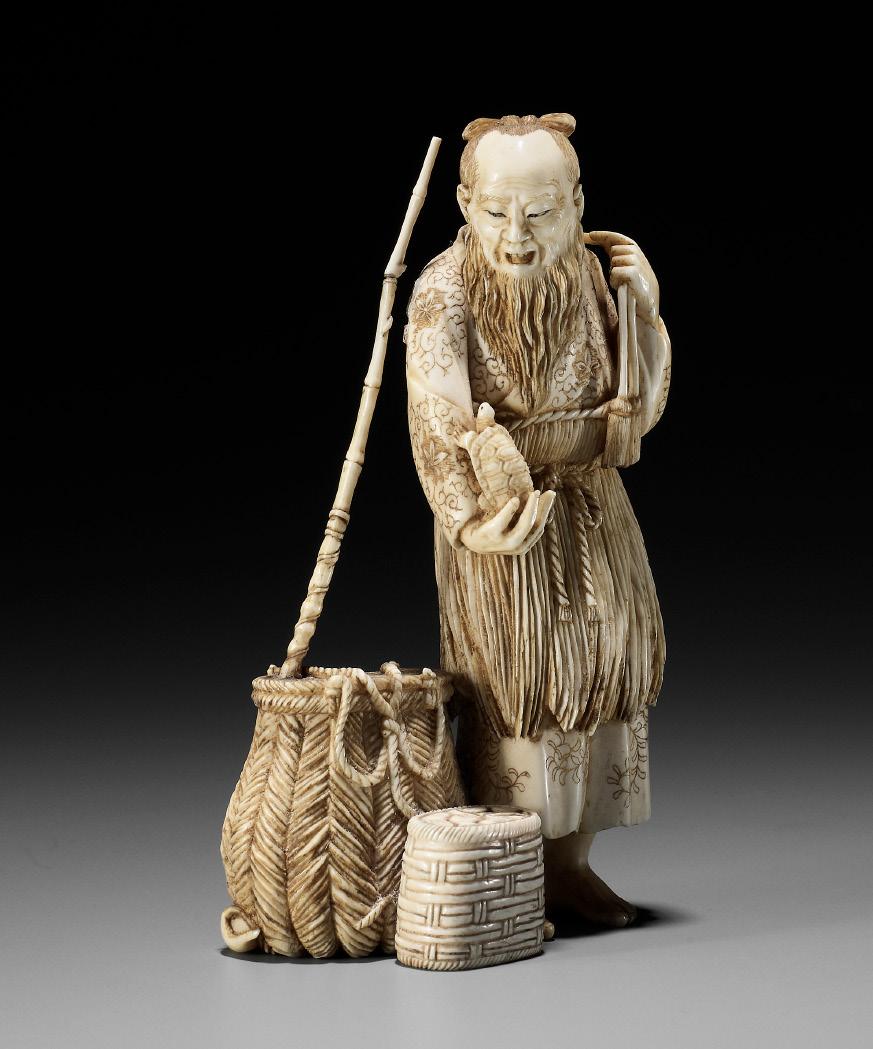
Estimate EUR 1,500
Starting price EUR 800
285
263
MITSUYUKI: A SHIBAYAMA-INLAID IVORY OKIMONO OF BENTEN WITH DRAGON AND TWO ATTENDANTS
By Mitsuyuki,
signed
Mitsuyuki Japan, Meiji period (1868-1912)
Finely carved and decorated with inlays of gilt-metal and motherof-pearl, the Goddess of Music and Literature standing behind an opened treasure chest from which a fierce two-horned threeclawed dragon emerges, writhing around the deity and grasping a tama (sacred pearl) in one of its claws. Benten is wearing long flowing robes and a billowing scarf and holds a fan in her right hand and a jewel in her left. She is flanked by two kneeling men, one depicting Urashima Taro with a small minogame in front of him, and the other holding a large bowl filled with shell-inlaid sake. The underside with a red-lacquered reserve incised with the signature MITSUYUKI.
HEIGHT 8.1 cm
Condition: Very good condition with minor wear, few tiny age cracks.
Estimate EUR 1,500
Starting price EUR 800
264 MINJO: AN IVORY OKIMONO OF A DRUNKEN ONI WITH TANUKI
By Minjo, signed Minjo Japan, late 19th century, Meiji period (1868-1912)
A drunken oni, depicted as a vendor, his face and horns very finely carved, in a joyous dance pose. The demon is holding a piece of an octopus tentacle up high in one hand and a sake bottle with a character meaning ‘more of that’ (among other things) in the other. He is carrying an umbrella on his back. Beside the oni is a tanuki, a kind of demonic raccoon, which is sometimes also depicted selling sake, and in this case hungers for the oni’s snack. The garment folds and other details are carved in a very lively manner. The twocharacter signature inlaid in red lacquer within a decorative reserve on the tanuki’s belly signed MINJO.
HEIGHT 14.1 cm
Condition: Good condition, minor wear, one hand and the handle to the umbrella have been reattached.
Provenance: Austrian private collection. Galerie Zacke, Fine Netsuke, Sagemono & Okimono, 27 April 2019; Vienna, lot 337. Czech private collection, acquired from the above.


Estimate EUR 1,500
Starting price EUR 800
KOMEI: AN IVORY OKIMONO OF MONJU BOSATSU WITH SHISHI AND CHILDREN

 By Komei, signed Komei Japan, Tokyo, Meiji period (1868-1912)
By Komei, signed Komei Japan, Tokyo, Meiji period (1868-1912)
The Bodhisattva finely carved seated on a giant shishi with neatly incised scrolling mane and whorled fur, the deity holding a scroll in her left hand, dressed in patterned robes and billowing scarves, and adorned with fine jewelry, her hair tied in an elaborate coiffure topped by a floral headdress. Monju Bosatsu is surrounded by two girls, one holding a fan and the other a censer with shishi finial, and a karako holding a lotus flower borne on a long stem, the children with cheerful expressions. The underside with a rectangular reserve with the signature KOMEI.
HEIGHT 11.1 cm
Condition: Good condition with minor wear and a repair to the tassel of the fan in the back.
Estimate EUR 2,500
Starting price EUR 1,200
287
265
GYOKUSHO: A FINE TOKYO SCHOOL IVORY OKIMONO DEPICTING A HUNTER
 By Gyokusho, signed Gyokusho Japan, Tokyo, late 19th century, Meiji period (1868-1912)
By Gyokusho, signed Gyokusho Japan, Tokyo, late 19th century, Meiji period (1868-1912)
Finely carved as a hunter standing with one foot on a gnarled tree stump beside a basket of persimmons, wearing a straw helmet, fur vest, and patterned robes, holding a basket with a freshly caught bird as well as a bow and an arrow, a sword and pouch attached to his belt. He is looking fondly at a young woman seated on a bundle of sticks and holding a pouch and pipe case in her right hand. The underside of a loose twig incised with the signature GYOKUSHO.
HEIGHT 18.4 cm
Condition: Good condition with minor wear, the arrow held in the hunter’s left hand with a minor old repair.
Provenance: Collection of Charles Rozenfeld, Antwerp, Belgium. Charles Simon Rozenfeld (1943-2020) was a Belgian diamond dealer and keen collector of Japanese art, particularly ivory.
Estimate EUR 4,000
Starting price EUR 2,000
266
267
HIDEYUKI:
AN IVORY OKIMONO DEPICTING A FARMER COUPLE
 By Hideyuki, signed Hideyuki to Japan, late 19th century, Meiji period (1868-1912)
By Hideyuki, signed Hideyuki to Japan, late 19th century, Meiji period (1868-1912)
Finely carved as a man carrying a stretcher on his back with leafy sprays of peony and aster attached at the top and holding a large woven basket with blossoms. The man’s wife stands beside him and holds a basket with millet grains. The couple stands before a gnarled hollow tree stump on which a small bird is perched, a second bird sits on the ground between them. Both are wearing neatly incised patterned robes and show smiling expressions. The
underside of the base incised with a half-rolled-up scroll, grasses, and the signature HIDEYUKI to.
HEIGHT 16.6 cm
Condition: Very good condition with minor wear, few small losses, minor age cracks.
Provenance: Collection of Charles Rozenfeld, Antwerp, Belgium. Charles Simon Rozenfeld (1943-2020) was a Belgian diamond dealer and keen collector of Japanese art, particularly ivory.
Estimate EUR 3,000
Starting price EUR 1,500
289

268
MASAMITSU: A RARE AND LARGE TOKYO SCHOOL IVORY OKIMONO OF A HUNTER WITH MATCHLOCK RIFLE (TANEGASHIMA)
By Masamitsu, signed Masamitsu to Japan, Tokyo, late 19th century, Meiji period (1868-1912)
Finely carved as a hunter standing on a naturalistically carved base with a twig, leaves, and a small tree stump. He is holding a matchlock rifle (tanegashima) in both hands, the gun finely rendered with both roughly textured and smoothly polished elements. His face with a pleased expression showing a bucktoothed smile with narrowed eyes looking upward, perhaps he has just shot a bird. He is wearing patterned robes over a bamboo undershirt, a pouch with netsuke is attached to his belt, and a straw hat tied below the chin over his wavy hair. The underside of the base incised with the signature MASAMITSU to [carved by Masamitsu].

HEIGHT 35 cm
Condition: Very good condition with minor wear and expected age cracks.
Provenance: Collection of Charles Rozenfeld, Antwerp, Belgium. Charles Simon Rozenfeld (1943-2020) was a Belgian diamond dealer and keen collector of Japanese art, particularly ivory.
Tanegashima, most often called in Japanese and sometimes in English hinawaju (‘matchlock gun’), was a type of matchlockconfigured arquebus firearm introduced to Japan through the Portuguese Empire in 1543. Tanegashima were used by the samurai class and their ashigaru ‘foot soldiers’, and within a few years the introduction of the tanegashima in battle changed the way war was fought in Japan forever. After Tokugawa Ieyasu destroyed the Toyotomi clan in the siege of Osaka and established the Tokugawa shogunate, the relatively peaceful Edo period arrived, and the use of tanegashima declined. Isolation did not eliminate the production of guns in Japan—on the contrary, there is evidence of around 200 gunsmiths in Japan by the end of the Edo period. However, the social life of firearms had changed: as the historian David L. Howell has argued, for many in Japanese society, the gun had become less a weapon than a farm implement for scaring off animals. With no external enemies for over 200 years, tanegashima were mainly used by samurai for hunting and target practice, the majority were relegated to the arms store houses of the daimyo.
AUCTION COMPARISON
Compare a closely related ivory okimono of a hunter by Kyosei, dated late 19th century, Meiji period, 31 cm high, at Christie’s, 19 June 2002, London, lot 176 (sold for 8,365 GBP).

Estimate EUR 8,000
Starting price EUR 4,000
291
269
A BONE OKIMONO OF TWO MONKEYS FIGHTING AN EAGLE

Unsigned Japan, Meiji period (1868-1912)
Finely carved with a lively composition, depicting two monkeys clambering on a giant eagle in mid-flight, one holding on to the eagle’s wings and the other with a particularly vicious expression pulling on its head, each with inlaid pupils, the furs and plumage neatly incised and heightened by stain.
WIDTH 8.5 cm
Condition: Very good condition with minor wear and few tiny chips.
AUCTION COMPARISON
Compare a related larger ivory okimono of an eagle and group of monkeys, 22.3 cm high, dated Meiji period, at Bonhams, 12 November 2008, London, lot 270 (sold for 4,560 GBP).
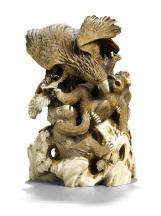
Estimate EUR 1,500
Starting price EUR 800
270
AN IVORY JAR DEPICTING CONSTRUCTION MEN

Unsigned Japan, late 19th century, Meiji period (1868-1912)
The ovoid sides rising from a flat circular base to a short-waisted neck with a thick-lipped rim, the sides finely carved in shishiaibori with a continuous scene with various craftsmen constructing a building, including two men plastering the walls and a carpenter sanding a flat post while another hammers nails into a beam. The base is incised with swirling lines.
HEIGHT 12.8 cm, DIAMETER 11 cm
Condition: Very good condition with minor wear and fine age cracks.
Provenance: Collection of Charles Rozenfeld, Antwerp, Belgium. Charles Simon Rozenfeld (1943-2020) was a Belgian diamond dealer and keen collector of Japanese art, particularly ivory.
Estimate EUR 1,500
Starting price EUR 800
271
A SUPERB AND LARGE IVORY TUSK BOX AND COVER DEPICTING A TIGER AND DRAGONS


Unsigned Japan, late 19th century, Meiji period (1868-1912)
Of oval form, the sides intricately carved in relief and openwork with five ferocious three-clawed dragons with sinuous scaly bodies, neatly incised curled manes, and eyes inlaid with mother-of-pearl, writhing amid thick swirling clouds. The cover is similarly carved with a sixth dragon writhing around the finial in the form of a majestic tiger seated on its haunches, the animal well detailed with long tail, finely incised fur, and alert expression. The flat base is separately carved and incised around the central nerve channel plug with a foliate design.
HEIGHT 25.7 cm
Condition: Very good condition, minor wear, the plug to the base lost, one eye inlay lost.
Provenance: From the collection of Gaston Lazard (1878-1956) and his wife Jane Levy (1886-1985) and thence by descent within the same family.
The tiger and dragon both have important meanings in Buddhist and Taoist philosophy, together representing the yin and yang, the earth and sky, or the male and female. Furthermore, they represent strength, resilience, and courage.
Estimate EUR 4,000
Starting price EUR 2,000
293
A SUPERB IVORY OKIMONO OF A SKULL WITH SNAKE AND LOTUS
Unsigned Japan, Tokyo, Meiji period (1868-1912)
A morbidly fascinating ivory okimono of netsuke type depicting a skull carved with intricate and anatomically precise detail. A snake with naturalistically carved scales, its body varying in thickness, is coiling around the cranium, emerging from underneath, its head terminating at the top, the glaring eyes inlaid, ready to strike from above. A furled lotus leaf with curved stem is visible underneath. Large central himotoshi to the superbly carved underside.

LENGTH 5.4 cm, HEIGHT 5.2 cm
Condition: Excellent condition. Some tiny nibbling to edges.
The skull, snake, and lotus together represent the Buddhist philosophy of the impermanence of life, which can be summarized as ‘Memento Mori’ (latin for ‘remember that you die’).
In Japanese Samurai culture, the influence of Zen Buddhist contemplation of death on indigenous culture can be gauged by the following quotation from the classic treatise on samurai ethics, the Hagakure:
“The Way of the Samurai is, morning after morning, the practice of death, considering whether it will be here or be there, imagining the most sightly way of dying, and putting one’s mind firmly in death. Although this may be a most difficult thing, if one will do it, it can be done. There is nothing that one should suppose cannot be done.”
In the annual appreciation of cherry blossom and fall colors, hanami and momijigari, it was philosophized that things are most splendid at the very moment just before their fall, and to aim to live and die in a similar fashion.
AUCTION COMPARISON
Compare a closely related ivory netsuke of a skull with two snakes at Zacke, Fine Japanese and Netsuke Art, 22 June 2019, Vienna, lot 341 (sold for 15,168 EUR).


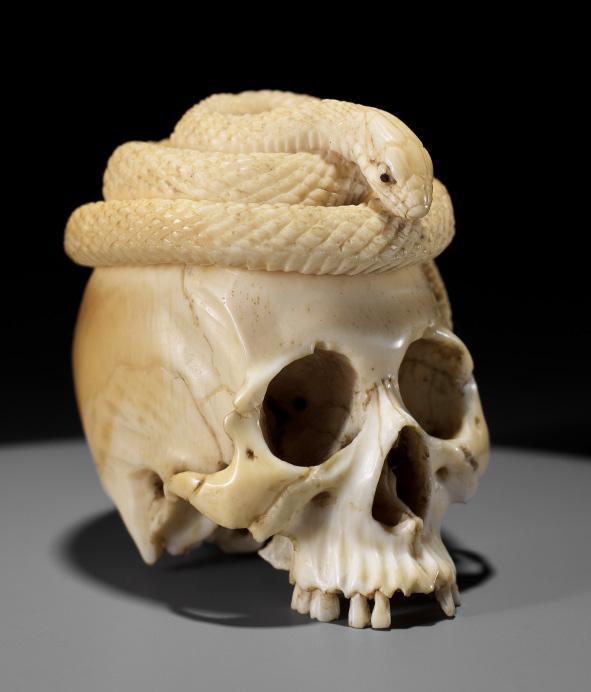
Estimate EUR 8,000
Starting price EUR 4,000
272
SEIRYU: A SUPERB IVORY OKIMONO OF THE SANSUKUMI
By Seiryu, signed Seiryu to Japan, Meiji period (1868-1912)
Superbly carved as a snake arching its long body and wrapping its tail around a frog standing foursquare upon the naturalistically carved base scattered with the remains of a broken broom and a straw hat, a snail slithering along, the snake with neatly incised scales and a fierce expression, its mouth open with the tongue protruding, the frog and snake’s eyes double-inlaid with motherof-pearl and horn. The underside of the base incised with the signature SEIRYU to [carved by Seiryu] within an oval reserve.
HEIGHT 10 cm
Condition: Excellent condition with minor wear.
The combination of snake, frog, and snail (or slug) constitutes the sansukumi motif. Sansukumi translates to ‘the three who are afraid of one another’. The three animals are in a state of mutually assured destruction: the snake will consume the frog, however the frog has already eaten a poisonous snail, so the snake must perish as well. This motif is connected to sansukumi-ken, a category of Japanese hand games played by using three hand gestures. The oldest sansukumi-ken game is mushi-ken, a game originally from China. In mushi-ken, the ‘frog’ represented by the thumb wins against the ‘slug’ represented by the pinkie finger, which, in turn defeats the ‘snake’ represented by the index finger, which wins against the ‘frog’. Although this game was imported from China, the Japanese version differs in the animals represented. In adopting the game, the original Chinese characters for centipede or millipede were apparently confused with the characters for the ‘slug’. The centipede was chosen because of the Chinese belief that the centipede was capable of killing a snake by climbing and entering its head. One of the few surviving sansukumi-ken games is jan-ken, which was brought to the West in the 20th century as rock paper scissors.
AUCTION COMPARISON
Compare a related larger ivory okimono of a dragon and its young by Seiryu, 22.8 cm long, at Christie’s, 19 September 2000, New York, lot 27 (sold for 18,800 USD).



Estimate EUR 6,000
Starting price EUR 3,000
295
273
UNHODO MASAYOSHI: A SUPERB WOOD OKIMOO OF A GROUP OF MONKEYS AND DOG
By Unhodo Masayoshi, signed Unhodo Masayoshi 雲峯堂 正慶 Japan, Nagoya, c. 1860
Very finely carved as a group of monkeys, some of them wearing jackets and one wearing a sambaso hat, the largest guarding a group of persimmons while biting into one, one of the younger monkeys trying to steal the fruit, the other monkeys playing around the composition, clambering on top of each other or picking fleas, one monkey climbing up on a dog. The underside shows the finely carved feet and a further persimmon branch issuing two fruits. Signed underneath within a recessed oval reserve UNHODO MASAYOSHI.


LENGTH 6.6 cm
Condition: Repair to one foot and to two hands. Otherwise in excellent condition with minor wear.
AUCTION COMPARISON
Compare a related wood okimono of a pyramid of rats, by Unhodo Masayoshi, at Bonhams, Snow, Sex and Spectacle – Japanese Art


Across Six Centuries, 13 May 2021, Vienna, lot 96 (sold for 4,845 GBP).
Estimate EUR 5,000
Starting price EUR 2,400
296 274
275
A LARGE AND FINE YAMADA SCHOOL WOOD OKIMONO NETSUKE OF A WOLF AND MONKEY
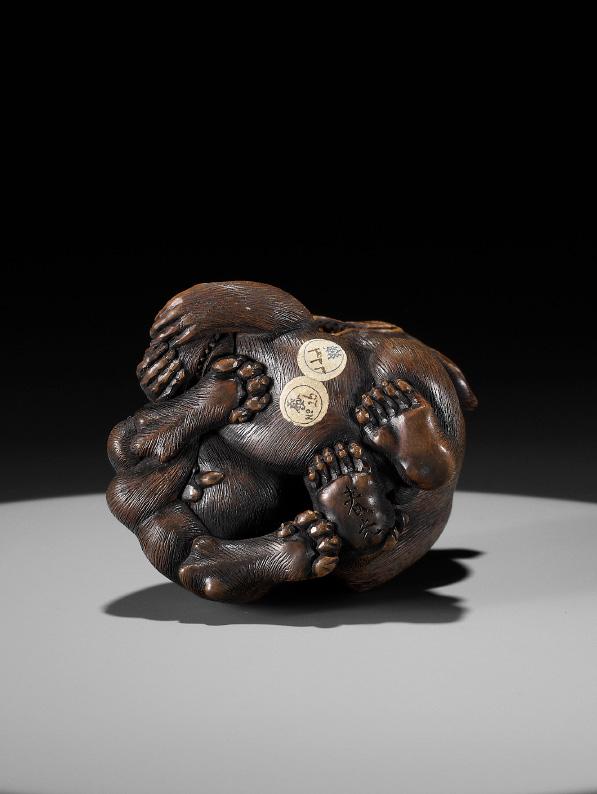

 By Harumitsu (Shunko), signed Harumitsu 春光 Japan, Yamada, Ise Province, c. 1860
By Harumitsu (Shunko), signed Harumitsu 春光 Japan, Yamada, Ise Province, c. 1860
Finley carved as a voracious wolf or yama-inu pressing its paws down on a monkey, while the ape bites into the wolf’s tail in an attempt to free itself. The details are remarkably refined, the hairwork very neatly incised. The pupils of both animals are inlaid. Signed underneath the monkey’s right hind paw HARUMITSU. There are possibilities for the cord attachment, however, this carving is more likely an okimono.
HEIGHT 4.7 cm, LENGTH 5.1 cm
Condition: Excellent condition, minor wear.
Provenance: US private collection, with old labels to the underside.
Relatively little is known about the artist Harumitsu (Shunko), though it is suspected he was a pupil from the Masanao line of Yamada, although some of his carvings also share characteristics of the Tanba and Tsu schools.
Estimate EUR 3,000
Starting price EUR 1,500
297
A SUPERB SHIBAYAMA-INLAID
WOOD OKIMONO OF EGUCHI NO KIMI
Unsigned Japan, Tokyo, Meiji period (1868-1912)

Superbly carved and embellished with magnificent Shibayamastyle inlays of buffalo horn, mother-of-pearl, coral, malachite, tortoiseshell, metal, and variously stained bone, depicting the courtesan Eguchi no Kimi with sensitively crafted facial features, riding on top of an elephant, her hair arranged in an elegant topknot and mounted with a tiara, dressed in beautifully flowing loosely fitted robes, and reading from a long scroll.



HEIGHT 6.3 cm
Condition: Very good condition, minor wear, one tiny inlay to the saddle lost.
According to legend, Kimi was a courtesan in the village of Eguchi and was so devoted to Buddhist scripture that she became the incarnation of Fugen Bosatsu (Boddhisattva Samantabhadra). The imagery satirizes the Buddhist bodhisattva Fugen (Samantabhadra), whose mount is the elephant, by replacing the deity with a beautifully coiffed modern courtesan. Such a visual pun (mitate) was an artistic trope, popular in the Edo period.
Estimate EUR 3,000
Starting price EUR 1,500
Katsukawa Shuntei (1770-1820), Eguchi no Kimi, Donated to The Metropolitan Museum of Art, New York by the Mary and Jackson Burke Foundation in 2015
298
276
277
CHIKUYOSAI TOMOCHIKA: A LARGE IVORY OKIMONO NETSUKE OF AN ELEPHANT WITH A GROUP OF KARAKO


278
DOSHO: A SHIBAYAMAINLAID WOOD NETSUKE OF A CAPARISONED ELEPHANT
By Dosho,
signed
Dosho
道笑
late 19th century, Meiji period (1868-1912)
Japan,
The caparisoned elephant set on a rectangular base and finely inlaid in the Shibayama style with green-stained stag antler, stained bone, coral, tortoiseshell, mother-of-pearl, glass, and metal. The underside with a central himotoshi and signed DOSHO.
LENGTH 3.7 cm
Condition: Excellent condition with minor wear.
Estimate EUR 1,000
Starting price EUR 500
 By Chikuyosai Tomochika,
By Chikuyosai Tomochika,
signed Chikuyosai Tomochika with seal
Japan, Edo (Tokyo), c. 1870
A large and finely carved okimono of netsuke type with a florally rimmed himotoshi underneath, depicting a procession of four karako playing various instruments around an elephant wearing an opulent saddlecloth surmounted by a large lotus flower. Signed to the underside in two shaped cartouches CHIKUYOSAI TOMOCHIKA and with a red square seal.
LENGTH 6.5 cm, HEIGHT 6.5 cm
Condition: Excellent condition with minor wear.
AUCTION COMPARISON
Compare to a closely related ivory okimono, by Tomochika and Jogyoku, at Bonhams, Fine Japanese Art, 6 November 2007, London, lot 153 (sold for 1,800 GBP).
Estimate EUR 2,500
Starting price EUR 1,200
299
279
AN IVORY NETSUKE OF KINTARO AND YAMAUBA WATCHING TWO RABBITS WRESTLE

Unsigned Japan, Tokyo, late 19th century

Finely and charmingly carved as the Golden Boy and his mountain witch mother judging a wrestling contest between two hares. Kintaro is standing in a dynamic pose with one leg raised, his axe and a drum in his hands, his face with a cheerful expression, the yama-uba seated with her breasts exposed, both with neatly incised and darkly stained hair, the rabbits locked in combat. Natural himotoshi.
Kintaro umpiring a wrestling match between a hare and a monkey, a demon and a tengu watch from behind him. Ichiyusai Kuniyoshi, c. 1840. British Museum, registration number 2008,3037.13501
WIDTH 4.4 cm
Condition: Chip to the cord of the drum. Otherwise good condition.
Estimate EUR 1,500
Starting price EUR 800
280
A SHIBAYAMA-INLAID IVORY MANJU-STYLE NETSUKE DEPICTING AN INRO, RABBIT NETSUKE AND OJIME
Unsigned Japan, Tokyo, late 19th century Meiji period (1868-1912)
Of rounded rectangular form, the flat top finely inlaid with dark horn, mother-of-pearl, and coral to depict a plain four-case inro with a globular ojime and a netsuke in the form of a rabbit, the cord neatly incised and darkly stained, the domed reverse similarly decorated with a blossoming prunus branch. Two himotoshi through the back.

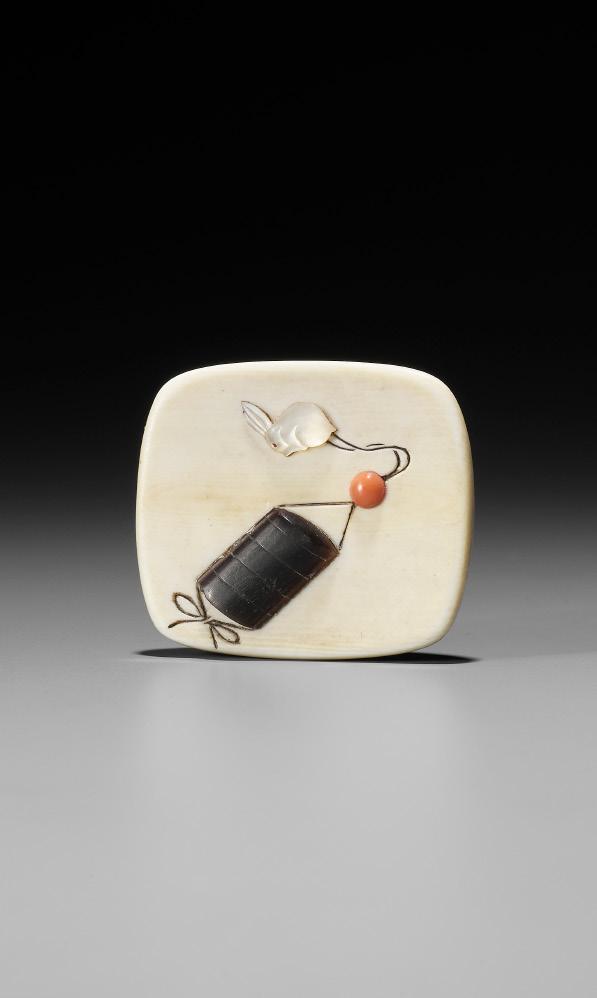
LENGTH 4.2 cm
Condition: Very good condition, minor wear, age cracks.
Estimate EUR 1,200
Starting price EUR 600
300
281
A SHIBAYAMA-INLAID IVORY NETSUKE OF A CAPARISONED SHISHI
Unsigned Japan, Tokyo, late 19th century, Meiji period (1868-1912)
Well carved as a recumbent shishi atop an oval base, the beast richly adorned with beads and tassels inlaid with coral, gilt-metal, horn, and stained bone, the saddlecloth further carved in relief with stylized lotus and scrolling foliage, its claws and face well detailed, the bushy mane, brows, and tail neatly incised, the base with two asymmetrical himotoshi.
LENGTH 3.3 cm
Condition: Very good condition, minor wear, few fine age cracks.
LITERATURE COMPARISON
Compare a closely related inlaid ivory netsuke of a caparisoned shishi, signed Shibayama, illustrated in Meinertzhagen, Frederick / Lazarnick, George (1986) MCI, Part B, p. 727.
Estimate EUR 1,200
Starting price EUR 600
282
TOSHINAGA: AN IVORY NETSUKE OF A SHISHI WITH YOUNG


By Toshinaga (Juei), signed Toshinaga 壽永 with kakihan Japan, Edo (Tokyo), mid-19th century, Edo period (1615-1868)
Finely carved and stained with sumi (ink) as a large snarling shishi with its young next to it, the cub scratching its ear with its hind paw and nestling up close to the mother. The composition is set on an oval base, the underside polished smooth and with a central himotoshi and the neatly incised signature TOSHINAGA (Juei) and kakihan.

LENGTH 3.7 cm
Condition: Excellent condition with minor expected surface wear.
Estimate EUR 1,500
Starting price EUR 800
301
283
AN AMUSING EDO SCHOOL WOOD NETSUKE OF A MAN PLUCKING HIS BEARD


Unsigned Japan, Edo (Tokyo), 19th century, Edo period (1615-1868)
Well carved as a kneeling man wearing voluminous robes with subtle mother-of-pearl and bone inlays, plucking his beard with tweezers held in his right hand, his face with a humorously agonized expression, the mouth wide open as he lets out a scream, the underside well detailed with the man’s feet and the folds of his robe, as well as two asymmetrical himotoshi, the details neatly incised and darkly stained.
HEIGHT 3.6 cm
Condition: Very good condition, appealingly worn.
Estimate EUR 1,000
Starting price EUR 500
284
Painting of a man plucking his beard with tweezers, by Ogawa Haritsu (Ritsuo)
AN EDO SCHOOL WOOD NETSUKE OF A FARMER TYING HIS GETA AND CLEANING HIS TEETH

Unsigned Japan, Edo (Tokyo), early to mid-19th century, Edo period (1615-1868)
The elderly man crouching to tie the strap on one of his geta sandals, wearing a short robe tied at the waist and suspending a tonkotsu (tobacco box) and kiseru (pipe), a sickle attached to his back, his face contorted in a grimace as he cleans his teeth using a fusayoji (tufted toothpick). The side and back with generously excavated, asymmetrical himotoshi, the larger of which is of oval shape.


HEIGHT 4.5 cm
Condition: Very good condition with minor wear and rubbing to patina.
Provenance: From the collection of Gaston Lazard (1878-1956) and his wife Jane Levy (1886-1985) and thence by descent within the same family.
Chew sticks are twigs or roots of certain plants that are chewed until one end is frayed. This end can be used to brush against the teeth, while the other end can be used as a toothpick. The earliest chew sticks have been dated to Babylonia in 3500 BC and an Egyptian tomb from 3000 BC. They are mentioned in Chinese records dating from 1600 BC, in the Ayurvedas around the 4th century BC and in Tipitaka, in the Buddhist Canon around the 5th century BC in India. The custom came to Japan with Buddhism and became popular during the mid-Edo period. Fusayoji (tufted toothpicks) were made from fragrant trees such as willow and black letters and were sold at shrine precincts.
Estimate EUR 1,500
Starting price EUR 800
A beauty cleaning her teeth with a fusayoji, by Utagawa Kunisada (1786-1865), University of Pittsburgh
302
285
A WOOD NETSUKE OF SAIGYO HOSHI ADMIRING MOUNT FUJI


Unsigned Japan, late 18th to early 19th century, Edo period (1615-1868)
The priest and poet Saigyo Hoshi seated at the foot of Mount Fuji, gazing up and admiring the iconic peak, his hat and cane carved by his side next to a finely incised pine tree. The well-toned wood bearing a fine patina. Large, generously excavated himotoshi through the neatly polished base.
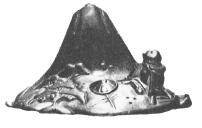
LENGTH 5.5 cm
Condition: Very good condition, minor and typical wear.
LITERATURE COMPARISON
A similar item from the British Museum, formerly part of the Sir Augustus Wollaston Franks Collection, is illustrated by Joly, Henri (1908) Legend in Japanese Art, p. 155.
Estimate EUR 1,500
Starting price EUR 800
286
ITTOKUSAI: AN INTERESTING GOLD-LACQUERED WOOD OKIMONO NETSUKE OF DAIKOKU
By Ittokusai, signed Ittokusai 一徳齋 Japan, 19th century
The lucky god standing and kneeling one leg against a straw rice bale, his treasure bag slung over his bag and holding his wishgranting mallet with a rat on top. His expression is marked with joy, framed by pendulous earlobes, and the facial features are carved in a rather unusual portrait-esque manner. Remnants of gold lacquer throughout, attractively worn. Himotoshi to the back and signed to the bag ITTOKUSAI.

HEIGHT 6.2 cm
Condition: Very good condition, the gold lacquer attractively worn. Remnants of wax to the underside.
Provenance: Private collection, Germany, collected between 1920 and 1940 (sold at Nagel, Stuttgart, 12.5.2007, lot 2730). Lempertz, The Kolodotschko Collection of Netsuke III, 5 June 2015, Cologne, lot 1076. A noted private collection, USA, acquired from the above. Old label to the back: “Hömberg 189”, with ink markings.
Estimate EUR 1,000
Starting price EUR 500
303
ITTEI: AN AMUSING WOOD NETSUKE OF FUKUROKUJU

By Ittei, signed Ittei 一亭 Japan, late 19th to early 20th century
The lucky god Fukurokuju wearing a Buddhist garb, his elongated head of distinctly phallic shape, the face with an amusing expression. The pupils are inlaid in dark horn. Large, asymmetrical himotoshi through the back and signed underneath ITTEI.

HEIGHT 7.5 cm
Condition: Good condition, minor wear and traces of use. One inlaid pupil is lost.
Estimate EUR 1,500
Starting price EUR 800
288 HIDESADA: A FINE WOOD NETSUKE OF OKAME AND FUKUSUKE
By Hidesada, signed Hidesada 秀貞 Japan, 19th century, Edo period (1615-1868)
The lucky dwarf with characteristically large head and formal dress, holding a fan and kneeling besides Okame, both with cheerful expressions as they marvel at the treasures on the offering table (sanbo) before them, the forked radish (futumata daikon) and inexhaustible money pouch (kanebukuro) associated with Daikoku (the god of wealth).
WIDTH 4 cm
Condition: Good condition, minor wear, few tiny age cracks. Okame’s hand is re-attached.
Fukusuke and Okame are often depicted together as they are both emblems of good luck. The motif of the present netsuke is associated with the New Year and expresses a wish for happiness and wealth.

MUSEUM COMPARISON
Compare a closely related ivory netsuke by Hidechika depicting the same subject, in the Kunstpalast Düsseldorf, object number mkp.P 2005-208.
Estimate EUR 1,500
Starting price EUR 800
304
287
289
GYOKUMINSAI: A WOOD EDO SCHOOL NETSUKE OF A KARAKO PULLING HOTEI INSIDE HIS TREASURE BAG
By Gyokuminsai, signed Gyokuminsai 玉民齋 Japan, Edo (Tokyo), first half of 19th century, Edo period (1615-1868)
Finely carved as the lucky god Hotei relaxing inside his treasure bag, looking upwards and laughing, holding a bone-inlaid tama in his left hand, all while being pulled along by a karako (Chinese boy). Large, asymmetrical himotoshi underneath and signed GYOKUMINSAI.
LENGTH 4.4 cm
Condition: Very good condition with minor typical wear and few traces of use including some tiny nicks.
Estimate EUR 1,000
Starting price EUR 500
290
SHUMIN: A WOOD NETSUKE OF DARUMA


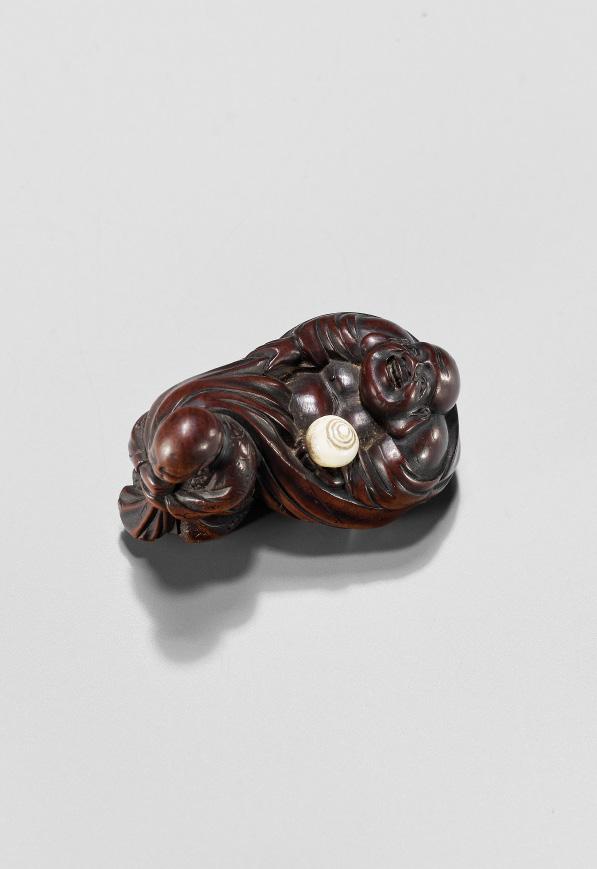
By Shumin, signed Shumin 舟民 Japan, Edo (Tokyo), mid-19th century, Edo period (1615-1868)
The Zen patriarch Daruma, bare-chested and almost completely enveloped in his robe, is shown meditating with a stern-faced expression. The garment folds are powerfully accentuated, and the facial expression is expertly crafted. The earrings are inlaid and the large and asymmetrical himotoshi are ringed in stained bone. Signed SHUMIN, who was a pupil from the Shugetsu line of carvers.

HEIGHT 4.1 cm
Condition: Excellent condition, minor wear.
Provenance: Collection Prof. Dr. Henk C. Hoogsteden, Rotterdam, purchased at Hotel Drouot, Paris, in 2004.
AUCTION COMPARISON
A closely related netsuke of Daruma, by Shumin, was sold at Zacke, Fine Netsuke & Sagemono, 22 April 2022, Vienna, lot 190 (sold for 2,022 EUR).
Estimate EUR 1,500
Starting price EUR 800
305
291
A WOOD NETSUKE OF AN ONI AT SETSUBUN, ATTRIBUTED TO ROKKO
Unsigned Japan, Tokyo, late 19th century
Well carved as a muscular oni running to escape from those pelting him with soybeans, holding a large straw hat over his back and head, his two horns poking through the hat. His hair, brows, garment, and straw hat are neatly incised. The pupils are inlaid with ebony, the mouth agape in an agonized expression showing teeth and sharp fangs. The straw hat with two asymmetrical himotoshi.
HEIGHT 4 cm
Condition: Excellent condition with minor wear.
Provenance: French private collection purchased from Galerie Yamato, Paris, 2004.
The Setsubun festival is celebrated during the first day of spring and includes the rite of oni-yarai or mame-maki, where roasted beans are thrown at oni to rid the coming year of any demons and disease-bringing spirits.
LITERATURE COMPARISON
Compare a closely related wood netsuke of an oni at Setsubun by Rokko, 4.5 cm high, dated 19th century, illustrated in Sagemonoya (2001) Netsuke That Never Left Japan, no. 25. Compare a closely related wood netsuke of an oni at Setsubun by Rokko, 5.7 cm high, dated 19th century, illustrated in Galerie Zacke (1982) Netsuke, no. 112.
Estimate EUR 3,000
Starting price EUR 1,500
292 SHOKO:
A WOOD NETSUKE OF IDATEN SUBDUING AN ONI



By
Shoko
Sugonoya, signed Shoko 尚古 Japan, Hida-Takayama, second half of 19th century
The okimono-style netsuke finely carved to depict Idaten dressed in full Tang Chinese armor including an elaborate feathered helmet, with windswept sleeves, pressing his knee and hand down against an oni, the looted pagoda-shaped reliquary in the deity’s other hand, the entire composition set on a cloud-shaped base. The eye pupils are minutely inlaid in dark horn. Signed underneath SHOKO. Natural himotoshi.
HEIGHT 4.3 cm
Condition: Very good condition with minor associated surface wear. A tiny pinhole to the interior of the sleeve.
Provenance: Collection Prof. Dr. Henk C. Hoogsteden, Rotterdam, purchased at Lempertz, The Kolodotschko Collection of Netsuke III, 5 June 2015, Cologne, lot 1196.
Hashimoto Gaho, Idaten Pursuing an Oni, c. 1885 (Philadelphia Museum of Art, accession no. 1941107-15)

Literature comparison: The subject appears to be rare. For another variation of this subject, by Nishino Shoko, described as Bishamonten pursuing an oni, see the International Netsuke Collectors Society Journal (INCSJ), vol. 10, no. 4, p. 44, no. 79.
Estimate EUR 2,000
Starting price EUR 1,000
306
293
GYOKKO: AN IVORY NETSUKE OF A ONI WASHING A RAKAN


late 19th century
By Gyokko, signed Gyokko 玉光 Japan, Tokyo,
An oni (devil) strains to scrub the back of a rakan bathing in a tub. Rakan are the disciples or followers of Buddha, called arhat in sanskrit, vaguely comparable to the apostles. They are bald and wear rings on their ears. The rakan here pulls an amusingly grim face as the oni deliberately works on him with all his force. The details such as the expressions and the cloth held by the rakan are superbly carved, the ivory is attractively stained, and the tub is minutely stippled and stained with sumi (ink). Two himotoshi underneath and signed within an oval reserve GYOKKO.
LENGTH 4.2 cm
294
GYOKKOSAI: A FINE IVORY NETSUKE OF RAIJIN

By Gyokkosai, signed Gyokkosai 玉光齋 Japan, Edo (Tokyo), mid-19th century, Edo period (1615-1868)
The Thunder God seated in lotus position, applying studs to his drum and holding a hammer in his right hand. His expression is amusingly carved as he contemplated his carpentry work. The ivory is lightly stained in the typical manner of the artist. Two small himotoshi to the back and signed underneath GYOKKOSAI.
HEIGHT 3.6 cm
Condition: Excellent condition with minor typical wear.
Gyokkosai was an accomplished student of Ikkosai Saito Itaro, for a discussion of his work see the International Netsuke Society Journal (Spring 2019) Vol. 39, no. 2, pp. 18-20.
Estimate EUR 1,500
Starting price EUR 800
Condition: Excellent condition, minor typical wear. Remnants of wax from an old label.
Provenance: From the collection of Gaston Lazard (1878-1956) and his wife Jane Levy (1886-1985) and thence by descent within the same family.
Estimate EUR 2,000
Starting price EUR 1,000
307
296
IKKOSAI: AN IVORY MANJU NETSUKE OF A DRUNKEN SHOJO

By Ikkosai Kojitsu, signed Ikkosai 一光齋 Japan, Edo (Tokyo), mid-19th century, Edo period (1615-1868)
The two-part manju worked in shishiaibori (sunken relief) with a drunken shojo dancing; holding a sake ladle and fan, her robe neatly detailed and engraved with various patterns, and her hair and lips stained red. The reverse is engraved with red sake saucer (sakazuki) and the signature IKKOSAI. Ikkosai Kojitsu was an accomplished pupil of Meikeisai Hojitsu. Central himotoshi through the back, the cord attachment within.
DIAMETER 4.2 cm
Condition: Excellent condition.
Provenance: Max Rutherston Ltd., 2012. Prof. Dr. Henk C. Hoogsteden, Rotterdam, acquired from the above.
Estimate EUR 1,200
Starting price EUR 600
295
A LARGE IVORY MANJU NETSUKE OF A DRAGON ABOVE WAVES
Unsigned Japan, mid-19th century, Edo period (1615-1868)
The thick manju netsuke worked in shishiaibori (sunken relief) with fine engraving, the details enhanced with sumi (ink), depicting a sinuous dragon below clouds, the reverse engraved with crashing waves. The cord attachment through the eyelet housed inside the central peg.

DIAMETER 5.5 cm
Condition: Very good condition with minor wear and few natural age cracks.
Estimate EUR 1,200
Starting price EUR 600
308
297
SORIN: AN IVORY MANJU NETSUKE WITH DAIKOKU AND RAT
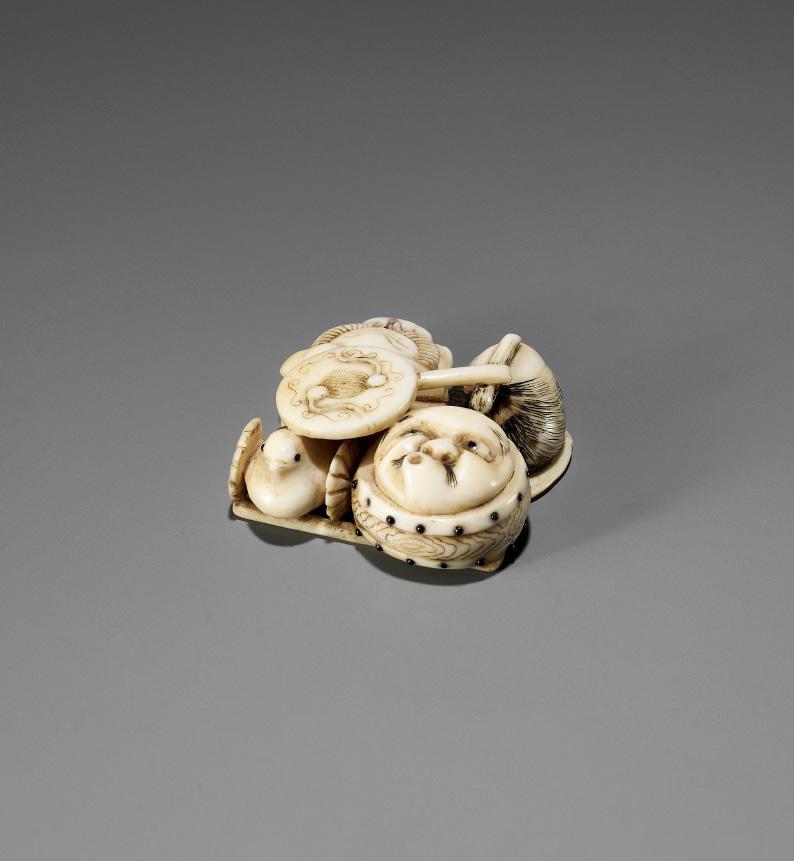
 By Sorin, signed Sorin 宗琳 and kakihan Japan, mid-19th century, Edo period (1615-1868)
By Sorin, signed Sorin 宗琳 and kakihan Japan, mid-19th century, Edo period (1615-1868)
The two-part manju finely worked in shishiaibori (sunken relief) with a charming image of the lucky god of wealth Daikoku leaning against his treasure bag and his extending his wish-granting mallet (uchide no kozuchi), while a rat clambers onto the hammer and presents a tama (magical jewel) to the lucky deity. The details are stained with ink and red pigments. The reverse is engraved with lucky treasures and signed SORIN and kakihan. Central, florally rimmed himotoshi to the back, the cord attachment within.
DIAMETER 4.8 cm
Condition: Very good condition, minor wear. Provenance: Christie’s, Asian Art, 19 July 2007, London, lot 13 (part lot, sold for 1,020 GBP). Belgian private collection, acquired from the above.
Estimate EUR 1,000
Starting price EUR 500
298
A WALRUS TUSK NETSUKE OF A GROUP OF NOH THEATRE ACCOUTREMENTS
Unsigned
Japan, c. 1860
Including a shishimai mask, a hyottoko mask, a fan, a wig, a drum, a rattle, a toy bird, a fan and a scythe. The studs of the drum and the eyes of the toy bird are inlaid in dark horn. Two himotoshi underneath.
LENGTH 3.6 cm
Condition: Good condition with minor expected wear. A small loss to the nose of the shishimai mask.
Estimate EUR 1,000
Starting price EUR 500
309
299
A RARE IVORY NETSUKE OF OTSUYU WITH THE PEONY LANTERN
Unsigned Japan, Meiji period (1868-1912)
Carved as Otsuyu’s skeleton from the kaidan (ghost story) of the Botan Doro (peony lantern). The skeleton shown here with a large lotus leaf on her head, carrying a large dragon mask on her back, its horns protruding through the leaf, and holding the peony lantern by its side. The details are finely carved. The cord channel runs through underneath the dragon mask.
HEIGHT 7 cm
Condition: Chip to one horn of the dragon, otherwise good condition with minor wear.
Provenance: From the collection of Gaston Lazard (1878-1956) and his wife Jane Levy (1886-1985) and thence by descent within the same family.
According to the Kaidan Botan Doro, Otsuyu, a devoted wife, having died, rose nightly from her grave to rejoin her husband secretly. But on revealing the secret he also met a gruesome death.

LITERATURE COMPARISON
There are only two other netsuke recorded of this subject. Both are illustrated in Lazarnick, George (1981) Netsuke & Inro Artists, and How to Read Their Signatures (LNIA), Vol. 2, p. 1076, one being signed Tametaka and the other attributed to Tametaka.
Estimate EUR 1,500
Starting price EUR 800
300
SHURAKU: A RARE IVORY NETSUKE OF A ROKUROKUBI SCARING A BLIND MAN





By Shuraku, signed Shuraku 秀樂 Japan, Edo (Tokyo), mid-19th century, Edo period (1615-1868)
Finely carved and bearing an attractive yellowish stain, the blind man leaning against his staff, behind him the towering Rokurokubi tries to scare him, the bakemono’s long neck movable and fixed with a peg to the side. Large himotoshi through the back and signed within an oval reserve SHURAKU.
HEIGHT 5.1 cm (neck not extended)
Condition: Excellent condition with minor wear and few natural age cracks.
Provenance: From the collection of Gaston Lazard (1878-1956) and his wife Jane Levy (1886-1985) and thence by descent within the same family.
MUSEUM COMPARISON
Compare a wood netsuke depicting the same subject, by Ryukei, in The Metropolitan Museum of Art (The MET), New York, accession no. 10.211.2369.
Estimate EUR 1,500
Starting price EUR 800
310
302 TADACHIKA: AN IVORY NETSUKE OF TWO PLAYING KARAKO

 By Tadachika,
By Tadachika,
301 GYOKKEI: A FINE INLAID WOOD NETSUKE OF A SAMBASO DANCER
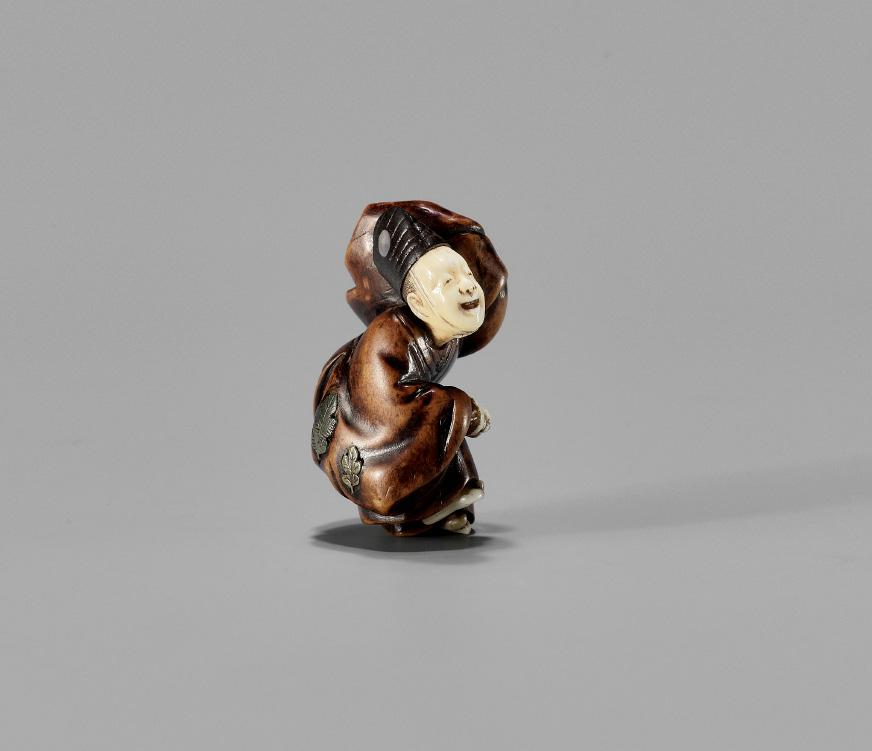 By Gyokkei, signed Gyokkei 玉珪 Japan, Tokyo, second half of 19th century
By Gyokkei, signed Gyokkei 玉珪 Japan, Tokyo, second half of 19th century
Finely carved as a sambaso dancer depicted in movement, his face, bell-tree, feet and eboshi hat inlaid, the lightly stained wood robe neatly polished and embellished with green-stained pine leaves. Good himotoshi through the back and signed within an inlaid plaque GYOKKEI.
HEIGHT 4.4 cm
Condition: Very good condition with minor expected wear.
Estimate EUR 1,500
Starting price EUR 800
The two Chinese boys seated across from each other, one hiding a demon mask behind his back and making the bekkako gesture, while his companion playfully grabs him by the arms. The details are finely carved and the clothes are embellished with meticulously rendered patterns. The ivory is lightly stained. The underside shows the signature TADACHIKA (a pupil of Tomochika) within a wavy reserve. Natural himotoshi.
LENGTH 4.5 cm
Condition: Excellent condition with minor wear.
Provenance: An old Dutch private collection. Pranger Oriental Art, Amsterdam. Collection Prof. Henk Hoogsteden, Rotterdam, acquired from the above.
Estimate EUR 1,500
Starting price EUR 800
311
signed Tadachika 忠親 Japan, Edo (Tokyo), mid-19th century, Edo period (1615-1868)
303 A WOOD NETSUKE OF ASHINAGA AND TENAGA CATCHING A FISH
Unsigned Japan, 19th century, Edo period (1615-1868)
The symbiotic pair of yokai-fishermen working together to catch a fish, Ashinaga stepping on the fish and Tenaga pulling it out from underneath his foot. The legendary pair is depicted here in an unusual and humorous manner as foreigners, the long-armed Tenaga in the back pulling up the long-legged Ashinaga’s robe to protect it from the water. The details are finely carved, the well-toned wood bearing a fine patina, the eyes inlaid in dark horn. Good himotoshi through the back.
HEIGHT 7.8 cm
Condition: Very good condition with minor expected wear. Tiny chip to the side of one foot and around the himotoshi.
Estimate EUR 1,200
Starting price EUR 600
304 A TOMOCHIKA SCHOOL WOOD NETSUKE OF ASHINAGA AND TENAGA
Unsigned Japan, Edo (Tokyo), early 19th century, Edo period (1615-1868)
Finely carved, Ashinaga with his long legs drawn to his body, a drum at his hip, while Tenaga places his long arms on his companion’s knees. The pair is depicted here as islanders with curly hair and clad only in loincloths. The facial features are sublimely carved. One himotoshi through the underside. Unsigned, however in the style of Chikuyosai Tomochika of Edo. Due to the use of wood and the fine patina this is likely an early piece from this famous school.

LENGTH 3.8 cm, HEIGHT 3.7 cm
Condition: Very good condition with only very minor wear and traces of use. Beautiful patina.
Provenance: Ex-collection Papp, collection no. 466, purchased from Helmut Laudenbach, Berg, on 20 November 1986. Lempertz, The Papp Collection of Netsuke, 16 June 2018, Cologne, lot 1029. Collection Prof. Henk Hoogsteden, Rotterdam, acquired from the above.



Estimate EUR 1,200
Starting price EUR 600
312
305
A TALL EBONY WOOD NETSUKE OF ASHINAGA AND TENAGA

Unsigned Japan, late 18th to early 19th century, Edo period (1615-1868)
A tall and boldly carved ebony wood netsuke depicting the two legendary yokai-fishermen working together to catch a fish. The long-legged Ashinaga is struggling to support Tenaga on his back with his short arms, grabbing his companion by his feet, who as a result hangs over Ashinaga’s shoulders in an amusingly awkward position while desperately reaching with his long arms to pull the fish out of the water. A remarkably well-carved and characterful rendition of this classic subject. Natural himotoshi.

HEIGHT 10.4 cm
Condition: Excellent condition. Minor wear.
Provenance: A noted private collection, USA.
Estimate EUR 1,500
Starting price EUR 800
313
306 AN IVORY NETSUKE OF SHOKI

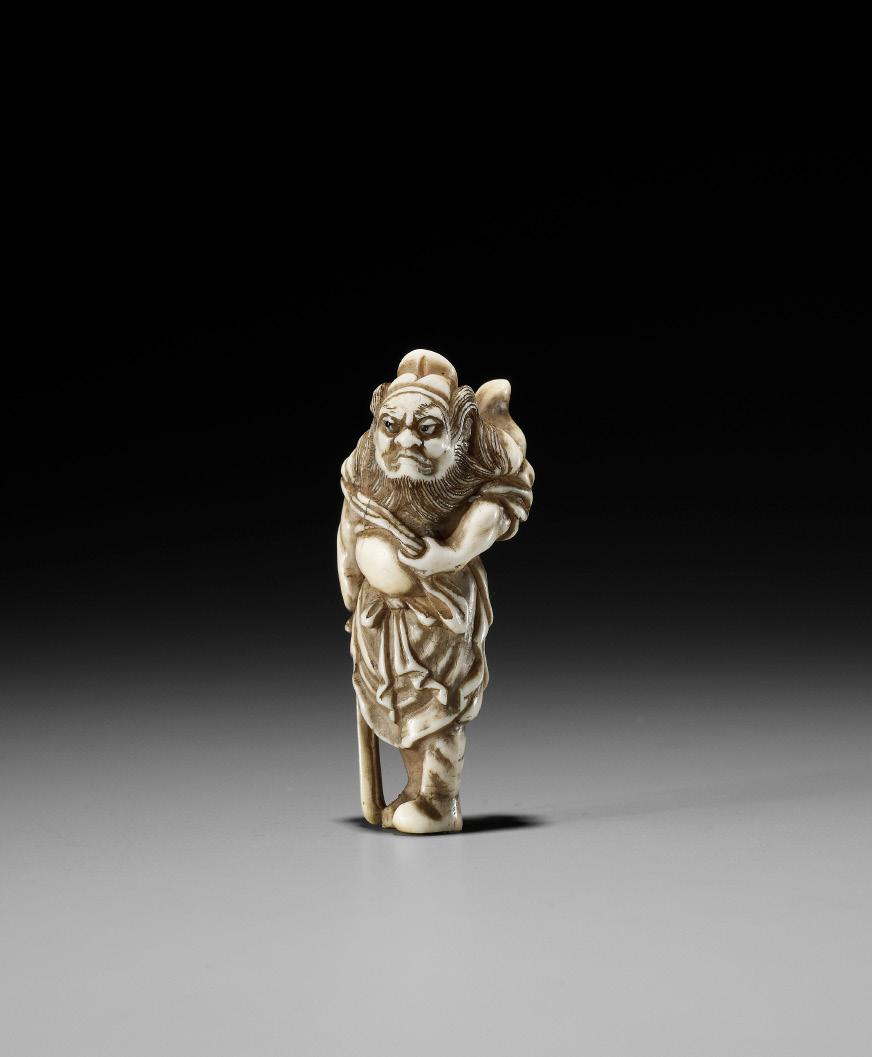
Unsigned Japan, first half of 19th century, Edo period (1615-1868)
The demon queller standing with his sword drawn by his side, his face with a grim expression, the eyes inlaid, his loosely fitted robe well carved with windswept sleeves. Natural himotoshi between Shoki’s arm and body.
HEIGHT 6.1 cm
Condition: Very good condition with minor wear and few natural age cracks.
Estimate EUR 1,500
Starting price EUR 800
307 A RARE IVORY NETSUKE OF A WARRIOR
Unsigned Japan, probably Osaka, 19th century, Edo period (1615-1868)
Depicting a warrior clad in full armor, his tanto blade drawn, sitting in wait as he looks to his left with a fierce expression. The tehen-kanamono of his kabuto is inlaid in dark horn and the front of the helmet is inlaid with three gilt roundels. Himotoshi through the back. The fine yellowish stain, expressively carved facial features, and karakusa engraving on his clothes indicate an Osaka school artist such as Hidemasa.
HEIGHT 3.7 cm
Condition: Excellent condition, minor wear.
Provenance: Collection Prof. Henk Hoogsteden, Rotterdam.
Estimate EUR 1,500
Starting price EUR 800
314
308
A POWERFUL WOOD NETSUKE OF INO HAYATA SLAYING THE NUE




Unsigned Japan, Edo (Tokyo), 19th century, Edo period (1615-1868)

Ino Hayata and the nue engaged in mortal combat on top of a finely carved cloud base, the mythical creature terrified as Hayata, clad in full armor, holds his drawn sword to the nue’s body, ready to strike. Large himotoshi formed by a gilt kiku-framed cord hole underneath.
HEIGHT 4.7 cm
Condition: Excellent condition with minor wear.
Provenance: Ex-collection Reinhard Schulze, purchased between 1937 and 1945 in Japan. Lempertz, Asian Art, 9 December 2017, Cologne, lot 475 (sold for 2,728 EUR).
The nue is a mythological chimera having the head of monkey, the limbs of a tiger, the body of a tanuki, and a snake as a tail.
Estimate EUR 3,000
Starting price EUR 1,500
315
Ino Hayata slaying the Nue, Utagawa Kunisada (1786-1866)

Unsigned Japan, Osaka, late 18th to early 19th century, Edo period (1615-1868)
Superbly carved as an old peasant wearing an elaborately carved headcloth and robe with expressively carved garment folds, fondling a bag with both hands, the facial features masterfully carved with many wrinkles and pronounced cheekbones. Good, chimney-type himotoshi to the back. The well-toned wood bearing a fine patina.
HEIGHT 9.4 cm
Condition: Good condition with minor wear and traces of use. The feet have been repaired and there are a few fills to the robe as visible in the images provided.
Unsigned, however in the style of the enigmatic master carver Sanko who seldomly signed his carvings and whom many famous works are attributed to such as the legendary ‘Meinertzhagen Kirin’. A work depicting a man-faced kirin, which is attributed to the artist, has recently broken the world record for a netsuke at auction (441,375 USD).
Another possibility is a later generation of artists working in the Osaka style, such as Kokeisai Sansho (1871-1936), though the present piece certainly has an earlier feel to it. For a similar example by this artist see The Metropolitan Museum of Art (The MET), New York, accession no. 10.211.2319.
AUCTION COMPARISON
Compare a related wood netsuke of an Oni Nenbutsu, signed Sanko, at Bonhams, Netsuke from the Collection of Joseph and Elena Kurstin, 16 December 2022, New York, lot 32 (sold for 96,135 USD). Also compare an ivory netsuke of Ryujin, attributed to Sanko, at Zacke, Fine Netsuke & Sagemono, 16 April 2021, Vienna, lot 65 (sold for 9,150 EUR).





Estimate EUR 4,000
Starting price EUR 2,000
317
309
A SUPERB AND LARGE OSAKA SCHOOL WOOD NETSUKE OF A PEASANT
310
A POWERFUL SAISHIKI NETSUKE OF SHOKI AND ONI, STYLE OF YOSHIMURA SHUZAN
Japan, Osaka, 18th century, Edo period (1615-1868)
Boldly carved and well painted as the demon queller Shoki lifting a fierce little oni by its neck, the poor demon unable to free itself, and holding a sword in his right hand. Shoki’s face with a grim expression marked by furrowed brows and a long, neatly incised beard. Large himotoshi.
HEIGHT 8.6 cm
Condition: Very good condition with minor typical wear.
LITERATURE COMPARISON
Compare a related saishiki netsuke of Shoki with an oni, attributed to Yoshimura Shuzan, illustrated in Arakawa, Hirokazu (1983) The Go Collection of Netsuke. Tokyo National Museum, p. 16, no. 12. A saishiki netsuke of Shoki, by a follower of Shuzan, dated to the late 18th century, is in the collection of the Los Angeles County Museum of Art, accession number M.87.263.93.
AUCTION COMPARISON
Compare a closely related saishiki netsuke depicting Shoki and oni at Zacke, Fine Netsuke & Sagemono, 29 October 2021, Vienna, lot 275 (sold for 12,640 EUR).



Estimate EUR 2,000
Starting price EUR 1,000
311
A WOOD NETSUKE OF SHOKI TRAPPING AN ONI


Unsigned Japan, 19th century, Edo period (1615-1868)
The demon queller shown here with a fierce expression and pressing his weight down against a tattered straw hat, his sword drawn, a squirming oni trapped underneath. The details are finely carved and the lightly stained wood bears a good, dark patina. Himotoshi to Shoki’s back.
HEIGHT 3.5 cm
Condition: Good condition. Few splits to the wood and possibly some old chips to the tattered hat.
Provenance: A noted private collection, USA.
Estimate EUR 1,500
Starting price EUR 800
312
HIROSHI ASAOKA: A CONTEMPORARY WOOD NETSUKE OF SHOKI SEARCHING FOR AN ONI OJIME
 By
By
Hiroshi
Asaoka
(born 1923), signed Shodo
Japan, Tokyo, 20th century
Finely carved in pale boxwood, depicting the demon queller Shoki, his sword drawn, looking through a well and searching for the oni, in the form of an ojime, which is attached to the netsuke with a cord. Signed underneath Shoki’s robe SHODO.
HEIGHT 4.1 cm (the netsuke), HEIGHT 2.1 cm (the ojime)
Condition: Excellent condition with minor wear.
Hiroshi Asaoka, born in Tokyo in the year 1923, was a master of intricate detailed carvings who studied under Shomin.
Estimate EUR 1,500
Starting price EUR 800
昇堂
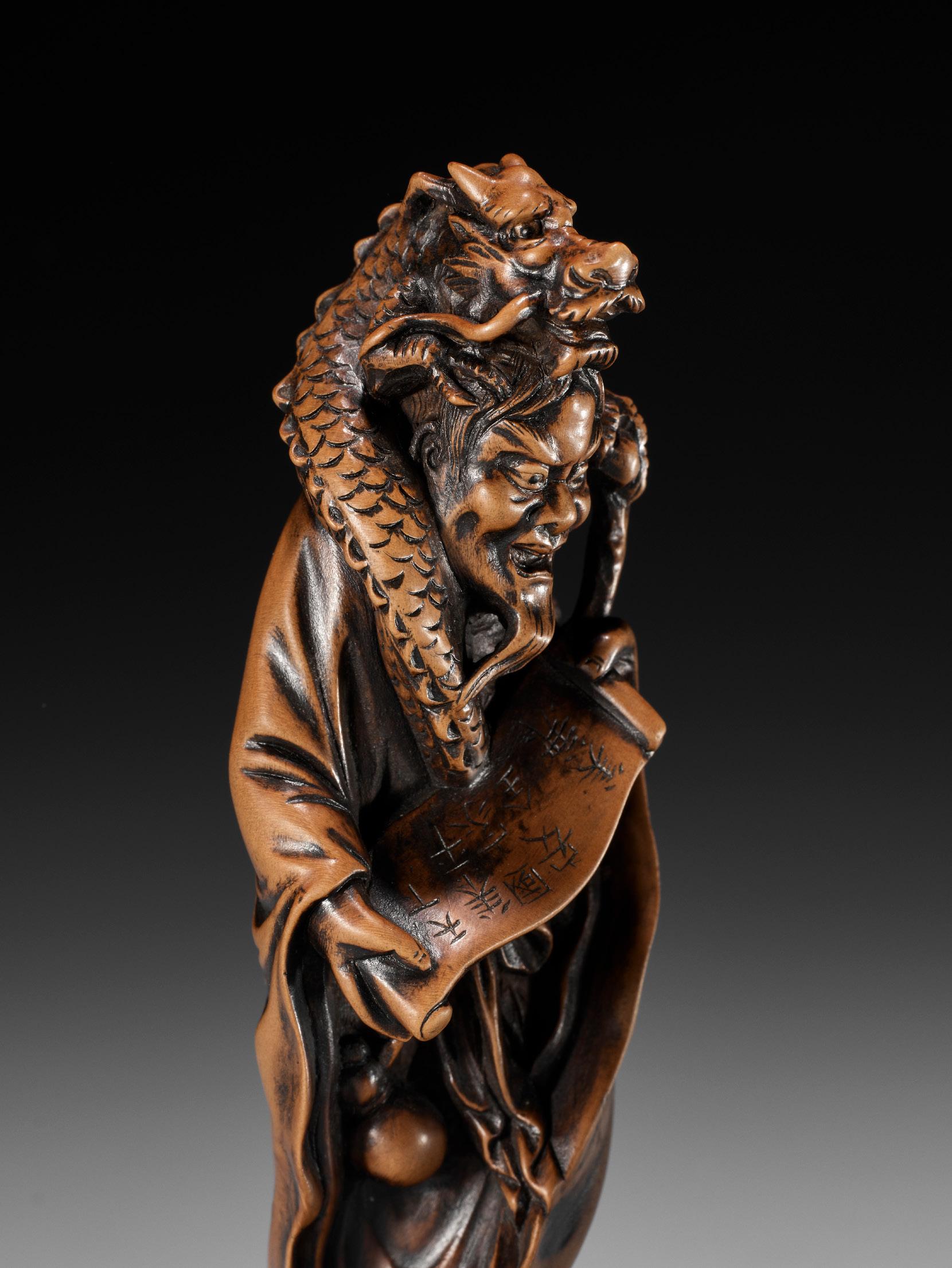
YOSHIKANE: A SUPERB TALL WOOD NETSUKE OF BASHIKO SENNIN



 By Yoshikane, signed Yoshikane 美兼 Japan, Tokyo, late 19th century
By Yoshikane, signed Yoshikane 美兼 Japan, Tokyo, late 19th century
The sennin dressed in an elaborately flowing, loosely fitted robe, with artemisia leaves carved in the back, a hyotan (double gourd) containing the elixir of life tied to his waist, reading from a scroll, his mouth agape dramatically, a sinuous dragon coiling outwards from within his robe and wrapping its scaly body around Bashiko, its head terminating on top of the sennin’s head, one claw grabbing the gnarly staff to Bashiko’s side. Asymmetrical himotoshi through the back. The details are exceptionally carved, and the wood is skilfully stained, the eyes of the sennin and dragon are inlays of dark horn. An inscription to the scroll reads 天下泰平、国家安 [peace reigns over the land, safe and security of the nation] next to the signature YOSHIKANE – a rarely encountered artist who worked in the style of Rokko.
HEIGHT 10.7 cm
Condition: Tiny chip to one of the dragon’s dorsal spikes, the toes of the sennin with repairs. Otherwise excellent condition with minor expected wear.
The subject is quite rare in netsuke art and usually misidentified as Chinnan Sennin or Rakan Handaka Sonja, who are both usually depicted with alms bowls from which they conjure the dragon. Bashiko Sennin was a healer of animals who came upon a sick dragon and remedied the dragon’s ailments with acupuncture. It is also possible that the present netsuke depicts Ryujin, the Dragon King of the Sea, depicted here in a sennin-like manner.
LITERATURE COMPARISON
Compare a closely related wood netsuke by Yoshikane, depicting Gama sennin with toad, illustrated in Lazarnick, George (1981) Netsuke & Inro Artists, and How to Read Their Signatures (LNIA), Vol. 2, p. 1232. Another wood netsuke by Yoshikane, depicting Chinnan sennin, is illustrated in Barry Davies Oriental Art (1996) Netsuke Through Three Centuries, pp. 80-81, no. 69.
Estimate EUR 6,000
Starting price EUR 3,000
321
313
314
SHUMIN:
A FINE WOOD NETSUKE OF A TEMPLE SERVANT

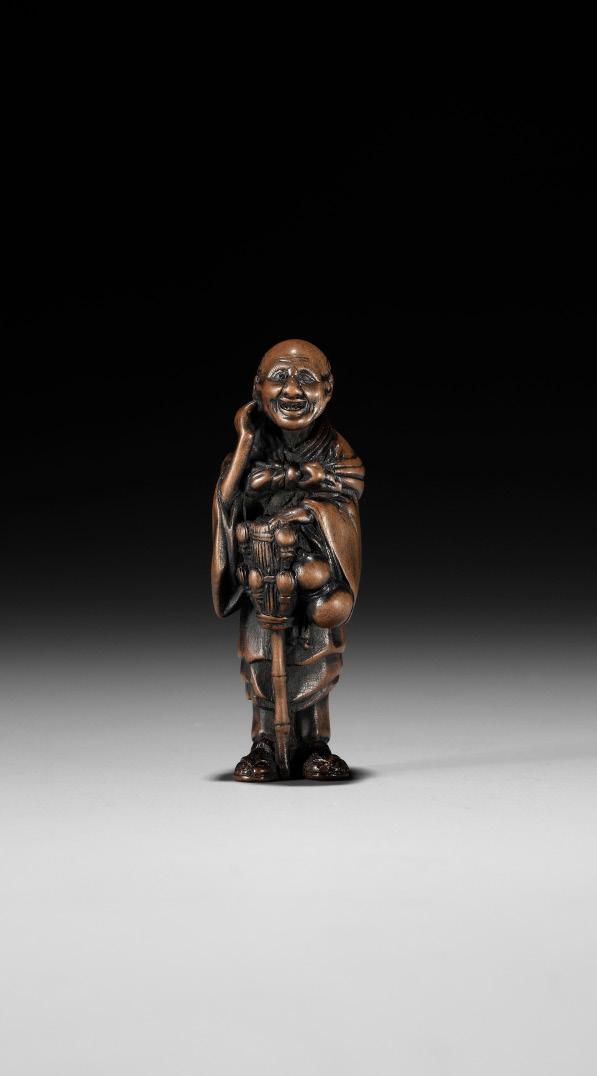

Published: Meinertzhagen, Frederick / Lazarnick, George (1986) MCI, Part B, p. 775.
International Netsuke Society Journal (INSJ), Winter 2021, vol.41, no. 4, p. 27 (Advert by Sydney L. Moss Ltd.)
By Hara Shumin,
Finely carved as a temple servant, seated in a relaxed pose and chanting, his eboshi tied around his neck in the back, the details exquisitely carved, the wood skillfully stained. The underside shows the elaborately crafted himotoshi formed by a large opening of the sleeve and a smaller himotoshi ringed in green-stained antler, as well as the signature SHUMIN.
HEIGHT 3.9 cm
Condition: Excellent condition with minor wear.
Provenance: Ex-collection H. Ellis, sold at Glendining’s, 9 November 1928, London.
Estimate EUR 3,000
Starting price EUR 1,500
315
ROKKO: A FINE WOOD NETSUKE OF A CHASEN (TEA WHISK) VENDOR
By Rokko, signed Rokko 六甲 Japan, Edo/Tokyo, mid to late 19th century
Finely carved as a man with a large bag slung over his bag, presenting his kagurachasen (whisk-tree), a hyotan tied to his obi. The man’s facial features are carved with masterful detail, the tiny pupils are inlaid in dark horn. Himotoshi through the back and signed to the hem of the robe ROKKO.
HEIGHT 5.5 cm
Condition: Repair to the left foot. Otherwise excellent condition with minor expected wear.
Estimate EUR 1,500
Starting price EUR 800
322
signed Shumin 秀民 Japan, Edo (Tokyo), mid-19th century, Edo period (1615-1868)
316
A FINE NAGOYA SCHOOL SHUNGA WOOD NETSUKE OF OKAME CRADLING A HUGE MUSHROOM
Unsigned Japan, Nagoya, early 19th century, Edo period (1615-1868)
Finely carved as the mirthful Shinto deity Okame kneeling and cradling a large mushroom of distinctly phallic shape in a suggestive position on her lap, laughing gleefully as a result. Her neatly tied up hair is finely carved, her kimono tied in the back houses the himotoshi. The well-toned wood bearing a beautiful, dark patina. Unsigned, however likely by a talented Nagoya carver such as Ittan.
HEIGHT 4 cm
Condition: Excellent condition with minor expected wear and a fine patina.
Provenance: Sold at Glendining’s, 9 November 1928, London. Excollection H. Ellis, acquired from the above.
AUCTION COMPARISON
Compare a related wood netsuke of man with Okame mask cradling a huge phallus at Bonhams, Netsuke from the Collection of Joseph and Elena Kurstin, 16 December 2022, New York, lot 7 (sold for 6,375 USD).



Estimate EUR 4,000
Starting price EUR 2,000
323
317 AN IVORY NETSUKE OF A DUTCHMAN
Unsigned Japan, 18th century, Edo period (1615-1868)
The early and tactile ivory netsuke of distinct triangular section (sankaku) and carved as a seated Dutchman wearing a characteristic hat and robe, and holding a fan in his left hand. Very large and generously excavated himotoshi through the back and underside. The ivory bearing a fine, yellowish honey patina.

HEIGHT 5.3 cm
Condition: Very good condition with minor wear and several natural age cracks.
Provenance: Belgian collection, purchased from Bonhams, Fine Japanese Art, 17 May 2018, lot 21 (part lot, sold for 3,500 GBP).
Estimate EUR 1,500
Starting price EUR 800
318
TOMO:
AN EARLY OSAKA SCHOOL IVORY NETSUKE OF HOTEI

Signed with a single character Tomo 友 Japan, Osaka, 18th century, Edo period (1615-1868)
A beautifully tactile and pleasingly worn ivory netsuke, bearing a deep honey patina, depicting the potbellied lucky god Hotei with his hands behind his back, his face framed by pendulous earlobes, the mouth slightly opened with a smile. Large himotoshi to the back and signed with a single character TOMO enclosed within a wavy reserve.
HEIGHT 5.6 cm
Condition: Good, attractively worn condition. Several natural age cracks.
Estimate EUR 1,500
Starting price EUR 800
324
319
AN EARLY WOOD NETSUKE OF A RECLINING HOTEI

Unsigned Japan, 18th century, Edo period (1615-1868)
An old and pleasingly tactile netsuke depicting the lucky god Hotei reclining and supporting his head in the right hand, wearing a loosely fitted robe, opening at the chest and revealing his potbelly, the surface pleasingly worn, the back with very large and generously excavated himotoshi.
LENGTH 8 cm
Condition: Very good condition, the surface pleasingly worn, minor traces of use, fine patina.
Estimate EUR 1,500
Starting price EUR 800
320
AN EARLY IVORY NETSUKE OF A RECLINING SAGE

Unsigned Japan, 18th century, Edo period (1615-1868)
The Chinese sage dressed in a voluminous robe and depicted in a reclining posture, leaning on one elbow, looking upwards and smiling. Large, generously excavated himotoshi to the back. Beautiful deepyellow patina throughout, turning honeycolored in the back.
LENGTH 7.6 cm
Condition: Very good condition with minor typical wear and very few natural age cracks.
Estimate EUR 1,200
Starting price EUR 600
325
321 A WOOD NETSUKE OF A DUTCHMAN WITH CHILD

Unsigned Japan, 18th century, Edo period (1615-1868)
Typically depicted with shoulder-length, curling hair and exaggerated features, clad in a coat of finely detailed texture with a pleated collar, carrying a boy on his back and a trumpet in his right hand. The expression of each is very finely crafted, the eyes with minutely carved pupils. The wood bearing a fine patina, large himotoshi through the back.
HEIGHT 7.2 cm
Condition: Repair to the right leg of the boy. Otherwise in good condition with typical wear and traces of use. Provenance: A noted private collection, USA.
In the Edo period, Dutch merchants were the only Europeans admitted to Japan, where they were confined to the island of Deshima. Netsuke representing foreigners were popular in this period, and a number of examples in ivory are in museum collections, including the Metropolitan Museum of New York (no. 10.211.1506) and the British Museum (F.558). Interestingly, the lapa (trumpet) in this Dutchman’s hand is also foreign, being of Chinese origin.
AUCTION COMPARISON
Compare a closely related wood netsuke of a Dutchman with child, sold at Zacke, Fine Netsuke & Sagemono, 22 April 2022, Vienna, lot 17 (sold for 3,034 EUR).

Estimate EUR 2,500
Starting price EUR 1,200
326
322
A RARE IVORY NETSUKE OF A SENNIN WITH ONI

Unsigned Japan, late 18th century, Edo period (1615-1868)
The gleefully laughing sennin standing tall and dressed in an elaborately flowing robe with incised cloud designs and wearing a tiger pelt cloak over his shoulders. He holds a fruiting branch in one hand while a mischievously grinning oni seated behind on his shoulders is grasping after the stem of the branch. Fine patina, particularly to the back.
HEIGHT 9.3 cm
Condition: Very good condition. The ivory slightly worn with a fine patina. A signature has been added, though is easily removed.
Estimate EUR 2,000
Starting price EUR 1,000
327
323
A RARE WOOD NETSUKE OF AN IMMORTAL

Unsigned
Japan, 18th century, Edo period (1615-1868)
Boldly carved to depict a Chinese immortal dressed in armor and billowing robes, holding a dragon staff in his right hand, the left raised at the chest with the palm facing to the side, the mouth slightly agape as he looks up toward the sky, his wild windswept hair neatly incised, the wood darkly stained for effect, the back with two asymmetrical himotoshi.
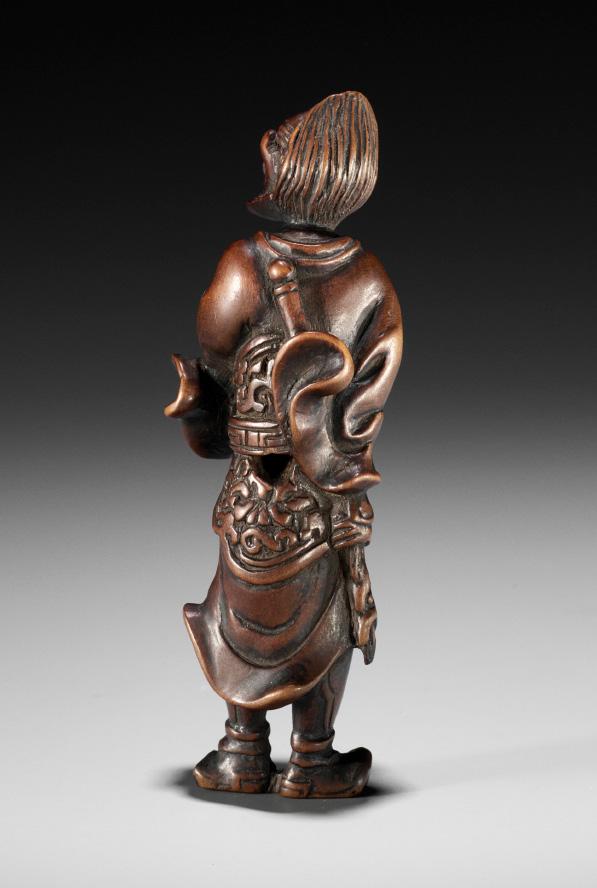

HEIGHT 9 cm
Condition: Good condition, appealingly worn, a loss to the dragon staff and a few minor chips which have smoothened over time.
Estimate EUR 3,000
Starting price EUR 1,500
328
324
A GOOD TALL WOOD NETSUKE OF TEKKAI SENNIN
Unsigned Japan, 18th century, Edo period (1615-1868)
The sennin wearing only a loincloth and artemisia leaf cloak, his features well-carved, leaning against his large, gnarly cane, his mouth agape as he expels his anima. The wood bearing a fine, dark patina. Large, generously excavated chimney-type himotoshi through the back and under the loincloth.

HEIGHT 10.4 cm
Condition: Some repairs to the cane, feet and one arm. Some rubbing to the surface and some general wear.
Estimate EUR 2,000
Starting price EUR 1,000
326
A
Unsigned Japan, 19th century, Edo period (1615-1868)
325
A WOOD NETSUKE OF A COILED DRAGON WITH TAMA


Unsigned Japan, 18th century, Edo period (1615-1868)
Boldly and powerfully carved as a one-horned, three-clawed dragon coiled around a large tama, its tail curling underneath the magical jewel, the scales and spine neatly incised, the beast further detailed with long trailing whiskers, large eyes, a spiky beard, and sharp fangs and claws, the tama with large, asymmetrical himotoshi.
HEIGHT 5 cm
Condition: Good condition, appealingly worn, few minor nicks.
Estimate EUR 2,500
Starting price EUR 1,200
Finely carved to depict a ferocious three-clawed dragon with sinuous body emerging from a cylindrical ash pot within a tabakobon (smoking set), the beast well detailed with neatly incised scales, spiky brows and beard, and large eyes, the mouth wide open revealing tongue and teeth. The base of the tabako-bon with two generously excavated asymmetrical himotoshi.
LENGTH 4 cm
Condition: Very good condition, minor wear, light surface scratches. Provenance: From the collection of Gaston Lazard (1878-1956) and his wife Jane Levy (1886-1985) and thence by descent within the same family.
The present netsuke illustrates the proverb Haifuki kara ryu (‘a dragon issuing from an ash container’), which is analogous to the expression Hyotan kara koma (‘a horse out of a gourd’), both conveying the idea of something unexpected happening. Another meaning of the former is said to be the hot air of a braggart. Sometimes daija (large snake) is substituted in this proverb for ryu. See Jonas, F. M. (1928) Netsuke, p. 112, and Volker, T. (1975) The Animal in Far Eastern Art, p. 64.
Estimate EUR 2,000
Starting price EUR 1,000
Haifuki kara daija (A Serpent Comes Out of the Ash Container), Kawanabe Kyosai (1831-1889), from the series Kyosai hyakuzu (One Hundred Pictures by Kyozan), 1863-1866, Museum of Fine Arts, Boston, accession number 11.37004

330
WOOD NETSUKE OF A DRAGON EMERGING FROM AN ASH POT (HAIFUKI KARA RYU)
327
TAMETAKA:
A WOOD NETSUKE OF A RECUMBENT OX



Japan, Nagoya, late 18th to early 19th century, Edo period (1615-1868)
Powerfully carved as a recumbent ox, its head lowered and tail flung to one side, the rope halter draped across its back, the ribs and spine subtly carved, the fur finely incised, the animal well detailed with curved horns, funnel-shaped ears, and large eyes double-inlaid with horn and dark pupils. The underside with large asymmetrical himotoshi and the signature TAMETAKA.
LENGTH 4.8 cm
Condition: Very good condition, minor wear, few small nicks.
Provenance: Bonhams, 14 December 2020, Los Angeles, lot 251 (sold for 3,825 USD).
LITERATURE COMPARISON
Compare to two wood netsuke depicting oxen by Tametaka in Lazarnick, George (1981) Netsuke & Inro Artists, and How to Read Their Signatures (LNIA), Vol. 2, p. 1075.
Estimate EUR 2,500
Starting price EUR 1,200
331
Signed Tametaka 為隆
328
IKKO:
A WOOD OKIMONO NETSUKE OF FIVE RATS AROUND DAIKOKU’S TREASURE BAG
By Ikko, signed Ikko 一光 Japan, late 19th century, Meiji period (1868-1912)
Finely carved and deeply stained as the lucky god Daikoku’s treasure bag, with neatly worked tassels and cords, and five rats with neatly incised fur and horn-inlaid eyes climbing around, into, and emerging from the bag. Asymmetrical himotoshi underneath and signed IKKO.
LENGTH 5.1 cm
Condition: One loss to one of the cords. Otherwise good condition with minor expected surface wear.
Provenance: Lempertz, The Kolodotschko Collection of Netsuke III, 5 June 2015, Cologne, lot 1237. A noted private collection, USA, acquired from the above.


AUCTION COMPARISON
Compare to a related ivory okimono netsuke of rats by Ikko at Zacke, Fine Netsuke & Sagemono, 16 April 2021, Vienna, lot 222 (sold for 5,490 EUR).

Estimate EUR 2,500
Starting price EUR 1,200
332
329
AN IVORY NETSUKE OF A RAT ON TREASURE BAG
Unsigned Japan, c. 1800, Edo period (1615-1868)
Finely carved as a rat clambering on top of Daikoku’s bag of riches, the large eyes of the rat inlaid in dark horn and the details stained with sumi (ink). The ivory bearing a fine honey patina. Large, asymmetrical himotoshi underneath.
LENGTH 4.3 cm
Condition: Excellent condition. Minor expected wear.
Estimate EUR 1,500
Starting price EUR 800
330
AN IVORY NETSUKE OF A RAT ON AWABI SHELL

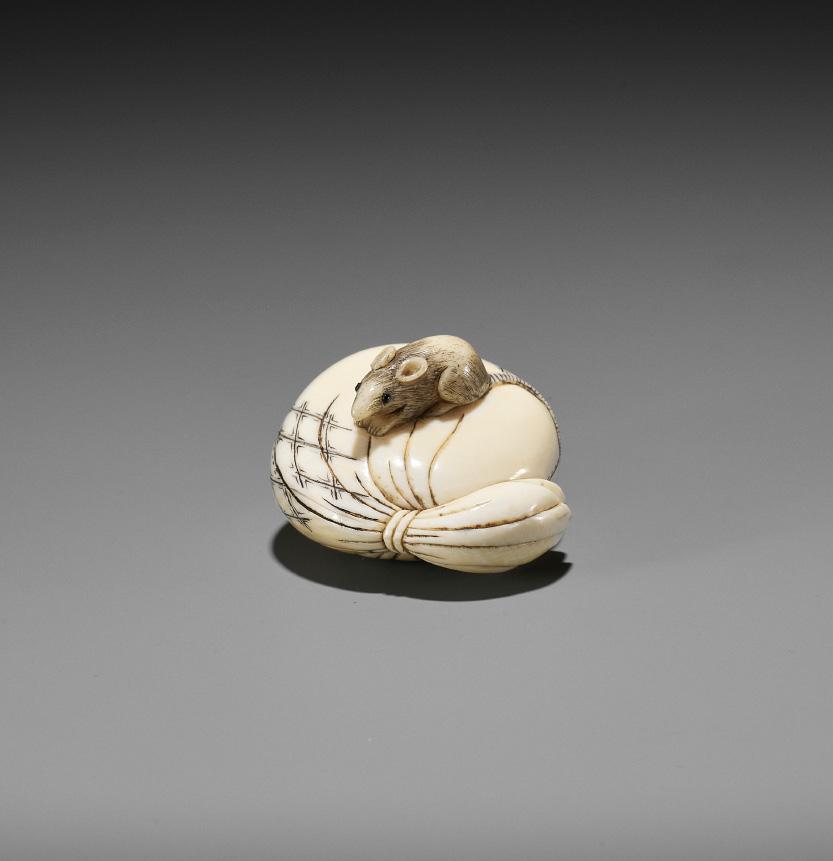
Unsigned Japan, c. 1800, Edo period (1615-1868)
Finely carved as a rat clambering on top of large awabi (abalone) shell, its large eyes inlaid in dark horn and the fur neatly engraved, the fleshy underside neatly stippled and housing the two generously excavated himotoshi.
LENGTH 5.1 cm
Condition: Good condition, appealingly worn, fine age cracks. Possibly an old smoothed-out chip to one ear. Beautiful yellowish patina.
Estimate EUR 1,500
Starting price EUR 800
333
TOMOKAZU: A FINE WOOD NETSUKE OF A RAT


 By Tomokazu, signed Tomokazu 友一 Japan, Gifu, early 19th century, Edo period (1615-1868)
By Tomokazu, signed Tomokazu 友一 Japan, Gifu, early 19th century, Edo period (1615-1868)
Finely carved as a rat (nezumi) tightly gripping its tail which curls around underneath its body, forming a compact composition, the fur finely incised and the wood bearing a fine patina. The eyes are inlaid in dark lustrous horn and the two visible incisors underneath are inlaid in bone. The underside with the signature within the typical oval reserve TOMOKAZU. Natural himotoshi through the tail.
LENGTH 4.3 cm
Condition: Few tiny chips, a section of the tail repaired. Otherwise, good condition with minor wear.
Provenance: From a noted private collection in California, USA. Purchased at Bonhams, Fine Japanese Works of Art including selections from the collection of Ruth and Carl Barron, 16 September 2014, New York, lot 2067.
AUCTION COMPARISON
Compare to a closely related wood netsuke signed Tomokazu, at Lempertz, Asian Art, 11 December 2021, Cologne, lot 362 (sold for 4,250 EUR).
Estimate EUR 3,000
Starting price EUR 1,500
334 331
SHIGEHIRO: A CHARMING WOOD NETSUKE OF A DOG AND TWO PUPS
By Shigehiro, signed Shigehiro 重寛 Japan, 19th century, Edo period (1615-1868)
A sweet and finely carved wood netsuke of a female dog with her two young, playfully biting one of the pups, their spotted fur coats neatly incised and finely stained, the underside with numerous well-detailed paws, the himotoshi formed by the space between the back and front paws, the mother’s belly carved with the signature SHIGEHIRO.



LENGTH 3.7 cm
Condition: Excellent condition with minor wear. Provenance: A noted private collection, USA.
LITERATURE COMPARISON
Compare to a similar wood netsuke by Yoshihisa is illustrated in Lazarnick, George (1981) Netsuke & Inro Artists, and How to Read Their Signatures, vol. 2, p. 1231.
Estimate EUR 3,000
Starting price EUR 1,500
335 332
333 TEIMIN: A RARE MARINE IVORY NETSUKE OF A MONKEY WITH SARU MASK
By Teimin (Sadatami), signed Teimin 貞民 Japan, 19th century
An amusingly crafted and finely carved from beautifully lustrous marine ivory, likely whale tooth, as a monkey contemplatively looking at a saru mask which it holds in its lap. Large himotoshi underneath and signed between the two cord holes within an ingot-shaped reserve TEIMIN.
HEIGHT 3.4 cm
Condition: Very good condition, the material with few typical age cracks and natural imperfections, the hairwork slightly worn.
Estimate EUR 1,500
Starting price EUR 800 334
AN IVORY NETSUKE OF A MONKEY, CRAB AND LOTUS

Unsigned Japan, Tokyo, late 19th century
The two arch enemies locked into combat, the monkey pulling on the legs of the crab, which hides underneath a furled lotus leaf, while one of the crab’s pincers pierces through the leaf, pinching the monkey into its extended hindleg while the simian yelps out in pain. The details are finely carved and the ivory is attractively stained. The cord channel runs through underneath the crab’s legs into a generously excavated singular himotoshi.
LENGTH 4.4 cm
Condition: Excellent condition, minor wear.
Provenance: From the collection of Gaston Lazard (1878-1956) and his wife Jane Levy (1886-1985) and thence by descent within the same family.
The present netsuke is a reference to the story of ‘The Crab and the Monkey’, in which a sly monkey kills a crab, and is later killed in revenge by the crab’s offspring.


Estimate EUR 2,000
Starting price EUR 1,000
336
335
KAZUMASA: A WOOD NETSUKE OF A MONKEY PICKING FLEAS
By Kazumasa (Issei), signed Kazumasa 一政 Japan, 19th century, Edo period (1615-1868)
Finely carved as a large monkey with finely incised hairwork and horn-inlaid eyes, one hand scratching his back and the other in the front having picked off a flea. Natural himotoshi and signed within a polished reserve to the behind KAZUMASA (Issei).
HEIGHT 4.3 cm
Condition: Repairs to the feet and one hand. Otherwise good condition with minor wear. Provenance: A noted private collection, USA.
Estimate EUR 1,500
Starting price EUR 800
336
A WOOD NETSUKE OF A MONKEY EATING A PEACH, ATTRIBUTED TO MIWA


Attributed to Miwa, unsigned Japan, Edo (Tokyo), late 18th century, Edo period (1615-1868)
An old and beautifully worn wood netsuke finely carved as a seated monkey with an amusing expression, holding a large peach between its legs and nibbling at a piece of the fruit while scratching his behind. The eyes are inlaid in bone. Large himotoshi underneath. Beautiful dark patina.
HEIGHT 3.6 cm
Condition: Very good condition with minor wear and typical traces of use. One eye is probably replaced.
LITERATURE COMPARISON
Compare to a closely related wood netsuke of a monkey, by Miwa, illustrated in Davey, Neil K. (1974) Netsuke: A comprehensive study based on the M.T. Hindson Collection, no. 260.

Estimate EUR 1,500
Starting price EUR 800
337
337 SARI: A FINE WOOD NETSUKE OF A SNAIL EMERGING FROM ITS SHELL
 By Sari, signed Sari 左里 Japan, Iwashiro, c. 1800, Edo period (1615-1868)
By Sari, signed Sari 左里 Japan, Iwashiro, c. 1800, Edo period (1615-1868)
Beautifully and naturalistically carved as a decidedly fat snail (katatsumuri) emerging from its shell with its feelers and labial tentacles folded back and resting on the shell for compactness. The ridged and spiraling shell is carved with incredible detail and the rough texture of the body is achieved through a multitude of finely etched strokes. The foot is visible on the underside, forming a curling lump with natural himotoshi going through under it. The edge of the shell signed SARI.
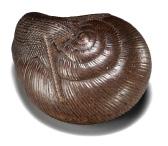

LENGTH 4.2 cm
Condition: Some wear, small nicks, light surface scratches, one fine hairline, one crack.
Provenance: From the collection of Felix Tikotin, and thence by descent within the family. Felix Tikotin (1893-1986) was an architect, art collector, and founder of the first Museum of Japanese Art in the Middle East. Born in Glogau, Germany, to a Jewish family, his ancestors had returned with Napoleon from Russia from a town named Tykocin. He grew up in Dresden and after World War I, he traveled to Japan and immediately fell in love with the culture. In April 1927, he opened his own first gallery in Berlin. The entire family survived the holocaust, and in the 1950s Tikotin slowly resumed his activities as a dealer in Japanese art. He became, once again, very successful and prominent, holding exhibitions all over Europe and the United States. When he first visited Israel in 1956, he decided that the major part of his collection belonged in that country. In 1960, the Tikotin Museum of Japanese Art was opened in Haifa.

AUCTION COMPARISON
Compare a closely related wood netsuke of a snail by Sari at Galerie Zacke, Fine Netsuke & Sagemono, 29 October 2021, Vienna, lot 123 (sold for 7,584 EUR).
Estimate EUR 2,000
Starting price EUR 1,000
338
Felix Tikotin (1893-1986), center, in front of his gallery in Berlin
338
YUZAN: AN UNUSUAL WOOD NETSUKE OF A SNAIL EMERGING FROM ITS SHELL
 By Yuzan, signed Yuzan 友山 Japan, 19th century
By Yuzan, signed Yuzan 友山 Japan, 19th century
Well carved to depict a snail in a rather unusual position with its body extended outward from its shell and head turned to one side, the eyes inlaid with horn, the spiraling shell neatly incised. The underside with two himotoshi, one to the snail’s body and the other to the shell, the snail’s body incised with the signature YUZAN.
LENGTH 5 cm
Condition: Good condition with minor wear, few small nicks, tiny loss to the tip of one tentacle.
Provenance: Ex-collection Teddy Hahn, Darmstadt. Theodor “Teddy” Hahn was a well-known and respected collector of netsuke and other Asian works of art. After spending time in museums to study the early cultures of the world, finding particular interest in their sculptures, he began collecting, remarking, “I somehow knew it would have a profound influence on my life. How right I was. And how happy I have been.”
Estimate EUR 1,500
Starting price EUR 800
339
YASUTADA: A WOOD NETSUKE OF A SNAIL EMERGING FROM ITS SHELL
 By Yasutada, signed Yasutada 安忠 Japan, Kyoto, late 18th to early 19th century, Edo period (1615-1868)
By Yasutada, signed Yasutada 安忠 Japan, Kyoto, late 18th to early 19th century, Edo period (1615-1868)
Well carved as a snail easing its way out of its shell, its optic feelers fully extended and touching the shell, the skin neatly incised with a scale pattern, the shell with dense, gently curved lines, the varying incision work creating an appealing contrast in textures, which have somewhat smoothened over time due to extensive handling, the recesses finely stained. The underside with a ‘natural’ himotoshi between the snail’s shell and body, which nonetheless has been rounded by the carver, the shell incised with the signature within a rectangular reserve YASUTADA – the artist is very rare with only few examples recorded. It is supposed he was a pupil of Tomotada of Kyoto.
LENGTH 3.5 cm
Condition: Good condition, appealingly worn, few light scratches, one small chip.
Provenance: Ex-collection Teddy Hahn, Darmstadt. Theodor “Teddy” Hahn was a well-known and respected collector of netsuke and other Asian works of art. After spending time in museums to study the early cultures of the world, finding particular interest in their sculptures, he began collecting, remarking, “I somehow knew it would have a profound influence on my life. How right I was. And how happy I have been.”
Auction comparison: Compare a wood netsuke of a rat by the same artist at Lempertz, 11 June 2022, lot 403 (sold for 2,268 EUR).
Estimate EUR 1,500
Starting price EUR 800

339
Teddy Hahn (1933-2012)
340 YOSHIKAZU: A FINE WOOD NETSUKE OF A TORTOISE

By Yoshikazu (Ryoichi), signed Yoshikazu 良一 Japan, Gifu, first half of 19th century, Edo period (1615-1868)
A simple, wonderfully carved, and tactile wood netsuke depicting a tortoise almost completely retracted within its carapace. The outer shell is decorated with neatly arranged hexagonal patterns, the surface appealingly worn, and the underside shows the retracted limbs and head, covered in minutely etched scales. The cord attachment is in the form of an eyelet inset into the removable scale within the carapace. Signed within an oval reserve YOSHIKAZU – School of Kano Tomokazu of Gifu. The wood is beautifully worn with an unctuous patina.

LENGTH 5.8 cm
Condition: Good, worn condition with some traces of use including a chip to the removable section of the carapace and few scratches to the underside.
Provenance: A noted private collection, USA.
MUSEUM COMPARISON
Compare to a wood netsuke of a group of tortoises by the same artist in the collection of the Los Angeles County Museum of Art (LACMA), formerly in the collection of Raymond and Frances Bushell, accession no. AC1998.249.40.



LITERATURE COMPARISON
Compare to a wood netsuke of a tortoise, by Kano Tomokazu, illustrated in Davey, Neil K. (1974) Netsuke: A comprehensive study based on the M.T. Hindson Collection, p. 232, no. 715.
Estimate EUR 2,000
Starting price EUR 1,000
341
AN OLD WOOD NETSUKE OF A TORTOISE
Unsigned Japan, 18th century, Edo period (1615-1868)
A boldly carved netsuke of considerable heft and bulkiness, yet smooth and rounded, making it very appealing to hold in the hand. Depicting a tortoise which has almost entirely retreated into its shell, with only the tip of the head being visible from above, the underside showing the limbs and curved tail as well as the large eyes inlaid with dark horn, the skin expressed with dense incision work, the carapace and plastron finely incised, the underside with large asymmetrical himotoshi. The wood with a fine, smooth patina from gentle handling over centuries.
LENGTH 5.5 cm
Condition: Good condition, appealingly worn, light surface scratches, the carapace with small pin holes, one partly with an old wood fill.
Estimate EUR 1,500
Starting price EUR 800
340
342
SEIGYOKU: A WOOD NETSUKE OF THREE TURTLES IN A PYRAMID
By Seigyoku, signed Seigyoku 清玉 Japan, Edo (Tokyo), mid-19th century, Edo period (1615-1868)
Finely and amusingly carved as a mother turtle, who has almost completely retreated into her shell, surmounted by her two young clambering over each other as they try to get the most sunlight. The carapaces are neatly incised and the warty skin is carved in ukibori. The underside with two himotoshi and the signature SEIGYOKU.
LENGTH 3.8 cm
Condition: Good condition, appealingly worn, two age cracks. Provenance: From the collection of Gaston Lazard (1878-1956) and his wife Jane Levy (1886-1985) and thence by descent within the same family.
Literature comparison: Compare a closely related wood netsuke by Gyokumin, illustrated in Meinertzhagen, Frederick / Lazarnick, George (1986) MCI, Part A, p. 97.
AUCTION COMPARISON
Compare a related wood netsuke of three turtles in a pyramid by Kogyoku at Galerie Zacke, Fine Netsuke & Sagemono, 29 October 2021, Vienna, lot 197 (sold for 1,250 EUR).

Estimate EUR 1,200
Starting price EUR 600
343
SHOKIN: A WOOD NETSUKE OF THREE TURTLES IN A PYRAMID


 By Shokin, signed Shokin 松琴 Japan, 19th century
By Shokin, signed Shokin 松琴 Japan, 19th century
Of compact form and finely carved as a mother turtle with two young clambering on top of her shell and each other, the carapaces neatly incised, the eyes inlaid with dark horn. The mother has almost entirely retreated into her shell as her young attempt to climb over each other to get to the top where the sun is the strongest and to enjoy a healthy sunbathing. The turtles’ limbs are stained dark while their heads and carapaces are of a reddish brown, creating a striking contrast that is complemented by the different textures. Several natural himotoshi due to the openwork. The underside signed in an oblong reserve SHOKIN.
LENGTH 4 cm
Condition: Very good condition with minor wear, the underside with remnants of wax or adhesive, one eye inlay lost.
Provenance: A noted private collection in California, USA.
AUCTION COMPARISON
Compare a related wood netsuke depicting a similarly carved turtle tied to a roof tile by Shokin, 3.6 cm wide, dated late 19th century, at Kunsthaus Klefisch, 30 November 1996, Cologne, lot 274. Compare a related wood netsuke depicting a cat and tortoise by Shokin, similarly signed within a reserve to the underside, 4.5 cm long, dated 19th century, at Galerie Zacke, Fine Netsuke, Sagemono & Okimono, 24 November 2018, lot 111 (sold for 2,654 EUR).
Estimate EUR 2,000
Starting price EUR 1,000
341
344 SUKENAGA: A RARE ITTOBORI YEW WOOD NETSUKE OF A CROUCHING FROG


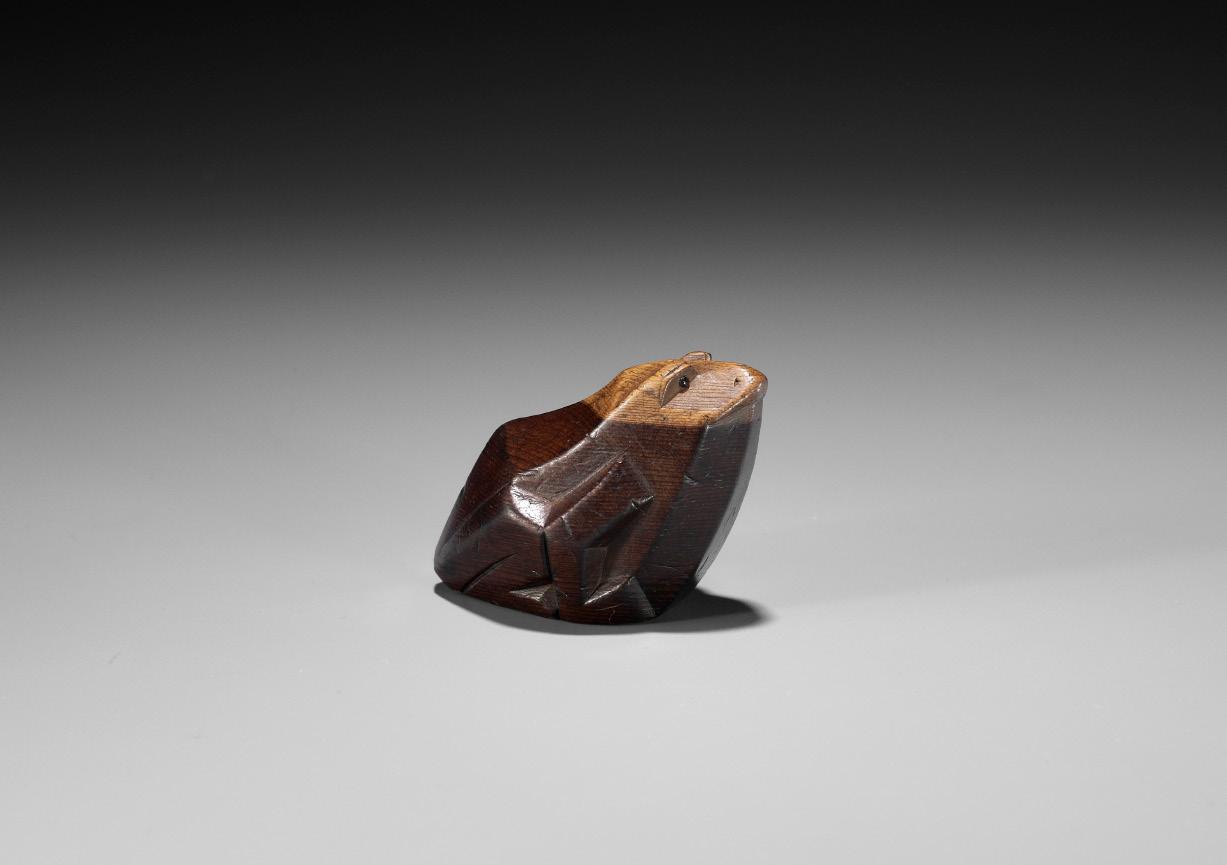 By Matsuda Sukenaga, signed Sukenaga 亮長 Japan, Takayama, Hida Province, mid-19th century, Edo period (1615-1868)
By Matsuda Sukenaga, signed Sukenaga 亮長 Japan, Takayama, Hida Province, mid-19th century, Edo period (1615-1868)
The crouching amphibian carved from ichii (yew) wood and worked in the ittobori (single cut) technique, the surface beautifully worn, the two-toned wood cleverly utilized, the eyes inlaid in dark horn resulting in a very amusing expression. Asymmetrical himotoshi underneath and signed SUKENAGA.
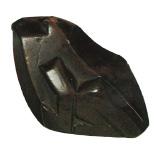
LENGTH 4 cm
Condition: Very good condition with typical wear and traces of use including some tiny nicks and surface scratches.
Takayama ittobori netsuke are still being produced to this very day, however, it is quite rare to find early pieces such as the present netsuke.
The composition is reminiscent of the early 20th century cubism art movement pioneered by Pablo Picasso and Georges Braque, who were heavily influenced by Japanese art.
LITERATURE COMPARISON
Ittobori netsuke by the celebrated artist Matsuda Sukenaga are rare. A closely related model of a frog, also by Sukenaga, is illustrated in Bushell, Raymond Netsuke (1975) Familiar & Unfamiliar, p. 129, no. 212. For another example depicting a Hannya mask, showing similar wear, see Bandini, Rosemary (2019), The Larry Caplan Collection of Japanese Netsuke, no. 49.
AUCTION COMPARISON
Compare to a later ittobori netsuke of a monkey, by Sukenori, at Zacke, Fine Netsuke & Sagemono, 16 April 2021, Vienna, lot 139 (sold for 1,342 EUR).
Estimate EUR 2,000
Starting price EUR 1,000
342
345
AN EARLY WOOD NETSUKE OF A CAT DEVOURING A FISH

Unsigned Japan, 18th century, Edo period (1615-1868)
A beautifully rounded and charming wood netsuke of a cat (neko) with curling tail, holding a fish between its forepaws, the head lowered, and taking a bite. The feline’s expression radiating with satisfaction as a result. The surface is beautifully worn and smooth to the touch – a true tactile pleasure in the hand! The underside with very large and generously excavated himotoshi.
LENGTH 4.2 cm
Condition: Good, worn condition. Some old chips. Beautiful patina.
Provenance: From the collection of the German conductor Ferdinand Leitner (1912–1996). Leitner studied under Franz Schreker, Julius Prüwer, Artur Schnabel and Karl Muck. Among his more than 300 recordings is a celebrated recording of Ferruccio Busoni’s Doktor Faust. He also conducted the Berlin Philharmonic for Wilhelm Kempff’s 1961 cycle of Beethoven’s piano concertos.
Estimate EUR 1,200
Starting price EUR 600
The German conductor Ferdinand Leitner (19121996) rehearsing with the Bamberg Symphony orchestra

346
A WOOD NETSUKE OF A RECUMBENT HORSE

Unsigned Japan, late 18th to early 19th century, Edo period (1615-1868)
Well carved with the legs drawn in for compactness, the tail flung to one side and partly covering a hind leg, the head lowered and turned slightly to one side, the neatly incised mane elegantly falling in strands down either side of the spine, the animal further detailed with almond-shaped eyes, the underside carved with the legs and the asymmetrical himotoshi, the larger of which is generously excavated to accommodate the knot.
LENGTH 4.7 cm
Condition: Very good condition with minor wear and expected traces of use including some tiny nicks here and there.
Estimate EUR 1,200
Starting price EUR 600
343
347
A FINE WOOD NETSUKE OF A WOLF AND SKELETON, ATTRIBUTED TO SHOKO



Attributed to Shoko Sugonoya, unsigned Japan, Hida-Takayama, mid to late 19th century
The okimono-style netsuke finely carved as a wolf and skeleton embroiled in a vicious fight, the skeleton with one of its hands at the wolf’s neck, the other on its forehead, while the wolf desperately tries to fend the skeleton off. The skeleton with superbly carved and open-worked ribs, the skull neatly stippled and incised with simulated cracks. The wolf with finely incised fur, neatly articulated spine and ribs, and double-inlaid eyes in bone and dark horn. Natural himotoshi.


HEIGHT 4 cm, LENGTH 4.8 cm
Condition: Very good condition, minor wear, minuscule nibbling to edges.
The subject is an allusion to the tragic story of unrequited love between the military leader Fukakusa Shosho and the celebrated poetess Ono no Komachi. The former died trying to convince the latter of his love for her while the poetess was left to endure a solitary old age. Her pride is personified by the skeleton whilst the passion of Fukakusa is represented by the wolf.
LITERATURE COMPARISON
Compare a closely related netsuke by Shoko in the collection of the Los Angeles County Museum, accession number AC1998.249.281; and another is illustrated in Meinertzhagen, Frederick / Lazarnick, George (1986) MCI, Part B, p. 748.
AUCTION COMPARISON
Compare to a closely related wood netsuke by Shoko sold at Zacke, Fine Netsuke & Sagemono, 29 October 2021, Vienna, lot 129 (sold for 8,848 EUR).
Estimate EUR 4,000
Starting price EUR 2,000
344
348
A very finely carved study of a kappa with one hind foot caught in the jaws of a hamaguri clam as it climbs over it. The warty skin of the kappa is masterfully rendered, the eyes are inlaid, the shell is finely carved and the long hairs surrounding the kappa’s swirling vital fluids on the head are minutely incised. The surface of the clam is highly polished and attractively stained. Large, asymmetrical himotoshi ringed in stained bone through the underside and signed SUKETADA.




Condition: Very good condition, minor wear, few minuscule nicks. Provenance: French private collection, purchased from Galerie Yamato, Paris, in 2003.
AUCTION COMPARISON
Compare to a very similar netsuke by Suketada sold at Bonhams, Fine Japanese Art, 16 May 2013, London, lot 34 (sold for 5,250 GBP). Also compare to another very similar netsuke by Suketada more recently sold at Koller Auktionen, Asiatica: Japan, Indien, Südostasien, 4 June 2019, Zurich, lot 410 (sold for 6,000 CHF).
Estimate EUR 3,000
Starting price EUR 1,500
345
SUKETADA: A FINE WOOD NETSUKE OF A KAPPA ON HAMAGURI CLAM
By Eguro Suketada, signed Suketada 亮忠 Japan, Takayama, Hida province, mid-19th century, Edo period (1615-1868)
LENGTH 3.8 cm
349
TOYOYO: A WOOD NETSUKE OF A HATCHING TENGU (TENGU NO TOMAGO)

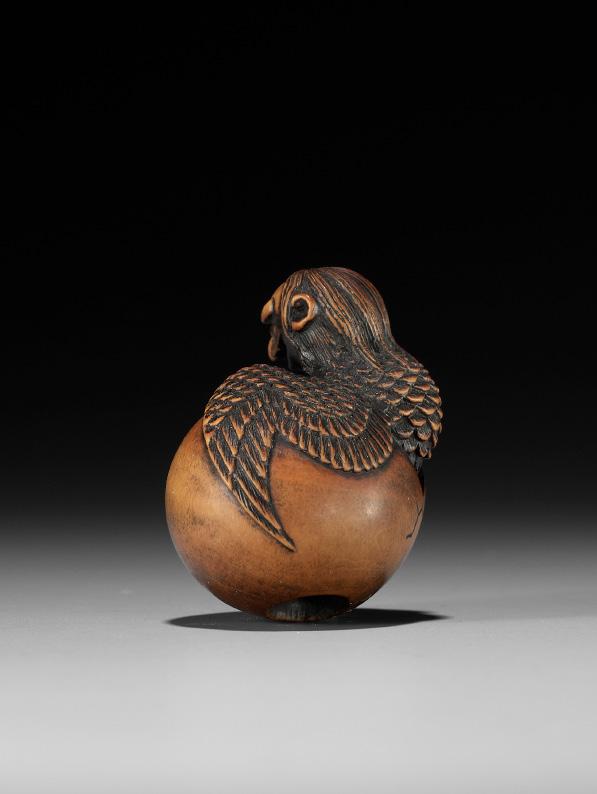 By Toyoyo (Toyoyasu, 1811-1883), signed Toyoyo 豊容 Japan, Sasayama, Tanba Province, 19th century, Edo period (1615-1868)
By Toyoyo (Toyoyasu, 1811-1883), signed Toyoyo 豊容 Japan, Sasayama, Tanba Province, 19th century, Edo period (1615-1868)
Published: Sydney L. Moss Ltd. (2006) More Things in Heaven and Earth, pp. 112-113, no. 49.
Masterfully carved as a hatching karasu (crow-beaked) tengu climbing out of its egg with its two hands holding on to the edge of the shell, triumphantly screeching, one large wing trailing over the cracked shell to its left. The eyes are inlaid in pale translucent horn with black drilled pupils. Note the extremely fine carving of the plumage, accentuated with black coloring, typical for the Tanba school artists. The slightly worn wood with a very good patina. The egg is smoothly polished and the large asymmetrical himotoshi are found underneath, the larger one generously excavated to accommodate the knot. It is also worth noting that this netsuke stands on the smaller himotoshi. Signed TOYOYO with boldly incised characters.
LENGTH 4 cm
Condition: Very good condition with minor wear, few tiny nicks around the himotoshi, and one fine short age crack.
Provenance: Italian private collection. Sydney L. Moss, London, 2005. French private collection, acquired from the above.
Toyoyo (1811-1883), also known as Toyoyasu or Hidari Toyomasa, was the son and best pupil of Naito Toyomasa (1773-1856). There is ample evidence that many netsuke signed Toyomasa were in fact made by Toyoyo, who was left-handed. Toyoyo seldomly signed with his own name.
Estimate EUR 10,000
Starting price EUR 5,000
346


Finely carved as an ox lying in a recumbent pose with the legs drawn in and tail flung to one side, the head turned to the same side, looking ahead with eyes inlaid in mother-of-pearl, the rope halter slung around the neck, the fur neatly incised and stained in variegated shades of brown to indicate piebald markings, the spine well carved, the underside with asymmetrical himotoshi and the signature HAKURYU.


LENGTH 4 cm
Condition: Good condition with minor wear, few fine age cracks, tiny chip to the tip of one horn.
Provenance: From the collection of Gaston Lazard (1878-1956) and his wife Jane Levy (1886-1985) and thence by descent within the same family.
The present netsuke is a rare example from this artist, who is better known for his carvings of tigers.


LITERATURE COMPARISON
Compare a related ivory netsuke of a calf and cow by Hakuryu II, similarly carved and stained with piebald markings, illustrated in Lazarnick, George (1981) Netsuke & Inro Artists, and How to Read Their Signatures, vol. 1, p. 438, and another in Meinertzhagen, Frederick / Lazarnick, George (1986) MCI, Part A, p. 121.
Estimate EUR 5,000
Starting price EUR 2,400
349
350 HAKURYU: A RARE IVORY NETSUKE OF A RECUMBENT OX
By Unsho Hakuryu II, signed Hakuryu 白龍 Japan, Kyoto, 19th century, Edo period (1615-1868)
A KYOTO SCHOOL WOOD NETSUKE OF A MONKEY WITH ACORNS


Unsigned Japan, Kyoto, early 19th century, Edo period (1615-1868)
Expressively carved as a monkey firmly gripping a branch issuing three acorns, one of them having already fallen off, the monkey’s body nestled into a group of leaves, its fur neatly incised and expression quite amusing with inlaid pupils at the bottom of the eyes. Natural himotoshi. The style of the carving is reminiscent of Mitsuhide of Kyoto.
LENGTH 4.2 cm
Condition: Good condition. Some wear and typical traces of use. A crack through the branch. Remnants of wax from an old label.
Provenance: From the collection of Gaston Lazard (1878-1956) and his wife Jane Levy (1886-1985) and thence by descent within the same family.
Estimate EUR 1,200
Starting price EUR 600
352 A WOOD NETSUKE OF A RAT ON A HUGE CHESTNUT
Unsigned Japan, Kyoto, early 19th century, Edo period (1615-1868)
Finely carved as a rat resting on a giant chestnut, the animal well detailed with neatly incised fur, tail, and paws as well as upright ears and horn-inlaid eyes, the chestnut is naturalistically carved with subtle grooves and skillful stippling to simulate the texture of the nut, the underside with two himotoshi.
WIDTH 3.4 cm
Condition: Very good condition with minor wear.
Provenance: From the collection of Gaston Lazard (1878-1956) and his wife Jane Levy (1886-1985) and thence by descent within the same family.
Estimate EUR 1,500
Starting price EUR 800
350
351
A LARGE KYOTO SCHOOL IVORY NETSUKE OF A RABBIT
Unsigned Japan, Kyoto, 18th century, Edo period (1615-1868)
The hare (usagi) seated with its back arched and head lowered, the long ears laid back, forming a compact composition, the eyes inlaid in reddish horn. The ivory bearing a superb, honey-yellow patina. Natural himotoshi. Unsigned, however certainly Kyoto school and stylistically close to Yoshinaga and his followers.
LENGTH 5.1 cm
Condition: The right fore paw restored. A tiny chip to one ear. Overall good condition with several natural age cracks and a superb patina.
AUCTION COMPARISON
Compare a related ivory netsuke of a hare, by Yoshinaga, at Bonhams, The Julius & Arlette Katchen Collection of Fine Netsuke Part I, 8 November 2016, London, lot 72 (sold for 8,125 GBP).

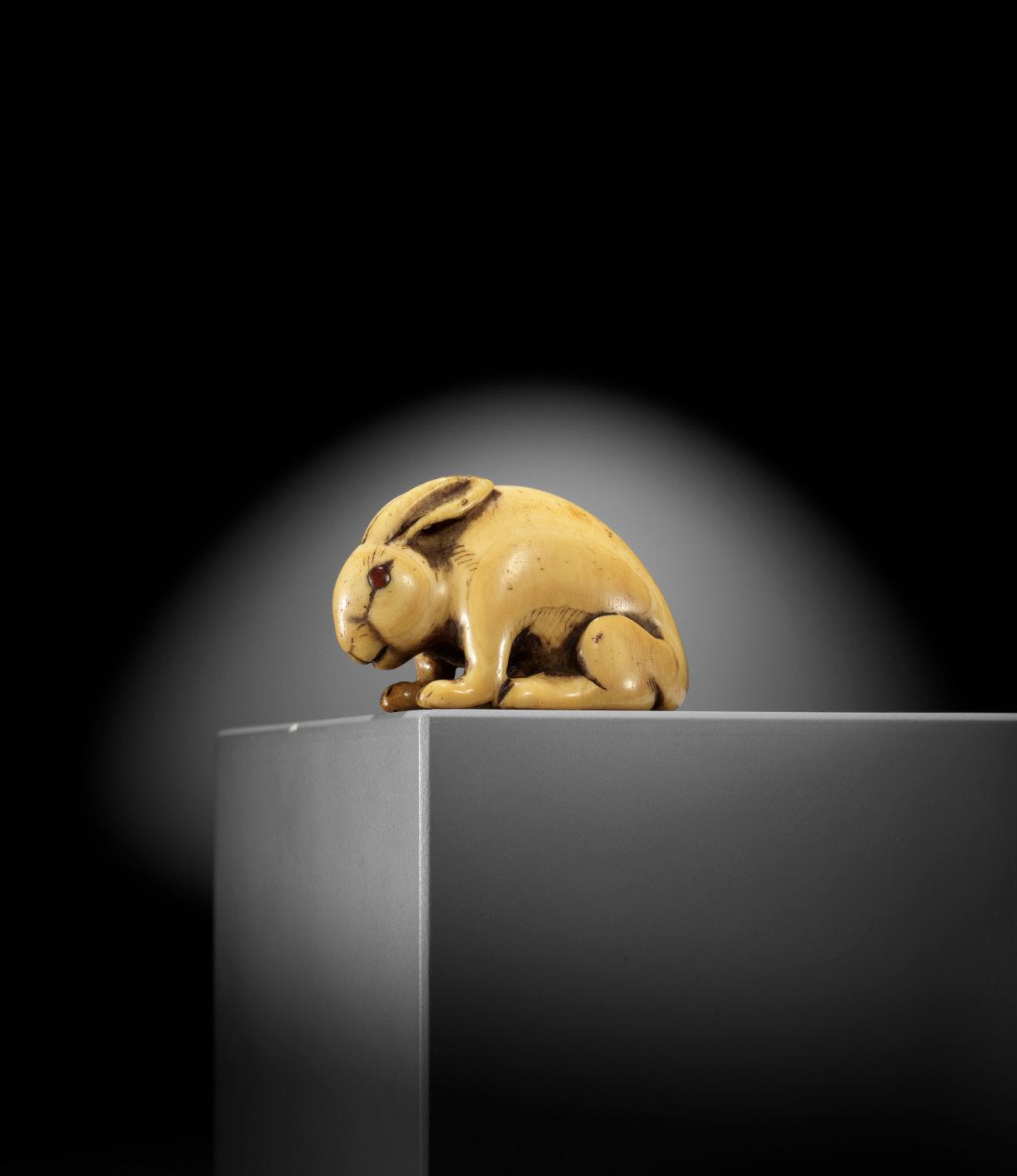
Estimate EUR 2,000
Starting price EUR 1,000
351
353
Unsigned Japan, Kyoto or Osaka, 18th century, Edo period (1615-1868)
Amusingly carved as two shishi, an adult and its young, with neatly incised and inked manes, fondling a large and smooth ball, the entire composition set on a shaped base. Large himotoshi underneath.
LENGTH 4.6 cm
Condition: Very good condition, the ivory slightly worn. Provenance: From the collection of Gaston Lazard (1878-1956) and his wife Jane Levy (1886-1985) and thence by descent within the same family.
Estimate EUR 1,000
Starting price EUR 500
354 A POWERFUL IVORY NETSUKE OF A SNARLING SHISHI WITH BALL, ATTRIBUTED TO MITSUHARU



Attributed to Mitsuharu, unsigned Japan, Kyoto, late 18th to early 19th century, Edo period (1615-1868)
Boldly carved seated, its head turned back in a typical attitude as it protects a large, smooth ball with all paws, the bulging circled eyes with dark-inlaid pupils, the curled mane and fur neatly incised, the mouth slightly agape revealing tongue, teeth, and a movable ball, the back and underside with large and generously excavated himotoshi.
HEIGHT 4.7 cm
Condition: Very good condition, the ivory slightly worn.,
Provenance: From the collection of Gaston Lazard (1878-1956) and his wife Jane Levy (1886-1985) and thence by descent within the same family.
Literature comparison: Compare a related ivory netsuke of a shishi with ball by Mitsuharu, illustrated in Meinertzhagen, Frederick / Lazarnick, George (1986) MCI, Part A, p. 532.
AUCTION COMPARISON
Compare a closely related ivory netsuke, by Mitsuharu, at Bonhams, The Harriet Szechenyi Sale of Japanese Art, 8 November 2011, London, lot 17 (sold for 11,250 GBP).
Estimate EUR 2,500
Starting price EUR 1,200
352
355 AN IVORY NETSUKE OF TWO SHISHI WITH LARGE BALL
357
AN IVORY NETSUKE OF A FOX PRIEST (HAKUZOSU) WITH BAMBOO CANE
Unsigned Japan, c. 1800, Edo period (1615-1868)
The kitsune (fox) wearing a voluminous robe with neatly engraved and inked design, a cowl draped over the creature’s head, the face with a sly expression, and holding a large bamboo cane over its head. The ivory bearing a fine patina. Two himotoshi through the back.
HEIGHT 6 cm
Condition: Very good condition with minor wear and few natural age cracks.
Provenance: Belgian collection, purchased from Bonhams, Fine Japanese Art, 17 May 2018, lot 21 (part lot, sold for 3,500 GBP).
Hakuzosu is the name of a popular kitsune character who shapeshifted into a priest in the Kyogen play Tsurigitsune (lit. ‘fox catching’). Kitsune (foxes) are creatures imbued with magical powers and are known to have the ability of shapeshifting. They are also believed to be animated by the devils.
Estimate EUR 2,000
Starting price EUR 1,000
356
RANTEI: A FINE IVORY NETSUKE OF A FOX WITH TEMPLE BELL


 By Hogen Rantei, signed Rantei 蘭亭 Japan, Kyoto, early 19th century, Edo period (1615-1868)
By Hogen Rantei, signed Rantei 蘭亭 Japan, Kyoto, early 19th century, Edo period (1615-1868)
Finely carved in openwork as a slender fox, probably an Inari fox, with neatly incised fur and long bushy tail clambering over a small mokugyo (Buddhist temple bell), which on the back is incised with the signature RANTEI within an oblong reserve. The back with a fine honey-yellow patina. The cord attachment runs through the looped handle of the bell.
HEIGHT 3.4 cm
Condition: Very good condition with minor wear and rubbing to the sumi-stained hairwork.
Provenance: From the collection of Gaston Lazard (1878-1956) and his wife Jane Levy (1886-1985) and thence by descent within the same family.
MUSEUM COMPARISON
Compare a closely related ivory netsuke of a fox with mokugyo by Rantei in the British Museum, accession number F.806, illustrated in Barker, Richard / Smith, Lawrence (1976), Netsuke: The Miniature Sculpture of Japan, no. 75.
Estimate EUR 2,000
Starting price EUR 1,000
353
358
AN AMUSING IVORY NETSUKE OF GAMA SENNIN ATTRIBUTED TO MASAKAZU
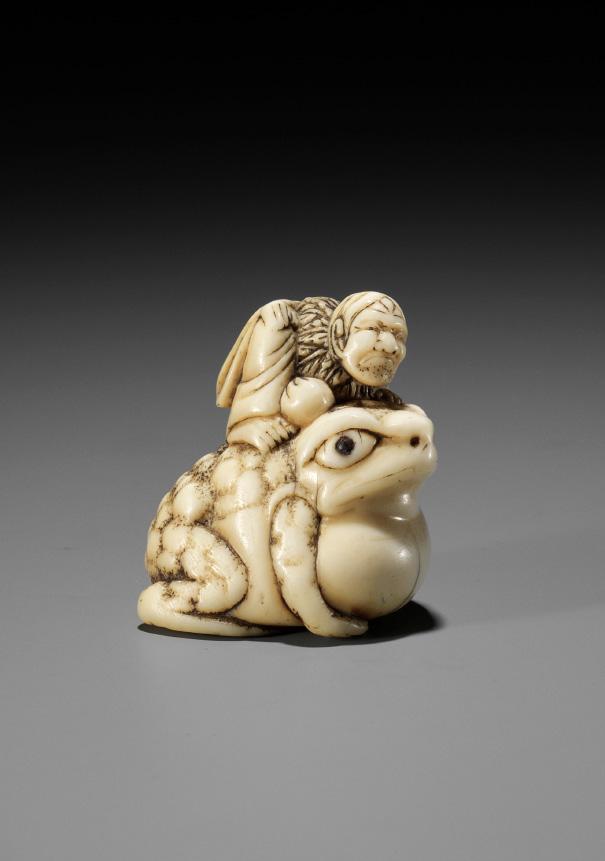
Attributed to Masakazu, unsigned Japan, Osaka, early to mid-19th century, Edo period (1615-1868)
Gama Sennin is shown straining under the weight of the huge toad on his back, which is arched as he tries to hold its weight, holding on to a limb with each of his hands. Finely carved details with long flowing sleeves and a very amusing facial expression of the Sennin. The toad with an expressively carved warty skin and large inlaid eyes of reddish horn. Natural himotoshi through an opening between one leg of the toad and the Sennin’s arm.
HEIGHT 5.8 cm
Condition: Very good condition, with very minor age cracks and a good patina.
LITERATURE COMPARISON
Compare with a signed Masakazu, in which Gama lies on top of a huge toad, in Barker and Smith, Netsuke, the Miniature Sculpture of Japan, British Museum, p. 27, no. 5.

Estimate EUR 1,500
Starting price EUR 800
359
AN
OSAKA SCHOOL IVORY NETSUKE OF GAMA SENNIN ON A HUGE TOAD

Unsigned Japan, Osaka, c. 1800, Edo period (1615-1868)
The hermit Gama seated on a large, bloated toad, its warty skin beautifully rendered with clever stippling, the toad’s eyes inlaid in ebony. Gama’s expression is amusingly grim, as the toad usually sits on his shoulder, now their positions are reversed. Good, deep himotoshi to the underside. The ivory bearing a fine yellowish patina. Unsigned, however likely by either Masakazu or Masatomo.
HEIGHT 4.3 cm
Condition: Very good condition, some typical wear to the sumistained details, few natural age cracks.
Provenance: Collection Prof. Dr. Henk C. Hoogsteden, Rotterdam.
Museum comparison: Compare to a closely related ivory netsuke, by Masakazu, in the collection of The British Museum, accession no. F.890.
AUCTION COMPARISON
Compare to a closely related ivory netsuke, by Masatomo, sold at Van Ham, Asian Art, 8 December 2016, Cologne, lot 2303 (sold for 3,612 EUR).

Estimate EUR 1,500
Starting price EUR 800
354
360
MASAMORI: AN IVORY NETSUKE OF GAMA SENNIN

By Masamori, signed Masamori 正守 Japan, Kyoto, late 18th to early 19th century, Edo period (1615-1868)
Of large and triangular section (sankaku), the hermit seated and wearing a loosely fitted robe, his distended stomach showing, and holding a three-legged toad by one trailing hindleg as it clambers on top of his head. Gama’s expression is treated humorously, his face marked by a wide smile and squinting eyes inlaid with dark horn pupils. The toad’s huge eyes are inlaid in dark horn as well. Large himotoshi through the back and underside, the signature stained red within an oval reserve MASAMORI. The artist belongs to the Yoshinaga school of Kyoto.
HEIGHT 5.8 cm
Condition: Excellent condition with minor wear and typical age cracks.
AUCTION COMPARISON
Compare to a standing Gama sennin by the same artist at Zacke, Fine Netsuke & Sagemono, 29 October 2021, Vienna, lot 44 (sold for 2,275 EUR).

Estimate EUR 1,500
Starting price EUR 800
361
YOSHIMASA: AN IVORY NETSUKE OF FUKUSUKE

By Yoshimasa, signed Yoshimasa 吉正 Japan, Kyoto, late 18th to early 19th century, Edo period (1615-1868)
The lucky dwarf with the amusingly large face is depicted here standing in a dancing posture and holding a fan in his right hand. His kimono and surcoat are finely decorated in the typical manner of the Yoshischool. The pupils are inlaid in dark horn. Good patina and himotoshi to the reverse. Signed YOSHIMASA 吉正
HEIGHT 5.9 cm
Condition: Excellent condition with only minor wear and few age cracks.
Literature comparison: Compare with models by Yoshitomo in Nigel Platt’s article ‘Yoshitomo and Fukusuke’ in International Netsuke Society Journal, Vol. 31, no. 1, Spring 2011, p. 25.
AUCTION COMPARISON
Compare with a similar netsuke in the style of Yoshitomo sold by Bonhams, The Julius and Arlette Katchen Collection of Fine Netsuke Part I, 8 November 2016, London, lot 11 (sold for 2,125 GBP).

Estimate EUR 1,500
Starting price EUR 800
355
ANRAKU: A FINE IVORY NETSUKE OF SHOKI
 By Shukosai Anraku(sai), signed Anraku 安乐 Japan. Osaka,
By Shukosai Anraku(sai), signed Anraku 安乐 Japan. Osaka,
mid-19th
century, Edo period (1615-1868)
A spectacularly animated ivory netsuke of the demon queller Shoki striking a combative pose, his left arm wrapped around his right wrist, his free hand clenched into a comically large fist, and looking upwards in search of his oni nemesis. The ivory is lightly stained in an attractive yellowish color, and the details are neatly incised. Large, asymmetrical himotoshi to the back and signed on the hem of the robe ANRAKU.
HEIGHT 5.7 cm
Condition: Very good condition, few fine age cracks.
Estimate EUR 3,000
Starting price EUR 1,500
362
363 ANRAKU: AN IVORY NETSUKE OF DARUMA
 By Shukosai Anraku(sai),
By Shukosai Anraku(sai),
signed Anraku 安乐 Japan, Osaka, mid-19th century, Edo period (1615-1868)
Bodhidharma is shown seated almost completely enveloped in his robe, only his face is left uncovered with a humorously stern expression, as Daruma recovers from his nine-year wall gazing. The facial features are finely crafted with inlaid eyes of dark horn and minute incision work for the beard and brows. The ivory is attractively stained. Large, asymmetrical himotoshi underneath and signed ANRAKU.
HEIGHT 4 cm
Condition: Excellent condition. Provenance: Belgian collection, purchased from Lempertz, Cologne.
Estimate EUR 1,200
Starting price EUR 600
364 SHIGEMASA: AN AMUSING OSAKA SCHOOL SHUNGA IVORY NETSUKE OF OKAME WITH MUSHROOM
 By Shigemasa,
By Shigemasa,
signed Shigemasa 重正 Japan, Osaka, mid-19th century, Edo period (1615-1868)
The Shinto goddess kneeling next to a pine tree and laughing mirthfully as she admires a phallic mushroom on the ground below her. The details are finely carved and typically stained with sumi (ink). Natural himotoshi through the mushroom and signed underneath the shaped base within a wavy reserve SHIGEMASA – a pupil of Hidemasa.
LENGTH 3.6 cm
Condition: Excellent condition with minor wear and few natural age cracks.
Estimate EUR 1,200
Starting price EUR 600
357
MINICHI: A RARE NAGOYA SCHOOL WOOD NETSUKE OF A COILED RAT LICKING ITSELF

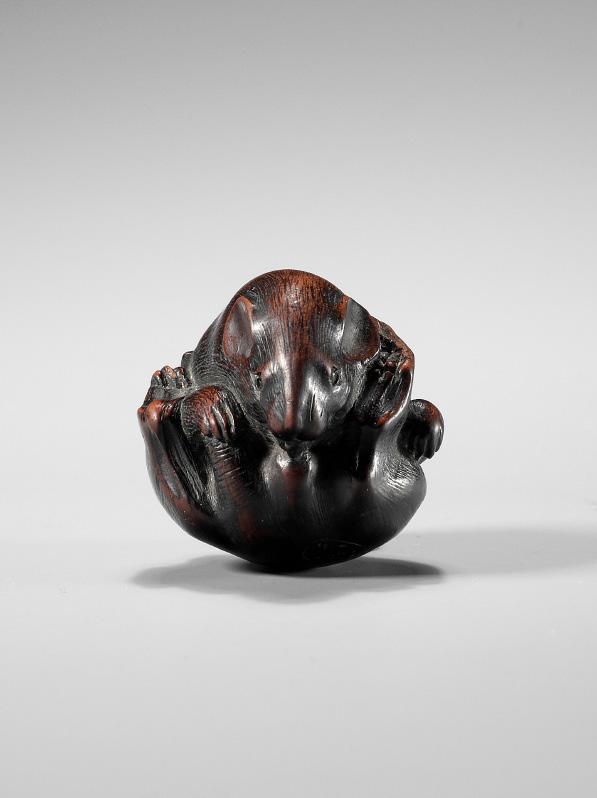
By
Minichi
(Tamikazu), signed Minichi 民一 Japan, Nagoya, 19th century, Edo period (1615-1868)
Well carved, of spherical form, the animal amusingly detailed with its tongue stretched out to lick itself, further with eyes inlaid in horn, large funnel-shaped ears, long paws, and neatly incised fur and tail, incised with the signature MINICHI within an oval reserve.
HEIGHT 3.5 cm
Condition: Very good condition with minor wear, few small nicks.
AUCTION COMPARISON
Compare a related wood netsuke of a tiger licking itself by Kokei, dated early 19th century, at Bonhams, The Edward Wrangham Collection of Japanese Art Part I, 9 November 2010, lot 111 (sold for 6,240 GBP).
Estimate EUR 3,000
Starting price EUR 1,500
366
ITTAN: A WOOD NETSUKE DEPICTING TANUKI NO HARA TSUZUMI

By Ittan, signed Ittan 一旦 with kakihan Japan, Nagoya, first half of 19th century, Edo period (1615-1868)
Well carved to depict the tanuki drumming on its huge belly, the mythical animal well detailed with neatly incised fur heightened by the skillful staining, further with a bushy tail, subtly carved spine, and large paws, the face with intelligent eyes and jovial expression. The lower back and underside with himotoshi, the flat base of the tanuki’s belly signed ITTAN with a kakihan.
HEIGHT 3.2 cm
Condition: Very good condition with minor wear, few tiny nicks, few light scratches.
Provenance: German private collection.
The tanuki possesses magical powers and can change forms, sometimes into Buddhist monks; they are jovial, but also dangerous, as they have been known to suffocate hunters with their enormous scrotums. The act of drumming on the belly, according to legend, was used by tanuki to beguile travelers and hunters to lead them astray. However, it has also been said that tanuki would get together just for fun, drumming on their bellies under the moonlight, perhaps even with some sake involved.
MUSEUM COMPARISON
Compare a related wood netsuke of a bellydrumming tanuki, 3.5 cm high, dated 19th century, in the Seattle Art Museum, accession number 33.414.

Estimate EUR 2,000
Starting price EUR 1,000
358
365
367
Attributed to Tametaka, unsigned Japan, Nagoya, 18th century, Edo period (1615-1868)
Powerfully and boldly carved in openwork as a fierce two-horned three-clawed dragon with coiled body, forming a tactile, compact composition, the head and one of the claws resting on top, with flaming whiskers and finely incised scales, the underside with one leg and the body forming the natural himotoshi.
The netsuke is unsigned however confidently attributed to Tametaka, who is mentioned in the Soken Kisho of 1781.
LENGTH 3.7 cm
Condition: Very good condition with typical surface wear. Rich, dark patina.
AUCTION COMPARISON
Compare a closely related wood netsuke of a dragon, by Tametaka, at Bonhams, Fine Netsuke from a French Private Collection, 4 November 2020, London, lot 61 (sold for 5,312 GBP). Also compare another related ebony wood netsuke of a dragon, by Tametaka, at Sotheby’s, The Betty Jahss Collection of Netsuke Part I, 13 June 1991, London, lot 65.



Estimate EUR 4,000
Starting price EUR 2,000
359
A SUPERB WOOD NETSUKE OF A COILED DRAGON, ATTRIBUTED TO TAMETAKA
369 A CHARMING WOOD NETSUKE OF A SLEEPING FARMER
Unsigned Japan, late 18th century, Edo period (1615-1868)
A charming wood netsuke of a serenely sleeping farmer lying on a straw mat and holding a scythe, his facial features sensitively crafted evoking an image of both bliss and fatigue. The details are finely carved and the underside houses the very large, asymmetrical himotoshi.
LENGTH 4.1 cm
Condition: Very good condition, minor surface wear including some wear to the rope of the straw mat underneath.
AUCTION COMPARISON
Compare to a related wood netsuke of a sleeping boy, also dated 18th century, at Zacke, Fine Netsuke & Sagemono, 16 April 2021, Vienna, lot 29 (sold for 1,952 EUR).


Estimate EUR 1,500 Starting price EUR 800
368
AN EARLY AUTUMNAL WOOD NETSUKE OF A CHESTNUT WITH CHRYSANTHEMUM

Unsigned Japan, 18th century, Edo period (1615-1868)
A pleasingly worn, well-sized and tactile wood netsuke depicting a chestnut with naturalistically rendered textures, the front applied with a leafy kiku flower finely carved in high relief – both symbols for autumn. Very large and generously excavated himotoshi through the back and underside.
LENGTH 4.2 cm
Condition: Very good condition with typical surface wear and traces of use. Beautiful, deep patina.
Estimate EUR 1,000
Starting price EUR 500
360
370
TOSHIKAZU: A NAGOYA SCHOOL WOOD NETSUKE OF A SEATED SLEEPING SHOJO
MUSEUM COMPARISON
By Toshikazu,
signed Toshikazu 利一 Japan, Nagoya, 19th century, Edo period (1615-1868)
Finely carved and of ideally compact netsuke shape, the shojo depicted seated with one hand resting on her knee and the other cradling her face as she sleeps off the aftereffects of copious amounts of sake. The expression is superbly rendered, retaining a hint of blissfulness while showing her tired drunkenness. The finely incised long hair flows down over the neatly detailed kimono. The lower back and underside with asymmetrical himotoshi. Signed underneath within an oblong reserve TOSHIKAZU. The cherrywood bearing a fine, dark patina.




HEIGHT 3.3 cm
Condition: Very good condition, attractively worn.
Compare a closely related wood netsuke of a shojo by Masatoshi, 4.4 cm long, dated c. 1800, in the Victoria & Albert Museum, accession number A.43-1919.
Estimate EUR 1,500
Starting price EUR 800
371
HIDEHARU: A NAGOYA SCHOOL WOOD NETSUKE OF A DRUNKEN SHOJO WITH LADLE AND SAKE SAUCER
By Hideharu,
signed Hideharu 秀晴 Japan, Nagoya, late 19th century
An amusing and well-sized wood netsuke of a drunken shojo holding a sake ladle and rather amusingly balancing a large sakazuki (sake saucer) on its head. The long hair is finely incised and the hakama shows elaborate, deeply engraved wave patterns and cross-etched designs. Signed within a sunken reserve HIDEHARU. Himotoshi to the back and underside.
HEIGHT 4.6 cm
Condition: Very good condition, minor wear and traces of use.
Provenance: Lempertz, The Kolodotschko Collection of Netsuke III, 5 June 2015, Cologne, lot 1195. A noted private collection, USA, acquired from the above.
Literature comparison: Compare to a reclining shojo with sake saucer, by Hideharu, illustrated in Lazarnick, George (1981) Netsuke & Inro Artists, and How to Read Their Signatures (LNIA), Vol. 1, p. 458.
Estimate EUR 1,200
Starting price EUR 600
361
372
A TANBA SCHOOL WOOD NETSUKE OF A RECLINING PUPPY


Unsigned
Japan, Tanba Province, 19th century, Edo period (1615-1868)
The reclining puppy with neatly incised fur and large, beady eyes inlaid in dark horn, its face with a charming, smiling expression. The underside with the somewhat stylized feet tucked under the body and with large, asymmetrical himotoshi.
LENGTH 3.6 cm
Condition: Very good condition with minor wear and expected traces of use. Tiny chip to the very edge of the left forepaw.
Provenance: From the collection of the German conductor Ferdinand Leitner (1912–1996), purchased from The Jade Gallery, Melbourne, Australia.

AUCTION COMPARISON
Compare to a related wood netsuke of three puppies, by Toyokazu, at Zacke, Fine Netsuke & Sagemono, 22 April 2022, Vienna, lot 88 (sold for 5,056 EUR).

Estimate EUR 1,200
Starting price EUR 600
373
A WOOD NETSUKE OF A PUPPY
Unsigned
Japan, 19th century, Edo period (1615-1868)
Finely carved and deeply stained as a puppy with inlaid eyes lowering its head and biting into its left hind leg. The fur is very neatly incised and the wood bears a fine, dark patina. Natural himotoshi.
LENGTH 3.7 cm
Condition: Two small chips to the edges of the feet, otherwise good condition with minor wear and traces of use.
Provenance: A noted private collection, USA.
Estimate EUR 1,000
Starting price EUR 500
362
The German conductor Ferdinand Leitner (1912-1996) rehearsing with the Bamberg Symphony orchestra
374
KOKEI: A WOOD NETSUKE OF A PUPPY INSIDE A DUSTPAN
 By Kokei, signed Kokei 虎溪 Japan, Kuwana, Ise Province, 19th century, Edo period (1615-1868)
By Kokei, signed Kokei 虎溪 Japan, Kuwana, Ise Province, 19th century, Edo period (1615-1868)
Finely carved as a chubby puppy nestled within a dustpan, the fur neatly engraved and the expression imbued with charm and character. Two asymmetrical himotoshi underneath and signed within a polished area KOKEI.
LENGTH 3.3 cm
Condition: Very good condition, minor wear.
Provenance: A noted private collection, USA.
Estimate EUR 1,500
Starting price EUR 800
375
MINKO: A WOOD NETSUKE OF TANUKI HARA NO TSUZUMI

Minko lineage, signed Minko 珉江 with kakihan Japan, Tsu, first half of 19th century, Edo period (1615-1868)
Finely carved as tanuki no hara tsuzumi (belly drumming raccoon dog), the fur beautifully incised, its right foreleg raised, the other foreleg beating its distended stomach. The face with a jovial expression, baring sharp fangs, upwards turned snout, the eyes double inlaid in bone with dark pupils. Two pierced himotoshi between the sweeping, bushy tail and signed underneath within a polished reserve MINKO. Good, dark patina.
HEIGHT 3.1 cm
Condition: Very good condition, minor wear and some light surface scratches.
The tanuki possesses magical powers and can change forms, sometimes into Buddhist monks; they are jovial, but also dangerous, as they have been known to suffocate hunters with their enormous scrotums. The act of drumming on the belly, according to legend, was used by tanuki to beguile travelers and hunters to lead them astray. However, it has also been said that tanuki would get together just for fun, drumming on their bellies under the moonlight, perhaps even with some sake involved.
Estimate EUR 1,500
Starting price EUR 800
363
376 MASAKAZU: A FINE WOOD NETSUKE OF A RECUMBENT GOAT


 By Masakazu, signed Masakazu 正一 Japan, 19th century, Edo period (1615-1868)
By Masakazu, signed Masakazu 正一 Japan, 19th century, Edo period (1615-1868)
Finely carved as a bulky goat with curved horns inlaid in buffalo horn and neatly incised fur, the eyes double inlaid in bone and pale reddish horn, the feet with distinctly chubby hooves tucked under the body for compactness. Signed underneath MASAKAZU – probably Minko school.
LENGTH 3.8 cm
Condition: Very good condition, minor surface wear and discoloration, few traces of use.
Estimate EUR 3,000
Starting price EUR 1,500
364
377 TOMONOBU: A STAINED WOOD NETSUKE OF A TRAPPED OCTOPUS (TAKO TSUBO)
By Arima Tomonobu,
signed Tomonobu 友信 Japan, Nagoya, 19th century, Edo period (1615-1868)
Depicting an octopus emerging from a cracked pot trap, one tentacle touching its head in amusing gesture, another tentacle holding a hamaguri clam, and with two further clams and an awabi attached to the pot. The netsuke is skillfully stained in various tones and textures, as is typical for the artist. Natural himotoshi and signed underneath within a rectangular reserve to the underside of the pot TOMONOBU.
HEIGHT 3.7 cm
Condition: Excellent condition with minor wear.
Estimate EUR 1,500
Starting price EUR 800
378 YASUSADA SHUZAN: A RARE EBONY WOOD NETSUKE OF THE SANSUKUMI
By Yasusada Shuzan, signed Shuzan 秋山 Japan, Echigo province, c. 1820, Edo period (1615-1868)
A remarkably well-carved and rustic ebony netsuke depicting the sansukumi, formed by the snake, toad, and snail all chasing each other, the eyes of the toad and snake gilt-ringed. Natural himotoshi under the snake’s tail and signed SHUZAN – the artist Yasusada Shuzan is rarely encountered and belongs to the enigmatic Echigo group of carvers.
LENGTH 4.6 cm
Condition: Excellent condition with minor expected wear and traces of use.
LITERATURE COMPARISON
Compare the manner of the toad to a netsuke of Gama Sennin on a toad by Yasusada Shuzan, circa 1820, illustrated in Rutherston and Bandini, The Sheila M. Baker collection of Japanese netsuke and inro, 2011, no. 5.


AUCTION COMPARISON
Compare a wood netsuke of two toads, by Shuya, at Bonhams, Netsuke from the Collection of Joseph and Elena Kurstin, 16 December 2022, New York, lot 50 (sold for 4,845 USD).


Estimate EUR 3,000
Starting price EUR 1,500
365
MASANAO: A WOOD NETSUKE OF A MONKEY AND YOUNG


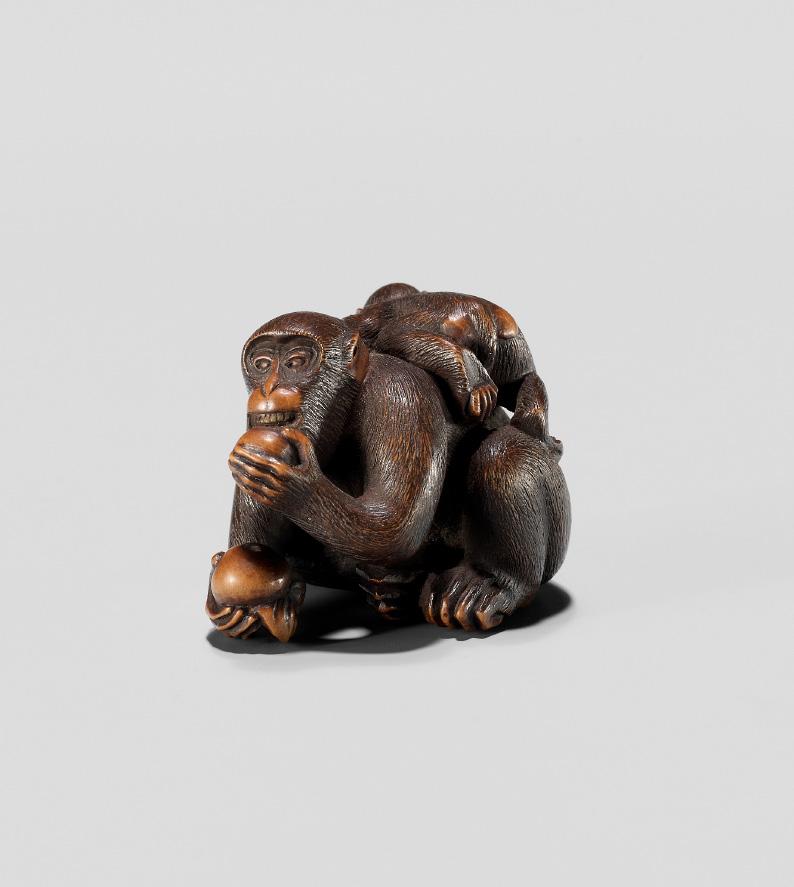
By a member of the Masanao family, signed Masanao 正直 Japan, Yamada, Ise province, 19th century, Edo period (1615-1868)
Finely carved as a monkey biting into a persimmon, the pupils inlaid in dark horn at the corners of the eyes and the teeth inlaid in bone. A small monkey is clambering over the adult’s back. The details are finely carved, and the fur is neatly engraved. Natural himotoshi and signed MASANAO within a polished reserve underneath.
LENGTH 4.7 cm
Condition: Excellent condition with only very minor surface wear.
Estimate EUR 2,000
Starting price EUR 1,000
366
379
380
MASANAO: A FINE WOOD MINIATURE OKIMONO OF A TOAD
By a member of the Masanao family, signed Masanao 正直 Japan, Yamada, Ise province, late 19th century
The netsuke-sized okimono finely carved as a fat warty toad, the skin minutely detailed with raised bumps above the neatly stippled surface, the eyes inlaid in ebony wood. The underside shows the webbed feet and signature MASANAO.

LENGTH 5 cm
Condition: Good condition with minor wear. Tiny chip to one toe.
Provenance: Collection Prof. Dr. Henk C. Hoogsteden, Rotterdam, purchased from Kunsthandel Klefisch, Asian Art, 12 October 2013, Cologne, lot 868.
Estimate EUR 2,000
Starting price EUR 1,000
381 MASANAO: A WOOD NETSUKE OF A RECUMBENT BOAR


By a member of the Masanao family, signed Masanao 正直 Japan, Yamada, Ise province, 19th century, Edo period (1615-1868)
Finely carved as a recumbent boar (inoshishi) raising its head, the eyes inlaid and fur neatly engraved, with two legs raised and two legs tucked under the body. Natural himotoshi and signed within a recessed oval reserve MASANAO.
From the Masanao sketchbook, illustrated in Highlights from the Masanano Sketchbook, International Netsuke Collectors Society Journal (INCSJ), vol. 2, no. 4, p. 37
Condition: Excellent condition with only very minor surface wear.
Provenance: Ex-collection Bernard Kotkin. A noted private collection, USA.
LENGTH 4 cm
AUCTION COMPARISON
A closely related wood netsuke of a boar by Masanao was sold at Zacke, Fine Netsuke & Sagemono, 22 April 2022, Vienna, lot 136 (sold for 4,298 EUR).

Estimate EUR 2,000
Starting price EUR 1,000
367
382
GYOKUZAN: AN IVORY NETSUKE OF TWO SAMURAI FIGHTING IN A HUGE ABUMI (STIRRUP)
 By Asahi Gyokuzan, signed Gyokuzan 玉山 Japan, Tokyo, second half of 19th century
By Asahi Gyokuzan, signed Gyokuzan 玉山 Japan, Tokyo, second half of 19th century
Intricately carved with two samurai inside a giant abumi (stirrup) with a finely stippled surface and decorated with a roundel enclosing a stream below a chrysanthemum. The warriors are embroiled in a vicious fight to death, one using his sword to block the other’s spear (yarai), both with well-detailed armor and grim expressions. The abumi with a central himotoshi, which is encircled by chrysanthemum petals to the underside. Signed to the underside within an oblong reserve GYOKUZAN.
LENGTH 4.6 cm
Condition: Very good condition with minor wear, few fine age cracks.
Provenance: From the collection of Gaston Lazard (1878-1956) and his wife Jane Levy (1886-1985) and thence by descent within the same family.
The present netsuke is the finest example this author has seen of this group.

Estimate EUR 2,000
Starting price EUR 1,000
368
383
AN INLAID WOOD NETSUKE OF SEIOBO WITH THE PEACH OF IMMORTALITY

Unsigned Japan, c. 1800, Edo period (1615-1868)
The Queen Mother of the West dressed in voluminous robes and holding a giant peach of immortality in front of her with both hands, the hands and head inlaid, the hair neatly incised and darkly stained, secured by an elaborate headdress. The back with the himotoshi.
HEIGHT 8.2 cm
Condition: Good condition, appealingly worn, few minuscule nicks.
Literature comparison: Compare a closely related netsuke of Seiobo holding a peach, illustrated in Davey, Neil K. (1974) Netsuke: A comprehensive study based on the M.T. Hindson Collection, p. 411, no. 1215, where the author notes that “[a]ccording to the Soken Kisho, this method of inlaying was used by Kanjuro (Reikichi, No. 447) and Meinertzhagen suggested that the present example could have been made by him”.
Compare a related inlaid wood netsuke of Seiobo holding a basket of peaches, attributed to Kanjuro, illustrated in Galerie Zacke (1985) Netsuke und Inro aus Japan, no. 35.
AUCTION COMPARISON
Compare a closely related netsuke of Seiobo, 8.5 cm high, dated late 18th to early 19th century, at Bonhams, 16 May 2013, London, lot 31 (sold for 1,187 GBP).


Estimate EUR 1,200
Starting price EUR 600
384
A FINE SMALL IVORY NETSUKE OF SOTOBA KOMACHI
Unsigned Japan, early 19th century, Edo period (1615-1868)
The poetess Ono no Komachi, once renowned for her beauty, depicted here as an old woman, her emaciated rib cage showing, clad in tattered robes, sitting on a grave post (sotoba), yet still gently smiling. Good, asymmetrical himotoshi underneath, the larger hole generously excavated to accommodate the knot. The ivory bearing a fine, lustrous patina.
LENGTH 3.7 cm
Condition: Very good condition, minor wear, fine age cracks. Beautiful patina.
Estimate EUR 1,000
Starting price EUR 500
369
A BOAR TUSK NETSUKE DEPICTING A RECUMBENT OX
Unsigned
Japan, probably Iwami Province, 19th century
Finely carved in shishiaibori (sunken relief) with a recumbent ox, its fur detailed with skillful stippling and dark stain, its head lowered to one side and the tail trailing, the animal further with raised ribs, long curved horns, and wide funnel-shaped ears. The reverse with a single himotoshi. The surface bearing a fine honey-yellow patina, particularly to the back.
LENGTH 7 cm
Condition: Good condition, minor wear, expected age cracks, few light surface scratches.
AUCTION COMPARISON
Compare a closely related boar tusk netsuke, similarly carved in shishiaibori with a recumbent ox, 12 cm long, at Sotheby’s, The Carlo Monzino Collection of Netsuke, Inro and Lacquer, 21 June 1995, London, lot 241 (sold for 1,840 GBP).

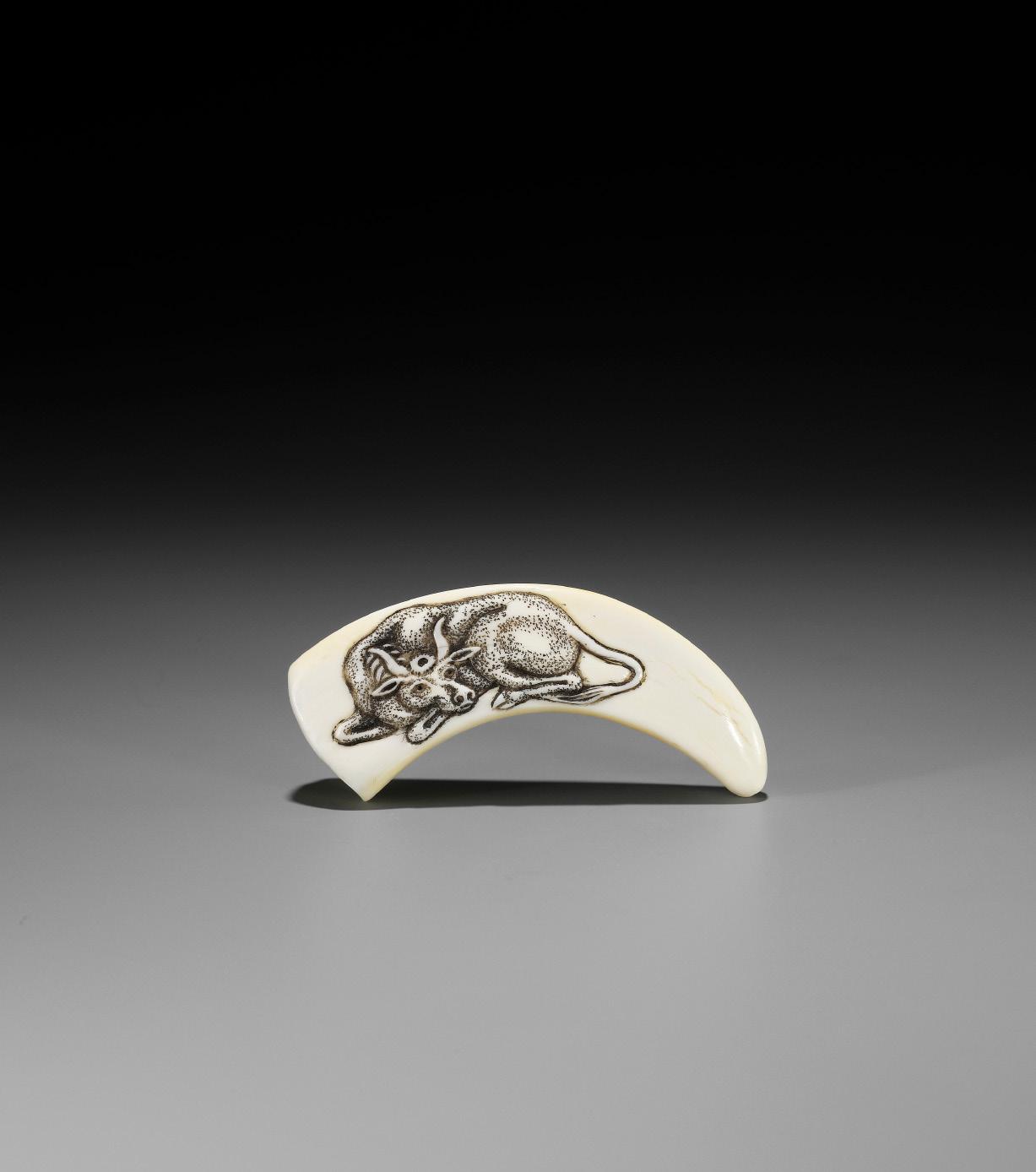
Estimate EUR 1,500
Starting price EUR 800
370 385
By Seiyodo Bunshojo (1764-1838), signed Nihon San’indo Iwami Enokawa Seiyodo Bunshojo chokoku 青陽堂 文章女 Japan, Iwami
Province, late 18th to early 19th century, Edo period (1615-1868)
Published: Earle, Joe (2000) The Robert S. Huthart Collection of Iwami Netsuke, Vol. 1, p. 110, no. 90.

Carved from a choice, beautifully shimmering boar tusk with pronounced curvature. Towards the narrow end the artist has carved a large spider in high relief with incised hair on its thick segmented body, large fangs and inlaid eyes. The spider is carved with a superior sense of naturalism, which is extraordinarily rare for comparable Iwami tusk netsuke with spiders. Below the arachnid are delicately engraved ferns next to the signature and inscription reading SEIYODO BUNSHOJO carved this by the Eno River in the San’indo region of Japan. With a zoomorphic pot seal.


LENGTH 10.8 cm
Condition: Very good condition with natural veining and minor age cracks.
Provenance: The Robert S. Huthart Collection.
Estimate EUR 4,000
Starting price EUR 2,000
371
386 SEIYODO BUNSHOJO: A SUBLIME BOAR TUSK NETSUKE WITH SPIDER AND FERNS
387
A RARE STAG ANTLER RYUSA MANJU NETSUKE OF A STYLIZED ‘BAT’ DRAGON
Unsigned Japan, 19th century
Finely carved in openwork depicting a bat-like dragon in profile, its long curved beak screeching, surrounded by billowing clouds, the sides with neatly carved lotus leaves, the verso with stylized floral emblems and the himotoshi formed by one oval and one circular opening. The carving shares some characteristics with the famous Asakusa carvers but looks to be earlier of date.
DIAMETER 4.1 cm

Condition: Excellent condition with minor typical wear, natural imperfections.
LITERATURE COMPARISON
A near-identical manju is illustrated in Joly, Henri L. (1966) The W. L. Behrens Collection, Part 1, Netsuke, pl. XXVII, no. 1498.
Estimate EUR 2,500
Starting price EUR 1,200
388
A FINE STAG ANTLER RYUSA MANJU NETSUKE OF RAIJIN


Unsigned Japan, 19th century, Edo period (1615-1868)
Finely carved in openwork, the front showing a powerful image of the Thunder God Raijin painting a tomo-e crest on one of his drums, dressed only in a loincloth and engulfed by a billowing shawl, his visible eye inlaid, the details stained in sumi (ink). The reverse is carved with two large, ringed cord holes, a bolt of lightning, and a second drum. The stag antler bearing a fine patina.
LENGTH 4.8 cm
Condition: Excellent condition with minor typical wear, few light age cracks, natural imperfections. Provenance: Lempertz, Netsuke-Sammlung Kolodotschko II, 6 December 2014, Cologne, lot 774 (sold for 2,728 EUR).

Estimate EUR 4,000
Starting price EUR 2,000
372
389
A
RARE
STAG ANTLER NETSUKE
SHUNGA
OF OKAME AS SOTOBA KOMACHI
Unsigned Japan, 18th century, Edo period (1615-1868)
An erotic satire of the popular Sotoba Komachi motif – usually depicting the famous waka poetess Ono no Komachi, once renowned for her beauty, as an old woman seated on a grave post (sotoba) begging by the roadside – with a characteristically mirthful Okame wearing long robes and a rag over her forehead, holding a cane in one hand and a phallic mushroom in the other. The netsuke is well detailed with bold incision work heightened by dark staining. The back with generously excavated, asymmetrical himotoshi.
LENGTH 3.6 cm
Condition: Very good condition, appealingly worn, natural imperfections.
Estimate EUR 1,200
Starting price EUR 600
390
A GOOD STAG ANTLER NETSUKE OF DAIKOKU

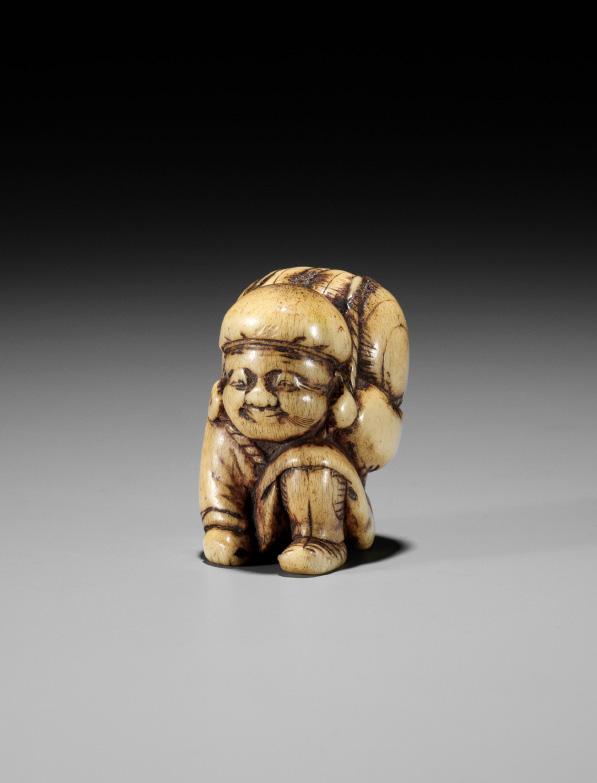
Unsigned Japan, 18th century, Edo period (1615-1868)
The god of wealth kneeling and carrying a large bale of rice on his back, his face marked with a smile and framed by pendulous earlobes. The antler bearing a fine patina, plugged to the bottom and top. Two himotoshi underneath the rice bale.

HEIGHT 3.7 cm
Condition: Very good condition with old, typical wear.
LITERATURE COMPARISON
Compare to a closely related stag antler netsuke of Daikoku illustrated in Barry Davies Oriental Art (1996) Netsuke from the Teddy Hahn Collection, London, no. 8.

Estimate EUR 1,200
Starting price EUR 600
373
391
A RARE STAG ANTLER NETSUKE OF A PUPPETEER WITH A DOG PUPPET ON HIS HEAD


Unsigned Japan, 18th to early 19th century, Edo period (1615-1868)
Finely and amusingly carved from a tubular branch of the antler as a puppet player, wearing long voluminous robes with deeply incised folds, his arms folded in front and holding a cane, his face with narrowed eyes and the mouth slightly open in a subtle smile, his head surmounted by a dog puppet with incised folds mirroring those on the man’s robe. The back with a large himotoshi, the other opening ‘natural’ through the hollow base.
HEIGHT 7 cm
Condition: Very good condition, appealingly worn, natural imperfections including fine age cracks.
Estimate EUR 2,000
Starting price EUR 1,000
374
392
A CHARMING STAG ANTLER NETSUKE OF A HARE

Unsigned Japan, 19th century, Edo period (1615-1868)
The rabbit (usagi) seated with its paws pushed afore, the long ears laid back for compactness, the eyes inlaid in reddish horn, its head raised curiously. The underside with two generously excavated himotoshi. The material bearing a beautiful, warm caramel color.
LENGTH 3.2 cm
Condition: Excellent condition with minor wear and natural flaws to the material.
Estimate EUR 1,500
Starting price EUR 800
393
A RARE STAG ANTLER NETSUKE OF A COILED MONKEY


Unsigned Japan, Tokyo, Asakusa, late 19th century
Of appealingly compact form, the monkey coiled into a ball with all four hands and feet close together in front, the eyes finely carved, the fur subtly and neatly incised, the back with asymmetrical himotoshi.
LENGTH 3.6 cm
Condition: Very good condition, minor wear, natural imperfections.
The subject is most unusual and stylistically this feels close to the hand of Hoshunsai Masayuki.
MUSEUM COMPARISON
Compare a wood netsuke of a monkey shown in a similar pose, signed Miwa, its back in stag antler with inscription ‘repaired by Koku’, in the Victoria & Albert Museum, accession number A.936-1910.
Estimate EUR 3,000
Starting price EUR 1,500
375
394 KANSAI: A RARE LACQUERED AND METAL-INLAID STAG ANTLER MANJU NETSUKE DEPICTING HO-O AND KIRI
By a member of the Koma Kansai lineage, signed Kansai 寛哉 Japan, 19th century, Edo period (1615-1868)
The two-part manju netsuke carved from antler or bone and inlaid to the front with a ho-o (phoenix) flying above a kiri (paulownia) blossom with leaves, both inlaid in shibuichi, and surrounded by goldlacquered takamaki-e vines. The back with a central himotoshi, the cord attachment within, and signed KANSAI.

DIAMETER 3.4 cm
Condition: Good condition, minor wear to lacquer, some natural age cracks.
Provenance: From the collection of Gaston Lazard (1878-1956) and his wife Jane Levy (1886-1985) and thence by descent within the same family.
Both the ho-o bird and the paulownia (kiri) tree are imperial symbols of Japan. According to legend, the ho-o, a bird similar to the phoenix that represents the eternal rebirth of the soul, only settles on the kiri tree. In the hope of attracting this auspicious bird that blesses people with wisdom, health, and happiness, the trees are planted in courtyards and gardens.
Estimate EUR 1,000
Starting price EUR 500
395 A FINE RYUSA STAG ANTLER MANJU NETSUKE WITH MON DESIGN
Unsigned Japan, Tokyo, Asakusa District, second half of 19th century
The two-part stag antler manju finely carved in openwork depicting various mon and with a swirling design to the back encircling the central himotoshi, the cord attachment within.

DIAMETER 4 cm
Condition: Good condition with natural flaws to the material including some ‘losses’ to the rim.
Estimate EUR 1,200
Starting price EUR 600
376
396
A FINE WALRUS IVORY RYUSA MANJU NETSUKE WITH DRAGON



Unsigned Japan, Tokyo, Asakusa District, second half of 19th century
Published: Henri L. Joly, W. L Behrens Collection (1912/1966), no. 1523.
Masterfully hollowed out and carved in openwork with a depiction of a central coiled dragon, in Chinese style, surrounded by clouds and bands with an archaistic key-fret design. The reverse with central floral himotoshi and with further pierced petals, effectively creating a double flower. The sides completely carved in openwork with a wavy concentric band.
DIAMETER 4.1 cm, THICKNESS 2 cm
Condition: Very good condition.
Provenance: Walter L. Behrens collection, no. 1523.
Estimate EUR 2,500
Starting price EUR 1,200
397 A WALRUS TUSK RYUSA MANJU NETSUKE DEPICTING A BAT AND GOURDS
Unsigned Japan, Tokyo, late 19th century
Of oval form, finely carved in openwork to one side with a stylized bat with a cat-like face, curled tail, and wings in the form of stippled leaves with raised veins and scrolling stems, all flanked by two gourds, this side of the ryusa manju incised with checkerboard patterns, the back with further gourds and leaves detailed with worm-eaten holes as well as the central himotoshi.
LENGTH 4.5 cm
Condition: Excellent condition, minor wear, natural imperfections.
Provenance: From the collection of Gaston Lazard (1878-1956) and his wife Jane Levy (1886-1985) and thence by descent within the same family.
MUSEUM COMPARISON
Compare a related carved walrus tusk ryusa manju netsuke with a bat, 3.8 cm, dated 19th century, in the Toledo Museum of Art, object number 1950.91A.
Estimate EUR 1,000
Starting price EUR 500
377
398 TENMIN: A KAGAMIBUTA NETSUKE DEPICTING A NIO PULLING A GRIMACE
By Asama Tenmin, signed Tenmin 天民 Japan, Tokyo, late 19th century
The solid shibuichi plate fitted into a lustrously polished ivory bowl, the disc worked in takazogan with highlights of gold, silver and suaka, depicting a muscular nio temple guardian pulling an amusing grimace. Central himotoshi to the back, the cord attachment to the back of the plate.
DIAMETER 4.5 cm
Condition: Some fine age cracks to the bowl, otherwise in excellent condition with minor expected wear.
Provenance: Belgian collection, purchased from Lempertz, Cologne.
AUCTION COMPARISON
Compare to a related kagamibuta netsuke by Tenmin, depicting a pensive rakan, at Zacke, Asian Art Discoveries – Japanese Art, 1 September 2022, Vienna, lot 184 (sold for 1,896 EUR).



Estimate EUR 1,000
Starting price EUR 500
399 A KAGAMIBUTA NETSUKE OF A SHOJO ON MINOGAME
Unsigned Japan, late 19th century
The shibuichi disc fitted into a neatly polished, tapered ivory bowl, the front decorated in takazogan with gold and suaka highlights, depicting a miongame holding a hishaku sake ladle and riding a minogame. Central himotoshi to the back, the cord attachment to the back of the plate.
DIAMETER 4.4 cm
Condition: Very good condition with minor wear and traces of use to the ivory bowl.
Provenance: Collection Prof. Henk Hoogsteden, Rotterdam.
Estimate EUR 1,000
Starting price EUR 500
378
400
A RARE KAGAMIBUTA NETSUKE WITH SHIBUICHI PLATE DEPICTING A NEKOMATA
Unsigned Japan, late 19th century
Of circular form, the shibuichi plate finely decorated in gold, shibuichi, copper, and shakudo takazogan with a dancing bakeneko wearing a cloth on its head, under a flat-inlaid crescent moon, with a bundle of straws, flowers, and grasses carved in katakiri and kebori.
DIAMETER 4.4 cm (the bowl) and 3.4 cm (the plate)
Condition: The bowl is a later addition and exhibits some wear and losses. The plate is in very good condition with little wear and expected minor tarnish.
MUSEUM COMPARISON
Compare a related kagamibuta netsuke depicting a nekomata by Shuraku, 4 cm diameter, dated c. 18601890, formerly in the Trumpf Collection and now in the Linden-Museum Stuttgart, inventory number OA 18841.

Estimate EUR 1,500
Starting price EUR 800
401
A RARE BRONZE NETSUKE OF A MONKEY WITH GOURD
Unsigned Japan, 19th century
A heavily cast miniature bronze netsuke, worked with fine incision work, depicting a monkey (saru) kneeling over a gourd and picking apart its flesh. Natural himotoshi.


HEIGHT 3.3 cm
WEIGHT 61 g
Condition: Good condition, minor wear, casting irregularities, some green verdigris from oxidation.
Estimate EUR 800
Starting price EUR 400
379
402 AN UNUSUAL TSUISHU HAKO NETSUKE WITH KARAKO MUSICIANS
Unsigned Japan, 18th century, Edo period (1615-1868)
The hako (box) netsuke of quatrefoil shape, consisting of two parts, worked in tsuishu (carved red lacquer), the front depicting a drumming karako, the horizon showing rocks issuing leaves, a pavilion and the moon, all against a finely incised asanoha ground. The reverse is similarly decorated with a karako playing a Chinese wind instrument below a towering pine tree. The sides


403 A RARE TSUISHU LACQUER MANJU NETSUKE WITH CHINESE SCHOLARS AND MULE
Unsigned Japan, 18th century, Edo period (1615-1868)
are decorated with reishi clouds, further asanoha and various plants. Central himotoshi to the back, the looped cord attachment with kiku mount inside. The interior lacquered in black.

LENGTH 3.6 cm
Condition: Very good condition, some very minor chips and wear to edges. The interior with some wear and minor losses.
Provenance: Ex-collection Raymond Bushell, sold at Sotheby’s, Japanese and Korean Works of Art, 21 March 2001, New York, lot 145.
Estimate EUR 1,000
Starting price EUR 500
An early tsuishu lacquer netsuke of two-part manju type, the front decorated in relief with a Chinese scholar standing next to a mule below a pine tree, the ground bearing a fine asanoha design. The verso shows a further scholar and tree, reishi clouds, craggy rocks, and more of the beautifully incised asanoha ground. Central himotoshi to the back, the looped cord attachment to the blacklacquered interior which shows a finely worked design of a ho-o bird and clouds.
DIAMETER 4 cm
Condition: Very good condition with minor wear to exterior. The interior with a fine crack and some wear along the edges.
Provenance: Austrian private collection, remnants of an old label to the interior.
Estimate EUR 1,500
Starting price EUR 800
380
404 A NEGORO LACQUER NETSUKE OF DARUMA
Unsigned Japan, Meiji period (1868-1912)
Bodhidharma is shown seated meditatively, completely enveloped in his robe, the robe covered in stunning negoro lacquer. The red lacquer is highly contrasting to Daruma’s black-lacquered body. Himotoshi through the underside.

HEIGHT 3 cm
Condition: Good condition, minor expected wear to lacquer, a crack to the top of the netsuke and a loss to the left knee.
Provenance: German private collection. Old accession no. ‘748. 9801’ to the underside.
AUCTION COMPARISON
Compare to a closely related lacquer netsuke of Daruma at Zacke, Fine Netsuke & Sagemono, 25 September 2020, Vienna, lot 43 (sold for 1,643 EUR).
Estimate EUR 1,000
Starting price EUR 500
405 A CHARMING GOLD LACQUER NETSUKE OF A DOG WITH DRUM
Unsigned Japan, 19th century
A charming netsuke, depicting a goldlacquered piebald dog with roiro spots, wearing a red-lacquered collar, both paws placed on a large taiko drum, lacquered in gold, black and dense orange nashiji. The dog’s expression is amusingly crafted, its redlacquered tongue extended. Two himotoshi underneath.


LENGTH 3.5 cm
Condition: Excellent condition, minor typical wear to lacquer.
Estimate EUR 1,500
Starting price EUR 800
381
407
A CORAL NETSUKE OF HOTEI

Unsigned Japan, 19th century
Finely carved with Hotei leaning against his huge treasure bag, a large scroll poking out, the lucky god with a content expression marked by narrowed eyes and smiling lips, flanked by large thick earlobes, wearing a long robe and showing off his rotund belly, the back with small himotoshi.
LENGTH 5.1 cm
Condition: Very good condition with natural imperfections.
AUCTION COMPARISON
Compare a closely related coral netsuke of Daikoku and Ebisu, by the same carver/ workshop, 4 cm high, dated 19th century, at Lempertz, 6 December 2014, Cologne, lot 866 (sold for 1,612 EUR).

Estimate EUR 1,200
Starting price EUR 600
406
A RARE RHINOCEROS HORN NETSUKE OF A GOJO BRIDGE POST

Unsigned Japan, 19th century, Edo period (1615-1868)
The horn of caramel tone with beautiful parallel striations varying in color and intensity, the surface finely polished to highlight the natural material. Depicted is a traditional bridge post, most likely from the Gojo bridge in Kyoto. Two himotoshi underneath. Both the material and subject matter are very rare in netsuke art.
HEIGHT 4.3 cm
Condition: Excellent condition, only very minor wear.
Provenance: Family collection of either Felix Tikotin (1893-1986) or his son-in-law Louis (Loek) Borensztajn (1935-2021), Netherlands. Felix Tikotin (1893-1986) was an architect, art collector, dealer, and founder of the first Museum of Japanese Art in the Middle East.

Estimate EUR 1,000
Starting price EUR 500
Ushiwakamaru Defeats
Musashibo
Benkei on the Gojo Bridge, by Utagawa Hiroshige (17971858). Two bridge posts are visible in the background.

382
Felix Tikotin (18931986), center, in front of his gallery in Berlin
408
UNSHOKEN: A KUROGAKI NETSUKE DEPICTING HOTEI AND TWO BOYS


By Unshoken, signed Unshoken 雲生軒 with seal Japan, 18th century, Edo period (1615-1868)
The black persimmon wood well carved to depict a cheerfully smiling Hotei seated on his huge sack as two small boys are engaged in a game kubihiki with Hotei’s tasseled prayer beads, both gleefully laughing. Hotei and the boys’ lips are detailed with red pigments. The sack with very large and asymmetrical himotoshi to the back and underside, the underside further with the incised and red-stained signature UNSHOKEN with a seal.
WIDTH 4.4 cm
Condition: Good condition with some wear, minuscule nicks, light surface scratches.
Although the artist Unshoken appears to be unrecorded, Frederick Meinertzhagen notes an artist named Unshodo, dated “Early period”, who used kurogaki (black persimmon) wood and made “Tobutsu”. See Meinertzhagen, Frederick / Lazarnick, George (1986) MCI, Part B, p. 968.
Estimate EUR 1,200
Starting price EUR 600
409
A CHARMING POLYCHROME WOOD ITTOBORI NETSUKE

Signed with a ‘butterfly’ kakihan Japan, 19th century
Finely carved in the ittobori (single cut) technique and embellished with polychrome pigments, depicting a woman dressed in an elaborate kimono and holding a basket, one hand applying a cloth to her head. The smoothly polished underside is engraved with a butterfly-shaped kakihan. pierced himotoshi through the back.
HEIGHT 3.1 cm
Condition: Good condition, minor expected wear to the polychrome pigments and some traces of use.
Provenance: German private collection. Old accession no. ‘74.535’ to the underside.
Estimate EUR 800
Starting price EUR 400
383
410
A SAISHIKI (PAINTED WOOD) NETSUKE OF THE SAMBIKI SARU (THREE WISE MONKEYS)

Unsigned Japan, 19th century
A compact and finely carved netsuke of the sambiki saru, also referred to as the three wise monkeys. The three primates are huddled together, each seated with crossed legs and each covering their own mouth, ears, or eyes. The details are well rendered and the netsuke is skillfully painted and attractively worn. The cord channel is drilled vertically through the center, the himotoshi to the base with an elaborate, partly gilt, mixed-metal chrysanthemumform fitting akin to a tehen kanamono.
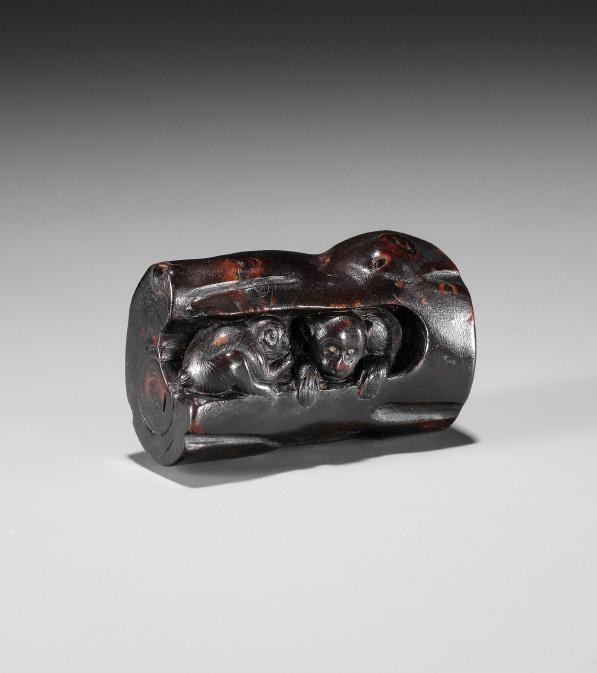

LENGTH 3.8 cm
Condition: Good condition with typical wear, few small chips. Provenance: From the collection of Felix Tikotin, and thence by descent within the family. Felix Tikotin (1893-1986) was an architect, art collector, and founder of the first Museum of Japanese Art in the Middle East.
Estimate EUR 1,000
Starting price EUR 500
411
A
RARE UMIMATSU NETSUKE OF THREE MONKEYS INSIDE A TREE
Unsigned Japan, 18th-19th century, Edo period (1615-1868)
Carved from a choice section of umimatsu (sea pine) with beautiful marbling and reddish inclusions, depicting a hollowed tree trunk, two monkeys visible in an opening to the front, one facing to the side and eating a fruit, the other larger monkey looking out, the eyes painted with gold lacquer. A further monkey is visible from the back inside an opening to the side. Generously hollowed himotoshi to the back.
LENGTH 4.2 cm
Condition: Excellent condition with typical crackling to the material.
AUCTION COMPARISON
Compare to a related umimatsu netsuke of monkeys on a tree trunk, sold at Bonhams, The Robert S. Huthart Collection of Netsuke Part II, 6 November 2019, London, lot 146 (sold for 1,211 GBP).

Estimate EUR 2,000
Starting price EUR 1,000
384
412
AN UNUSUAL PAULOWNIA (KIRI) WOOD NETSUKE OF A TOAD ON ROOF TILE

Unsigned Japan, early 19th century, Edo period (1615-1868)
The fat, warty toad seated on a roof tile, its webbed feet neatly detailed and splayed, the body in an alert position, the textured skin neatly detailed, and eyes inlaid in pale translucent horn with dark pupils. Large himotoshi through the underside.
LENGTH 3 cm
Condition: Excellent condition with typical wear.
Estimate EUR 1,000
Starting price EUR 500
413
A RARE NUT NETSUKE OF FIVE FROGS ON A LOTUS LEAF, ATTRIBUTED TO SEIMIN

Attributed to Seimin, unsigned Japan, Iwashiro province, second half of 19th century
Well carved from a nut, most likely corozo, in openwork with five frogs seated in a circle on the edges of a lotus leaf and holding up a further furled lotus leaf between them, the underside carved with fine veins in relief and a broad stalk forming the himotoshi.
LENGTH 3.5 cm
Condition: Excellent condition with minor natural flaws to the material and few traces of use.
Provenance: From the collection of Felix Tikotin, and thence by descent within the family. Felix Tikotin (1893-1986) was an architect, art collector, and founder of the first Museum of Japanese Art in the Middle East. Born in Glogau, Germany, to a Jewish family, his ancestors had returned with Napoleon from Russia from a town named Tykocin. He grew up in Dresden and after World War I, he traveled to Japan and immediately fell in love with the culture. In April 1927, he opened his own first gallery in Berlin. The entire family survived the holocaust, and in the 1950s Tikotin slowly resumed his activities as a dealer in Japanese art. He became, once again, very successful and prominent, holding exhibitions all over Europe and the United States. When he first visited Israel in 1956, he decided that the major part of his collection belonged in that country. In 1960, the Tikotin Museum of Japanese Art was opened in Haifa.
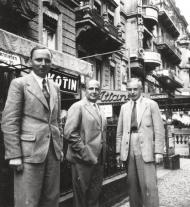
Estimate EUR 2,000
Starting price EUR 1,000
385
Felix Tikotin (1893-1986), center, in front of his gallery in Berlin
414
MASAHIDE: A FINE KURUMI (WALNUT) NETSUKE DEPICTING LOTUS
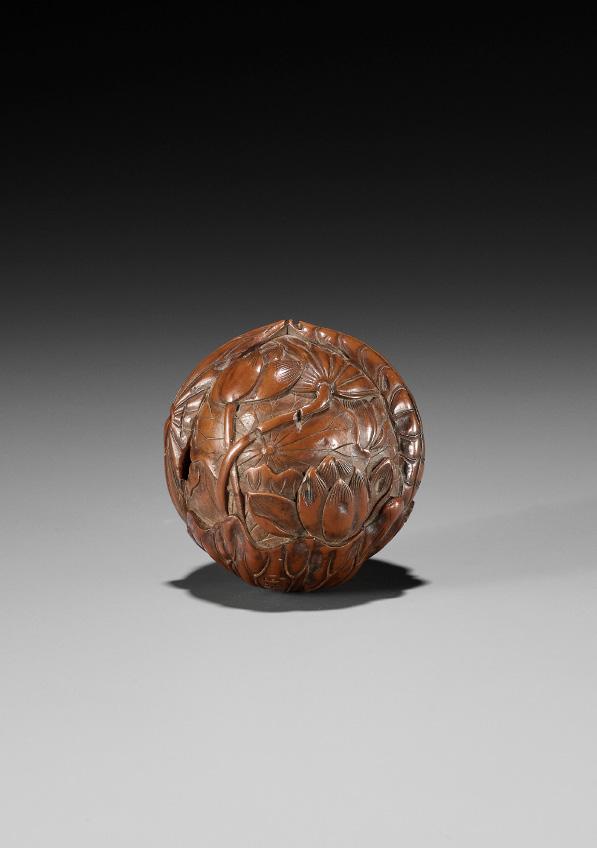 By Sakiyo Kurokawa Masahide, signed Masahide 正英 Japan, Nagasaki, mid-18th century, Edo period (1615-1868)
By Sakiyo Kurokawa Masahide, signed Masahide 正英 Japan, Nagasaki, mid-18th century, Edo period (1615-1868)
The walnut superbly carved with many lotus leaves and some flowers and buds. The seam of walnut is masterfully worked with furled lotus leaves. Two irregularly shaped himotoshi and signed MASAHIDE.
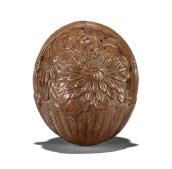
Sakiyo Kurokawa Masahide, active during the mid-18th century, excelled in the carving of nuts. His skill in carving kurumi netsuke is arguably unsurpassed.
LENGTH 3.3 cm
Condition: Excellent condition with minor wear and natural flaws to the material.
Literature comparison: A closely related kurumi netsuke of a flower basket is illustrated in Davey, Neil K. (1974) Netsuke: A comprehensive study based on the M.T. Hindson Collection, p. 295, no. 898.
AUCTION COMPARISON
Compare to a closely related Kurumi netsuke of a flower basket, at Zacke, Fine Netsuke & Sagemono, 29 October 2021, Vienna, lot 284 (sold for 3,286 EUR).
Estimate EUR 1,500
Starting price EUR 800
415
HIDARI ISSAN: A KURUMI (WALNUT) NETSUKE DEPICTING AN OX HERDER

By Hidari Issan, signed Hidari Issan 左一山 with seal Japan, Iwashiro Province, mid-19th century, Edo period (1615-1868)
The walnut finely engraved with a design referencing the famous ten ox herding pictures, a Zen Buddhist parable which draws a parallel between the herdboy and ox and the attainment of enlightenment. The front is carved in relief with an image of a herdboy playing the flute, while the reverse shows an ox amongst grasses. Two himotoshi through the nut and signed HIDARI ISSAN with a square seal.
LENGTH 3.5 cm
Condition: Excellent condition with minor wear and natural flaws to the material.
Estimate EUR 1,500
Starting price EUR 800
386
416
A KURUMI (WALNUT) NETSUKE OF RAKAN HANDAKA SONJA

Japan, 19th century, Edo period (1615-1868)
Finely carved as a seated rakan Handaka Sonja surrounded by a halo and conjuring a dragon from an alms bowl, the celestial being writhing around the composition with finely carved scales and fierce expression. Two himotoshi to the underside.
HEIGHT 2.8 cm
Condition: Very good condition with typical wear and natural flaws to the material as are to be expected from kurumi netsuke.
AUCTION COMPARISON
A closely related kurumi netsuke by Kozan depicting rakan Handaka Sonja and dragon, signed Kozan, was sold at Lempertz, The Papp Collection of Netsuke, 16 June 2018, Cologne, lot 1041 (sold for 3,472 EUR).
Estimate EUR 1,500
Starting price EUR 800
417 HIDARI ISSAN: A KURUMI (WALNUT) NETSUKE OF A ROLY POLY DARUMA

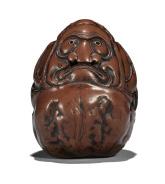
By Hidari Issan, signed Hidari Issan 左一山 Japan, Iwashiro Province, mid-19th century, Edo period (1615-1868)
A fine and humorous kurumi (walnut) netsuke depicting a Daruma doll completely enveloped in its robe, only the well-carved face is visible, as he looks upwards, his eyes inlaid in dark horn with metal surrounds. Two himotoshi to the back, one florally rimmed, and signed within a recessed oval reserve HIDARI ISSAN.


HEIGHT 4.4 cm
Condition: Excellent condition with minor wear and natural flaws to the material.
AUCTION COMPARISON
Compare to a closely related kurumi netsuke of Daruma, unsigned and attributed to Hidari Issan, at Zacke, Fine Netsuke & Sagemono, 16 April 2021, Vienna, lot 300 (sold for 1,830 EUR).
Estimate EUR 1,500
Starting price EUR 800
387
418 IKKOKUSAI: A RARE TAKAMORIE LACQUERED WOOD NETSUKE OF A WASP AND LOTUS
By Ikkokusai, signed Ikkokusai 一谷齋 Japan, late 19th century, Meiji period (1868-1912)
Finely carved as a furled lotus leaf with a large lotus pod with movable seeds, a takamori-e lacquered wasp emerging from an opening between the two folds of the large leaf. The surface is covered in translucent lacquer and is lightly drawn with lacquered veins. Natural himotoshi and signed in lacquer to the back of the leaf IKKOKUSAI.


LENGTH 5.3 cm
Condition: Excellent condition with minor surface wear.
Kinjo Ikkokusai III perfected the takamori-e design technique and won an award for excellence at the Kyoto Exhibition in Meiji 9 (1876). His reputation for work in this technique grew and at least 14 items were produced by him for the Meiji emperor. His son Kinoshita Chisai did not succeed his father’s name, which went instead to his younger brother, who became Ikkokusai IV. The current generation practicing this rare technique, Kinjo Ikkokusai VII, was designated as a Hiroshima Prefectural Intangible Cultural Property Holder in “Ikkokusai Takamorie” techniques in 2011.
Estimate EUR 1,500
Starting price EUR 800
388
IKUMI:
A FINE CONTEMPORARY WOOD NETSUKE OF A TANUKI WITH NAMAZU
 By Ikumi, signed Ikumi 郁美with kakihan Japan, 20th century
By Ikumi, signed Ikumi 郁美with kakihan Japan, 20th century
Finely carved as a tanuki with neatly incised fur and large bushy tail, one paw raised to which a cord is attached and wrapped around the tail of a namazu (catfish), all eyes are inlaid in pale translucent horn. Large, asymmetrical himotoshi through the back and signed IKUMI with kakihan:
HEIGHT 6 cm
Condition: Very good condition, minor surface wear.
Saito Ikumi is a female netsuke-shi who studied under Saito Bishu (born 1943).
Estimate EUR 1,500
Starting price EUR 800
389 419
420
VADYM PYVOVAR: AN EBONY WOOD NETSUKE OF A HARE AFTER TOYOMASA


By Vadym Pyvovar, signed with the artist’s mark Ukraine, 2023
Well carved seated on its haunches, looking up with an alert expression, its long ears pressed back and its legs drawn in for compactness, the fur finely incised, the right front and hind legs forming the himotoshi, the eyes inlaid with black coral, the right haunch with a rectangular reserve signed with the artist’s initials.
LENGTH 3.9 cm
Condition: Excellent condition.
AUCTION COMPARISON
Compare an example by Toyomasa which inspired this model at Bonhams, Fine Netsuke from the Adrienne Barbanson Collection, 13 May 2013, London, lot 8 (sold for 43,250 GBP).

Estimate EUR 1,000
Starting price EUR 500
421
VADYM PYVOVAR: A WOOD NETSUKE OF THE FUKURA SUZUME
By Vadym Pyvovar, signed with the artist’s mark Ukraine, 2023
The fat sparrow of classic form, with short stubby wings and short erect tail, the head sensitively carved with a short beak and puffy cheeks, the eyes inlaid in black coral. The underside with two asymmetrical himotoshi and the artist’s incised initials within a rectangular reserve.
LENGTH 4 cm
Condition: Excellent condition.
Fukura suzume literally means ‘puffed-up sparrow’. Its meaning as a symbol of happiness is based on the homonym fuku, which means both happiness and swelling. The invention of this type of netsuke probably goes back to Masanao from Kyôto. In the second half of the 18th century, he created such sparrows with funny heads, short, spread wings and raised tail feathers “as in the courtship display” (Brockhaus 1925, p. 440) both in ivory and boxwood.
Estimate EUR 1,000
Starting price EUR 500
390
422
ALEXANDER DERKACHENKO: A WOOD NETSUKE OF A SPARROW ON A GOURD
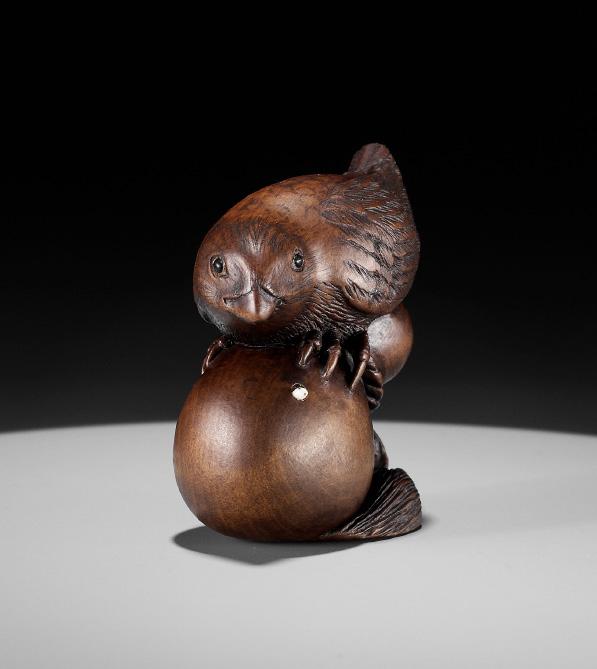
By Alexander Derkachenko, signed with the artist’s mark Ukraine, 2023
Finely carved as a sparrow with horn-inlaid eyes and well-detailed wings and feathers perched on a gourd which has a tasseled rope tied around it, the rope further suspending an ancient Chinese cash coin, a tiny movable worm inlaid with mammoth tusk peeking out of the gourd. Large himotoshi underneath and signed with the artist’s mark.
HEIGHT 4.6 cm
Condition: Excellent condition.
With an original mahogany storage box signed by the artist.
The sparrow is a symbol of happiness while the gourd symbolizes longevity, good fortune, and abundance of all blessings.
Estimate EUR 2,000
Starting price EUR 1,000
423
ALEXANDER DERKACHENKO: A WOOD NETSUKE OF A RAT WITH A BEAN-POD


By Alexander Derkachenko, signed with the artist’s mark Ukraine, 2023
Finely carved as a rat seated on its haunches, its mammoth tuskinlaid teeth dug into the bean-pod held with both front paws, one bean inlaid with mammoth tusk is visible on the underside, the animal well detailed with neatly incised fur, large funnel-shaped ears, long curled tail, and horn-inlaid eyes. Natural himotoshi between the feet, tail, and body. The base of the tail with a rectangular reserve signed with the artist’s signature.
LENGTH 4.4 cm
Condition: Excellent condition.
With an original mahogany storage box signed by the artist.
Estimate EUR 2,000
Starting price EUR 1,000
391
424
A HIGHLY UNUSUAL WOOD NETSUKE OF A SHAPESHIFTER

Unsigned Japan, late 19th to early 20th century, Meiji period (1868-1912)
Powerfully carved as a malevolent being in a treacherous disguise, appearing as a ronin wearing a short robe, holding a sheathed katana in his left hand and a headscarf in his right, his demonic form betrayed only by his three-clawed feet and the vengeful expression. The robe opening at the chest to reveal an emaciated rib cage and decorated with a neatly incised hem and a lozenge symbol at the back. His face with thick furrowed brows, intense eyes, a broad nose, and buck teeth. The back with large asymmetrical himotoshi.
HEIGHT 7.8 cm
Condition: Excellent condition with minor wear.
AUCTION COMPARISON
The style of the carving is somewhat reminiscent of Kokeisai Sansho (1871-1936) of Osaka. For a mask netsuke of a ghoul by Sansho, compare particularly the facial features to the present carving, see Zacke, Fine Netsuke & Sagemono, 28 April 2023, Vienna, lot 244.


Estimate EUR 1,200
Starting price EUR 600
425
A FINE SANSHO-STYLE WOOD NETSUKE OF A GHOUL

Unsigned Japan, late 19th to early 20th century, Meiji period (1868-1912)
Carved as the mask of grotesque ghoulish creature with curling bushy brows, an amusingly contorted mouth with fangs at the corners, and small eyes and nose. When turned upside down the mask reveals a further bearded face as well as a horned goat-like creature. A central bar with a pierced himotoshi to the back. The details are very finely rendered in the style of Kokeisai Sansho (1871-1936) of Osaka.
HEIGHT 5 cm
Condition: Excellent condition.
Provenance: German private collection. Remnants of an old label pasted to the back.
Estimate EUR 1,200
Starting price EUR 600
392
426
YORIMITSU: A RARE AND UNUSUAL BAMBOO OMAI TYPE MASK NETSUKE
By Yorimitsu (Raiko), signed Yorimitsu 頼光 Japan, 19th century
Published:
Bushell, Raymond Netsuke (1975) Familiar & Unfamiliar, p. 144, no. 299. Lazarnick, George (1981) Netsuke & Inro Artists, and How to Read Their Signatures, vol. 2, p. 857. Bushell, Raymond (1985), Netsuke Masks, pls. 288A and 288B.
Well carved in the round with a stern expression marked by thick furrowed brows, wide eyes, a broad nose, and the mouth agape showing teeth and tongue. The reverse with two large himotoshi above the signature YORIMITSU (Raiko).
HEIGHT 6.8 cm
Condition: Good condition with minor wear, tiny nicks, light scratches, the bamboo with natural flaws with two associated small losses to the forehead and chin (which are visible in the aforementioned publication illustrations as well).
Provenance: Ex-collection M. Souquet. Ex-collection Raymond Bushell, sold at Sotheby’s, Japanese and Korean Works of Art, 21 March 2001, New York, lot 153. Previously in a Dutch private estate. Van Ham, 8 December 2016, Cologne, lot 2484. European private collection P. Jacquesson, acquired from the above.
With its distinctively prominent nose, this mask is typical of those used in Omai, a type of Japanese ritual dance. Dancers wearing such masks were commonly seen at the head of Buddhist and Shinto processions in the 1300s and 1400s.
Estimate EUR 1,200
Starting price EUR 600
427
TADATOSHI: A FINE NAGOYA SCHOOL WOOD MASK NETSUKE OF BUAKU



HEIGHT 3.6 cm
Condition: Very good condition with minor wear.
Gyodo processional mask of the Omai type, c. 1400-1600, Asian Art Museum, San Francisco, Object Number 1991.72
By Tadatoshi,
signed Tadatoshi 忠利 Japan, Nagoya, first half of 19th century, Edo period (1615-1868)
Well carved as a typical Buaku mask with pierced eyes, thick brows, a broad nose, strong cheeks, and biting the lower lip showing the upper row of teeth. The back with a broad himotoshi bar pierced vertically and horizontally with a single cord channel and signed TADATOSHI in ukibori within a rectangular reserve.



Buaku is the mask for demonic roles such as those of Kaminari, the god of thunder, Emma-O, the king of hell, or any nameless demon or scary devil. Buaku generally represents them all. Buaku exposes his upper teeth clamped over his lower lip, his large nose and scowl creating a menacing mien containing hints of distress and timidity, a contradictory impression which is at the heart of Kyogen humor. Like the common oni, Buaku is often more pathetic than intimidating, sometimes displaying a hint of self-consciousness or of shame for his bad manners.
LITERATURE COMPARISON
Compare a closely related wood mask netsuke of Buaku by Tadatoshi, illustrated in Bushell, Raymond (1985), Netsuke Masks, pl. 224, which was later sold at Sotheby’s London, Netsuke from the Collection of Raymond and Frances Bushell, 18 November 1999, London, lot 140. Another closely related wood mask netsuke of Buaku by Tadatoshi is illustrated in Meinertzhagen, Frederick / Lazarnick, George (1986) MCI, Part B, p. 844.
MUSEUM COMPARISON
Compare a related Buaku mask dated 17th-19th century in the Nara National Museum, accession number 111-1, and another dated to the late Edo period in the Phoenix Art Museum, object number 2010.332.
Estimate EUR 1,200
Starting price EUR 600
393
428
DEME UMAN: A WOOD NOH MASK NETSUKE OF O-BESHIMI


 By Deme Uman, signed Deme Uman 出目右滿 Tenkaichi 天下一 Japan, Edo (Tokyo), early 19th century, Edo period (1615-1868)
By Deme Uman, signed Deme Uman 出目右滿 Tenkaichi 天下一 Japan, Edo (Tokyo), early 19th century, Edo period (1615-1868)
Boldly carved as an O-Beshimi mask with prominent nose and furrowed brows, the lips set firmly, the eyes lacquered in gold. The back with a thick central bar housing the himotoshi and signature DEME UMAN and with a further carved inscription Tenkaichi (number one under heaven). The wood bearing a fine, dark patina.
HEIGHT 4.8 cm
Condition: Very good condition with minor expected wear and traces of use. A tiny chip to the edge in the back.
Provenance: Ex-collection M. Tollner. Dutch private collection, purchased from Marsha Vargas.
Deme Uman was the grandson of Deme Juman, who is credited as the originator of mask netsuke. He is regarded as the most celebrated of mask netsuke makers and worked almost invariably in wood. He often inscribed his work with the honorific title of Tenkaichi 天下一
Estimate EUR 1,200
Starting price EUR 600
429
A WOOD MASK NETSUKE OF A FEMALE DEMON
Unsigned Japan, late 19th century
Depicting a female demon mask with menacing expression, prominent nose, large fangs, and with loose strands of hair. The boxwood is finely stained, and eyes and teeth are lacquered in gold. A shaped himotoshi bar to the back.
HEIGHT 4.6 cm
Condition: The himotoshi bar in the back has been replaced. Otherwise good condition with minor wear.
Provenance: Ex-collection Peter Müller, collection no. 62. Dutch private collection, acquired from the above.
Estimate EUR 1,200
Starting price EUR 600
394
Mask of O-Beshimi, Miyata Chikugo, 18th century, Fukuoka City Museum
430
DEME UMAN: A WOOD MASK NETSUKE OF KIJO


By Deme Uman, signed Deme Uman 出目右滿 Japan, Edo (Tokyo), early 19th century, Edo period (1615-1868)
Depicting Kijo, a female demon mask akin to a Hannya mask, however more condensed in its proportions. The eyes are lacquered in gold. Signed to the back of the central himotoshi bar DEME UMAN.
HEIGHT 4.6 cm
Condition: Excellent condition with minor wear and traces of use.
Provenance: Dutch private collection.
Estimate EUR 1,000
Starting price EUR 500
431
RYUZAN: A WOOD MASK NETSUKE OF SHIKAMI
By Ryuzan, signed Ryuzan 龍山 Japan, Edo/Tokyo, second half of 19th century
Finely carved and bearing an attractive stain, depicting the demonic mask of Shikami with large fangs, furrowed brows, and piercing gaze. The details are finely engraved. The back with a shaped himotoshi bar and signed RYUZAN – a pupil of Ryukei.
HEIGHT 4.6 cm
Condition: Excellent condition with minor surface wear.
Provenance: Ex-collection Peter Müller, collection no. 109. Dutch private collection, acquired from the above.
Estimate EUR 1,000
Starting price EUR 500
395
433 A WOOD NETSUKE OF A SHISHI MASK WITH MOVABLE JAW



Unsigned Japan, 19th century, Edo period (1615-1868)
432 A FINE INLAID WOOD NOH MASK NETSUKE OF TOKUSA-JO

Unsigned Japan, 19th century, Edo period (1615-1868)
Finely carved and inlaid in bone and ebony, depicting the mask of Tokusa-Jo, the long beard flowing to the other side, the details finely carved. A large bar to the back houses the himotoshi.
HEIGHT 4.5 cm
Condition: Excellent condition, some light surface scratches to the back.
Provenance: Dutch private collection, purchased from Denise Cohen, New York.
Estimate EUR 1,500
Starting price EUR 800
Finely and expressively carved with a movable jaw, the mouth opening to reveal rows of teeth and a pointy, lifted tongue. Possibly a representation of one of the masks used for the shishimai (Japanese Lion Dance) performance. The shishi has pierced eyes and nose holes, which greatly enlivens the depiction. It looks still but powerful, its bushy fur is neatly engraved. The himotoshi are cleverly integrated into the design under the curls in the back.
LENGTH 4.4 cm
Condition: Very good condition with minor wear. One of the plugs concealing the hinge to the side is lost.
Estimate EUR 1,000
Starting price EUR 500
396
Noh mask of Tokusa-Jo, 18th century, Fukuoka City Museum
434
A RARE HONEN (HORNBILL) MASK NETSUKE OF SHOJO
Unsigned Japan, 19th century
Finely carved as the drunken sprite Shojo smiling enigmatically and showing the upper row of teeth, the nose well carved and pupils pierced, the naturally red area of the beak used for the shojo’s long red hair. The back with a central himotoshi bar.
HEIGHT 4.3 cm
Condition: Excellent condition.
AUCTION COMPARISON
Honen netsuke are rare, for another example see Zacke, Fine Netsuke & Sagemono, 19 October 2021, Vienna, lot 269 (sold for 3,286 EUR).
Estimate EUR 2,000
Starting price EUR 1,000
435
A RARE HONEN (HORNBILL) MASK NETSUKE OF AN ONI, ATTRIBUTED TO JUGYOKU
Unsigned Japan, Edo (Tokyo), mid to late 19th century
The hornbill remarkably carved, wafer thin at the edges, depicting an oni with an amusingly grim expression, the naturally red areas used for the hair and horns. The reverse with a central himotoshi bar. Unsigned, however attributed to Ryukosai Jugyoku (see auction comparison).
HEIGHT 4.4 cm
Condition: Few chips to edges and a repair to one nostril.
AUCTION COMPARISON
Compare to a closely related oni mask by Jugyoku at Sotheby’s, The Katchen Collection of Netsuke, 8 November 2005, London, lot 65 (sold for 5,040 GBP).




Estimate EUR 1,500
Starting price EUR 800
397
436 A RARE SHUNGA MASK NETSUKE OF HYOTTOKO
Unsigned Japan, 19th century, Edo period (1615-1868)
An unusual wood mask netsuke of the jester Hyottoko, pursing his lips and sticking out his tongue suggestively, the back carved as a mushroom with neatly incised radial gills, the ‘stem’ forming the himotoshi.
HEIGHT 4.6 cm
Condition: Good condition with minor wear, age cracks, and traces of use
Provenance: Paul Rutten Asiatic & Tribal Art, Amsterdam. Dutch private collection, acquired from the above.
Estimate EUR 1,500
Starting price EUR 800
437 MASUMITSU: A LARGE WOOD MASK NETSUKE OF A BOY

By
Masumitsu,
signed Masumitsu 升光 Japan, Edo/Tokyo, second half of 19th century
Finely carved as a boy wearing a cloth on his head, the face with arched brows, a neatly carved nose with a long thin bridge, lips puckered into a smile, and puffed cheeks. The back with a horizontal himotoshi bar and signed MASUMITSU.
HEIGHT 5.6 cm
Condition: Good condition with minor wear and traces of use. A split to the wood visible in the back and at the top. Some remnants of black lacquer.
AUCTION COMPARISON
Compare a related wood mask netsuke with similar features, depicting Kintaro, by Shuzan, at Zacke, Fine Japanese Art, 2 December 2022, Vienna, lot 204 (sold for 1,859 EUR).
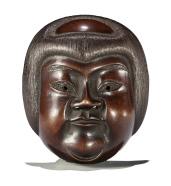

Estimate EUR 1,200
Starting price EUR 600
398
438 MINKO: AN INLAID WOOD TONKOTSU WITH NOH AND KYOGEN MASKS
By Tanaka Juntoku Minko (1735-1816), signed Minko 岷江 Japan, Tsu, early 19th century, Edo period (1615-1868)
Of oval section and slightly tapering form, decorated with dark wood inlays depicting various masks comprising Okame, Hyottoko, Oni, Okina, Beshimi, and Shojo. The cord holes to the top of the cover are ringed in stained bone. One side of the box with a woodinlaid rectangular reserve signed MINKO.


WIDTH 8.3 cm
Condition: Very good condition, minor wear, few small nicks, few light surface scratches.
Noh is a major form of classical Japanese dance-drama that has been performed since the 14th century. Developed by Kan’ami and his son Zeami, it is the oldest major theatre art that is still regularly performed today. Noh is often based on tales from traditional literature with a supernatural being transformed into human form as a hero narrating a story. Noh integrates masks, costumes and various props in a dance-based performance, requiring highly trained actors and musicians. Emotions are primarily conveyed by stylized conventional gestures while the iconic masks represent the roles such as ghosts, women, deities, and demons.
Kyogen is a form of traditional Japanese comic theater. It developed alongside Noh, was performed along with Noh as an intermission of sorts between Noh acts on the same stage, and retains close links to Noh in the modern day. Its contents are nevertheless not at all similar to the formal, symbolic, and solemn Noh theater; kyogen is a comic form, and its primary goal is to make its audience laugh.
AUCTION COMPARISON
Compare a related wood tonkotsu with wood inlay by Minko at Galerie Zacke, Fine Japanese Art, 27 May 2022, Vienna, lot 156 (sold for 5,056 EUR).

Another related tonkotsu by Minko was sold at Bonhams, Japanese Works of Art, 19 September 2008, New York, lot 5041 (sold for 4,800 USD).
Estimate EUR 2,000
Starting price EUR 1,000

399

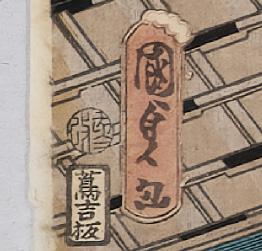





























No. 21 No. 37 No. 75 No. 81
86
91 No. 11 No. 18 No. 20 No. 23 No. 24 No. 33 No. 42 No. 72 No. 79 No. 80 No. 78 No. 83 No. 84 No. 85 No. 88 No. 89 No. 90 No. 9 No. 74 ARTIST
No. 87 No. 22 No. 38 No. 76 No. 82
No.
No.
SIGNATURES
























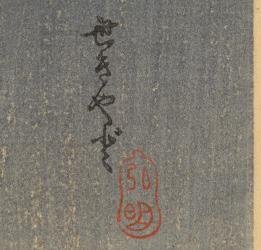




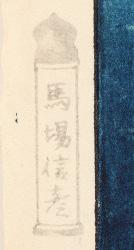




 No. 96
No. 101
No. 109
No. 115
No. 121
No. 131
No. 93
No. 94
No. 95
No. 98
No. 99
No. 100
No. 103
No. 105
No. 114
No. 112
No. 118
No. 119
No. 120
No.
No. 96
No. 101
No. 109
No. 115
No. 121
No. 131
No. 93
No. 94
No. 95
No. 98
No. 99
No. 100
No. 103
No. 105
No. 114
No. 112
No. 118
No. 119
No. 120
No.
124
No. 126
No. 127
No. 92
No. 107
No.
122
No. 97
No. 102
No. 110
No. 117








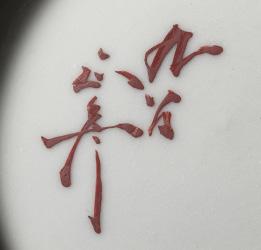










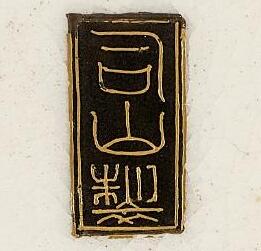











139
149
156
No.
No.
No.
161
No.
168
No.
173 No. 134 No. 135 No. 136 No. 142 No. 143 No. 144 No. 153 No. 154 No. 159 No. 160 No. 158 No. 165 No. 166 No. 167 No. 170 No. 171 No. 172 No. 132 No. 155
No. 169 No. 140 No. 150 No. 157 No. 164
No.
ARTIST SIGNATURES













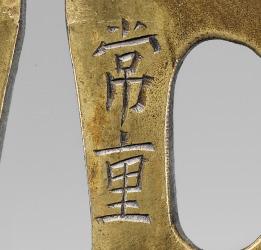












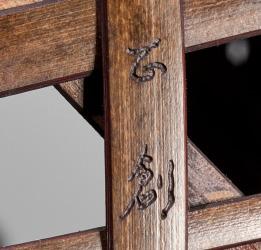




 No. 181
No. 190
No. 198
No. 205
No. 210
No. 181
No. 190
No. 198
No. 205
No. 210
No. 217
No.
175
No.
176
No. 179
No. 187
No. 188
No. 189
No.
192
No. 193
No. 201
200 No. 207 No. 208
209 No. 213 No. 214
216
No.
202 No.
No.
No.
No.
174
212
No.
196 No.
No.
186
191
199
206
No.
No.
No.


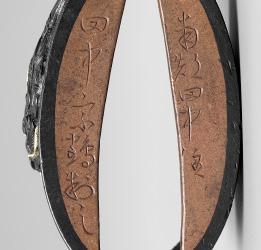




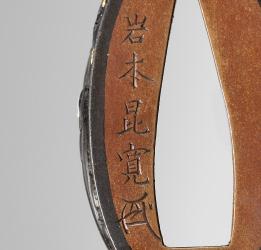



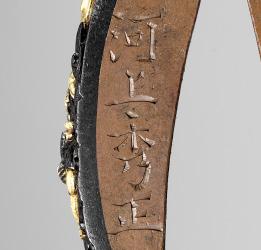













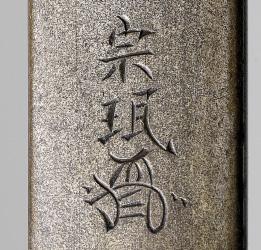



 No. 222
No. 228
No. 236
No. 241
No. 246
No. 254
No. 219
No. 220
No. 221
No. 224
No. 225
No. 227
No. 231
No. 234
No. 239
No. 240
No. 238
No. 243
No. 244
No. 245
No. 248
No. 249
No. 250
No. 218
No. 235
No. 222
No. 228
No. 236
No. 241
No. 246
No. 254
No. 219
No. 220
No. 221
No. 224
No. 225
No. 227
No. 231
No. 234
No. 239
No. 240
No. 238
No. 243
No. 244
No. 245
No. 248
No. 249
No. 250
No. 218
No. 235
ARTIST SIGNATURES
No. 247
No. 223
No. 229
No. 237
No. 242







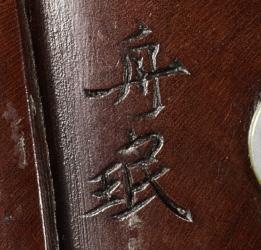


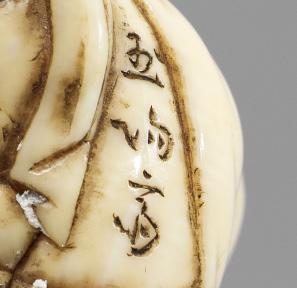












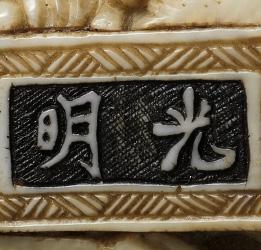





 No. 263
No. 268
No. 278
No. 289
No. 296
No. 312
No. 256
No. 257
No. 260
No. 265
No. 266
No. 267
No. 274
No. 275
No. 287
No. 288
No.
No. 263
No. 268
No. 278
No. 289
No. 296
No. 312
No. 256
No. 257
No. 260
No. 265
No. 266
No. 267
No. 274
No. 275
No. 287
No. 288
No.
286 No. 292 No. 293 No. 300 No. 301
No. 302
No. 255
No. 277 No.
297
No. 264
No. 273
No. 282
No. 290








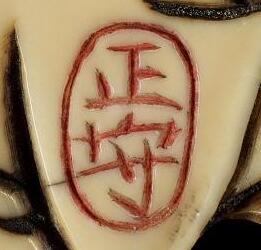

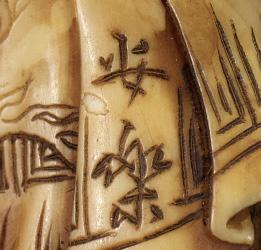










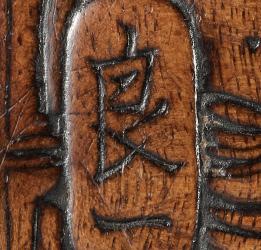




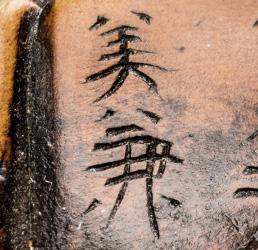
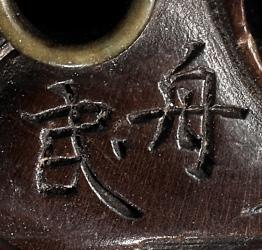

 No. 327
No. 335
No. 342
No. 350
No. 363
No. 371
No. 314
No. 315
No. 318
No. 331
No. 332
No. 333
No. 338
No. 339
No. 348
No. 349
No. 327
No. 335
No. 342
No. 350
No. 363
No. 371
No. 314
No. 315
No. 318
No. 331
No. 332
No. 333
No. 338
No. 339
No. 348
No. 349
No.
No.
No.
No. 366 No.
No. 344 No. 360
361
362
365
370
No. 313
No.
340 ARTIST SIGNATURES No. 364
No. 328
No. 337
No.
343 No. 356








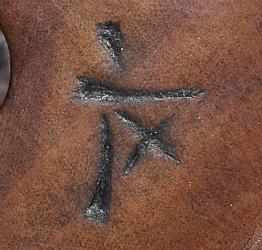








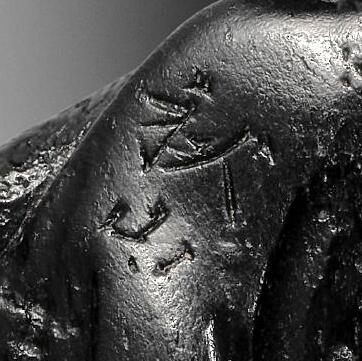







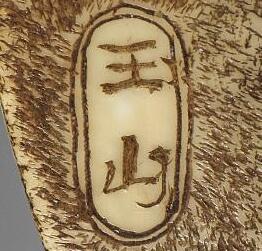



 No. 386
No. 414
No. 420
No. 427
No. 438
No. 375
No. 376
No. 377
No. 380
No. 381
No. 382
No. 398
No. 408
No. 418
No. 419
No. 417
No. 422
No. 423
No. 426
No. 430
No. 431
No. 437
No. 374
No. 409
No. 428
No. 379
No. 394
No. 415
No. 421
No. 386
No. 414
No. 420
No. 427
No. 438
No. 375
No. 376
No. 377
No. 380
No. 381
No. 382
No. 398
No. 408
No. 418
No. 419
No. 417
No. 422
No. 423
No. 426
No. 430
No. 431
No. 437
No. 374
No. 409
No. 428
No. 379
No. 394
No. 415
No. 421
VISIT OUR GALLERY
Our new gallery is located in the heart of Vienna’s first district, spans 500 square meters and has been specially designed to provide a seamless auction and exhibition experience. The design honors our Austrian heritage and passion for Asian cultures, bringing together European,

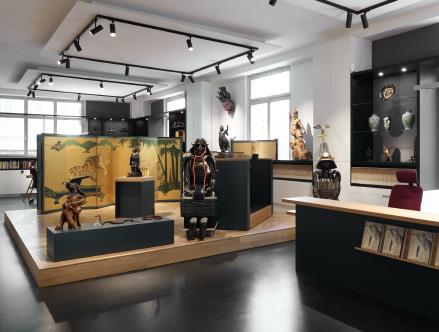

Japanese and Chinese architectural elements throughout the space. We invite you to view the fine objects in our upcoming auction from 12 June to 15 June 2023 and take part in the auction in our new showroom on 16 June, starting at 11:00 AM


How to Find
Our New Office
Our new address is Sterngasse 13, 1010 Vienna. We’re located in the heart of Vienna’s iconic first district, only a sevenminute walk away from the Stephansdom. Our new gallery is easily reachable by public transport or car


IMPRINT
Publisher
Galerie Zacke founded 1968 © SZA Versteigerungen & Vertriebs GmbH
1010 Wien
Sterngasse 13 Austria, Europe
Tel (0043-1) 532 04 52
Email: office@zacke.at
Editors
Lukas Zacke
Marion Schor
Experts
Lukas Zacke
Max Zacke
Alexander Zacke
Assistance
Divya Korattikkattutharayil
Ananya Casius
Assistance with Signature Readings
Mieko Gray
Photography
Georg Bodenstein
Design
Hermann Kienesberger
Printing Print Alliance
HAV Produktions GmbH
Website www.zacke.at
© GALERIE ZACKE
Reproduction forbidden
408 U1 U4 U1 U3 Schwedenplatz Graben Rotenturmstr. HoherMarkt Wipplingerstr.Sterngasse Salzgries ObereDonaustr. Bäckerstr. Wollzeile SalztorgasseSalztorbrücke Marc-Aurel-Str. Stephansplatz Schulerstr.



www.zacke.at 1010 VIENNA AUSTRIA STERNGASSE 13 Tel +43 1 532 04 52 Fax +20 E-mail office@zacke.at












































































































 By Suzuki Konyu II
By Suzuki Konyu II








































































































 By Kishi Ganryo
By Kishi Ganryo







 By Matsumoto Fuko (1840-1923), signed and sealed Fuko Takatada Japan, Meiji period (1868-1912)
By Matsumoto Fuko (1840-1923), signed and sealed Fuko Takatada Japan, Meiji period (1868-1912)














 By Ichieisai Yoshitsuya (1822-1866), signed Ichieisai Yoshitsuya Japan, dated 1858
By Ichieisai Yoshitsuya (1822-1866), signed Ichieisai Yoshitsuya Japan, dated 1858












 By Kawase Hasui (1883-1957), signed Hasui and sealed Sui Japan, dated 1930
By Kawase Hasui (1883-1957), signed Hasui and sealed Sui Japan, dated 1930
































 By Hidemitsu (Shuko), signed Hidemitsu kansei Japan, Meiji period (1868-1912)
By Hidemitsu (Shuko), signed Hidemitsu kansei Japan, Meiji period (1868-1912)

 By Shokaken Eishun, signed Shokaken Eishun Japan, early 20th century, Meiji (1868-1912) to Taisho period (1912-1926)
By Shokaken Eishun, signed Shokaken Eishun Japan, early 20th century, Meiji (1868-1912) to Taisho period (1912-1926)






 By Miyabe Atsuyoshi
By Miyabe Atsuyoshi


 By Kiyoaki (Seimei), signed Kiyoaki saku Japan, Meiji period (1868-1912)
By Kiyoaki (Seimei), signed Kiyoaki saku Japan, Meiji period (1868-1912)




 By Masatsune, signed Masatsune chu Japan, Meiji period (1868-1912)
By Masatsune, signed Masatsune chu Japan, Meiji period (1868-1912)








 Signed Narikane Japan, Meiji period (1868-1912)
Signed Narikane Japan, Meiji period (1868-1912)
 By Hidemitsu (Shuko), signed Hidemitsu sei Japan, Tokyo, late 19th century, Meiji period
By Hidemitsu (Shuko), signed Hidemitsu sei Japan, Tokyo, late 19th century, Meiji period








 By Chomin (Nagatami), signed Chomin Japan, late 19th century, Meiji period (1868-1912)
By Chomin (Nagatami), signed Chomin Japan, late 19th century, Meiji period (1868-1912)



















 By Suzuki Katsuhiro I (1827-1886), signed Katsuhiro with kakihan Japan, late 19th century, Meiji period (1868-1912)
By Suzuki Katsuhiro I (1827-1886), signed Katsuhiro with kakihan Japan, late 19th century, Meiji period (1868-1912)
 By Shungaku, signed Shungaku koku Japan, Meiji period (1868-1912)
By Shungaku, signed Shungaku koku Japan, Meiji period (1868-1912)






 By Masatada, signed Masatada (Seichu) Japan, Meiji period (1868-1912)
By Masatada, signed Masatada (Seichu) Japan, Meiji period (1868-1912)
 By Jukoshi Mitsutsugu, signed Jukoshi Mitsutsugu with gold seal Mitsutsugu
By Jukoshi Mitsutsugu, signed Jukoshi Mitsutsugu with gold seal Mitsutsugu

































 By Shizan, signed Shizan sei Japan, Meiji period (1868-1912)
By Shizan, signed Shizan sei Japan, Meiji period (1868-1912)












 By Kozan, signed Kozan Japan, Meiji period (1868-1912)
By Kozan, signed Kozan Japan, Meiji period (1868-1912)

 The present pair of vases together with the Komai-style iron vases (lot 131)
The present pair of vases together with the Komai-style iron vases (lot 131)
















 By Maeda Chikubosai II (1917-2003), signed Chikubosai kore saku
By Maeda Chikubosai II (1917-2003), signed Chikubosai kore saku



 By Koshosai, signed Koshosai Japan, early 20th century
By Koshosai, signed Koshosai Japan, early 20th century


























































 By Hirata Haruaki, signed Hirata Haruaki Japan, Hirata school, c. 1880, Meiji period (1868-1912)
By Hirata Haruaki, signed Hirata Haruaki Japan, Hirata school, c. 1880, Meiji period (1868-1912)
















 By Suzuki Katsuhiro I (1827-1886), signed Suzuki Katsuhiro saku Suifu no ju
By Suzuki Katsuhiro I (1827-1886), signed Suzuki Katsuhiro saku Suifu no ju





 By Hamano Noriyuki II (1771-1852), signed Noriyuki Japan, Hamano school, late 18th to early 19th century, Edo period (1615-1868)
By Hamano Noriyuki II (1771-1852), signed Noriyuki Japan, Hamano school, late 18th to early 19th century, Edo period (1615-1868)

 By Miboku Masayuki (Gyokkei, 1696-1769), signed Miboku Masayuki Japan, Hamano school, 18th century, Edo period (1615-1868)
By Miboku Masayuki (Gyokkei, 1696-1769), signed Miboku Masayuki Japan, Hamano school, 18th century, Edo period (1615-1868)








 By Hagiya Katsuhira (1804-1886), signed Seiryoken Suimin with kakihan Japan, Mito school, c. 1860
By Hagiya Katsuhira (1804-1886), signed Seiryoken Suimin with kakihan Japan, Mito school, c. 1860





 By Kazutomo, signed Kazutomo Japan, 19th century
By Kazutomo, signed Kazutomo Japan, 19th century
























 By Genjiro Yasukuni, signed Yasukuni
By Genjiro Yasukuni, signed Yasukuni













































 By Komei, signed Komei Japan, Tokyo, Meiji period (1868-1912)
By Komei, signed Komei Japan, Tokyo, Meiji period (1868-1912)
 By Gyokusho, signed Gyokusho Japan, Tokyo, late 19th century, Meiji period (1868-1912)
By Gyokusho, signed Gyokusho Japan, Tokyo, late 19th century, Meiji period (1868-1912)
 By Hideyuki, signed Hideyuki to Japan, late 19th century, Meiji period (1868-1912)
By Hideyuki, signed Hideyuki to Japan, late 19th century, Meiji period (1868-1912)





















 By Harumitsu (Shunko), signed Harumitsu 春光 Japan, Yamada, Ise Province, c. 1860
By Harumitsu (Shunko), signed Harumitsu 春光 Japan, Yamada, Ise Province, c. 1860






 By Chikuyosai Tomochika,
By Chikuyosai Tomochika,

































 By Sorin, signed Sorin 宗琳 and kakihan Japan, mid-19th century, Edo period (1615-1868)
By Sorin, signed Sorin 宗琳 and kakihan Japan, mid-19th century, Edo period (1615-1868)







 By Tadachika,
By Tadachika,
 By Gyokkei, signed Gyokkei 玉珪 Japan, Tokyo, second half of 19th century
By Gyokkei, signed Gyokkei 玉珪 Japan, Tokyo, second half of 19th century
























 By
By




 By Yoshikane, signed Yoshikane 美兼 Japan, Tokyo, late 19th century
By Yoshikane, signed Yoshikane 美兼 Japan, Tokyo, late 19th century






























 By Tomokazu, signed Tomokazu 友一 Japan, Gifu, early 19th century, Edo period (1615-1868)
By Tomokazu, signed Tomokazu 友一 Japan, Gifu, early 19th century, Edo period (1615-1868)









 By Sari, signed Sari 左里 Japan, Iwashiro, c. 1800, Edo period (1615-1868)
By Sari, signed Sari 左里 Japan, Iwashiro, c. 1800, Edo period (1615-1868)


 By Yuzan, signed Yuzan 友山 Japan, 19th century
By Yuzan, signed Yuzan 友山 Japan, 19th century
 By Yasutada, signed Yasutada 安忠 Japan, Kyoto, late 18th to early 19th century, Edo period (1615-1868)
By Yasutada, signed Yasutada 安忠 Japan, Kyoto, late 18th to early 19th century, Edo period (1615-1868)









 By Shokin, signed Shokin 松琴 Japan, 19th century
By Shokin, signed Shokin 松琴 Japan, 19th century


 By Matsuda Sukenaga, signed Sukenaga 亮長 Japan, Takayama, Hida Province, mid-19th century, Edo period (1615-1868)
By Matsuda Sukenaga, signed Sukenaga 亮長 Japan, Takayama, Hida Province, mid-19th century, Edo period (1615-1868)














 By Toyoyo (Toyoyasu, 1811-1883), signed Toyoyo 豊容 Japan, Sasayama, Tanba Province, 19th century, Edo period (1615-1868)
By Toyoyo (Toyoyasu, 1811-1883), signed Toyoyo 豊容 Japan, Sasayama, Tanba Province, 19th century, Edo period (1615-1868)















 By Hogen Rantei, signed Rantei 蘭亭 Japan, Kyoto, early 19th century, Edo period (1615-1868)
By Hogen Rantei, signed Rantei 蘭亭 Japan, Kyoto, early 19th century, Edo period (1615-1868)








 By Shukosai Anraku(sai), signed Anraku 安乐 Japan. Osaka,
By Shukosai Anraku(sai), signed Anraku 安乐 Japan. Osaka,
 By Shukosai Anraku(sai),
By Shukosai Anraku(sai),
 By Shigemasa,
By Shigemasa,


















 By Kokei, signed Kokei 虎溪 Japan, Kuwana, Ise Province, 19th century, Edo period (1615-1868)
By Kokei, signed Kokei 虎溪 Japan, Kuwana, Ise Province, 19th century, Edo period (1615-1868)



 By Masakazu, signed Masakazu 正一 Japan, 19th century, Edo period (1615-1868)
By Masakazu, signed Masakazu 正一 Japan, 19th century, Edo period (1615-1868)











 By Asahi Gyokuzan, signed Gyokuzan 玉山 Japan, Tokyo, second half of 19th century
By Asahi Gyokuzan, signed Gyokuzan 玉山 Japan, Tokyo, second half of 19th century






















































 By Sakiyo Kurokawa Masahide, signed Masahide 正英 Japan, Nagasaki, mid-18th century, Edo period (1615-1868)
By Sakiyo Kurokawa Masahide, signed Masahide 正英 Japan, Nagasaki, mid-18th century, Edo period (1615-1868)









 By Ikumi, signed Ikumi 郁美with kakihan Japan, 20th century
By Ikumi, signed Ikumi 郁美with kakihan Japan, 20th century


















 By Deme Uman, signed Deme Uman 出目右滿 Tenkaichi 天下一 Japan, Edo (Tokyo), early 19th century, Edo period (1615-1868)
By Deme Uman, signed Deme Uman 出目右滿 Tenkaichi 天下一 Japan, Edo (Tokyo), early 19th century, Edo period (1615-1868)


















































































 No. 96
No. 101
No. 109
No. 115
No. 121
No. 131
No. 93
No. 94
No. 95
No. 98
No. 99
No. 100
No. 103
No. 105
No. 114
No. 112
No. 118
No. 119
No. 120
No.
No. 96
No. 101
No. 109
No. 115
No. 121
No. 131
No. 93
No. 94
No. 95
No. 98
No. 99
No. 100
No. 103
No. 105
No. 114
No. 112
No. 118
No. 119
No. 120
No.






























































 No. 181
No. 190
No. 198
No. 205
No. 210
No. 181
No. 190
No. 198
No. 205
No. 210





























 No. 222
No. 228
No. 236
No. 241
No. 246
No. 254
No. 219
No. 220
No. 221
No. 224
No. 225
No. 227
No. 231
No. 234
No. 239
No. 240
No. 238
No. 243
No. 244
No. 245
No. 248
No. 249
No. 250
No. 218
No. 235
No. 222
No. 228
No. 236
No. 241
No. 246
No. 254
No. 219
No. 220
No. 221
No. 224
No. 225
No. 227
No. 231
No. 234
No. 239
No. 240
No. 238
No. 243
No. 244
No. 245
No. 248
No. 249
No. 250
No. 218
No. 235





























 No. 263
No. 268
No. 278
No. 289
No. 296
No. 312
No. 256
No. 257
No. 260
No. 265
No. 266
No. 267
No. 274
No. 275
No. 287
No. 288
No.
No. 263
No. 268
No. 278
No. 289
No. 296
No. 312
No. 256
No. 257
No. 260
No. 265
No. 266
No. 267
No. 274
No. 275
No. 287
No. 288
No.





























 No. 327
No. 335
No. 342
No. 350
No. 363
No. 371
No. 314
No. 315
No. 318
No. 331
No. 332
No. 333
No. 338
No. 339
No. 348
No. 349
No. 327
No. 335
No. 342
No. 350
No. 363
No. 371
No. 314
No. 315
No. 318
No. 331
No. 332
No. 333
No. 338
No. 339
No. 348
No. 349





























 No. 386
No. 414
No. 420
No. 427
No. 438
No. 375
No. 376
No. 377
No. 380
No. 381
No. 382
No. 398
No. 408
No. 418
No. 419
No. 417
No. 422
No. 423
No. 426
No. 430
No. 431
No. 437
No. 374
No. 409
No. 428
No. 379
No. 394
No. 415
No. 421
No. 386
No. 414
No. 420
No. 427
No. 438
No. 375
No. 376
No. 377
No. 380
No. 381
No. 382
No. 398
No. 408
No. 418
No. 419
No. 417
No. 422
No. 423
No. 426
No. 430
No. 431
No. 437
No. 374
No. 409
No. 428
No. 379
No. 394
No. 415
No. 421









